Cisco Systems BTS-TP1 Ripwave TTA Base Station User Manual ttaicguide
Cisco Systems, Inc Ripwave TTA Base Station ttaicguide
Contents
- 1. User Manual Section 1
- 2. User Manual Section 2
User Manual Section 2
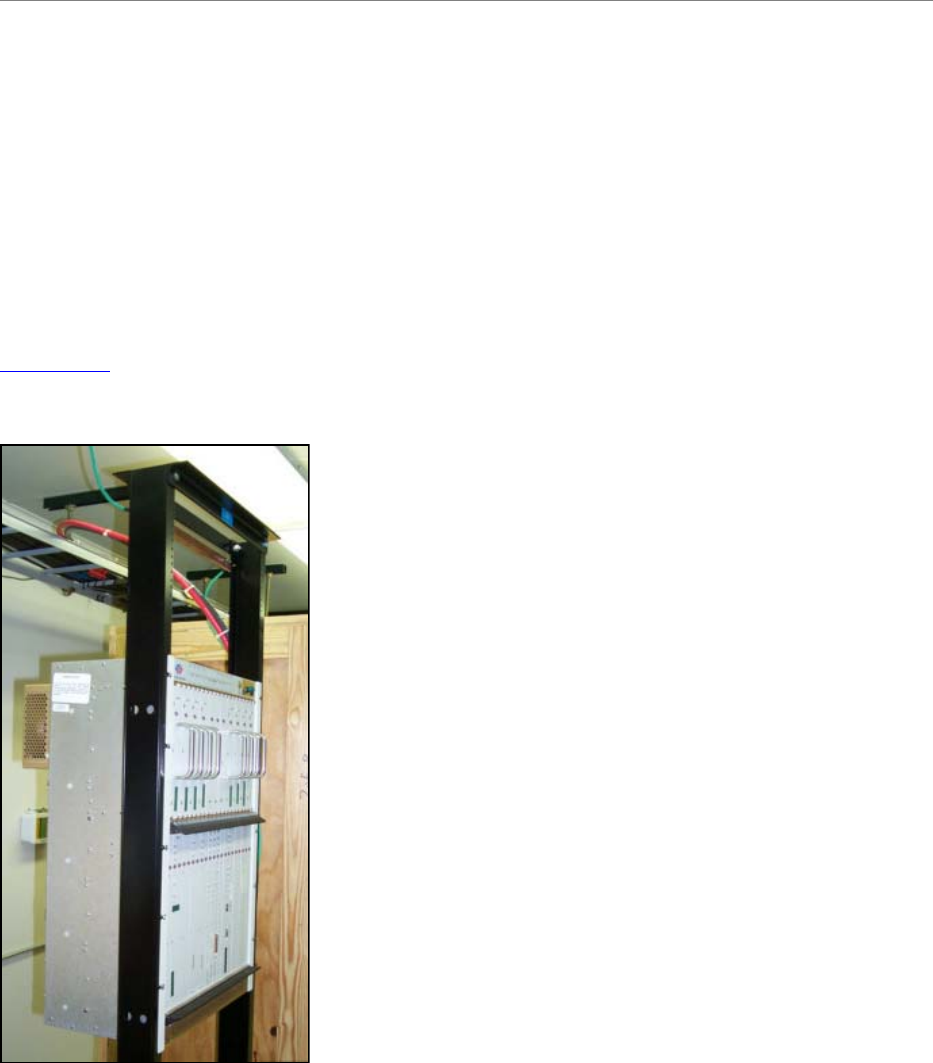
Ripwave Base Station I&C Guide Navini Networks, Inc.
50 Part #40-00047-00 Rev D v1.0
February 28, 2003
Install the BTS
Install Mounting Rack or Enclosure
The BTS mounting rack (Figure 17) or enclosure is to be installed in compliance with applicable
portions of the National Electrical Code (NEC), articles 800 and 810. You will need to adhere to
local installation standards, as well as Navini Networks standards and procedures. Refer to
Appendix J for guidelines on outdoor BTS enclosures.
Figure 17: BTS Mounting Rack
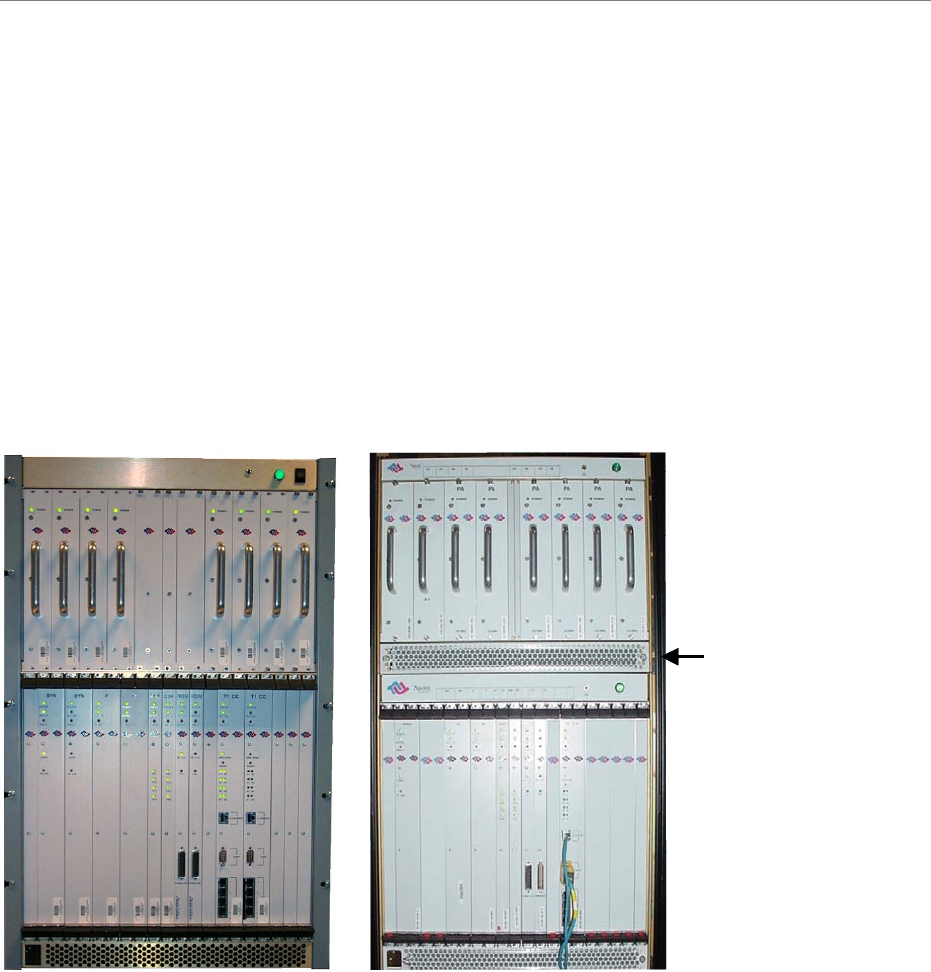
Navini Networks, Inc. Ripwave Base Station I&C Guide
Part #40-00047-00 Rev D v1.0 51
February 28, 2003
Install Chassis
The BTS chassis may be one of two types: Combo Chassis or Split Chassis. Prior to Ripwave
Release 1.19, only the Combo Chassis was used (Figure 18). The advantage of the Split Chassis
has to do with improved RF power output (Figure 19). The Split Chassis is available for the 2.3,
2.5, and 2.6 GHz systems; it is not available for the 2.4 GHz system.
Install the BTS chassis in the mounting rack using ten (10) screws.
Figure 18: BTS Chassis
Combo Chassis Split Chassis
Panel separates
RF and Digital
shelves
Combo Chassis Split Chassis
Panel separates
RF and Digital
shelves
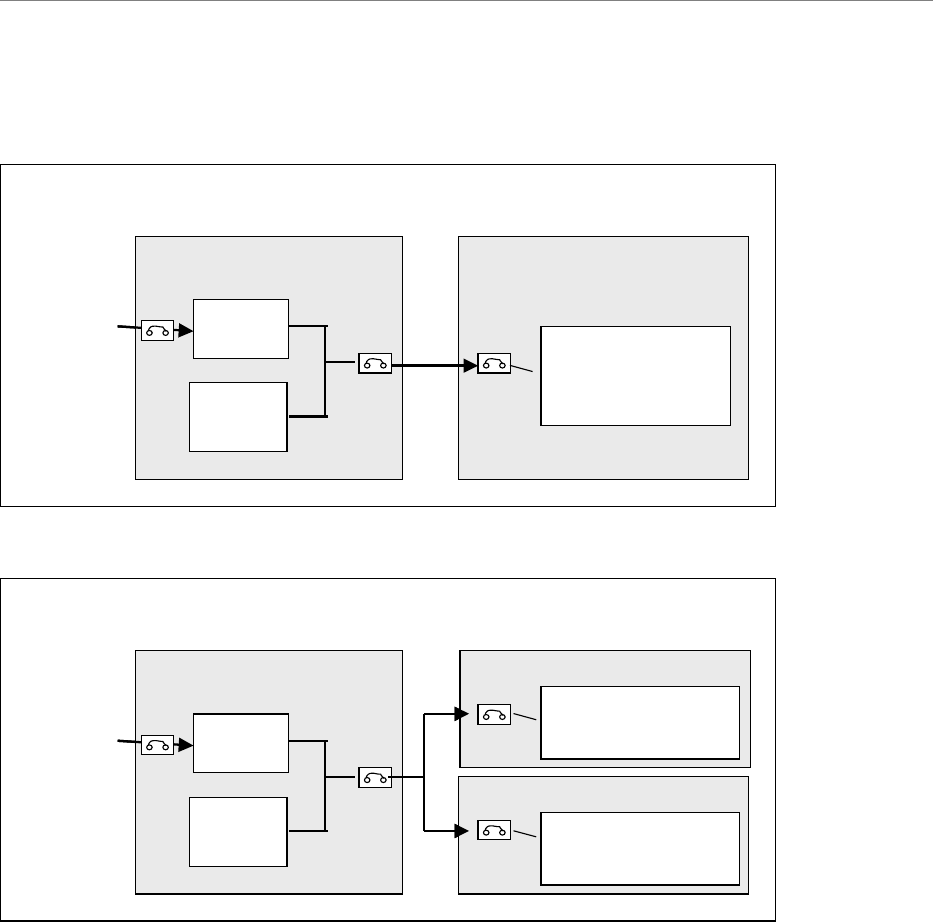
Ripwave Base Station I&C Guide Navini Networks, Inc.
52 Part #40-00047-00 Rev D v1.0
February 28, 2003
Figure 19: Split Vs. Combo Chassis Power
Combo Chassis (ISM)
AC INPUT:
180-265 VAC
OR 115VAC 27V
AC/DC
Converter
Battery
200 AH
B B U B T S
Circuit
Breaker
Inner Loop Fans
Power @ 1000 Watts
50 Amp
AC INPUT:
180-265 VAC
OR 115VAC
27V
AC/DC
Converter
Battery
200 AH
B B U B T S
Circuit
Breaker
Inner Loop Fans
Power @ 400 Watts
Inner Loop Fans
Power @ 1100 Watts
Digital Shelf
RF Shelf
50 Amp
20 Amp
Split Chassis (MMDS/WCS)
Combo Chassis (ISM)
AC INPUT:
180-265 VAC
OR 115VAC 27V
AC/DC
Converter
Battery
200 AH
B B U B T S
Circuit
Breaker
Inner Loop Fans
Power @ 1000 Watts
50 Amp
AC INPUT:
180-265 VAC
OR 115VAC
27V
AC/DC
Converter
Battery
200 AH
B B U B T S
Circuit
Breaker
Inner Loop Fans
Power @ 400 Watts
Inner Loop Fans
Power @ 1100 Watts
Digital Shelf
RF Shelf
50 Amp
20 Amp
Split Chassis (MMDS/WCS)
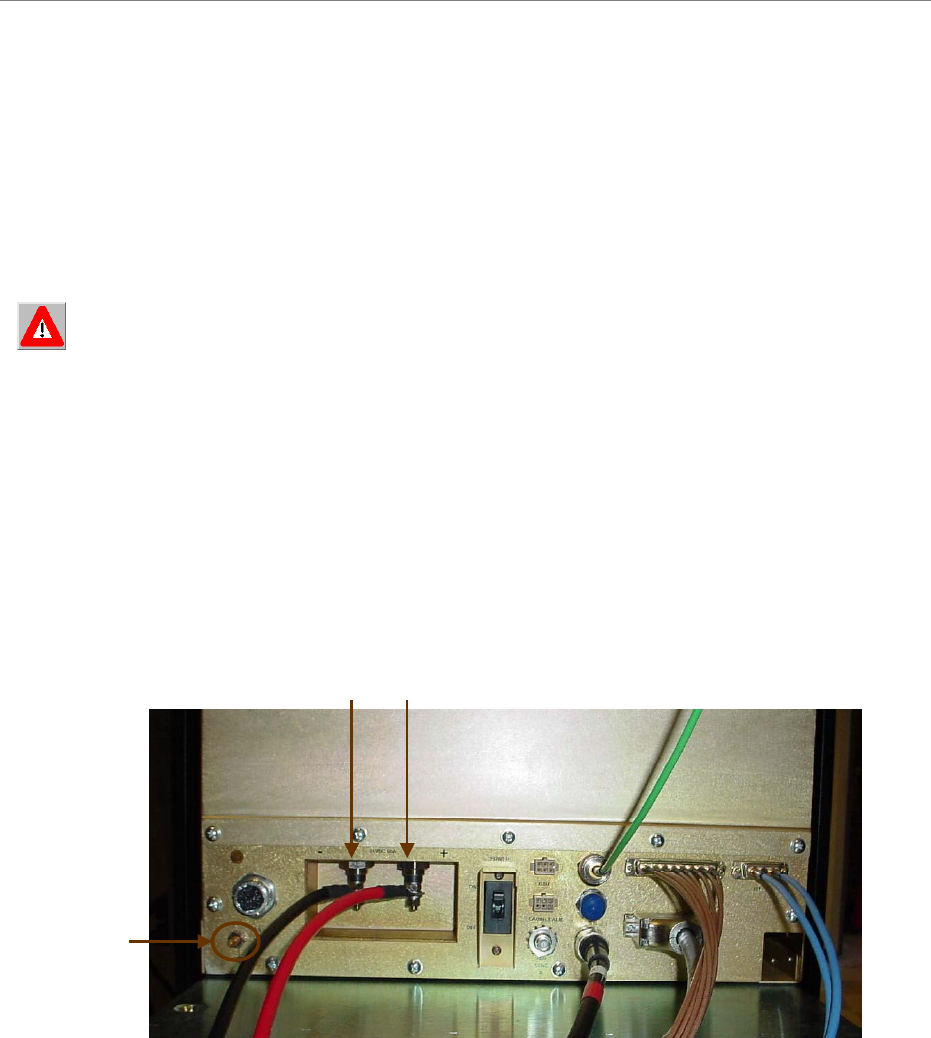
Navini Networks, Inc. Ripwave Base Station I&C Guide
Part #40-00047-00 Rev D v1.0 53
February 28, 2003
Connect Input Power
Next, connect the power supply to the BTS card cage (Figure 20). The gauge of the wire is
determined by the length of the run and by NEC standards. Use a 60-amp circuit breaker when
running the line. Terminate both of the input power wires and the ground wire with a ¼- inch
terminal lug. Assuming a +24 VDC power supply, connect the +24 VDC input power
connections and the +24 VDC return wires to the BTS card cage.
WARNING! Ensure that the power is off before connecting the input power wires to the
BTS input terminals.
If the input power is 120 VAC, plug the two power supply input cables into 120 VAC outlets,
and turn on the circuit breaker on the power supply. If the input power is 24 VDC, check for +24
VDC across the input terminals of the BTS card cage. If +24 VDC is not present across the input
terminals, check all input power wiring for proper connections. Also, check the power supply for
proper operation and the fuses for continuity.
When finished, turn off the power supply.
Figure 20: Split Chassis Power Connections
BTS +24 VDC Input Terminals
Ground Lug
BTS +24 VDC Input Terminals
Ground Lug

Ripwave Base Station I&C Guide Navini Networks, Inc.
54 Part #40-00047-00 Rev D v1.0
February 28, 2003
Connect BTS to Ground Connections
All connections need to be checked before power is applied to the system. At a minimum,
perform the following:
• Ensure continuity across all ground connections.
• Ensure an open connection from the power supply output (positive input to the BTS card
cage) to frame ground.
Connect Chassis Alarms
The chassis contains two connectors that are used to send alarm indications to the BTS when the
BTS is housed in an outdoor enclosure. One of the connectors, labeled “CABINET ALARM”, is
used to trigger alarm conditions that occur within the external chassis. The second connector,
labeled “BBU”, is used to process alarms from a battery backup unit. Refer to Appendix L for
instructions on connecting the alarms.
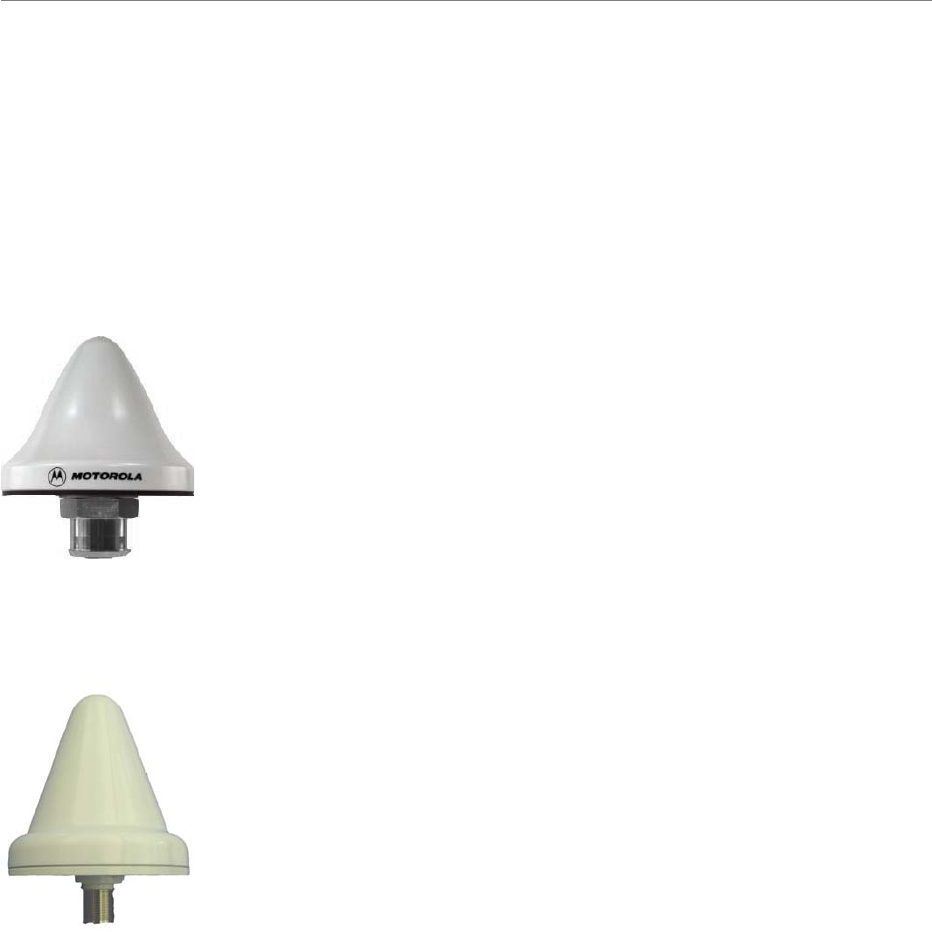
Navini Networks, Inc. Ripwave Base Station I&C Guide
Part #40-00047-00 Rev D v1.0 55
February 28, 2003
Install GPS Antennas
As mentioned earlier, there are two models of GPS antennas that can be used with the Ripwave
Base Station, as shown in Figures 21 and 22: Motorola Timing 2000 and VIC 100. The system
will use either one or two GPS antenna modules.
Figure 21: Motorola Timing 2000 GPS
Figure 22: VIC 100 GPS
The mounting location for the GPS antenna is determined during the site survey. When
installing, ensure that the following requirements are met:
• The GPS antenna is installed within 100 feet of the BTS.
• The GPS antenna is located to provide the widest view of the sky (objects such as
buildings or trees can interfere with signals from the satellite).
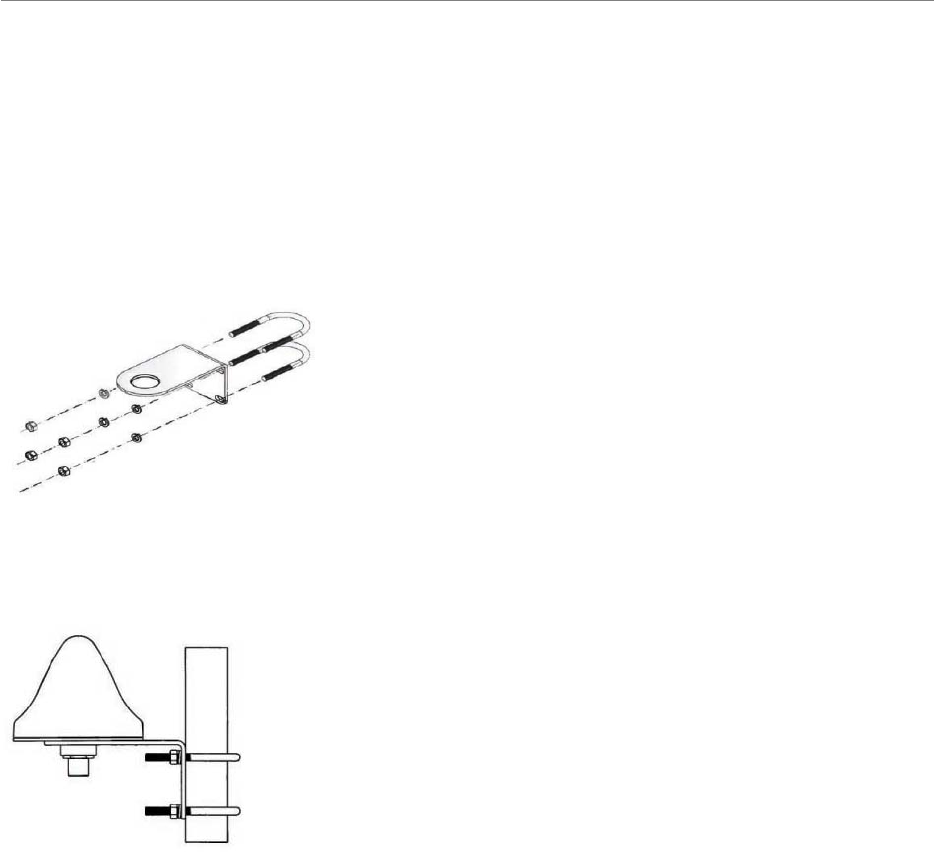
Ripwave Base Station I&C Guide Navini Networks, Inc.
56 Part #40-00047-00 Rev D v1.0
February 28, 2003
Motorola Timing 2000
For the Motorola Timing 2000, mount each GPS antenna module using the mounting bracket
hardware (Figures 23 and 24). Connect the GPS cable(s) to the GPS antenna module(s). Torque
the connector(s) to 20-24 inch-pounds.
Figure 23: Motorola GPS Antenna Mounting Brackets
Figure 24: Motorola GPS Antenna Mounted to a Pole
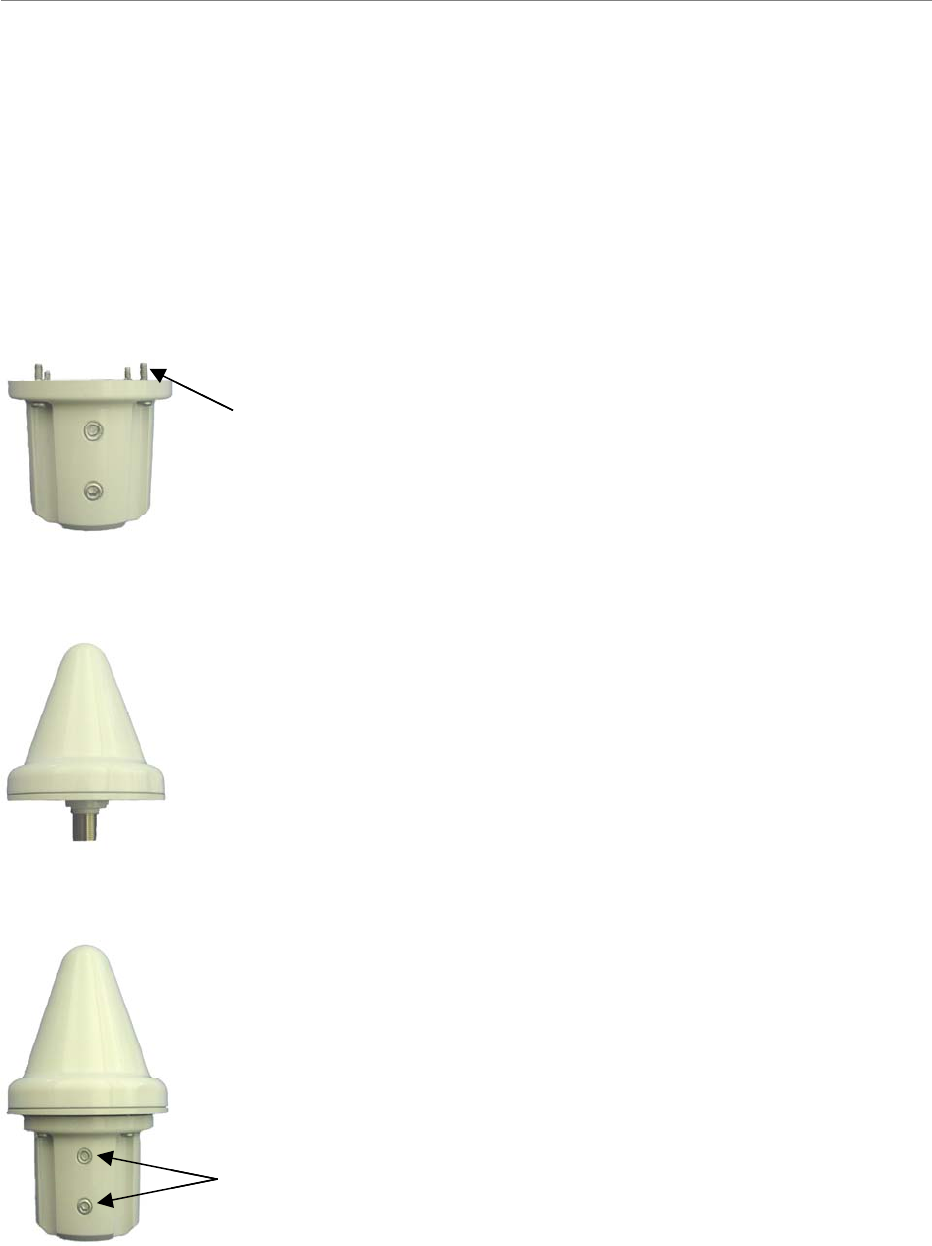
Navini Networks, Inc. Ripwave Base Station I&C Guide
Part #40-00047-00 Rev D v1.0 57
February 28, 2003
VIC 100
For the VIC 100, mount each GPS antenna module, run the cable through the pipe clamp mount
(Figure 25). Connect the cable to the GPS antenna, then weatherize the connection (Figure 26).
Secure the antenna module to the pipe clamp mount using the captive mounting hardware. Install
the GPS antenna module and the pipe clamp mount to the mounting pipe and tighten the two
mounting screws (Figure 27).
Figure 25: VIC 100 Pipe Clamp Mount
Figure 26: VIC 100 GPS Antenna
Figure 27: Assembled VIC 100 Antenna & Mount
Captive
Mounting
Hardware
Captive
Mounting
Hardware
GPS antenna
mounting screws
GPS antenna
mounting screws
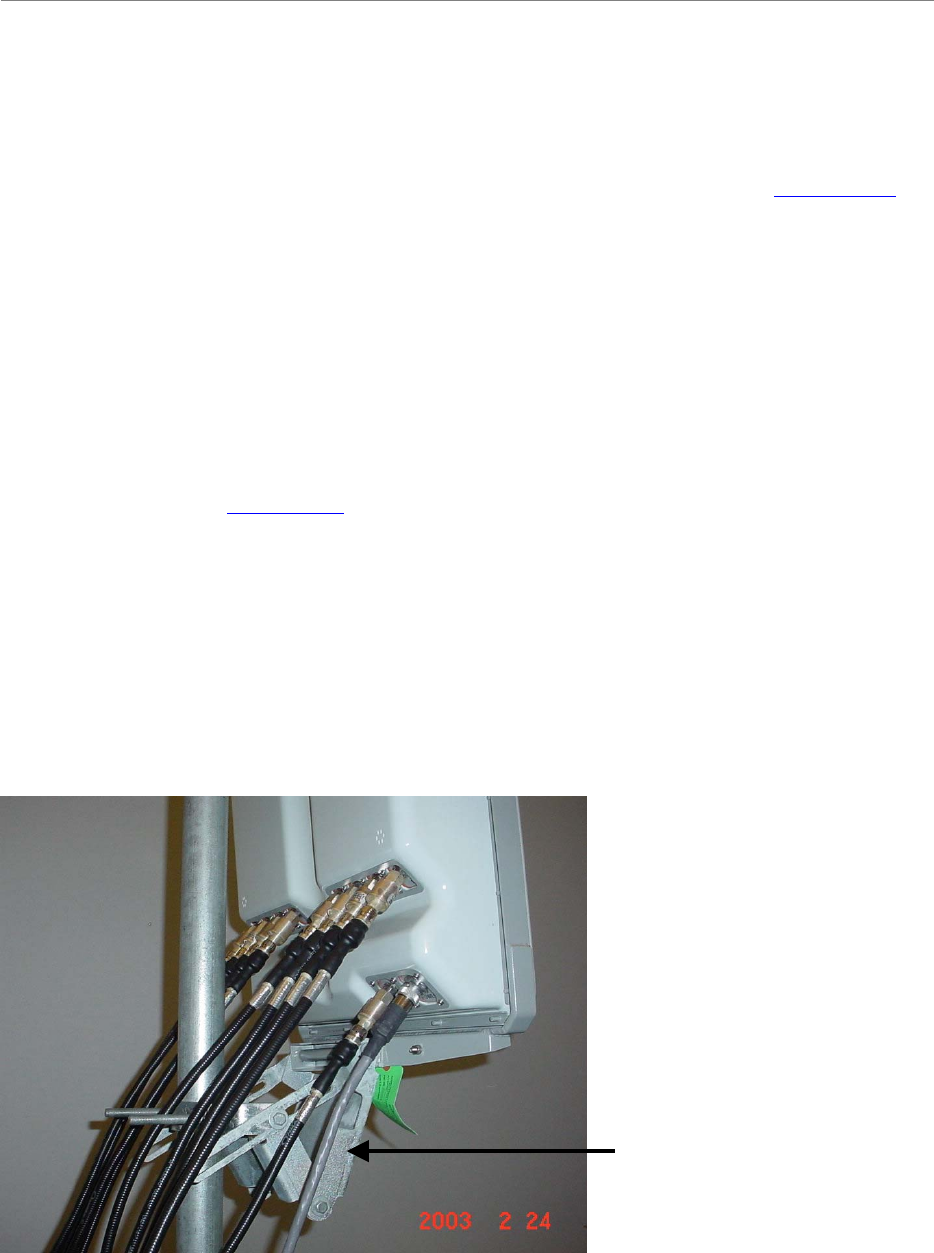
Ripwave Base Station I&C Guide Navini Networks, Inc.
58 Part #40-00047-00 Rev D v1.0
February 28, 2003
Install the RFS
Now that the BTS is in place, the RFS is readied for installation. Follow either the Panel Antenna
or Omni Antenna information and procedures below. Reference the drawings in Appendix M.
Panel Antenna
The RFS Panel antenna is installed on a structure, such as a tower or a pole, which is defined in
the site survey and design. Following are the steps to complete the installation of the panel
antenna.
Verify RFS Operation
Verify proper operation of the RFS before installation. Test the transmit and receive path of each
antenna in the RFS per Appendix C, the RFS System Test.
Set the Downtilt
Check the engineering study for the required downtilt of the antenna. Normally, it will be 2
degrees for omni and 6 degrees for panel downtilt. Each notch in the mounting bracket is equal
to 1 degree of downtilt (Figure 28). Set the upper mounting bracket to achieve the required
downtilt. Be sure to include in the setting any electrical uptilt or downtilt built into the antenna.
Figure 28: RFS Mounting Bracket
Mounting BracketMounting Bracket
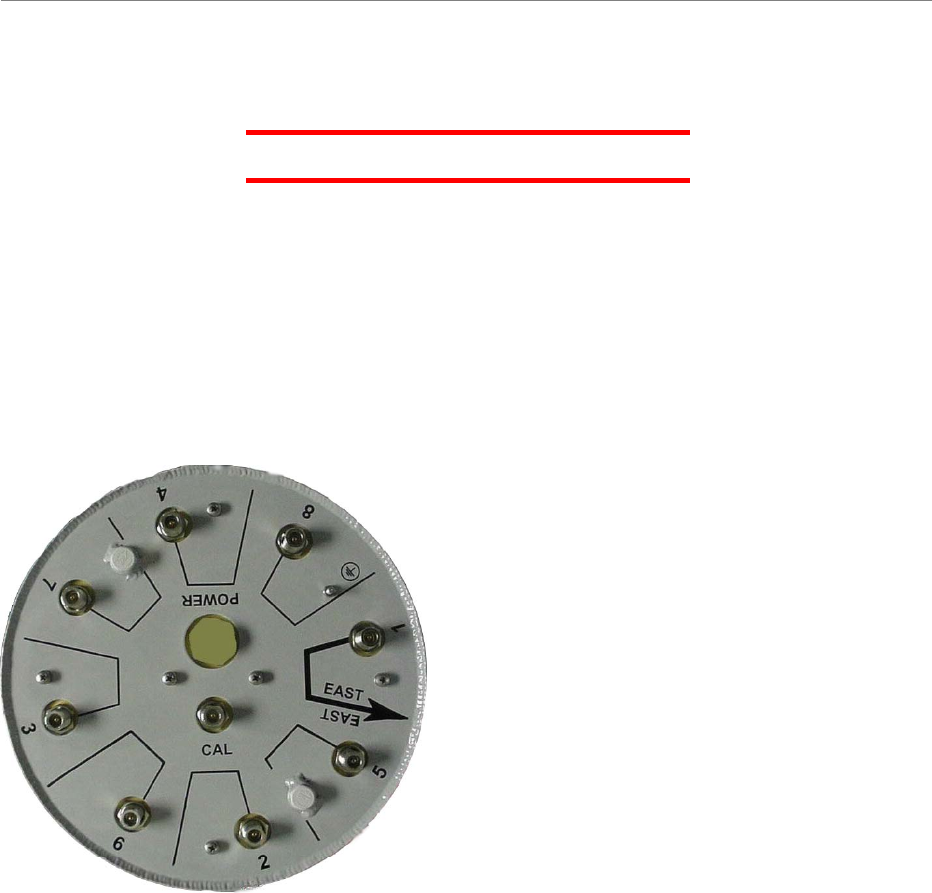
Navini Networks, Inc. Ripwave Base Station I&C Guide
Part #40-00047-00 Rev D v1.0 59
February 28, 2003
Set the Azimuth
Position the RFS on the mounting pole or structure, ensuring that the antenna is pointing in the
proper azimuth direction determined by the engineering study. For an omni, the first antenna
element must face East (Figure 29).
Figure 29: Omni Antenna Elements
The azimuth direction is stated in degrees from true north. Use the diagram shown in Figure 30
to determine the declination angle for your location. Add or subtract the declination angle from
magnetic north to obtain true north.
Tighten the four nuts on each of the two antenna mounting brackets to secure the RFS to the
mounting pole. Use a compass to check the direction from the center of the panel (this is
magnetic north).
The following steps are critical !The following steps are critical !
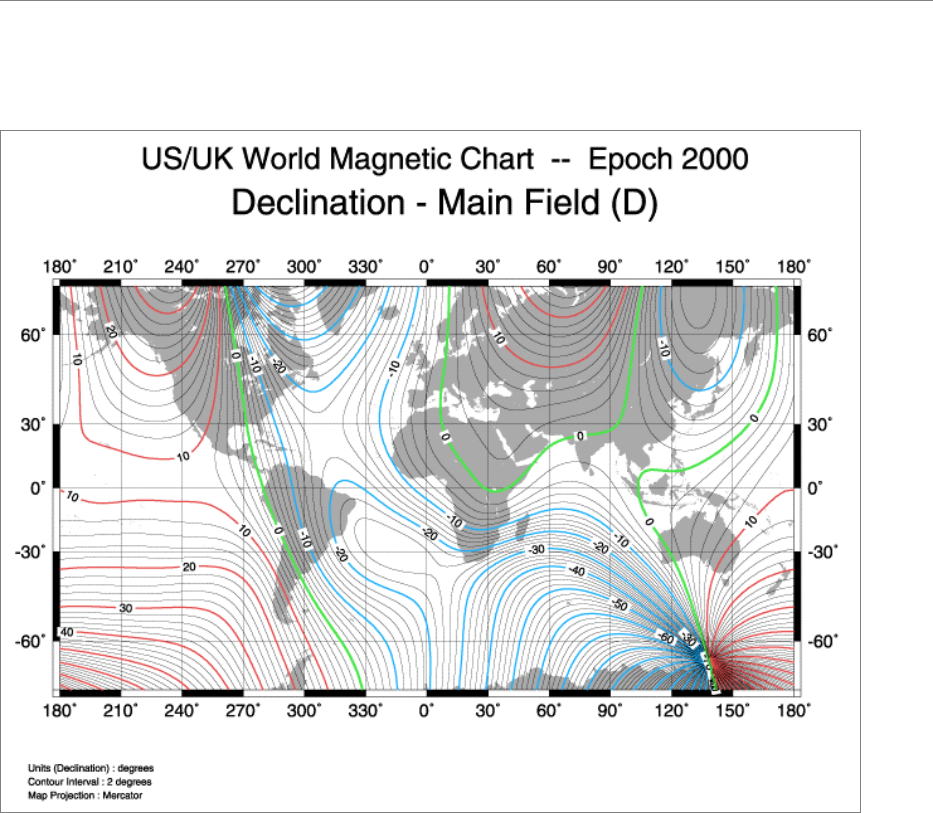
Ripwave Base Station I&C Guide Navini Networks, Inc.
60 Part #40-00047-00 Rev D v1.0
February 28, 2003
Figure 30: Declination Angle
Verify the Downtilt
Using an inclinometer, check the downtilt of the RFS antenna. If required, adjust the angle using
the downtilt adjustment brackets. Be sure to include any electrical uptilt or downtilt built into the
antenna in the setting.
Tighten the mounting hardware to secure the RFS in the proper position. Recheck the downtilt
angle again to verify proper position. Repeat the procedure for all other antennas that are
installed in the system. Ensure that they are mounted in the proper direction and with the correct
downtilt angle.
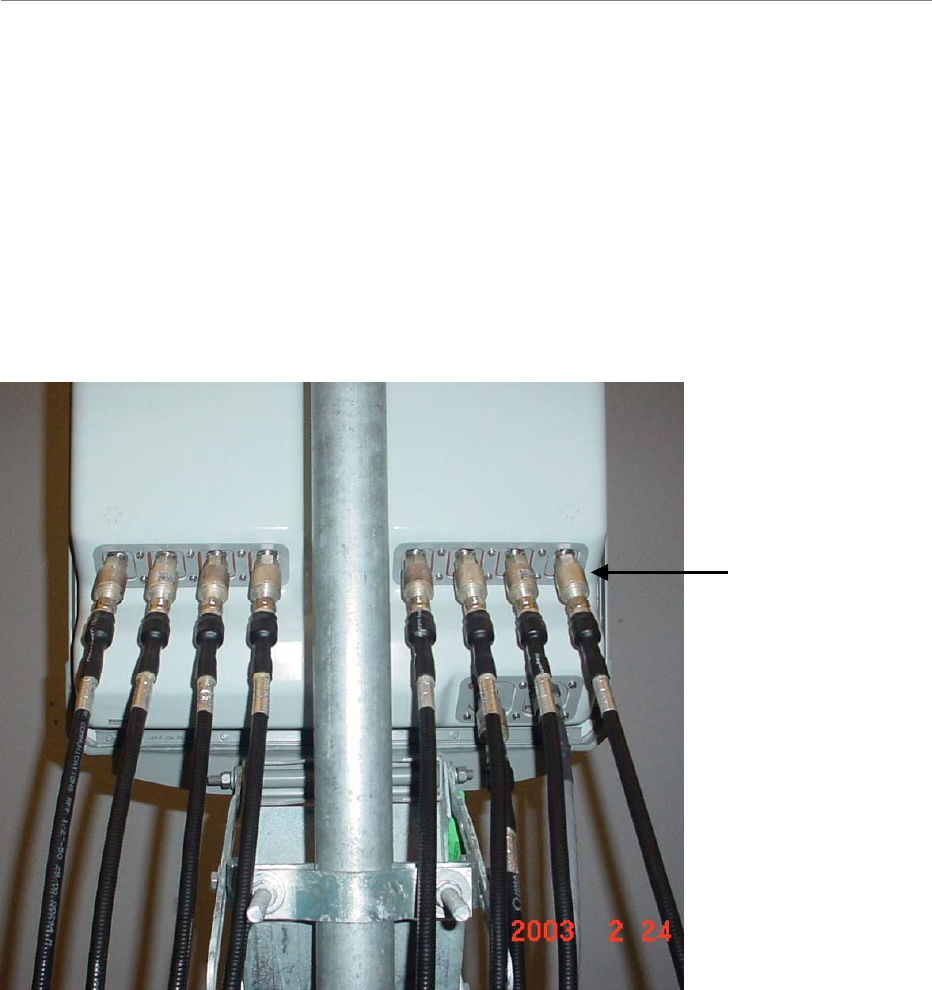
Navini Networks, Inc. Ripwave Base Station I&C Guide
Part #40-00047-00 Rev D v1.0 61
February 28, 2003
Install Surge Protectors
The RFS has ten cable connectors on the bottom of the unit. Eight are antenna connections, with
the connectors alternately numbered from right to left as shown in Figure 31. The two connectors
in the middle are for antenna calibration and data/DC power connections. Install surge protectors
on nine (9) of the RFS connectors – the eight antenna connectors and the calibration connector.
The surge protectors must be installed directly to the RFS to provide protection for the antenna
elements. Torque the surge protectors to 20-24 inch-pounds.
Figure 31: Surge Protectors
Install Cables Between the RFS & BTS
Connect all of the cables – the eight antenna cables, the calibration cable and the data/power
cable – to the surge protectors on the RFS (Figure 32). For ease of installation, install the cables
from the inside out. Ensure that the proper cable is connected to the proper antenna (Figure 33).
Torque the RF cable connectors to 20-24 inch-pounds.
Surge
Protectors
Surge
Protectors
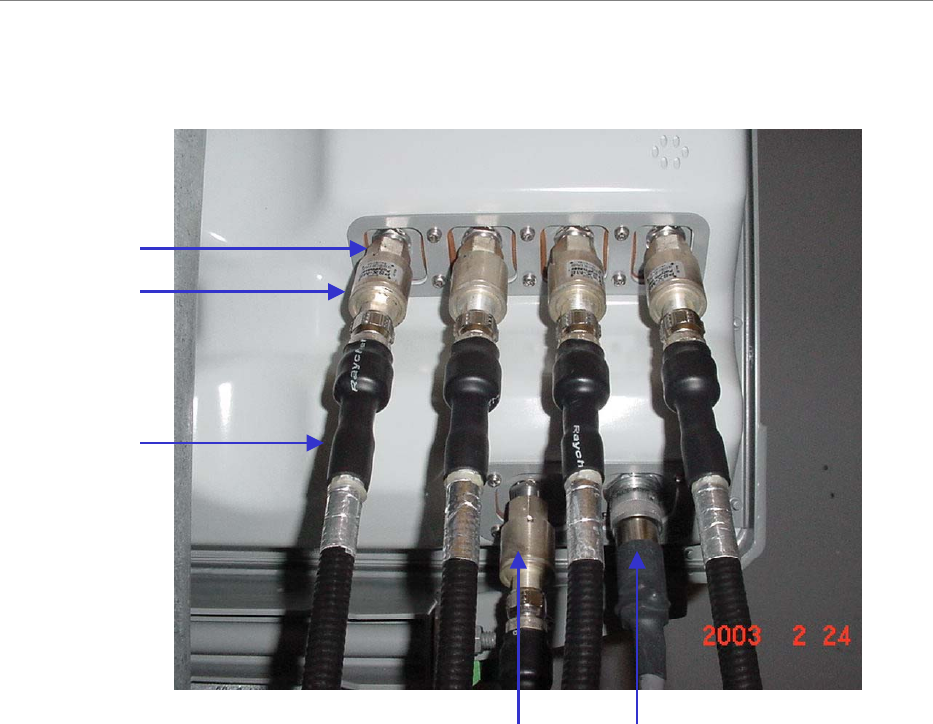
Ripwave Base Station I&C Guide Navini Networks, Inc.
62 Part #40-00047-00 Rev D v1.0
February 28, 2003
Figure 32: RFS Connectors
RF Cables
RF Cable
Connectors
Surge
Protectors
Calibration
Cable
Data/Power
Cable
6251
RF Cables
RF Cable
Connectors
Surge
Protectors
Calibration
Cable
Data/Power
Cable
6251
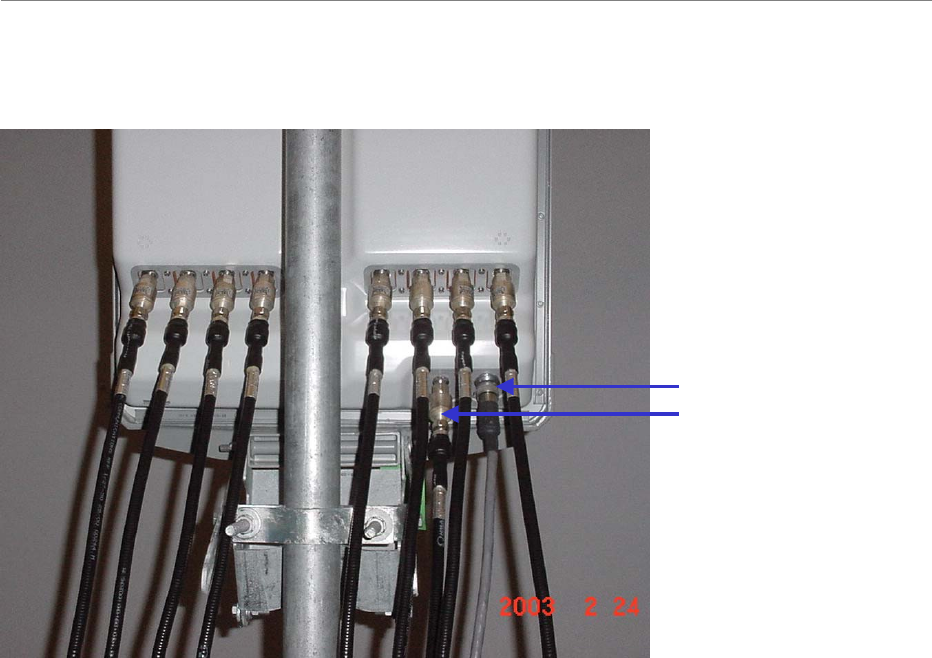
Navini Networks, Inc. Ripwave Base Station I&C Guide
Part #40-00047-00 Rev D v1.0 63
February 28, 2003
Figure 33: Completed Cable Installation
Install Grounding Kit on Cables
Install grounding kit wire connections on the eight (8) RFS cables and the one (1) CAL cable per
the instruction sheet that comes with the grounding kit. Install the grounding wire in a position
on the cable so that it can be attached to the ground buss bar that is mounted close to the RFS.
More than one ground buss bar may be installed in the system, depending on the length of the
cable run.
Connect Ground Wires to the Ground Buss Bar
Connect the ground wires on the cables to the ground buss bar using the hardware supplied with
the grounding kit. Connect the ground stud on the RFS to the ground buss bar. Use a ¼-inch
terminal lug to connect the ground wire to the ground stud on the RFS. Connect the ground buss
bar to earth ground. An example is shown in Figure 34.
62 5 184 7 3
Calibration Cable
Data/Power Cable
62 5 184 7 3
Calibration Cable
Data/Power Cable
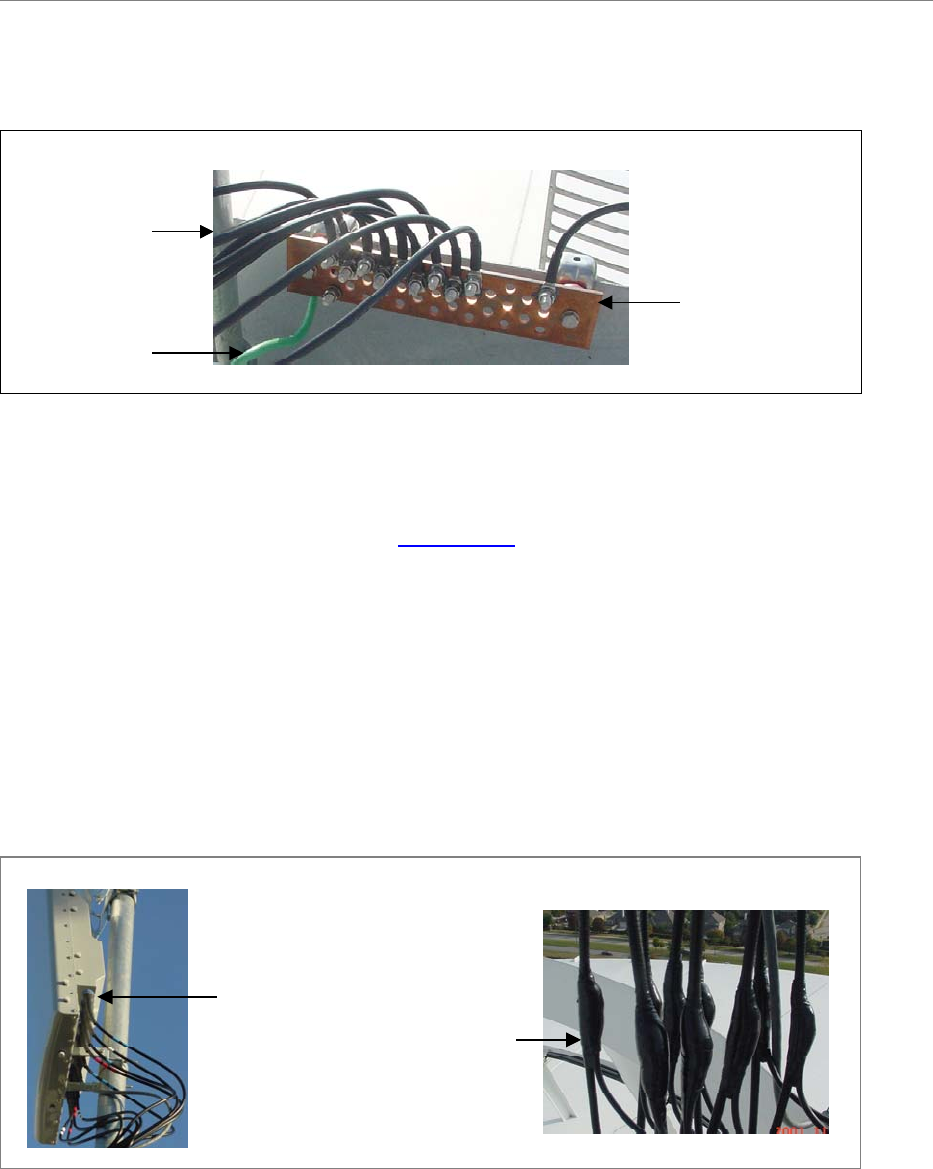
Ripwave Base Station I&C Guide Navini Networks, Inc.
64 Part #40-00047-00 Rev D v1.0
February 28, 2003
Figure 34: RFS Grounding
Test the RFS & Cables
Test the RFS and the eight (8) cables per Appendix C, the RFS System Test. Record the results
in the form. For this test, use the cable connectors that will be attached to the BTS. Include the
jumpers and all surge protectors.
Weatherize the RFS Cable Connectors
Weatherize all ground wire connections exposed to weather using electrical tape and butyl
mastic tape. Follow the instructions supplied with the weatherproofing kit. Examples are shown
in Figure 35.
Figure 35: Weatherized Cables
Weatherproofing
on ground wires
Weatherproofing
on RFS connectors
Weatherproofing
on ground wires
Weatherproofing
on RFS connectors
Ground Buss Bar
Ground Wires
Earth Ground
Ground Buss Bar
Ground Wires
Earth Ground
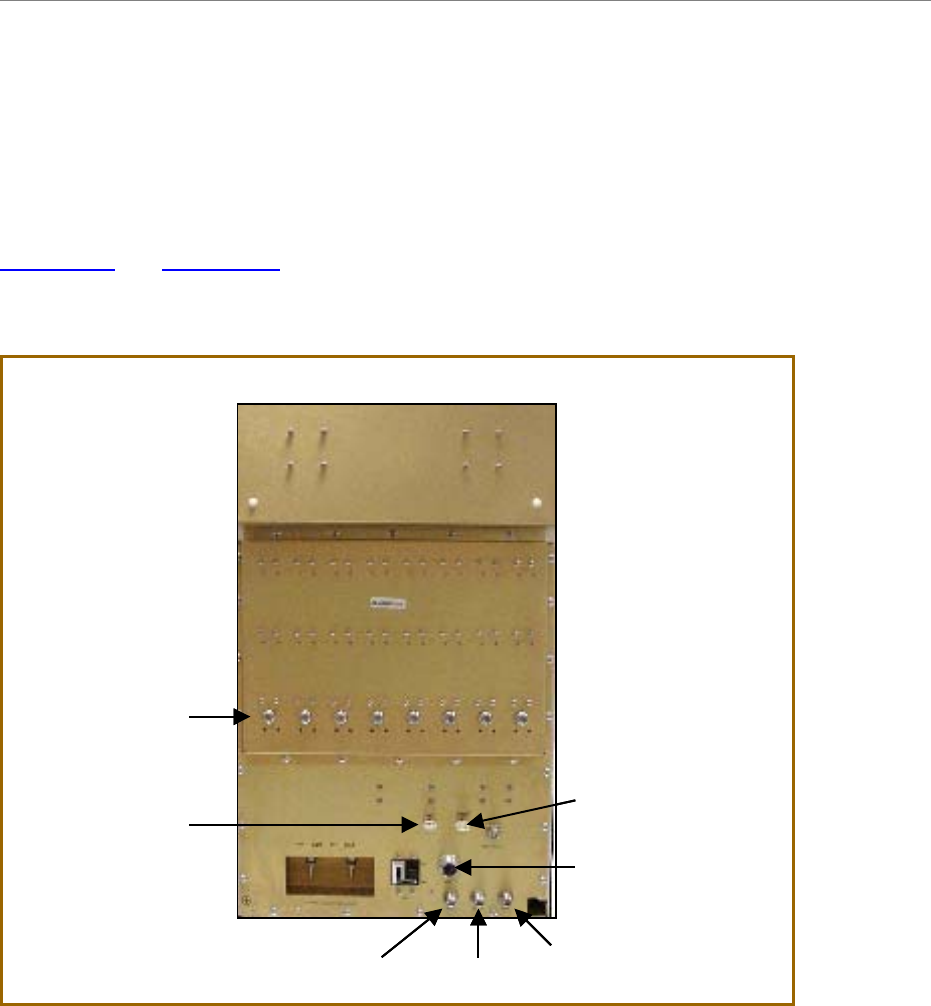
Navini Networks, Inc. Ripwave Base Station I&C Guide
Part #40-00047-00 Rev D v1.0 65
February 28, 2003
Connect RF Cables & Alarms to BTS
Connect all of the cables to the BTS. The connection points are shown in Figures 36, 37, and 38.
Torque the cable connectors to 20-24 inch-pounds. If applicable, connect the cabinet alarm
connector and Battery Backup connector (Cabinet Alarm and BBU) to the back of the chassis.
More information on connecting alarms, rectifiers, and battery backup equipment are provided in
Appendix L and Appendix N, respectively.
Figure 36: Combo Chassis Rear View
RF cables
Battery Backup
CAL GPS 1
Data/Power
Cabinet Alarm
GPS 2
BTS
RF cables
Battery Backup
CAL GPS 1
Data/Power
Cabinet Alarm
GPS 2
BTS
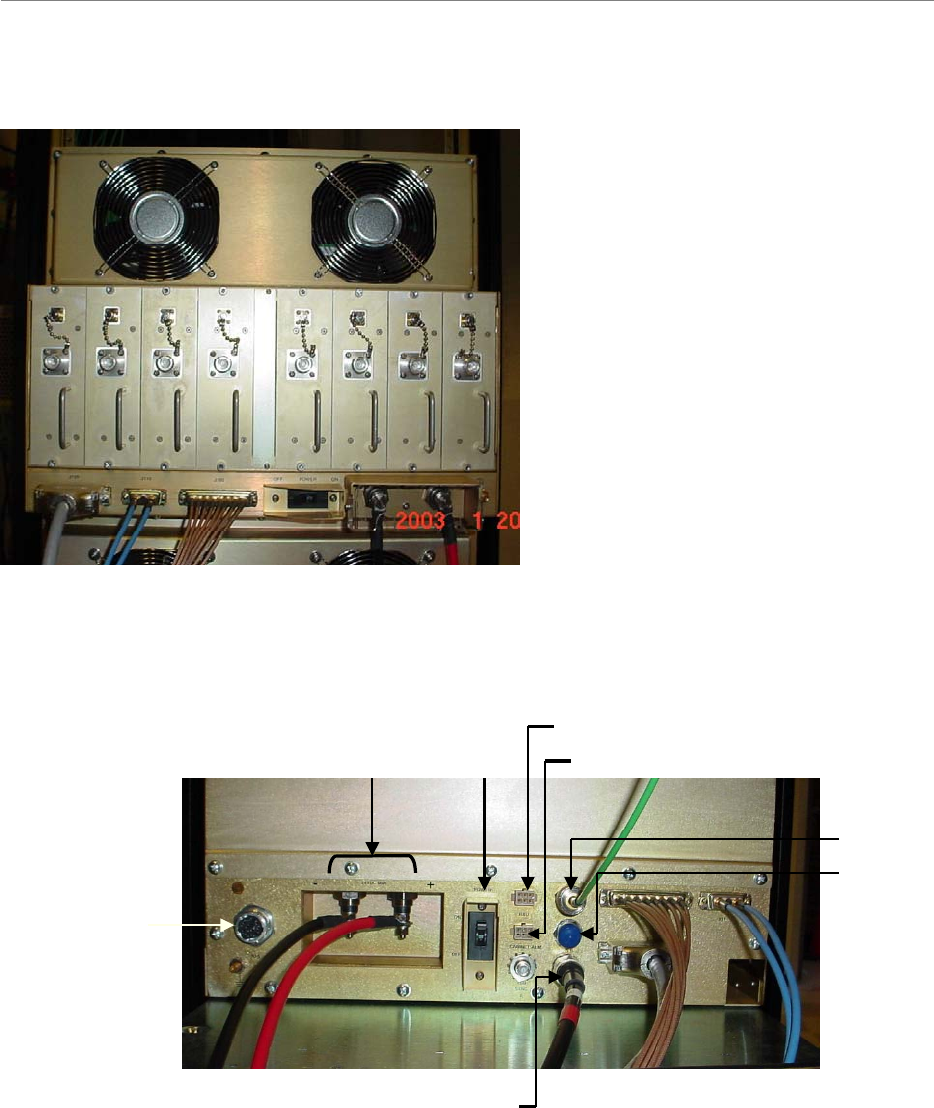
Ripwave Base Station I&C Guide Navini Networks, Inc.
66 Part #40-00047-00 Rev D v1.0
February 28, 2003
Figure 37: Split Chassis RF/PA Shelf Rear View
Figure 38: Split Chassis Digital Shelf Rear View
Power
Connectors ON/OFF
Battery Backup Connector
Cabinet Alarms Connector
Data/Power
Cable Connector
GPS 1
GPS 2
Cal Cable
Power
Connectors ON/OFF
Battery Backup Connector
Cabinet Alarms Connector
Data/Power
Cable Connector
GPS 1
GPS 2
Cal Cable
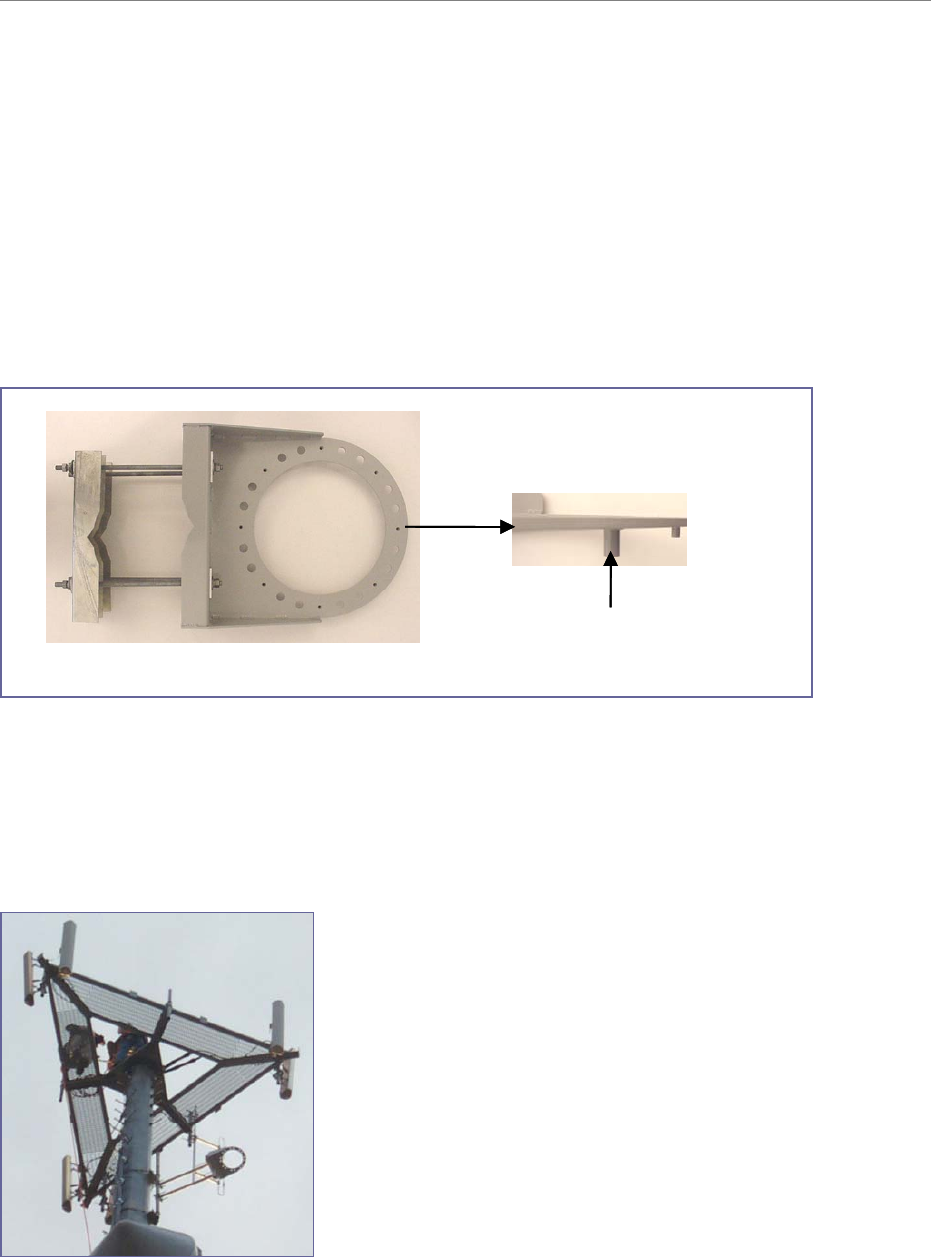
Navini Networks, Inc. Ripwave Base Station I&C Guide
Part #40-00047-00 Rev D v1.0 67
February 28, 2003
Omni Antenna
The RFS Omni antenna is installed on a structure, such as a tower or a pole, which is defined in
the site survey and design. Following are the steps to complete the installation of the panel
antenna.
Assemble the Antenna Mount per the instructions that come with it (Figure 39). Use a compass
to determine which direction is true East (incorporating declination angle - see Figure 30).
Figure 39: Omni Antenna Mount
Position the Antenna Mount in a direction to provide accessibility to the RFS after it is installed.
Position and install the Antenna Mount on the mounting structure so that any one of the eight
mounting hole pins is facing East. Tighten the Antenna Mount hardware to secure it to the
structure (Figure 40).
Figure 40: Secured Omni Antenna Mount
Mounting Hole Pin
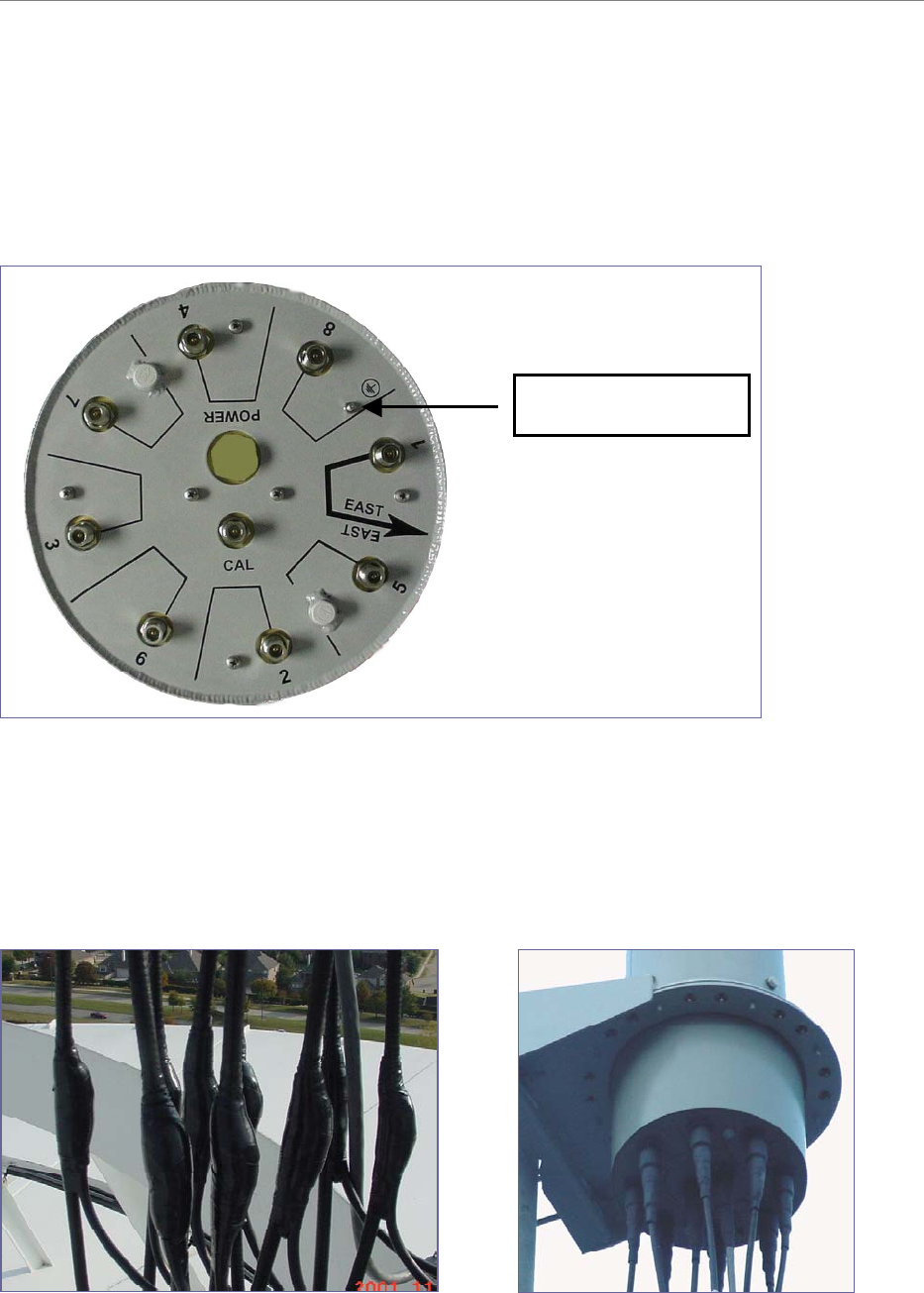
Ripwave Base Station I&C Guide Navini Networks, Inc.
68 Part #40-00047-00 Rev D v1.0
February 28, 2003
Sweep the RFS antenna inputs for db loss. Record all results for later calculations. Position the
RFS on the Antenna Mount, ensuring that the arrow on the bottom of the Antenna Mount faces
true East. Secure the RFS antenna to the Antenna Mount (Figure 41). Install surge protectors on
the 8 antenna and 1 cal connectors.
Figure 41: Omni Ground Stud
Connect the eight antenna cables, cal cable, and Data/Power cable to the RFS antenna. Attach the
ground wire to the ground stud. Install grounding kits from RF cables to buss bars. Sweep the
antenna and cables from the RF cable connectors that attach to the BTS. Record all
measurements. Weatherize all connections (Figure 42).
Figure 42: Weatherized Connectors
Ground stud
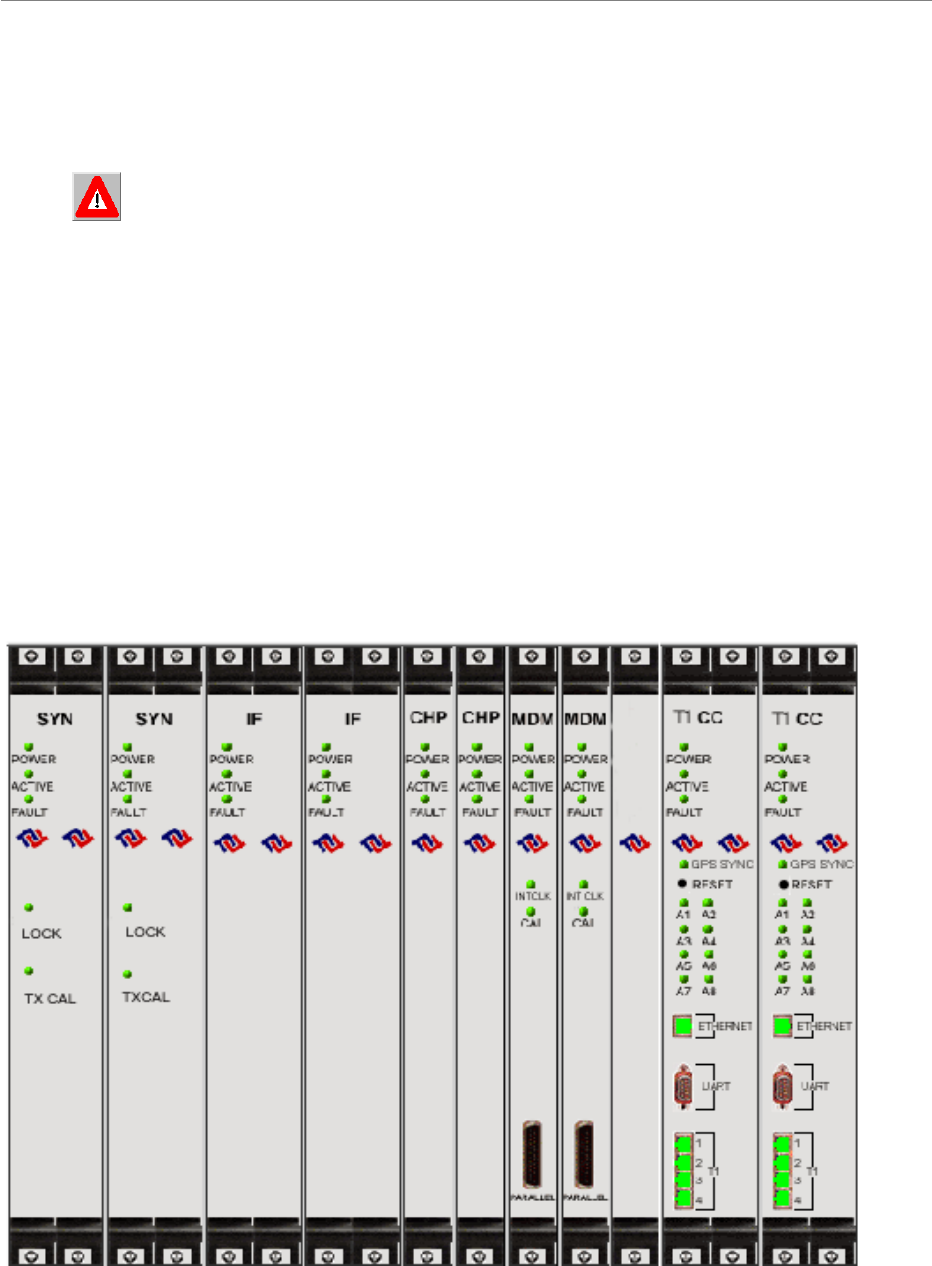
Navini Networks, Inc. Ripwave Base Station I&C Guide
Part #40-00047-00 Rev D v1.0 69
February 28, 2003
Verify Installed Circuit Cards
WARNING! Ensure that power to the BTS chassis is off before installing the
circuit cards or any of the RF Power Amplifiers in the chassis.
The circuit cards, including the RF/PA cards, normally come seated in the BTS chassis. If they
are already installed, verify that the correct cards are placed and seated properly. The RF/PA
modules may be installed in any position on the top (RF) shelf. For the Digital shelf, refer to
Figure 36 for correct card placement. Table 9 describes the name of each type of card in the
Digital shelf.
Tighten the screws to secure the RF/PA’s into the RF shelf. For the circuit cards, follow the
markings on the backplane for the position of each card in the Digital shelf. Make sure the
ejectors on all cards are engaged in the chassis. Figure 43 represents a fully populated Digital
shelf. If the BTS is not fully populated, blank panels are installed to fill in the empty card space.
They are also used to fill in the empty space between the circuit cards and the end of the cabinet.
Figure 43: Digital Shelf
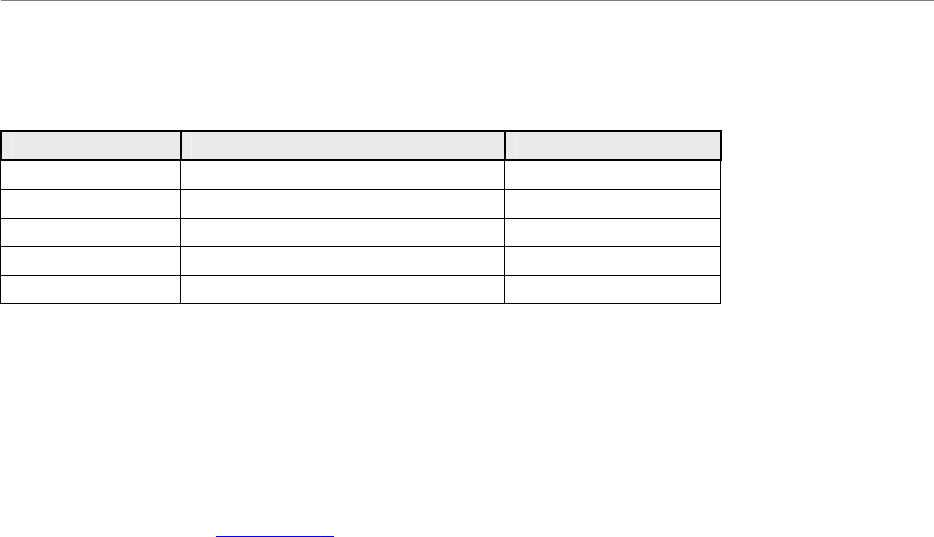
Ripwave Base Station I&C Guide Navini Networks, Inc.
70 Part #40-00047-00 Rev D v1.0
February 28, 2003
Table 9: Digital Card Names
Abbreviation Card Name Number of Cards
SYN Synthesizer 1 or 2
IF Intermediate Frequency Always 2
CHP Channel Processor Always 2
MDM Modem Always 2
CC Communications Controller 1 or 2
Base Station Installation Certification
When the installation of the equipment is complete, the Base Station Installation Certification
form needs to be completed and signed off by both the installer and the customer. A copy of this
form may be found in Appendix D.

Navini Networks, Inc. Ripwave Base Station I&C Guide
Part #40-00047-00 Rev D v1.0 71
February 28, 2003
Chapter 3: Commissioning
This chapter provides post-installation instructions on provisioning, configuring, calibrating,
testing, and commissioning the Ripwave Base Station.
Review Customer Network Plans
As part of preparing to put the BTS into commission, it is important to review the actual installed
site against the customer Network Architecture Plan - i.e., checking that all equipment and
software are installed and available for use. Verify that all routers are installed and IP addresses
are correct. Finally, make sure the installation is approved and signed off by all responsible
parties.
Install EMS Server
The EMS is the management interface for all elements in the Ripwave system. The EMS Server
has to be installed on a computer that is connected directly to the Base Station (called the Test
EMS) or through the system backhaul (customer EMS).
For testing purposes, the Test EMS Server is connected through an Ethernet hub or switch to the
Ethernet port found on the front of the BTS (Figure 44). Note that the EMS Server does not
support more than one Network Interface Card (NIC).
The other port on the front of the CC card is a Serial (Universal Data) Port, also known as the
Console Port. Using a laptop/portable computer connected through the data port, an on-site
technician can communicate directly with the BTS using a terminal emulation software package.
However, this is not recommended. It is always best to rely on the EMS interface for BTS
information.
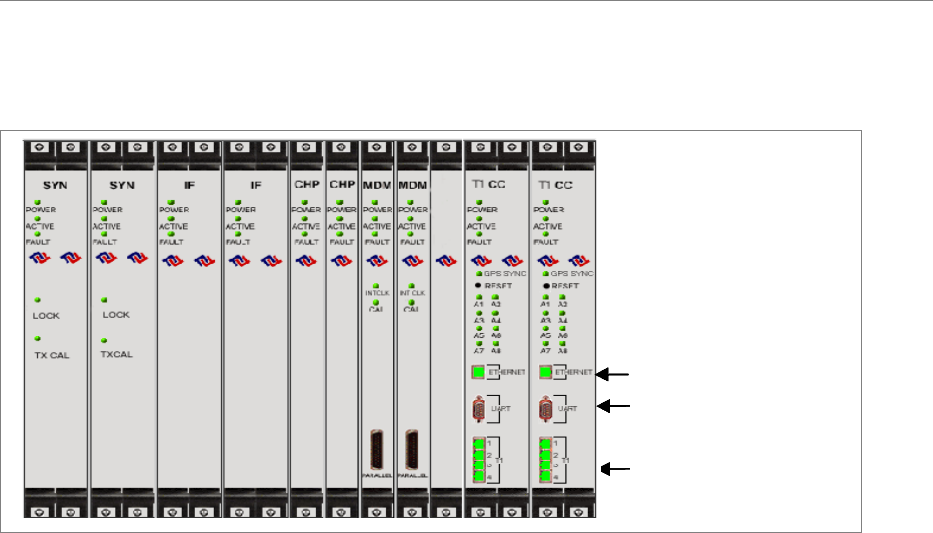
Ripwave Base Station I&C Guide Navini Networks, Inc.
72 Part #40-00047-00 Rev D v1.0
February 28, 2003
Figure 44: Ports on CC Card
If the customer’s EMS is installed and can be accessed through the backhaul, it can be connected
via T1 or Ethernet to the BTS and used for testing purposes. The EMS software installation
procedures can be found in the EMS Software Installation Guide, P/N 40-00017-00.
After the EMS Server and Client applications are installed, the EMS database needs to be
configured with the settings that are designated for the Base Station. The settings are found in the
Network Architecture Plan provided by the customer.
Verify Cable Connections
Before proceeding, verify that all power is connected and present. Ensure that all T1 or Ethernet
connections are installed correctly and are active. Verify that the BTS and the RFS are properly
installed and that all cables are connected.
Ethernet Connector
T1 Connectors
Serial Port Connector
Ethernet Connector
Serial Port Connector
(aka, Console Port)
Ethernet Connector
T1 Connectors
Serial Port Connector
Ethernet Connector
Serial Port Connector
(aka, Console Port)

Navini Networks, Inc. Ripwave Base Station I&C Guide
Part #40-00047-00 Rev D v1.0 73
February 28, 2003
Configure & Power Up the BTS
Overview
During initial power up a minimal set of configuration parameters have to be input to the BTS
through the serial port on the CC card. These early configuration parameters are referred to as
the “boot parameters”. They are required to get the BTS to communicate with the EMS Server so
that all the configuration data can be downloaded from EMS to the BTS.
The PC used at this point is a Test EMS Server (i.e., laptop). If the customer’s actual EMS
Server is available, a separate Test EMS (i.e., laptop) may not be necessary. For simplification,
whether it is a Test EMS laptop or the customer’s EMS Server, we refer to the device at this
stage as the Test EMS.
Set Up the Test EMS
Typically, in order to keep a constant link an Ethernet hub (10/100 Base-T) connects the Test
EMS to the BTS via a male to female RS-232 cable connected to the CC serial port. A
connection between the serial port on the CC and the serial port on the Test EMS is also used.
Standard communication software, i.e., a standard terminal emulation program, such as Windows
HyperTerm or TeraTerm, is used during these early configuration stages.
Step 1. Verify all RF cables going to the BTS are securely connected to the proper connector.
Step 2. Connect an Ethernet cable to the Ethernet connector located on the CC card and to an
Ethernet hub. Connect another Ethernet cable from the Ethernet hub to the Ethernet
connector on the PC containing the Test EMS Server and Client applications.
Step 3. Connect an RS-232 cable (DB-9 male to female) to the serial port (UART) located on
the CC card to the serial port connector on the Test EMS computer.
Note: A VT 100 terminal or any standard Windows based ASCII terminal emulation
program can be used for connecting to the serial port. The connection for
HyperTerminal is explained here. The steps to get to the HyperTerminal program may
be different due to variances in the Operating Systems and in the setup of the PC.
Step 4. Power on the Test EMS Server.
Step 5. On the desktop, go to Start > Programs > Accessories > HyperTerminal >
HyperTerminal (using whichever terminal emulation program you are running).
Step 6. In the COM1 Properties window (Figure 45), under the Port Settings tab, enter the
following configuration options. Click OK.
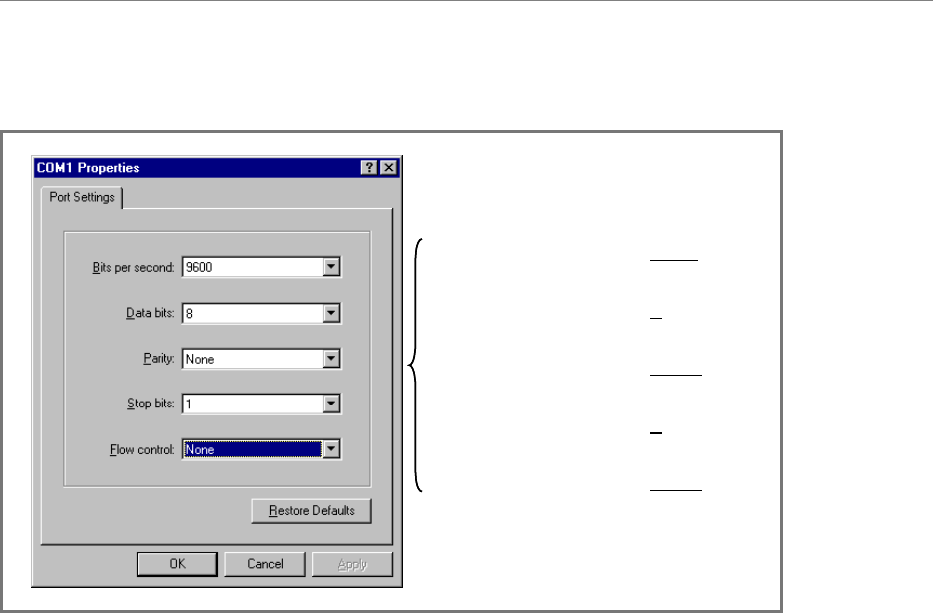
Ripwave Base Station I&C Guide Navini Networks, Inc.
74 Part #40-00047-00 Rev D v1.0
February 28, 2003
Figure 45: COM1 Properties
Step 7. On the Test EMS Server, click on the Server icon to start the EMS Server. NOTE: This
step assumes you have loaded and configured the EMS Server & Client applications.
Step 8. Click on the EMS Configuration & Alarm Manager (CAM) icon to start the EMS
Client GUI.
Step 9. At the EMS Configuration & Alarm Manager login screen, enter the user name and
password. The defaults are both emsAdmin.
Add BTS in EMS
Once you have the CAM application running on the Test EMS server, you will need to click on
the BTS element tab to add the new BTS. Only the minimal configuration parameters have to be
completed at this time - i.e., BTS name, ID, IP address, subnet mask, and gateway. Follow the
Network Architecture Plan designed for this system.
Also configure the GPS offset time. The default is 0 minutes, indicating the BTS would be
located in the same time zone as Greenwich Mean Time (GMT). Change this value to whatever
time is appropriate to the location of the BTS in relation to GMT time zone. For example, if the
BTS is located in Dallas, Texas, which is 6 hours behind GMT time zone, you would enter -360.
As you will see in the section that follows, you will also configure the RFS splitter loss at this
time. For more details about configuring a BTS, refer to the Ripwave Configuration Guide.
Bits per second: 9600
Data Bits: 8
Parity: None
Stop Bits: 1
Flow Control: None
Bits per second: 9600
Data Bits: 8
Parity: None
Stop Bits: 1
Flow Control: None

Navini Networks, Inc. Ripwave Base Station I&C Guide
Part #40-00047-00 Rev D v1.0 75
February 28, 2003
Configure RFS (Splitter Loss Value)
Each RFS shipped is pre-programmed for the customer’s specific operating environment. An
RFS Configuration CD accompanies the RFS equipment when it is shipped. The CD includes an
RFS script and a Quick Guide with procedures on selecting the appropriate splitter loss values to
be entered into the EMS database for the given Base Station. Each Configuration disk is unique
to the individual RFS that is shipped. You cannot use the same disk on other RFS equipment.
RFS Configuration Procedure
Step 1. Remove the RFS Configuration disk from the RFS packaging, and insert it in the
floppy drive of the Test EMS.
Step 2. Copy the folder named “RFS” that is on the disk to the Test EMS Server:
<ems install dir>/scripts.
It will take approximately 20 seconds to complete.
Step 3. Open the new folder on the EMS server. You will see a list of file names. The format
of the file names is as follows:
RFS_serial number_frequency.cli
Example: “RFS_024300001_2402500.cli” - This example of the configuration file is
for an RFS with serial number 024300001 and a center frequency of 2.4025.
Verify the correct serial number in the file name against the serial number of the RFS
equipment. The equipment serial number may be found on the back of the RFS panel
or on the side of the bottom cylinder of the omni antenna.
Step 4. Determine which file you need to run, depending on the provisioned frequency of your
BTS.
NOTE: For 2.6 GHz systems, select the frequency that is closest to your provisioned
center frequency. To find the provisioned center frequency for your BTS, open the
EMS Configuration & Alarm Manager (CAM) application. Select the BTS tab and
specific BTS, then Air Interface / Layer 2 / Carrier Data / Show Configuration. This
will display the center frequency information.
Step 5. Open the selected CLI file for editing using any text processing application program.
Note the power splitter values listed there (i.e., write them down or print them out).
Step 6. Modify the line that starts with “bts” by changing the BTS ID for your BTS. The
default is “BTS 1”. For example, if the ID for your BTS is 252, change the “1” to
“252”.

Ripwave Base Station I&C Guide Navini Networks, Inc.
76 Part #40-00047-00 Rev D v1.0
February 28, 2003
Step 7. Save this file as text, and then close it.
Step 8. Start the EMS Config CLI application to run “script <CLI script>”. Do this by entering
the following:
>enable <user name> <password>
>configure
>script scripts/rfs/rfs_<serial number>_<7-digit frequency>.cli
NOTE: For Unix operating systems, the CLI text is case sensitive and the slash marks
should be backward slashes instead of forward slashes.
Step 9. View the Power Splitter values in EMS to verify that the CLI script ran as expected.
The Power Splitter values may be found under Layer 1 / Show Configuration >
Antenna Table. You will need to “Refresh” the active screen to view the updated
information.
Step 10. Type “Exit” twice to exit the Config CLI edit mode.
Power Up BTS
Now you are ready to power up the BTS.
Step 1. Ensure that input power has been connected to the BTS.
Step 2. Switch the Power to ON. If the BTS is a Combo Chassis, the switch is located on the
top right front of the BTS. The green Power On light next to the switch will illuminate
(Figure 46).
If the BTS is a Split Chassis, the Power ON switch is located on the back lower middle
of the Digital shelf. The green LED’s on the RF/PA modules and the circuit cards in
the BTS chassis should illuminate.
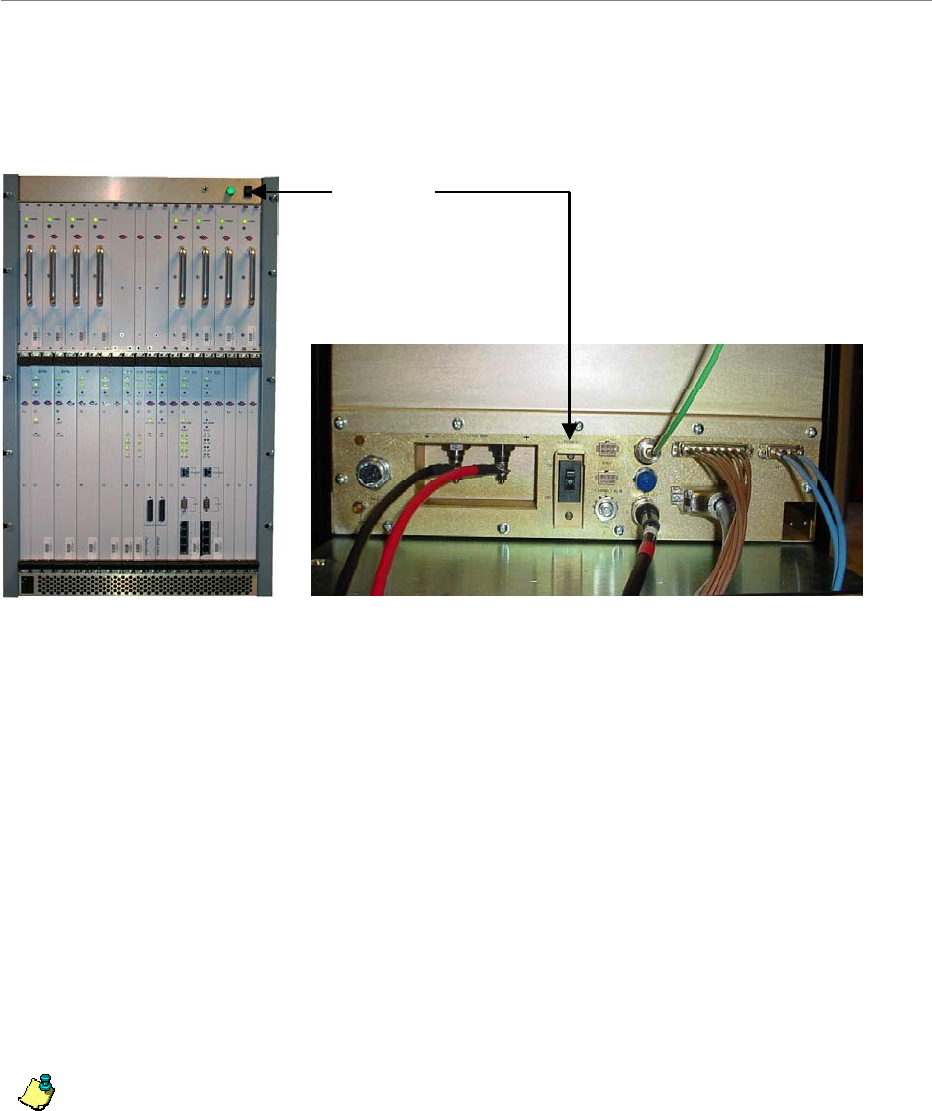
Navini Networks, Inc. Ripwave Base Station I&C Guide
Part #40-00047-00 Rev D v1.0 77
February 28, 2003
Figure 46: BTS Power On Switches
Step 3. Watch for the auto-boot countdown command. Type in config on the computer
keyboard to interrupt the standard boot sequence. The window of time to type in
“config” after auto-boot starts is 20 seconds.
BTS Bootup
The BTS is shipped with a default value of a 20-second countdown to interrupt the standard
bootup sequence. You can escape the standard bootup when the display shows the following:
autoboot countdown : quick [quick|delayed]
To escape the initialization sequence, type in config before the 20-second counter reaches zero.
Note: Under the next section, “Boot Prompt”, you will see how to disable the 20-second
countdown in lieu of a shorter, 1-second countdown. This will minimize downtime
during unattended restart conditions, for example, if there is a power outage and the BTS
is recovering.
Off/On switch
Power
ON/OFF
Combo Chassis
Split Chassis
Off/On switch
Power
ON/OFF
Combo Chassis
Split Chassis

Ripwave Base Station I&C Guide Navini Networks, Inc.
78 Part #40-00047-00 Rev D v1.0
February 28, 2003
Boot Prompt
After you have escaped from the automated boot sequence, the console will display a
rudimentary Boot prompt:
[Navini Boot]:
This prompt offers the ability to perform a small set of operations. Enter ‘?’ or ‘h’ followed by
the Enter key to display a list of commands (Exhibit 1). To invoke any of the commands, simply
enter the single letter command with optional parameters, followed by the Enter key.
.
Exhibit 1: Boot Commands
[Navini Boot]: ?
?-print this list
@-resume boot sequence
p -print boot params
c-change boot params
d adrs[,n] -display memory
m adrs-modify memory
f adrs, nbytes, value - fill memory
t adrs, adrs, nbytes - copy memory
@ – Use this command once all parameters have been set as desired. This will resume the boot
initialization sequence that you escaped from previously.
p – This command displays a concise representation of the current parameters used for boot
configuration.
c – Use this command to alter the current boot parameters. Once selected, a detailed sequence of
options is prompted, and is covered in detail later. After all of the items in this list are completed,
you return to the [Navini Boot]: prompt. This option sequence allows you either to accept the
current value by pressing the Enter key or to enter a new value from the range or values listed,
followed by the Enter key. Additionally, you can enter ‘.’ followed by the Enter key to erase the
current value of an item and return it to a default state. If you make an error, you can choose ‘-‘
(hyphen) followed by the Enter key to return to the previous item in the list. Alternatively, you
can fix an error by proceeding with the selections and select ‘change' when you return to the
[Navini Boot]: prompt.
d – Display memory allows you to display portions of the BTS’s memory with user-defined
values. It should only be performed with the assistance of a certified Navini service technician.
m – Modify memory allows you to alter portions of the BTS’s memory with user defined values.
It should only be performed with the assistance of a certified Navini service technician.

Navini Networks, Inc. Ripwave Base Station I&C Guide
Part #40-00047-00 Rev D v1.0 79
February 28, 2003
f – Fill memory allows you to alter portions of the BTS’s memory with a fixed pattern. It should
only be performed with the assistance of a certified Navini service technician.
t – Fill memory allows you to alter portions of the BTS’s memory with a pattern from another
area of memory. It should only be performed with the assistance of a certified Navini service
technician.
Ethernet Configuration
The Ethernet configuration is grouped into three sections: general, EMS, and traffic path. An
example of the Ethernet configuration parameters is shown in Exhibit 2.
Exhibit 2: Ethernet Configuration
[Navini Boot]: p
date and time:01/09/2003[10:19] MM/dd/yyyy[hh:mm]
autoboot countdown:delayed [quick|delayed]
ems inet:172.16.0.10
snmp community:public
traffic path:enet [enet|atm]
mac address:00:04:6a:00:01:20
ip on enet (active) : 172.16.23.181
ip on enet (standby) : 172.16.23.182
netmask on enet:255.255.0.0
ip on backplane:10.0.0.1
gateway on enet :172.16.0.100
General
The general section offers you the ability to change the date and time manually. If a GPS has
been installed, the BTS will automatically set the date and time:
date and time : 08/21/2002[13:21] MM/dd/yyyy[hh:mm]
When this line is displayed, the current date (08/21/2002) and time [13:21] are displayed. Accept
the defaults by pressing the Enter key, or enter “date” at the console and a new value using the
format indicated in military time (Hours 1-24). All 5 fields must be entered as specified. Leading
zeroes can be omitted.
Previously, it was mentioned that the 20-second auto-boot countdown timer can be disabled and
a 1 second countdown can be used instead. To enable this feature, change the autoboot
countdown item from “delayed” (which is 20 seconds) to “quick”, which is 1 second:
autoboot countdown : delayed [quick|delayed]

Ripwave Base Station I&C Guide Navini Networks, Inc.
80 Part #40-00047-00 Rev D v1.0
February 28, 2003
EMS
This section concerns the configuration of the EMS Server itself. First, the Internet (inet) IP
address of the Server is specified. Make sure to fill this field with the address of the Server used
to configure this BTS. Your BTS is shipped with this field un-initialized. You must provide a
valid 4-digit IP address before you can proceed. For example:
ems inet : 172.16.0.10
The second parameter that you must specify to allow the EMS Server to recognize this BTS is a
community string for the EMS’s Simple Network Management Protocol (SNMP) interface. The
default community string shipped with the BTS is “public”. Press the Enter key to accept this
default, or type in a new value and press the Enter key to alter it:
snmp community : public
Traffic Path
The last major block of configurations required for an Ethernet backhaul to the BTS is the traffic
path parameters. The first prompt instructs the BTS to use the Ethernet as the WAN (backhaul)
configuration. It must be set to “enet” for an Ethernet backhaul.
If “atm” is selected, proceed with the description in the ATM or IMA sections. The BTS is pre-
configured to use Ethernet for the WAN connection. Press the Enter key to accept this default:
traffic path : enet [enet|atm]
The BTS address is specified next. Every BTS must be uniquely addressed and have values that
equate in the EMS configurations. This address information defines the Layer 2 parameters first,
and then it defines the Layer 3 parameters. For Layer 2, you are only given an opportunity to see
the Ethernet Media Access Control (MAC) address used by this BTS. This is a unique number
programmed in the BTS. You cannot alter it. However, situations may develop in which you
need to know the MAC address and, therefore, need to display the information. For example:
mac address : 00:04:6a:00:01:20
Next are the IP addresses that represent this BTS: one for the active CC card and one for the
standby CC card. The active Controller card is always addressed using an odd-numbered IP
address, i.e., 172.16.23.181. The standby Controller card uses the corresponding even-numbered
IP address one digit higher, i.e., 172.16.23.182.
ip on enet (active) : 172.16.23.181
ip on enet (standby) : 172.16.23.182

Navini Networks, Inc. Ripwave Base Station I&C Guide
Part #40-00047-00 Rev D v1.0 81
February 28, 2003
For this reason, the BTS only allows you to enter odd addresses in the range XXX.XXX.XXX.1
to XXX.XXX.XXX.253 in this field. The standby field is only displayed for your convenience
and cannot be altered. Note that the BTS automatically handles switching the address when a
failure occurs on an active Controller card, requiring the standby Controller to go into service.
However, the MAC addresses remain fixed.
Coupled with any IP configuration is a need to specify the corresponding subnet mask. Refer to
common network administration literature for guides on addresses, networks, masks, and
gateways. In short, the subnet mask identifies the portion of the IP address that is common to
those devices connected to the same Ethernet. The most important “other” device is the BTS’s
default gateway (specified later).
The portion is identified using a logical “and” of the mask with the address. For example, a
subnet mask of 255.255.0.0. and with an IP address of 172.16.23.182 yields a network of
172.16.x.x. In this case, the default gateway must also be on the 172.16.x.x network. The BTS
requires that this association be met. If not, you will be asked to try again.
netmask on enet : 255.255.0.0
The BTS uses a high-speed Serial Line Internet Protocol (SLIP) connection to communicate with
the redundant T1/Controller Card. This interface is only used internally and has a fixed subnet
mask of 255.255.255.252.
The host portion of the address - that is the least significant 2 bits - is automatically provided by
the software based upon slot ID. However, you may want to alter the default network address to
avoid conflict with your network.
The BTS is shipped with the 10.0.0.0 network as the internal network. This is a reserved network
not used on the Internet. However, if your private network utilizes this private address space, you
may need to change it to avoid the conflict.
ip on backplane : 10.0.0.1
As for the default gateway for the BTS, all traffic routed outside the directly connected Ethernet
port goes through the gateway. Furthermore, the gateway must be reachable on the directly
connected Ethernet port. Therefore, the BTS will prevent you from entering a default gateway
address that fails the logical “and” test discussed previously. This address is specified on the line
item shown below:
gateway on enet : 172.16.0.100

Ripwave Base Station I&C Guide Navini Networks, Inc.
82 Part #40-00047-00 Rev D v1.0
February 28, 2003
ATM/T1 Configuration
For an ATM/T1 configuration, the items shown in Exhibit 3 are identical to Ethernet with the
exception of the traffic path, which must show “atm” for this type of configuration.
Exhibit 3: ATM/T1 Configuration
date and time:01/09/2003[10:22]
autoboot countdown:delayed
ems inet:172.16.0.10
snmp community:public
traffic path:atm
mac address:00:04:6a:00:01:20
ip on atm (active) : 172.16.23.181
ip on atm (standby) : 172.16.23.182
netmask on atm:255.255.0.0
When ATM is selected for the WAN interface using the traffic mode parameter, an additional set
of parameters is required (Exhibit 6). First of all, another IP address must be identified for the
ATM interface. The ATM IP address cannot be the same as the Ethernet IP address. In this case,
the Ethernet IP address is only used for debug purposes and is a non-routed interface. This means
that the BTS can only reach other computers directly connected to the Ethernet port of the BTS.
The only routed interface available is through the ATM port. This routed interface address is
specified with the “ip on atm” line item and the corresponding netmask parameter (Exhibit 4).
The information on network address specifications from the Ethernet Configuration section of
this chapter applies to ATM as well. For ATM, the only gateway allowed for the BTS is on the
ATM interface, as specified here.
Exhibit 4: Additional ATM Parameters
ip on atm (active):172.17.0.101
ip on atm (standby) : 172.17.0.102
netmask on atm:255.255.0.0
ip on backplane:10.0.0.1
gateway on atm:172.17.0.100
For an ATM system, the BTS must have some additional configuration for the Management
Private Virtual Channel (Management PVC). Recall the boot parameter philosophy discussed
before. The boot parameters only identify those settings required to allow the BTS to reach the
EMS. Note that the boot parameters only allow specification for one PVC (the Management
PVC), which is used to reach the EMS.
All user traffic PVC parameters are specified in the EMS configuration. Ensure that the EMS
parameters for the Management PVC match those being set here through the boot prompt. If not,
as soon as connection is made with the EMS, the Management PVC will be reconfigured and can
potentially disconnect the BTS from the network.

Navini Networks, Inc. Ripwave Base Station I&C Guide
Part #40-00047-00 Rev D v1.0 83
February 28, 2003
The PVC configuration is broken into 3 sections: ATM layer parameters; optional Inverse
Multiplexing over ATM (IMA) parameters, and T1 physical layer parameters. The first item
selects which ATM interface will be used for the Management PVC. If IMA is not selected, you
may select from one of the 8 T1 ports numbered 1-8 using the option t1-N, where N is the port
number. This is the same interface port number specified in the EMS. If IMA is desired,
reference the following section:
pvc type-atm i/f : t1-0 [t1-(1-8)|ima-(1-2)]
The circuit identifier for this segment of the Management PVC is the next item specified. The
first parameter identifies the maximum number of bits for any PVC’s identifier Virtual Path
Identifier/ Virtual Channel Identifier (VPI/VCI) pair. The BTS restricts the available set to 13
total bits. However, you are free to divide those 13 bits between the VPI and VCI as needed,
with the VPI having a maximum allocation of 8 bits. You can choose the number of bits for each
by selecting two values separated by a “:”. Or you may select the BTS default of 3 VPI bits and
10 VCI bits by pressing the Enter key:
pvc id size vpi:vci : 3:10 [1-8:1-13]
Having specified the number of significant VPI and VCI bits, now select the actual identifier.
The BTS will restrict the values entered for the VPI and VCI to the ranges you selected in the
previous size specification. For instance, if 3:10 is selected as a size allocation, the VPI must be
between 0 and 7.
Again, you can select the values for the VPI and VCI separated by a “:” or accept the default
value of VPI = 1 and VCI = 100 by pressing the Enter key. Be careful not to use the reserved
VCI values from 0-15 that are often used in ATM networks for Operation, Administration, and
Maintenance (OAM) purposes.
pvc vpi:vci : 1:100 [0-255:16-8192]
The service category for the Management PVC is specified next. The choices are Unspecified Bit
Rate (UBR) or Constant Bit Rate (CBR). Other ATM service categories are available for traffic
PVC’s, but those are specified in the EMS configuration. UBR and CBR both require a set data
rate and delay variation parameter. The data rate is specified in cells per second in the ATM
Traffic Contract’s Peak Cell Rate (PCR) field. The delay variation is in the ATM Cell Delay
Variation Tolerance (CDVT) in the ATC’s CDVT field. Specify the PCR and the CDVT values
separated by a “:” or chose the default by pressing the Enter key.
pvc service category : ubr [cbr|ubr]
pvc atc pcr:cdvt : 3641:100 [1-3641:0-100]

Ripwave Base Station I&C Guide Navini Networks, Inc.
84 Part #40-00047-00 Rev D v1.0
February 28, 2003
The final set of values is used to configure the T1 parameters. The line type allows you to select
Extended Super-Frame (ESF) or D4. ESF format is the standard format for ATM/T1
applications. D4 format is supported as an alternate; however, T1 signaling capabilities may be
limited. Check your network plans for a definition for your specific application.
line type : esf [esf|d4]
Additionally, you must choose a line coding type:
line coding : b8zs [b8zs|ami]
The approximate length of the T1 line is specified next. It is used to control the signal
conditioning used on the T1:
line length (ft) : 500
Finally, the T1’s timing source must be specified. A T1 uses only one timing source either at the
near-end or far-end of the line. You may select the BTS as the originator of the timing source by
selecting “local”, or you may select the far-end as the timing reference by selecting “loop”.
line clock source : loop [loop|local]
IMA Configuration
If you decide to utilize IMA groups to pool the T1 resources, then the same parameters described
for the ATM/T1 Configuration above also apply to configuring IMA’s. Refer to Exhibit 5.
Exhibit 5: IMA Configuration
date and time:08/21/2001[10:22]
ems inet:172.16.0.10
snmp community:public
traffic path:atm
mac address:00:04:6a:00:01:20
ip on enet (active) : 172.16.23.181
ip on enet (standby) : 172.16.23.182
netmask on enet:255.255.0.0
ip on atm (active):172.17.0.101
ip on atm (standby) : 172.17.0.102
netmask on atm:255.255.0.0
ip on backplane:10.0.0.1
gateway on atm:172.17.0.100
In addition, the ATM interface must be specified as IMA and reference one of two IMA groups
used for the Management PVC. This IMA group must match what is identified in the EMS. Use
“0” for the first group and “1” for the second group.

Navini Networks, Inc. Ripwave Base Station I&C Guide
Part #40-00047-00 Rev D v1.0 85
February 28, 2003
Each group identifies a set of T1 ports that are being combined to form one larger virtual port.
For the sake of boot parameter specification, ALL T1 interfaces for the Management PVC’s
IMA group are assumed to be identical. So the parameters for T1 specifications apply to all T1’s
of the IMA group:
pvc type-atm i/f : ima-0
Once the IMA interface is selected, a set of IMA parameters must be specified for the IMA
group used by the Management PVC. An IMA group inherently supports dynamic addition and
drops of individual T1 facilities from the group to facilitate fault tolerance to failed T1 facilities.
The minimum number of T1 ports, or links, that must exist for the IMA group to function is
specified here. A value from 1-7 is required for each of the receive and transmit directions.
Separate the values with “:”. You can increase the values from the default of 1 link in each
direction or accept the default by pressing the Enter key.
ima min rx:tx links : 1:1 [1-7:1-7]
Next, specify which T1 ports are used to form the IMA group. This is a list of T1 port identifiers
(1-8), each separated by commas. The BTS makes sure you enter at least as many links as you
specified for the minimum requirements above:
selected ima links : 1,2,3,4,5,6,7,8
The near- and far-end IMA protocols use an ID number to identify each other. This value must
agree with that provisioned at the far-end of the IMA link. The BTS defaults to a value of 0, but
you can specify any value from 0 to 255:
ima group id : 0 [0-255]
Group symmetry modes allow symmetric or asymmetric operation of IMA links:
ima symmetry : sym [sym|asym|asym-cfg]
IMA frame length specifies the size of the IMA frames that are being transmitted:
ima frame length : 128 [32|64|128]
The IMA alpha/beta/gamma parameters are used by the IMA frame synchronization mechanism.:
ima alpha:beta:gamma : 2:2:1 [1-2:1-5:1-5]
The IMA clock mode selects either a common or independent IMA clock mode (Exhibit 6). It is
the same as for ATM/T1.

Ripwave Base Station I&C Guide Navini Networks, Inc.
86 Part #40-00047-00 Rev D v1.0
February 28, 2003
Exhibit 6: IMA Clock Mode
ima clock mode:ctc [ctc|itc]
pvc id size vpi:vci : 3:10
pvc vpi:vci:1:100
pvc service category : ubr
pvc atc pcr:cdvt:3641:100
line type:esf
line coding:b8zs
line length (ft):500
line clock source:loop
Standard Boot Sequence
The first items in Exhibit 7 (Ethernet) and Exhibit 8 (ATM) illustrate the BOOTROM loading
and launching of the core application. This is a fixed process that cannot be altered in the field.
Auto-booting is the process that can be escaped by user intervention, (i.e., enter “config”), in
order to enter the boot prompt. Without user intervention, the remaining sequence occurs
automatically; hence, “auto-boot”.
Exhibit 7: Standard Ethernet Boot Sequence - Example
System Boot
Copyright 2000-2001 Navini Networks, Inc.
Copyright 1984-1998 Wind River Systems, Inc.
CPU: CC (PPC860P)
Kernel Version: 5.4
BSP version: 1.0/110501
Creation date: Nov 5 2001, 13:09:12
Attaching to TFFS... done.
Loading /tffs0/LOADS/BTSA/core...5249740
Starting at 0x10000...
Auto-booting..............................Done
Starting File System......................Done
Mounting Drive /tffs0.....................Done
Mounting Drive /dev0......................Done
Mounting Drive /dev1......................Done
Starting TCP/IP Stack.....................Done
Starting ARP..............................Done
Starting motfec I/f.......................Done
Attaching sl(0) I/f.......................Done
Attaching motfec(0) I/f...................Done
Attaching lo(0) I/f.......................Done
Mounting Remote Filesystem................Done
Starting Telnet Daemon....................Done
Starting Load Monitoring Tools............Done
Loading Target Shell Symbols..............Done
Starting WDB Tools........................Done
Starting Target Shell.....................Done
Initializing System Logger................Done
Starting Application......................Done
Starting LLC I/f..........................Done
Starting LLC Proxy........................Done
Starting Lpbk Proxy.......................Done

Navini Networks, Inc. Ripwave Base Station I&C Guide
Part #40-00047-00 Rev D v1.0 87
February 28, 2003
Starting CDI..............................Done
Starting CAM I/f..........................Done
Starting MME..............................Done
Starting EtherBridge......................Done
Starting DHCP Relay Agent.................Done
Starting Peer ARP Proxy Agent.............Done
Starting Host ARP Proxy Agent.............Done
Starting Mobile IP Proxy Agent............Done
Starting LLC Proxy........................Done
Selecting Config Data Source as EMS ......Done
Loading LLC...............................Done
Initializing NvRam Mib ...................Done
Initializing SNMP Agent ..................Done
Pinging EMS (172.28.79.30)................Done
Loading MTMG..............................Done
Loading MDSW..............................Done
Loading MBSW..............................Done
Loading CAP...............................Done
Loading AUX_..............................Done
Loading LLC...............................Done
Loading MTMG..............................Done
Loading MDSW..............................Done
Loading MBSW..............................Done
Loading CAP...............................Done
Loading BAUX..............................Done
Loading BMCB..............................Done
Loading MACA..............................Done
Loading MACB..............................Done
Loading CHAD..............................Done
Loading CHTT..............................Done
Loading CDSW..............................Done
Loading BDSC..............................Done
Loading CHSL..............................Done
Loading CHMA..............................Done
Loading AUX_..............................Done
Loading LLC...............................Done
Stopping LLC Proxy........................Done
Evaluating bootload status................Done
Initializing DSP(s).......................Done
Starting LLC Proxy........................Done
Starting LLC Proxy........................Done
Updating Slot Table.......................Done
Requesting EMS for Configuration Data ....Done
Configuring BTS from EMS .................Done
Starting LLC Proxy........................Done
Configuring Diag Feature(s)...............Done
!!!!!!!! BTS Initialization Complete !!!!!!!!!
Z(TM)
NNNNZZZ
NNNNNNZZZZZNNii
NNNNNNNN ZZZZZZNNN
NNNNNNNNNN ZZZZZZNNNaaavvinnni
NNNNNNNNNNNN ZZZZZZNNNavvinnni
NNNNNN NNNNNN ZZZZZZNNNaaaa vvinni
NNNNNNNNNNNN ZZZZZZ ZZNNNaavvinni
NNNNNNZNNNNNN ZZZZZZZZZZNNaaaavinni
NNNNNN ZZZ NNNNNN ZZZZZZZZZ
NNNNNN ZZZZZ NNNNNN ZZZZZZZNETWORKS(TM)
NNNNNNN ZZZZZZ NNNNN ZZZZZZ
NNNNNNNNN ZZZZZZ NNN ZZZZZZ
NNNNNNNNNN ZZZZZZ N ZZZZZZInternet at the Speed of Thought (TM)
NN NNNNNN ZZZZZZZZZZZZ
NNNNNN ZZZZZZ ZZZZZZ Copyright (c) Navini Networks, Inc.2000-2002
NNNNNN ZZZZZZZZZZZZ Copyright (c) Conexant, Inc.2000-2001
NNNNNN ZZZZZZZZZZCopyright (c) NComm, Inc.1997-2001
NNNNNN ZZZZZZZZCopyright (c) RSA Data Security, Inc. 1991-1992
NNNNNZZZZZZCopyright (c) SNMP Research, Inc.1989-1999
NNNZZZZCopyright (c) Texas Instruments, Inc. 2000-2001
NCopyright (c) Wind River Systems, Inc. 1984-2000

Ripwave Base Station I&C Guide Navini Networks, Inc.
88 Part #40-00047-00 Rev D v1.0
February 28, 2003
KERNEL : 5.4(WIND version 2.5)
BSP:1.0/01.19.00.00
CPU: CC (PPC860P). Processor #0.
Memory Size: 0x3f80000.
WDB: Ready.
Last reset caused by a power on condition.
Current time is FRI JUL 12 14:48:29 2002
bts-4 [Active]%
Exhibit 8: Standard ATM Boot Sequence - Example
System Boot
Copyright 2000-2001 Navini Networks, Inc.
Copyright 1984-1998 Wind River Systems, Inc.
CPU: CC (PPC860P)
Kernel Version: 5.4
BSP version: 1.0/110501
Creation date: Nov 5 2001, 13:09:12
Attaching to TFFS... done.
Loading /tffs0/LOADS/BTSB/core...5249740
Starting at 0x10000...
Auto-booting..............................Done
Starting File System......................Done
Mounting Drive /tffs0.....................Done
Mounting Drive /dev0......................Done
Mounting Drive /dev1......................Done
Starting TCP/IP Stack.....................Done
Starting ARP..............................Done
Starting motfec I/f.......................Done
Starting wec I/f..........................Done
Attaching wec(0) I/f......................Done
Attaching sl(0) I/f.......................Done
Attaching motfec(0) I/f...................Done
Attaching lo(0) I/f.......................Done
Mounting Remote Filesystem................Done
Starting Telnet Daemon....................Done
Starting Load Monitoring Tools............Done
Loading Target Shell Symbols..............Done
Starting WDB Tools........................Done
Starting Target Shell.....................Done
Initializing System Logger................Done
Starting Application......................Done
Starting LLC I/f..........................Done
Starting LLC Proxy........................Done
Starting Lpbk Proxy.......................Done
Starting CDI..............................Done
Include CME Starting T1 I/f...............Done
Starting CAM I/f..........................Done
Starting MME..............................Done
Starting EtherBridge......................Done
Starting DHCP Relay Agent.................Done
Starting Peer ARP Proxy Agent.............Done
Starting Host ARP Proxy Agent.............Done
Starting Mobile IP Proxy Agent............Done
Starting PCI Bridge.......................Done
Starting Network Processor................Done
Starting LLC Proxy........................Done
Loading LLC...............................Done
Selecting Config Data Source as EMS ......Done
Initializing NvRam Mib ...................Done
Booting Network Processor ................Done
Configuring T1(s).........................Done
Configuring ATM Interface.................Done

Navini Networks, Inc. Ripwave Base Station I&C Guide
Part #40-00047-00 Rev D v1.0 89
February 28, 2003
Configuring IMA Group.....................Done
Configuring IMA Link......................Done
Configuring PVC(s)........................Done
Configuring Management PVC................Done
Initializing SNMP Agent ..................Done
Pinging EMS (172.28.79.30)................Done
Loading MTMG..............................Done
Loading MDSW..............................Done
Loading MBSW..............................Done
Loading CAP...............................Done
Loading AUX_..............................Done
Loading LLC...............................Done
Loading MTMG..............................Done
Loading MDSW..............................Done
Loading MBSW..............................Done
Loading CAP...............................Done
Loading BAUX..............................Done
Loading BMCB..............................Done
Loading MACA..............................Done
Loading MACB..............................Done
Loading CHAD..............................Done
Loading CHTT..............................Done
Loading CDSW..............................Done
Loading BDSC..............................Done
Loading CHSL..............................Done
Loading CHMA..............................Done
Loading AUX_..............................Done
Loading LLC...............................Done
Stopping LLC Proxy........................Done
Evaluating bootload status................Done
Initializing DSP(s).......................Done
Starting LLC Proxy........................Done
Starting LLC Proxy........................Done
Updating Slot Table.......................Done
Requesting EMS for Configuration Data ....Done
Configuring BTS from EMS .................Done
Starting LLC Proxy........................Done
Starting AtmMgmt..........................Done
Configuring Diag Feature(s)...............Done
!!!!!!!! BTS Initialization Complete !!!!!!!!!
Z(TM)
NNNNZZZ
NNNNNNZZZZZNNii
NNNNNNNN ZZZZZZNNN
NNNNNNNNNN ZZZZZZNNNaaavvinnni
NNNNNNNNNNNN ZZZZZZNNNavvinnni
NNNNNN NNNNNN ZZZZZZNNNaaaa vvinni
NNNNNNNNNNNN ZZZZZZ ZZNNNaavvinni
NNNNNNZNNNNNN ZZZZZZZZZZNNaaaavinni
NNNNNN ZZZ NNNNNN ZZZZZZZZZ
NNNNNN ZZZZZ NNNNNN ZZZZZZZNETWORKS(TM)
NNNNNNN ZZZZZZ NNNNN ZZZZZZ
NNNNNNNNN ZZZZZZ NNN ZZZZZZ
NNNNNNNNNN ZZZZZZ N ZZZZZZInternet at the Speed of Thought (TM)
NN NNNNNN ZZZZZZZZZZZZ
NNNNNN ZZZZZZ ZZZZZZ Copyright (c) Navini Networks, Inc.2000-2002
NNNNNN ZZZZZZZZZZZZ Copyright (c) Conexant, Inc.2000-2001
NNNNNN ZZZZZZZZZZCopyright (c) NComm, Inc.1997-2001
NNNNNN ZZZZZZZZCopyright (c) RSA Data Security, Inc. 1991-1992
NNNNNZZZZZZCopyright (c) SNMP Research, Inc.1989-1999
NNNZZZZ Copyright (c) Texas Instruments, Inc. 2000-2001
NCopyright (c) Wind River Systems, Inc. 1984-2000
KERNEL : 5.4(WIND version 2.5)
BSP:1.0/01.19.00.00
CPU: CC (PPC860P). Processor #0.
Memory Size: 0x3f80000.
WDB: Ready.

Ripwave Base Station I&C Guide Navini Networks, Inc.
90 Part #40-00047-00 Rev D v1.0
February 28, 2003
Last reset caused by a power on condition.
Current time is FRI JUL 12 14:26:59 2002
bts-4 [Active]%
Attaching to TFFS... done.
Loading /tffs0/LOADS/BTSB/core... 4337576
Starting at 0x10000...
Auto-booting..............................Done
The line items in Exhibit 9 are the ones that create and initialize the core components to the
BTS’s on-board file system. This file system is used to store operating code images,
configuration data, and log files. The BTS Operating System software handles the images, data,
and files and does not require operator assistance.
There are three on-board file systems’ FLASH and RAM drives. The FLASH drive is at /tffs0
and the two RAM drives use /dev0 and /dev1. All on-board file system drives have dedicated
functions and should not be altered or used through manual operations.
Exhibit 9: On-board File Systems
Starting File System......................Done
Mounting Drive /tffs0.....................Done
Mounting Drive /dev0......................Done
Mounting Drive /dev1......................Done
The sequence shown in Exhibit 10 initializes the TCP/IP stack on the BTS. The TCP, UDP, IP,
and ARP protocol stacks are created. Interfaces for the stack are then created and attached to the
stack. Three or four interfaces are created depending on the selection for “traffic path” in the
boot parameters.
The Fast Ethernet Controller, fec (0), is created and attached for the 10/100 Ethernet ports on the
BTS. If “atm” is selected, then a WAN Ethernet Controller, WEC (0), is also created and
attached to the stack to perform RFC1483 Ethernet bridging onto the ATM interface. Internally,
the BTS utilizes a high-speed SLIP interface, sl (0), to provide communication between
redundant devices. Finally, a debug local loopback interface, lo (0), is created and attached.
Exhibit 10: TCP/IP Stack
Starting TCP/IP Stack.....................Done
Starting ARP..............................Done
Starting fec I/f..........................Done
Starting wec I/f..........................Done
Attaching wec(0) I/f......................Done
Attaching sl(0) I/f.......................Done
Attaching fec(0) I/f......................Done
Attaching lo(0) I/f.......................Done

Navini Networks, Inc. Ripwave Base Station I&C Guide
Part #40-00047-00 Rev D v1.0 91
February 28, 2003
Next, the user interface through the console port on the BTS is activated. It should be noted
however, that once the Telnet Daemon has been started, this same interface is available remotely
through a password protected telnet session. You can access the remote shell service by
telnetting directly to the well-known Telnet port (23) of the BTS:
Starting Telnet Daemon....................Done
This invokes a suite of tools accessible by the Navini developers to assess runtime loads of
various components in the system:
Starting Load Monitoring Tools............Done
This creates a database of commands that can be issued from the shell:
Loading Target Shell Symbols..............Done
This in turn invokes a suite of tools accessible by the Navini software developers to access
runtime debugging of the system:
Starting WDB Tools........................Done
This starts the actual interface for the console command interface:
Starting Target Shell.....................Done
The BTS is equipped with a rich suite of logs that are automatically collected for analysis by
Navini developers in the unlikely event a crash occurs. This line item invokes the automatic log
collection:
Initializing System Logger................Done
The core software is separated into operating system initialization and Ripwave application
software that provides OAM and bridging functionality. This line item identifies the transition
point from OS initialization to the point where the OS begins spawning application level tasks:
Starting Application......................Done
The next task provides an interface to the Logical Link Control (LLC) on the MDM card and
forms a conduit for all message and user traffic from the CC to MDM card.
Starting LLC I/f..........................Done

Ripwave Base Station I&C Guide Navini Networks, Inc.
92 Part #40-00047-00 Rev D v1.0
February 28, 2003
A Command and Debug Interface is initialized to extend rudimentary target shell capabilities for
Navini developers to diagnose problems with the Digital Signal Processors on the MDM and
CHP cards:
Starting CDI..............................Done
The Content Addressable Memory (CAM) is used to provide mappings of users to channels. This
mapping interface is started at this point:
Starting CAM I/f..........................Done
The management entity for CPE mobility, nomadicity, and access control security is handled by
the MME application that is started at this point:
Starting MME..............................Done
The protocol bridging performed by the BTS for user traffic is handled by the EtherBridge
component. Depending on the traffic mode selected, the EtherBridge will perform varying
protocol encapsulation methods, such as RFC1483 bridging over ATM. The bridge is started at
this point:
Starting EtherBridge......................Done
Network layer protocol security and mobility applications are handled by specialized protocol
handler components. Various modes of operation are configurable through the EMS and provide
such services as DHCP address learning and authentication assistance via the DHCP Relay
Agent, Proxy ARP broadcast security, and network layer mobility support. These components
are started at this point:
Starting DHCP Relay Agent.................Done
Starting Peer ARP Proxy Agent.............Done
Starting Host ARP Proxy Agent.............Done
Starting Mobile IP Proxy Agent............Done
An LLC Proxy is an object that provides relay service via the LLC IF conduit to the MDM card.
Objects on the CC card can communicate with an object on the MDM card directly using such a
proxy. Several such proxied objects exist and are created with this message:
Starting LLC Proxy........................Done
As the CC card downloads and initializes the DSP’s on the MDM and CHP cards, each
component is identified with a “Loading” message:
Loading LLC...............................Done

Navini Networks, Inc. Ripwave Base Station I&C Guide
Part #40-00047-00 Rev D v1.0 93
February 28, 2003
The next item that appears notifies the user of the location where the BTS is retrieving its
Management Information Base (MIB). After initial installation and provisioning through the boot
line, “EMS” is selected as the Config Data Source. In this case, all remaining parameters are
downloaded from the EMS.
Once the BTS and EMS have synchronized and ownership of individual elements in the MIB
negotiated, subsequent reboots of the BTS will indicate the local “BTS” copy of the MIB is
being used. This reduces the burden and start-up time of a system-wide restart:
Selecting Config Data Source as BTS ......Done
Once the MIB information is identified, the SNMP agent is initialized. At this point, the EMS
can begin communicating with the BTS via this agent:
Initializing SNMP Agent ..................Done
The BTS tests that a path through the WAN exists to its EMS Server. That test is identified next
in the sequence. If the EMS is selected as the Config Data Source, the initialization cannot
continue. If the “BTS” is selected as the data source, the BTS can continue to initialize.
However, it will be unmanaged, as the EMS cannot communicate with the BTS.
Pinging EMS (172.16.0.10).................Done
A status message appears indicating that all DSP’s have been downloaded and are now
beginning the initialization process:
Bootload is a success.....................Done
Initialization can take a significant period of time, with progress through the DSP initialization
shown by a growing string of “.” on this line. Initialization is complete with “Done” on this line,
and the configuration data is passed to the application entities on each device:
Initializing DSP(s).......................Done
Configuring LLC Bandwidth Management......Done
Configuring MAC Carrier Data..............Done
Configuring MAC Bandwidth Management......Done
Configuring Layer 1.......................Done
Configuring CPE Descriptor Table .........Done
The final step in the BTS initialization is to start up the GPS subsystem. With the GPS, the BTS
will remain time synchronized with the other BTS’s in the network:
Configuring GPS...........................Done

Ripwave Base Station I&C Guide Navini Networks, Inc.
94 Part #40-00047-00 Rev D v1.0
February 28, 2003
The BTS is now provisioned with minimal data. This is enough data to be able to calibrate and
test the BTS. Power cycle the BTS for the changes to take place. An example of a reboot is
shown in Exhibit 11.
Exhibit 11: BTS Reboot - Example
!!!!! Shutdown Started. Terminating all interfaces!!!!!!
Stopping Ime..............................Done
Stopping Cme..............................Done
Stopping EtherBridge......................Done
Stopping CAM I/f..........................Done
Stopping Lpbk Proxy.......................Done
Stopping LLC Proxy........................Done
Stopping LLC I/f...........................Done
!!!!!!!!!!!! Shutdown Completed. Rebooting !!!!!!!!!!!!!
.
Attaching to TFFS... done.
Loading /tffs0/LOADS/btsb/core...5569208
Starting at 0x10000...
Auto-booting..............................Done
Starting File System......................Done
Mounting Drive /tffs0.....................Done
Mounting Drive /dev0......................Done
Mounting Drive /dev1......................Done
Starting TCP/IP Stack.....................Done
Starting ARP..............................Done
Starting motfec I/f.......................Done
Attaching sl(0) I/f.......................Done
Attaching motfec(0) I/f...................Done
Attaching lo(0) I/f.......................Done
Mounting Remote Filesystem................Done
Starting Telnet Daemon....................Done
Starting Load Monitoring Tools............Done
Loading Target Shell Symbols..............Done
Starting WDB Tools........................Done
Starting Target Shell.....................Done
Initializing System Logger................Done
Starting Application......................Done
Starting LLC I/f..........................Done
Starting LLC Proxy........................Done
Starting Lpbk Proxy.......................Done
Starting CDI..............................Done
Starting CAM I/f..........................Done
Starting MME..............................Done
Starting EtherBridge......................Done
Starting ARP Conflict Detection...........Done
Starting DHCP Relay Agent.................Done
Starting Peer ARP Proxy Agent.............Done
Starting Host ARP Proxy Agent.............Done
Starting Mobile IP Proxy Agent............Done
Starting LLC Proxy........................Done
Selecting Config Data Source as BTS ......Done
Initializing SNMP Agent ..................Done
Loading BLLC..............................Done
Pinging EMS (172.16.100.9)................Done
Loading MTMG..............................Done
Loading MDSW..............................Done
Loading MBSW..............................Done
Loading CAP...............................Done
Loading AUX_..............................Done
Loading BLLC..............................Done
Loading MTMG..............................Done
Loading MDSW..............................Done
Loading MBSW..............................Done

Navini Networks, Inc. Ripwave Base Station I&C Guide
Part #40-00047-00 Rev D v1.0 95
February 28, 2003
Loading CAP...............................Done
Loading BAUX..............................Done
Loading BMCB..............................Done
Loading MACA..............................Done
Loading MACB..............................Done
Loading CHAD..............................Done
Loading CHTT..............................Done
Loading CDSW..............................Done
Loading BDSC..............................Done
Loading CHSL..............................Done
Loading CHMA..............................Done
Loading AUX_..............................Done
Loading LLC...............................Done
Stopping LLC Proxy........................Done
Evaluating bootload status................Done
Initializing DSP(s).......................Done
Starting LLC Proxy........................Done
Starting LLC Proxy........................Done
Updating Slot Table.......................Done
Configuring LLC Bandwidth Management......Done
Configuring MAC Carrier Data..............Done
Configuring MAC Bandwidth Management......Done
Configuring Layer 1.......................Done
Configuring CPE Descriptor Table .........Done
Starting LLC Proxy........................Done
Configuring Diag Feature(s)...............Done
Configuring GPS...........................Done
!!!!!!!! BTS Initialization Complete !!!!!!!!!
Z(TM)
NNNNZZZ
NNNNNNZZZZZNNii
NNNNNNNN ZZZZZZNNN
NNNNNNNNNN ZZZZZZNNNaaavvinnni
NNNNNNNNNNNN ZZZZZZNNNavvinnni
NNNNNN NNNNNN ZZZZZZNNNaaaa vvinni
NNNNNNNNNNNN ZZZZZZ ZZNNNaavvinni
NNNNNNZNNNNNN ZZZZZZZZZZNNaaaavinni
NNNNNN ZZZ NNNNNN ZZZZZZZZZ
NNNNNN ZZZZZ NNNNNN ZZZZZZZNETWORKS(TM)
NNNNNNN ZZZZZZ NNNNN ZZZZZZ
NNNNNNNNN ZZZZZZ NNN ZZZZZZ
NNNNNNNNNN ZZZZZZ N ZZZZZZInternet at the Speed of Thought (TM)
NN NNNNNN ZZZZZZZZZZZZ
NNNNNN ZZZZZZ ZZZZZZ Copyright(c)Navini Networks,Inc.2000-2002
NNNNNN ZZZZZZZZZZZZ Copyright(c)Conexant,Inc. 2000-2001
NNNNNN ZZZZZZZZZZ Copyright(c)Free Sw Foundation,Inc.1988-1999
NNNNNN ZZZZZZZZ Copyright(c)NComm, Inc.1997-2001
NNNNZZZZZZCopyright(c)RSA Data Security,Inc.1991-1992
NNNZZZZCopyright(c)SNMP Research,Inc.1989-1999
NZZCopyright(c)Texas Instruments,Inc.2000-2001
Copyright(c)Wind River Systems,Inc.1984-2000
KERNEL : 5.4(WIND version 2.5)
BSP:1.0/RW1.19.1.3
CPU: CC (PPC860P). Processor #0.
Memory Size: 0x3f80000.
WDB: Ready.
Last reset caused by a user request from the console.
Current time is FRI JAN 10 14:38:36 2003
bts-120 [Active]% TimerHandler called for port /tty/2
--> 1/10/2003 14:38:38
Position fix: latitude: 32:58:42, longitude: -96:42:4, height: 188.78
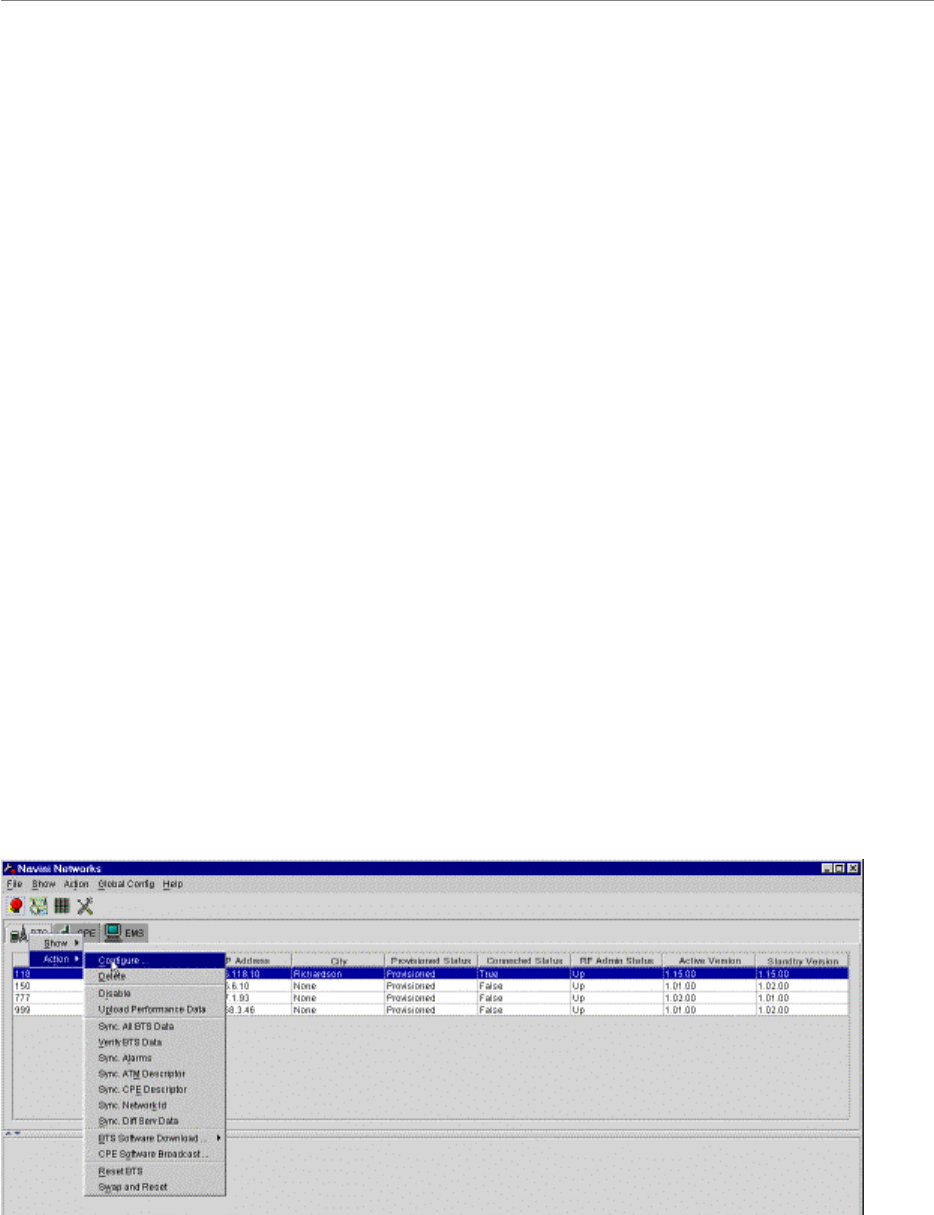
Ripwave Base Station I&C Guide Navini Networks, Inc.
96 Part #40-00047-00 Rev D v1.0
February 28, 2003
Calibrate the Base Station
Calibrating the Base Station detects the phase differential between the antennas and matches the
output power across all antennas in the RFS. The calibration procedure must be performed at
least three times to ensure validity. Ensure that the BTS has been powered on with the power
amplifiers on for at least fifteen minutes to allow them time to warm up and stabilize.
Calibration Procedure
To calibrate the BTS, follow the steps in the procedure below. Refer to the Ripwave
Configuration Guide, as needed.
Step 1. On the Test EMS, click on the Server icon to start the EMS Server.
Step 2. Click on the EMS Configuration icon to start the EMS Client GUI.
Step 3. At the EMS Configuration & Alarm Manager login screen, enter the user name and
password. The defaults are emsAdmin / emsAdmin.
Step 4. Verify that Antenna Power, RX Sensitivity, and Cal Cable Loss values are entered in
the fields in the EMS. NOTE: The Power Splitter Loss was entered when you
performed the RFS configuration earlier.
Step 5. Click on the BTS that is being installed to select it. Right-click on the highlighted BTS
and select Action > Configure. Refer to Figure 47.
Figure 47: Select BTS
Step 6. Click on Air Interface > Layer 1, and then click Calibrate. In the resulting dialog box
(Figure 48), select FULL CALIBRATION and Calibrate.
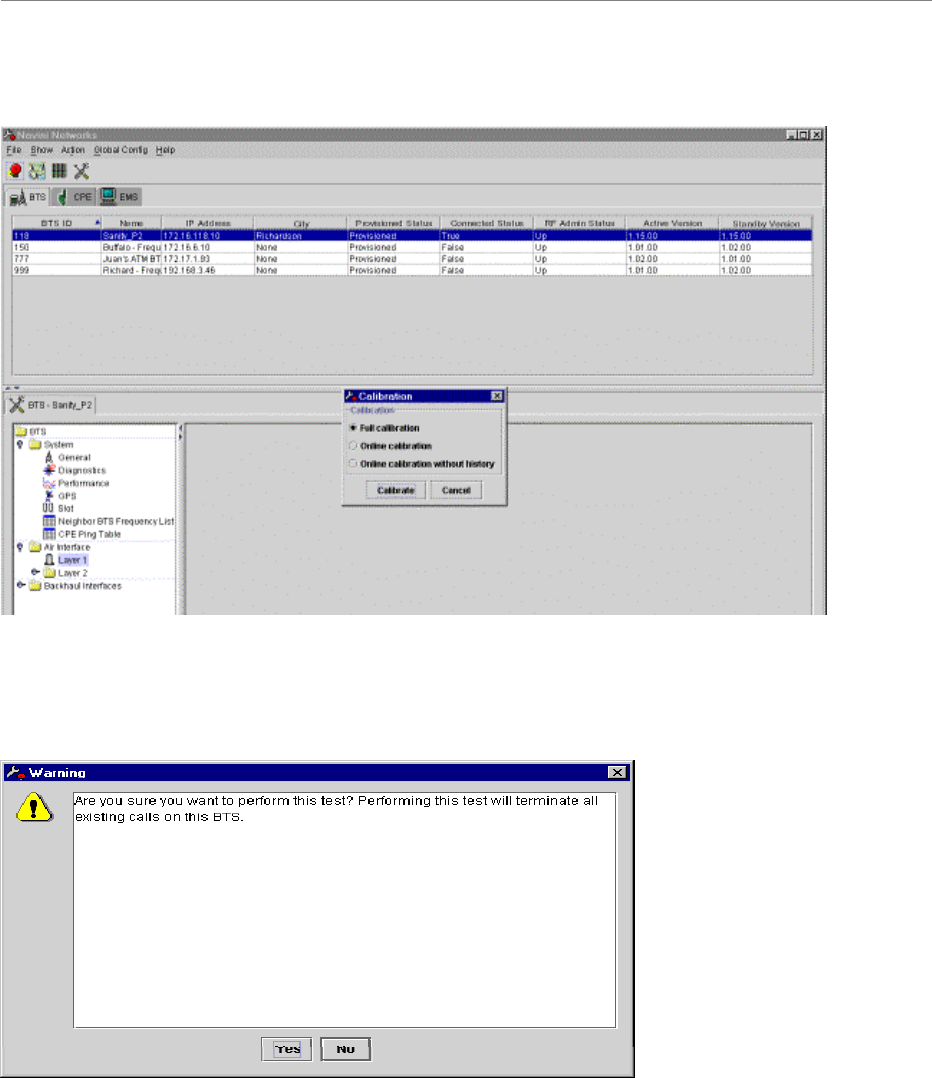
Navini Networks, Inc. Ripwave Base Station I&C Guide
Part #40-00047-00 Rev D v1.0 97
February 28, 2003
Figure 48: Calibrate BTS
Step 7. When the Warning window appears (Figure 49), click Yes.
Figure 49: Warning Window
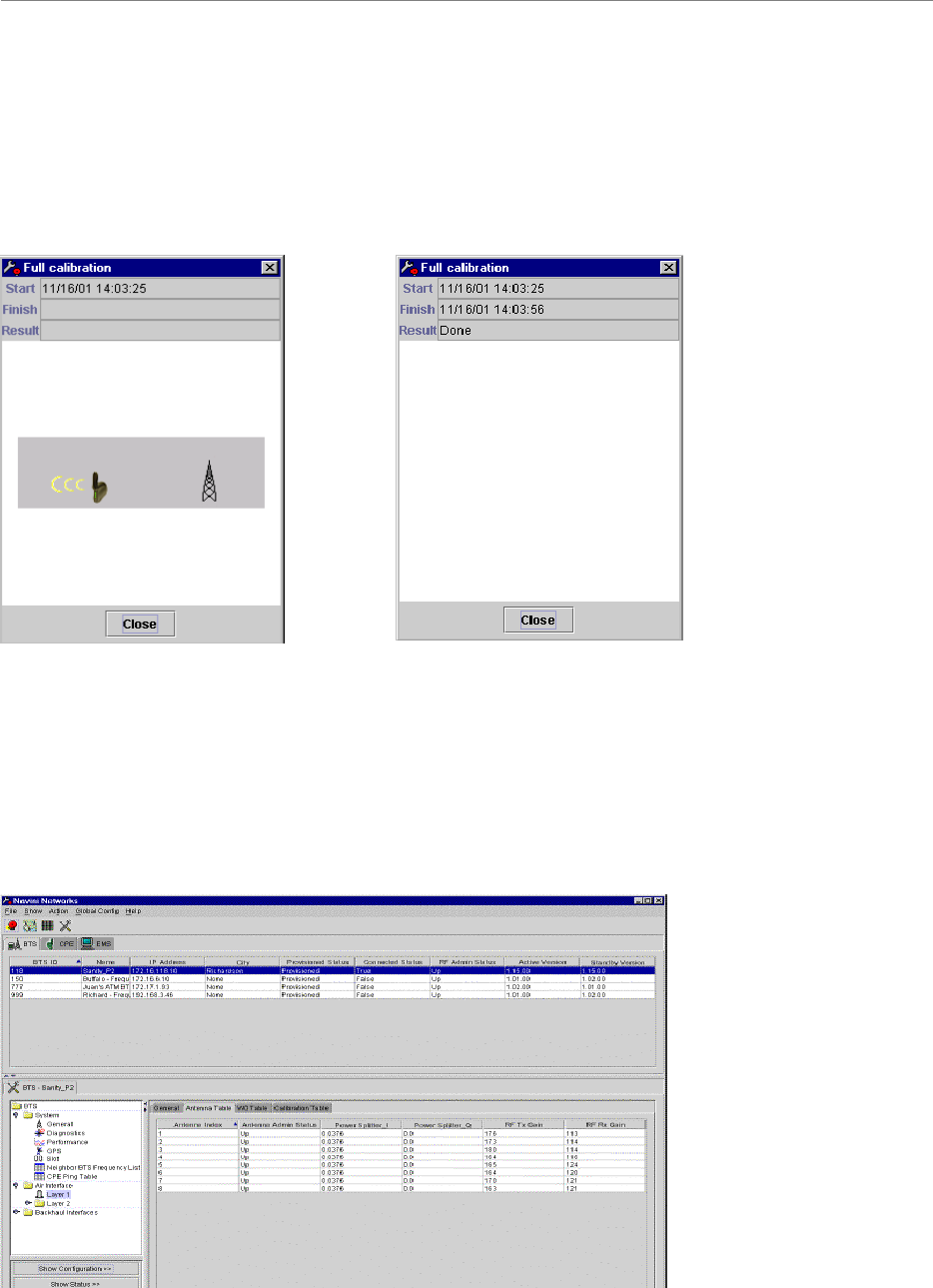
Ripwave Base Station I&C Guide Navini Networks, Inc.
98 Part #40-00047-00 Rev D v1.0
February 28, 2003
Step 8. The Full Calibration window appears during system calibration (Figure 50). When
calibration is complete, the Full Calibration window changes and displays the finish
time and the result. Click the Close button to close the Full Calibration window. Note
that the result of “Done” does not mean that the system passed calibration.
Figure 50: Full Calibration Window
Step 9. Click Show Configuration and select the Antenna Table tab (Figure 51). Check the Tx
Gain and Rx Gain columns (the last two columns in the table) for transmit and receive
results. The transmit and receive results for all eight antennas must be between 1 and
254. The eight values in each column should be relatively close to each other. A value
of zero indicates a problem with the associated antenna path.
Figure 51: Show Configuration/Antenna Table
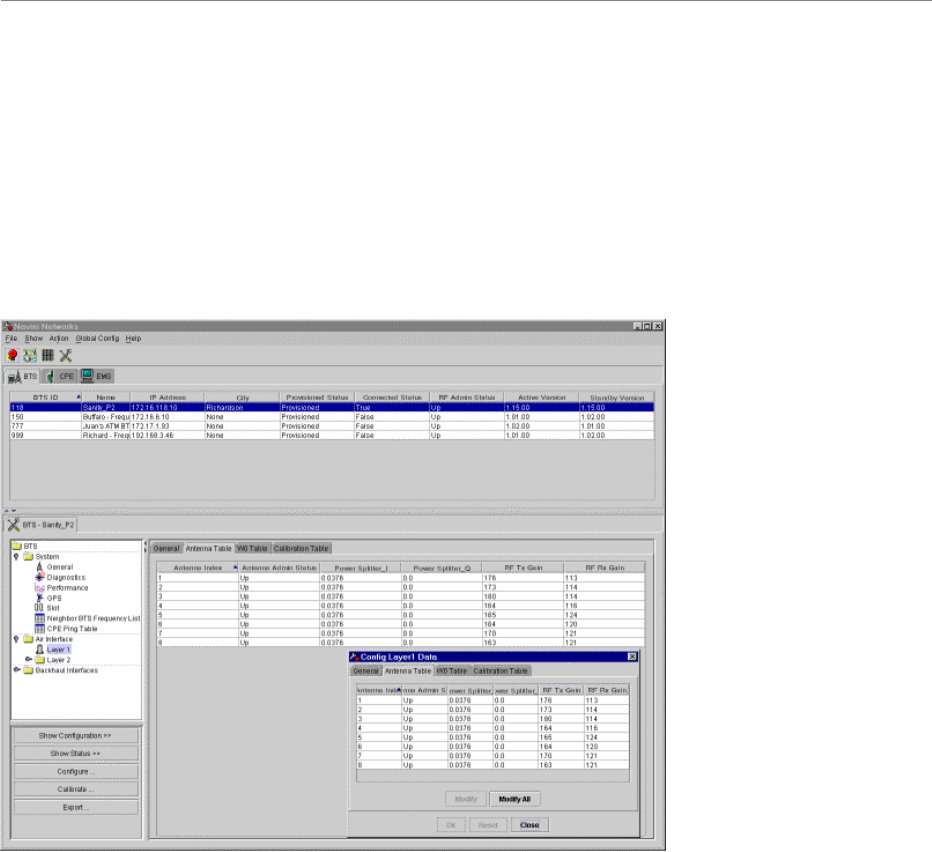
Navini Networks, Inc. Ripwave Base Station I&C Guide
Part #40-00047-00 Rev D v1.0 99
February 28, 2003
Step 10. Perform the calibration function two more times. Ensure each time that the values
remain relatively stable (+/- 3), and that none of the results is zero. After you perform
the second calibration, click on Configure. The Config Layer 1 Data window (Figure
52) shows the data from the second calibration. The values in the main screen from the
Show Config selection are from the first calibration. Compare the values from the two
calibrations to ensure that they are stable, and not equal to zero.
Figure 52: Config Layer 1 Data Window
Step 11. Close the Config Layer 1 Data window. Update the main screen by clicking the Show
Configuration button.

Ripwave Base Station I&C Guide Navini Networks, Inc.
100 Part #40-00047-00 Rev D v1.0
February 28, 2003
Verify the Calibration
Base Station Calibration Verification is a set of procedures to verify that the equipment has
passed calibration and that the RF portion of the equipment is operating within acceptable
parameters. The results of the tests should be documented in the Base Station Calibration
Verification Form, P/N 40-00059-00. This form, along with instructions, may be found in
Appendix F.
Test Cable & Coupler Insertion Loss Measurement
This test measures the insertion loss of the test cable and coupler.
Equipment Required
• Signal generator - Agilent 8648C, or equivalent, tunable to the RFS center frequency
• Spectrum analyzer - Agilent E4402B, or equivalent
• Two cables – one will be a reference cable; the other will be a test cable
• RF coupler
Equipment Settings
Turn on the Signal Generator and the Spectrum Analyzer. Allow the equipment to warm up for
15 minutes.
Signal Generator:
• Output = Base Station center frequency
• Amplitude = Between –10 and +10 dBm
Spectrum Analyzer:
• Span = 20 MHz
• Resolution Bandwidth (RBW) = 100 KHz
• Video Bandwidth (VBW) = Auto
• Sweep Time = Auto
• Frequency = BTS center frequency
Test Cable Sweep Setup
Refer to Figures 53, 54, and 55 when performing the Test Cable procedure below.
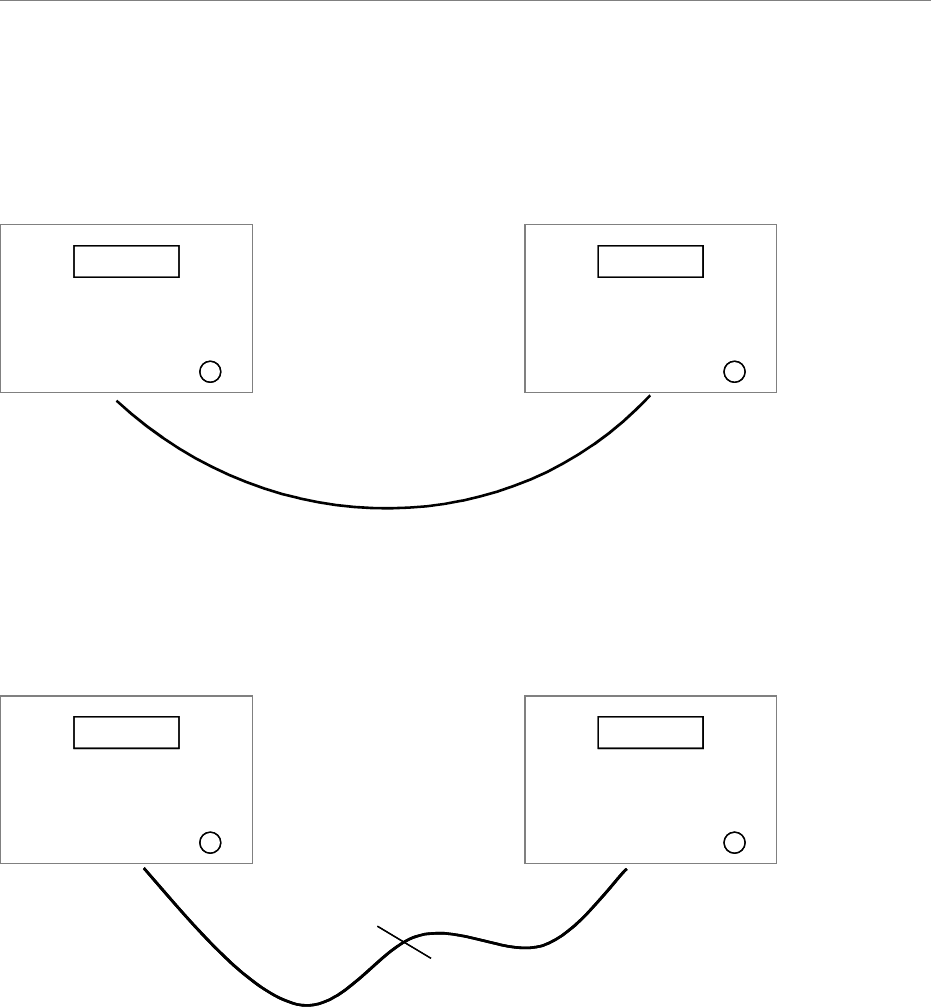
Navini Networks, Inc. Ripwave Base Station I&C Guide
Part #40-00047-00 Rev D v1.0 101
February 28, 2003
Figure 53: Reference Cable Measurement
Figure 54: Reference & Test Cable Measurements
Spectrum Analyzer Signal Generator
Reference Cable
Spectrum Analyzer Signal Generator
Reference Cable
Spectrum Analyzer Signal Generator
Reference Cable Test Cable
Spectrum Analyzer Signal Generator
Reference Cable Test Cable
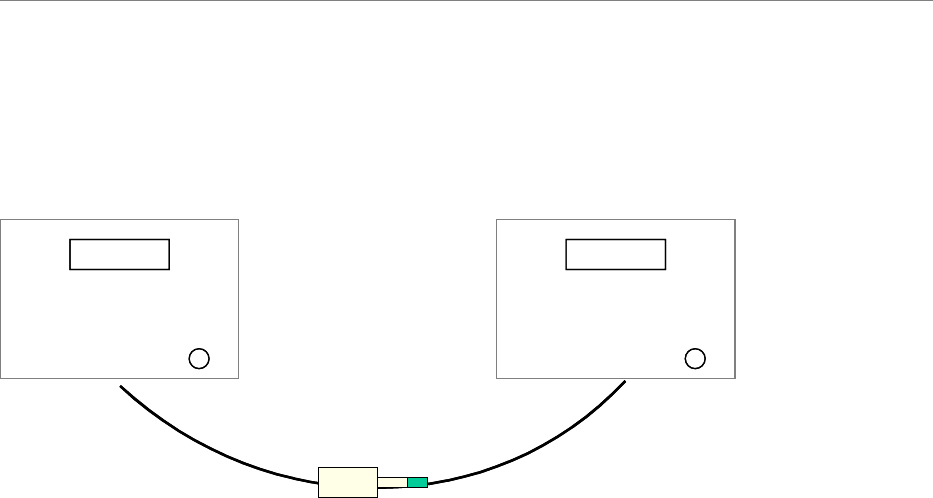
Ripwave Base Station I&C Guide Navini Networks, Inc.
102 Part #40-00047-00 Rev D v1.0
February 28, 2003
Figure 55: Coupler Measurement
Test Procedure
Step 1. Connect a test cable to the Signal Generator and to the Spectrum Analyzer. This will be
the reference cable (Figure 53).
Step 2. Turn on RF Power on the Signal Generator.
Step 3. On the Spectrum Analyzer, set the reference level so that the signal peak is no more
than 1 division down from the top of the screen, but does not go past the top of the
screen.
Step 4. Press the Peak Search button on the Analyzer. If the marker is bouncing excessively,
turn on the averaging function. Adjust averaging to stabilize the marker but not slow
down the sweep too much. Once the marker is stabilized, press Peak Search again to
make sure you are on the peak, then press marker delta. This establishes the reference
point for measurements.
Step 5. Turn off RF Power on the Signal Generator. Disconnect the reference cable from the
Spectrum Analyzer.
Step 6. Connect the other test cable to be measured between the reference cable and the
Spectrum Analyzer (Figure 54). This will be the test cable.
Step 7. Turn on RF power on the Signal Generator. The delta between the markers is the
loss/gain of the test cable or the coupler. Record that value in the appropriate field on
the Base Station Calibration Verification Form.
Step 8. Turn off RF Power on the Signal Generator.
Step 9. Repeat steps 6 through 8 for the RF coupler (Figure 55). Leave the equipment on until
the Base Station calibration verification test is complete. When finished, be sure to
disable the RF Power on the Signal Generator.
Spectrum Analyzer Signal Generator
Reference Cable
Coupler
Test Cable
Spectrum Analyzer Signal Generator
Reference Cable
Coupler
Test Cable

Navini Networks, Inc. Ripwave Base Station I&C Guide
Part #40-00047-00 Rev D v1.0 103
February 28, 2003
Receive Verification
This test verifies the Receive function of the Base Station.
Equipment Required
• Signal Generator - Agilent 8648C, or equivalent, tunable to the RFS center frequency
• Oscilloscope – Agilent 54622 D, or equivalent
• Test cable (optional)
• Test Channel Processor board
Note: Some test equipment may have a DC block for input protection. If so, do not remove the
DC block from the equipment.
Equipment Settings
Ensure that the Signal Generator and the Spectrum Analyzer have been allowed to warm up for
15 minutes before beginning testing.
Signal Generator:
• Output frequency = Base Station center frequency + 300 KHz (i.e. if the center frequency
of the BTS is 2640.5 MHz, set the Signal Generator frequency to 2640.8 MHz).
• Output power = The RF Power injected at the cal cable to get sensitivity at the antenna
(line 25) of the Base Station Calibration Verification Form. This value cannot be obtained
until steps 1 – 5 of this test are performed.
Oscilloscope:
• Horizontal sweep = 100 us/division
• Amplitude = 200 mV/division. Setting is arbitrary depending on the environment. It
should be as low as possible, while still being able to differentiate between signals.
• Channel = AC coupled
• Bandwidth (BW) = 20 MHz
• Limiting = on
• Trigger = EXT (or channel 2 if used)

Ripwave Base Station I&C Guide Navini Networks, Inc.
104 Part #40-00047-00 Rev D v1.0
February 28, 2003
Test Procedure
Follow the steps in the procedure below.
Step 1. Ensure that system calibration has been successfully performed.
Step 2. Enter the value for receive sensitivity (line 23) into the Base Station Calibration
Verification Form. It is located in the EMS Configuration & Alarm Manager (CAM)
GUI by selecting the BTS, then selecting air interface > layer 1 > show
configuration. Select the General tab.
Step 3. Enter the value for the test cable loss (line 24) into the Base Station Calibration
Verification Form. Test cable loss has to be measured before testing begins. If a test
cable is not used, enter zero for test cable loss in the Base Station Calibration
Verification Form.
Step 4. Enter the values for the antenna cable loss and RFS sweeps (measured) into the Base
Station Calibration Verification Form under cable loss (lines 40 to 48) and insertion
loss through cal cable and RFS (lines 54 to 69). The values are obtained from the RFS
System Test Form.
Step 5. Record the DAC words for RX gain from EMS Layer 1 data into the Base Station
Calibration Verification Form (lines 90 to 97). It is located in the EMS Configuration
& Alarm Manager by selecting the BTS, then select air interface > layer 1 >
show configuration. Select the Antenna tab.
Step 6. Set the Output power of the Signal Generator equal to the RF Power injected at the cal
cable to get sensitivity at the antenna (line 25) of the Base Station Calibration
Verification Form. Ensure that the spreadsheet has calculated the value by pressing F9
to calculate.
Step 7. Confirm that all CPE’s are turned off. Enter the command “ebCamShow” at the BTS
console to check for packets being transferred. Run the command two or three times to
validate that packet numbers are not changing.
Step 8. Set the power switch on the BTS to “OFF”.
Step 9. Remove the CHP-A board from the BTS chassis.
Step 10. Install the CHP test board into the CHP-A slot in the BTS chassis.
Step 11. Set the power switch on the BTS to “ON”.
Step 12. Set up the test equipment as shown in Figure 56.
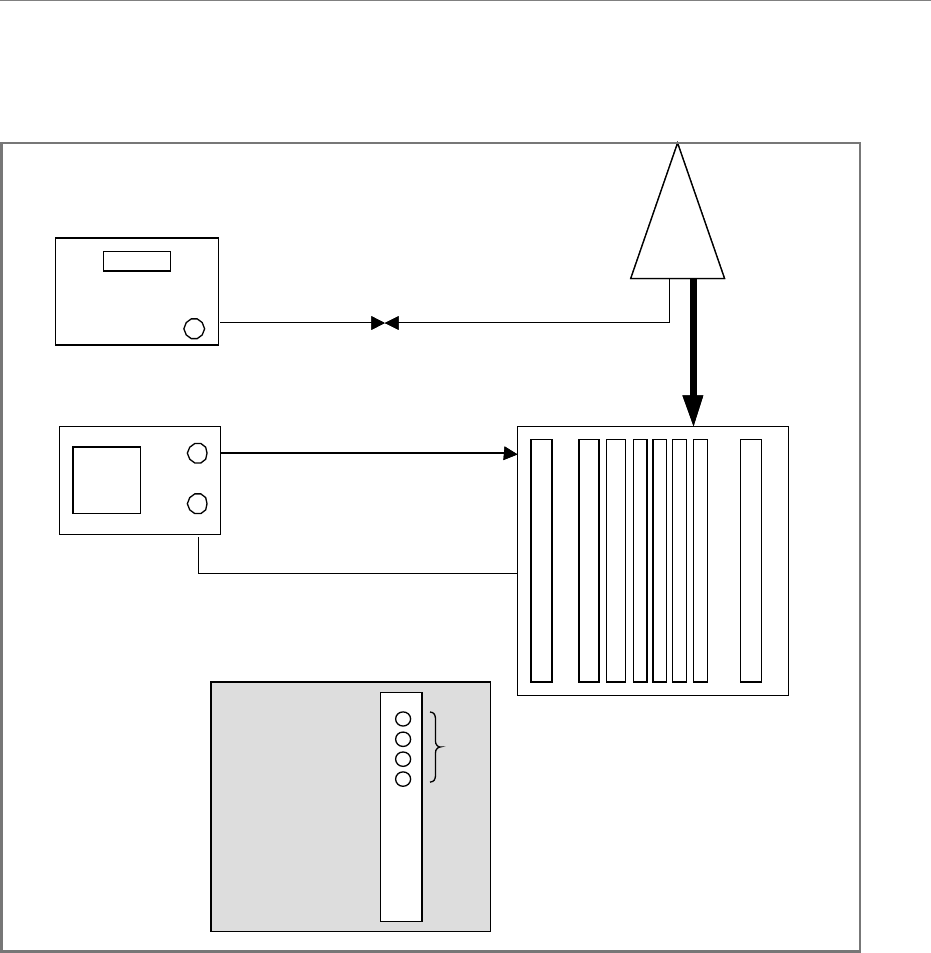
Navini Networks, Inc. Ripwave Base Station I&C Guide
Part #40-00047-00 Rev D v1.0 105
February 28, 2003
Figure 56: Test Equipment for Receive Verification
Step 13. Adjust the Oscilloscope to view only the receive timeframe, as shown in Figure 57.
Center the quietest area of one RX frame in the middle of the screen. Adjust the
horizontal sweep for 100 to 200 us/division to obtain the best reading. This ensures that
you measure only the noise of the receive frame. The amplitude for each channel
should be approximately 200 mV/division. This setting is arbitrary depending on the
environment. The setting should be as low as possible, and you should still be able to
differentiate between the signals. Set the Oscilloscope to display the RMS (average)
voltage of the waveform. If the equipment permits, also display the peak-to-peak value.
Setting the channel on the Oscilloscope to AC, coupled with BW limit “on”, limits the
noise being measured to less than 20 MHz in bandwidth. The objective is to measure
only the noise within the receiver bandwidth (5 - 6 MHz).
Calibration cable
To the TDD SYNC
connector on the
back of the BTS
(if enabled)
To test points
on CHP card
RFS
Oscilloscope
Ext. Trigger on the rear
of the scope, If available.
Or use Channel 2 input
and select it as the trigger
source.
Channel 1
Signal Generator
8 RF cables from
the RFS connected
to the BTS
Test Cable (optional)
BTS
Test Points on
CHP Test Board
D
B
C
A
Calibration cable
To the TDD SYNC
connector on the
back of the BTS
(if enabled)
To test points
on CHP card
RFS
Oscilloscope
Ext. Trigger on the rear
of the scope, If available.
Or use Channel 2 input
and select it as the trigger
source.
Channel 1
Signal Generator
8 RF cables from
the RFS connected
to the BTS
Test Cable (optional)
BTS
Test Points on
CHP Test Board
D
B
C
A
Test Points on
CHP Test Board
D
B
C
A
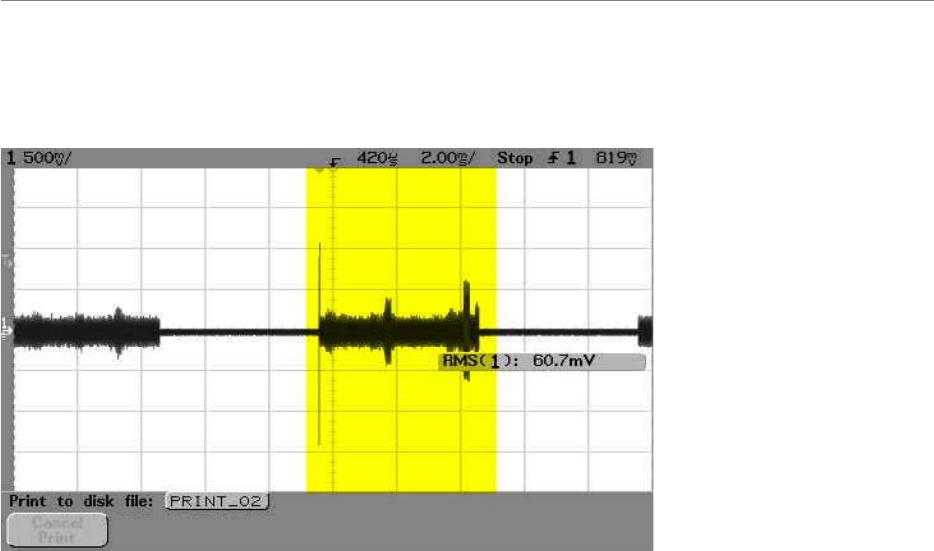
Ripwave Base Station I&C Guide Navini Networks, Inc.
106 Part #40-00047-00 Rev D v1.0
February 28, 2003
Figure 57: Oscilloscope Receive Time
Step 14. Measure the RMS voltage (in mV) in the quietest area of each of the four baseband
signals from the front of the Channel Processor test board – test points A, B, C, D.
Enter the values into the Base Station Calibration Verification Form under receiver
performance - noise level (lines 76 to 79). To ensure that there are no surges or random
interference signals included in the measurement, use the single sweep function on the
Oscilloscope. Figure 57 shows an example of unwanted noise bursts in the waveform.
Step 15. Turn on the Signal Generator’s RF output.
Step 16. Measure the RMS voltage (in mV) on the Oscilloscope (signal + noise, S+N) in the
quietest area of each of the four baseband signals from the front of the Channel
Processor test board – test points A, B, C, D. Enter the values into the Base Station
Calibration Verification Form under receiver performance - noise + signal (lines 76 to
79). If the calibration was successful, then all of the levels should be between 180 and
240 mV rms. The spreadsheet will then calculate the signal, SNR, noise power, and
relative noise figure. For example, values typically are -102, 10, and 3.5 dB for a 2.6
GHz system.
Step 17. Turn off the Signal Generator’s RF output.
Step 18. Set the power switch on the BTS to OFF.
Step 19. Remove the CHP test board from the BTS chassis.
Step 20. Install the CHP-A board into the BTS chassis.
Step 21. Remove the CHP-B board from the BTS chassis.
Step 22. Install the CHP test board into the CHP-B slot in the BTS chassis.
Step 23. Set the power switch on the BTS to “ON”.

Navini Networks, Inc. Ripwave Base Station I&C Guide
Part #40-00047-00 Rev D v1.0 107
February 28, 2003
Step 24. After the BTS boots up, repeat steps 12 thru 17 for the CHP test board in the CHP-B
slot. Enter the data into the Base Station Calibration Verification Form (lines 80 to 83).
Step 25. Turn off the Oscilloscope.
Step 26. Set the power switch on the BTS to OFF.
Step 27. Remove the CHP test board from the BTS chassis.
Step 28. Install the CHP-B board into the BTS chassis.
Step 29. Set the power switch on the BTS to “ON”.
Step 30. Ensure the BTS boots up without any faults.
Transmitter Verification
This test verifies the Transmit function of the Base Station.
Equipment Required
• Spectrum analyzer - Agilent E4402B, or equivalent
• Coupler
• Attenuator - 30 dB, 25 watt
• Terminator - 50 ohm, 5 watt
Equipment Settings
Ensure that the Signal Generator and the Spectrum Analyzer have been allowed to warm up for
at least 15 minutes before beginning testing.
Spectrum Analyzer:
• Center Frequency = BTS center frequency
• Span = 0 Hz
• RBW = 5 MHz *
• VBW = Auto
• Sweep Time = 15 ms
• TRIG = Video ** (adjust level to stabilize signal)
• Display line = On
• Reference level = Adjust to display entire signal
• Detector = RMS ***

Ripwave Base Station I&C Guide Navini Networks, Inc.
108 Part #40-00047-00 Rev D v1.0
February 28, 2003
* If the Spectrum Analyzer will not support 5 MHz RBW, use the following formula to
determine the correction factor: 10 * log10 (5 MHz /RBW). Add this value to the measurements.
**If possible, connect a cable from the TDD SYNC connector on the back of the BTS to the
EXT TRIGGER input on the rear of the Spectrum Analyzer. Set the TRIG to EXT.
***If the RMS detector is not available, measure with the peak detector and subtract 9.5 dB for
peak to average ratio (calculated by the spreadsheet). This value is determined by measuring
both the peak detected and RMS detected power values, then taking the average of the two
readings. Due to equipment variations, this value will not always be the same; however, it should
be within +/- 1 dB.
Test Procedure
WARNING! Before performing the procedure below, disable power to the transceiver
modules before disconnecting any RF cables. All antenna cables must be connected to the
BTS during testing except for the one that is being tested.
Step 1. Disable the RF shelf by turning off the power to the Transceiver modules. From the
EMS GUI, select the BTS. Then from the menu bar select action > disable. Ensure that
the Power LED on each Transceiver module is off. Also ensure that the A1 – A8
LED’s on the CC card are off.
Step 2. Disconnect the RF cable for the channel being tested from the back of the BTS. All
other RF cables must be connected to the BTS.
Step 3. Connect the Spectrum Analyzer, Coupler, Attenuator, and 50 ohm Terminator to the
RF input on the BTS, as shown in Figure 58. The RF cable for the channel being
tested is not connected during the test.
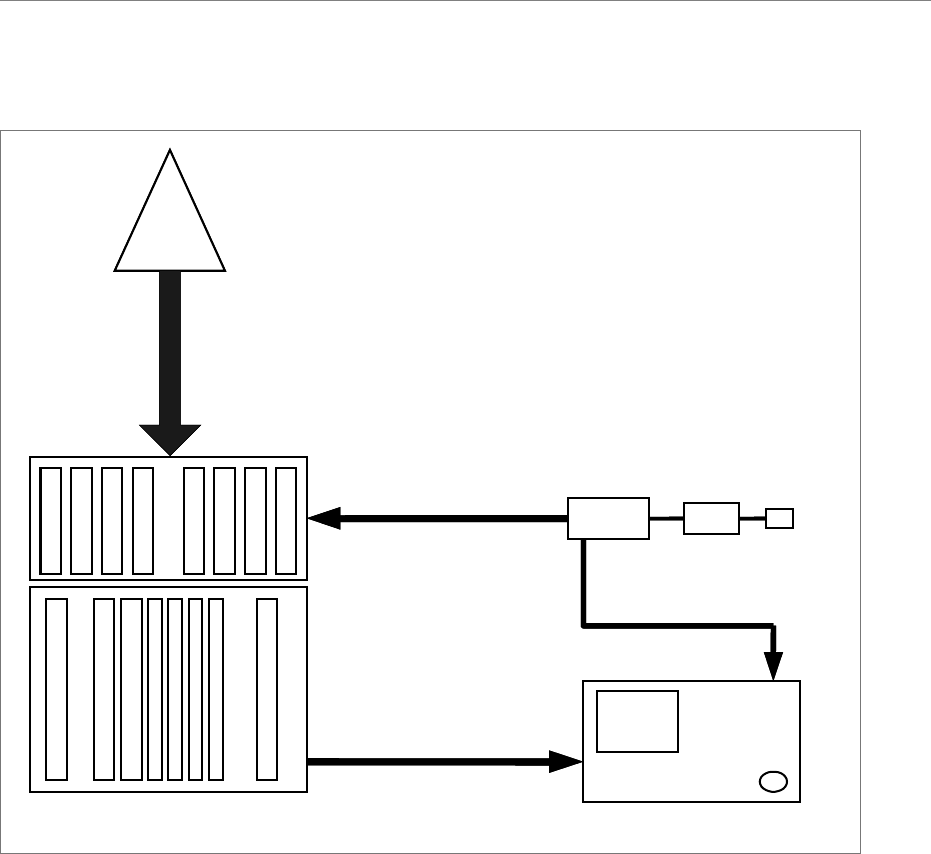
Navini Networks, Inc. Ripwave Base Station I&C Guide
Part #40-00047-00 Rev D v1.0 109
February 28, 2003
Figure 58: Test Equipment for Transmitter Verification
Step 4. Enable the RF shelf by turning on the power to the Transceiver modules. From the
EMS GUI, select the BTS. Then from the menu bar select action > enable. Ensure that
the Power LED on each Transceiver module is on. Also ensure that the A1 – A8
LED’s on the CC card are on.
Step 5. On the Spectrum Analyzer, adjust the display line to the top of the sync signal, as
shown in Figure 59. Measure the signal level.
Connect the
Coupler input
directly to the
BTS antenna
output to be
measured
RFS
Coupler
(20dB min)
Attenuator
30dB
25W
5W 50 ohm
Terminator
Coupled
port
All cables from
the RFS are
connected to the
BTS except for
the channel being
tested
Spectrum Analyzer
BTS
Connect the TDD Sync
connector on the back of
the BTS to the External
Trigger input on the
Spectrum Analyzer
Connect the
Coupler input
directly to the
BTS antenna
output to be
measured
Connect the
Coupler input
directly to the
BTS antenna
output to be
measured
RFS
Coupler
(20dB min)
Attenuator
30dB
25W
5W 50 ohm
Terminator
5W 50 ohm
Terminator
Coupled
port
All cables from
the RFS are
connected to the
BTS except for
the channel being
tested
All cables from
the RFS are
connected to the
BTS except for
the channel being
tested
Spectrum Analyzer
BTS
Connect the TDD Sync
connector on the back of
the BTS to the External
Trigger input on the
Spectrum Analyzer
Connect the TDD Sync
connector on the back of
the BTS to the External
Trigger input on the
Spectrum Analyzer
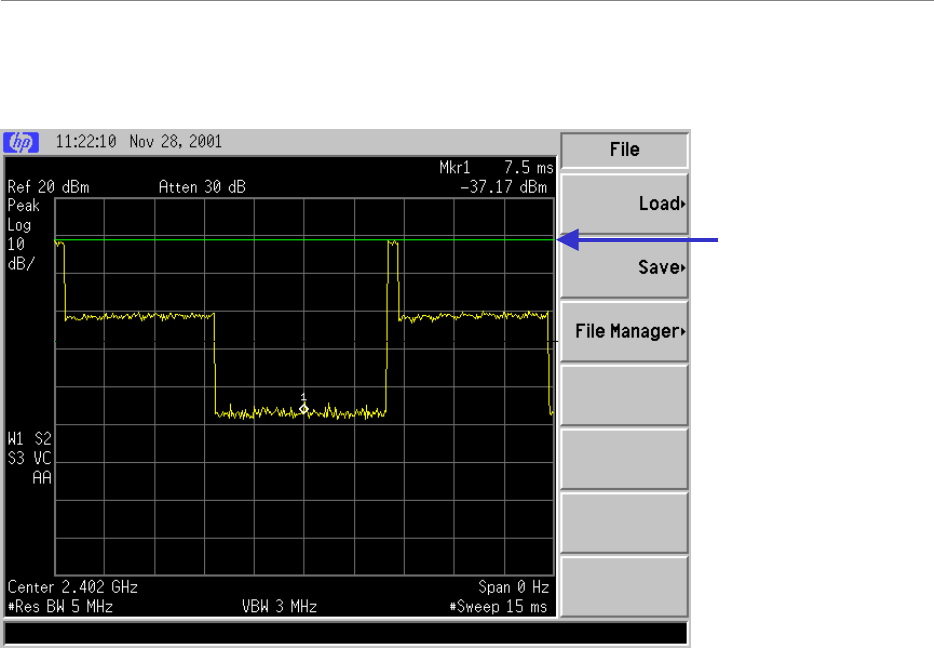
Ripwave Base Station I&C Guide Navini Networks, Inc.
110 Part #40-00047-00 Rev D v1.0
February 28, 2003
Figure 59: Sync Signal
Step 6. Repeat steps 1 through 5 for the remaining seven antenna outputs. Record the peak
value into the spreadsheet under analyzer readings – Peak (lines 90 to 97).
Step 7. Enter the value for antenna power that is set in the EMS into the spreadsheet (line 30).
It is located in the EMS Configuration & Alarm Manager GUI by selecting the BTS,
then selecting air interface > layer 1 > show configuration. Select the General tab.
Step 8. Enter the Coupler/test cable loss (line 31) and antenna gain (line 32) (8 dBi for 2.4
GHz and 17 dBi for 2.6 GHz systems) into the spreadsheet.
Step 9. Record the DAC words for the TX gain from EMS Layer 1 data into the spreadsheet
(lines 93 to 100). From the EMS GUI, select the BTS. Then select air interface >
layer 1 > show configuration. Select the Antenna tab.
Step 10. Verify that RMS power at the antenna (lines 90 to 97, column G) is within +/- 1 dB of
antenna power (line 30) and that the deviation across all eight antennas is less than or
equal to 3 dB.
Export BTS Data
Once you complete the calibration verification, export the BTS configuration data to a text file.
This is done by highlighting the specific BTS in the CAM window, and on the Main Menu select
File > Export BTS Data. This saves the configuration information if needed for later retrieval.
Display
Line
Display
Line
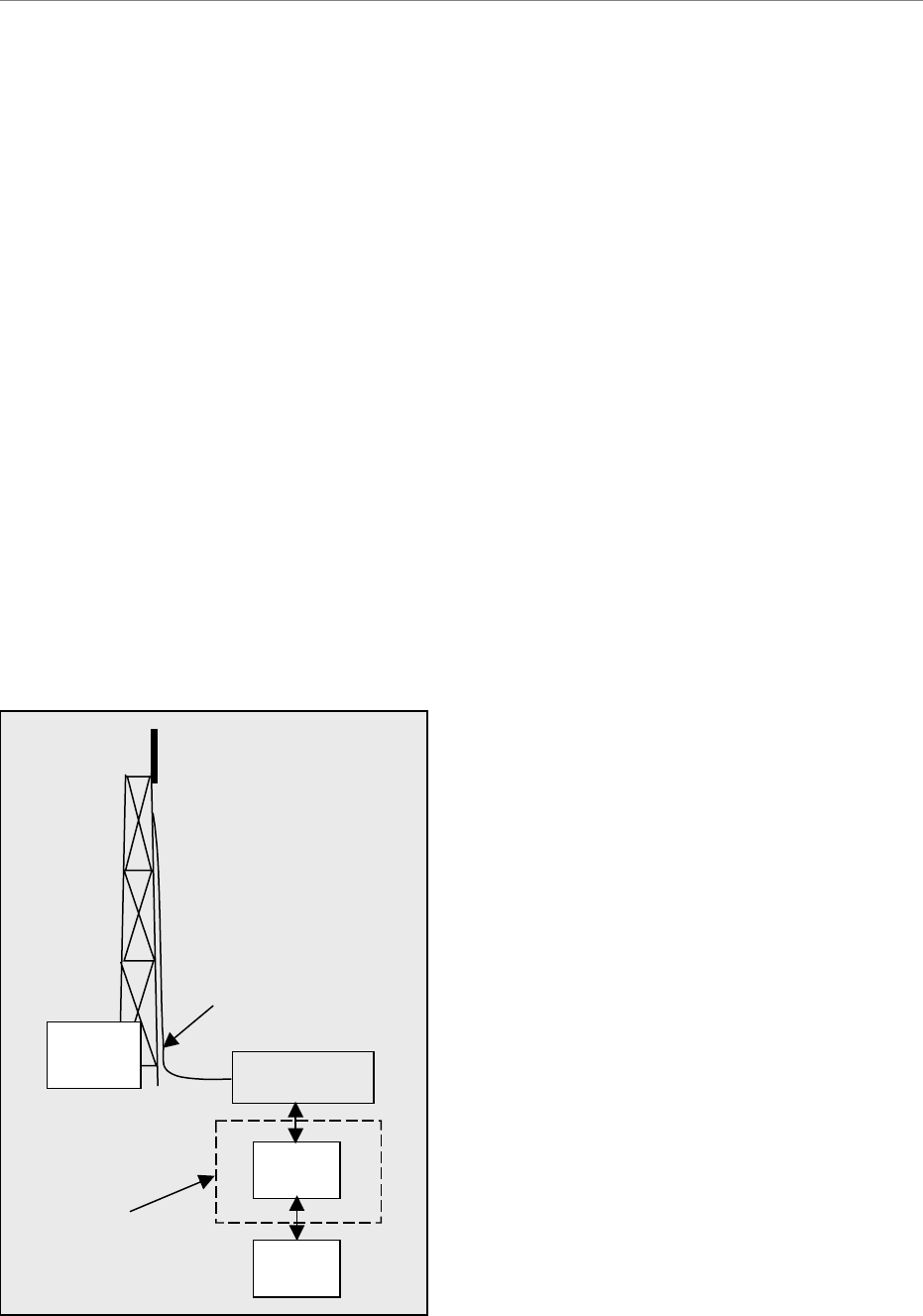
Navini Networks, Inc. Ripwave Base Station I&C Guide
Part #40-00047-00 Rev D v1.0 111
February 28, 2003
Perform Local CPE Tests
Local wireline, then over-the-air, CPE testing will verify that the Base Station is working and is
able transmit and receive data. Data rates are not being checked at this time. Refer to Figure 60
when setting up and performing the Wired CPE procedures.
Wired CPE Test
Equipment Required
• CPE - Ordinate the Ripwave Modem (CPE)
• PC - Laptop with CPE debug tool. Connect to CPE with an Ethernet cable
• Attenuator - 70dB fixed attenuation, plus 40 adjustable range with 1dB resolution
(cascade multiple attenuators)
• Shielding box - Need to provide 80dB isolation. Shielding box may not be needed if the
CPE cannot sync to BTS over-the-air at the test location.
Figure 60: Wired CPE Setup
CPE
PC
Attenuator
Shielding box
BTS
Calibration
cable
CPE
PC
Attenuator
Shielding box
BTS
Calibration
cable

Ripwave Base Station I&C Guide Navini Networks, Inc.
112 Part #40-00047-00 Rev D v1.0
February 28, 2003
Equipment Settings
Part of the Test Procedures below.
Test Procedure Setup
Set up the test procedures, per the following.
Step 1. Calibrate and sanity check the BTS.
Step 2. Connect the CPE and the attenuators. The combined attenuation should be set roughly
as follows:
Total attenuation = PTX - 30 + 18 - Cal cable loss + 80
Where PTX is the Tx output power at antenna input port that is set in EMS during
calibration. Cal cable loss is the loss of the calibration cable.
The total attenuation should be partitioned between fixed and adjustable attenuators in
such a way that the adjustable attenuator is set to about 10dB.
Step 3. Disconnect the calibration cable from the back of the BTS shelf and connect it to the
attenuator as shown in the drawing
Step 4. Ping the BTS continuously from the CPE.
Step 5. Check the sync level at the CPE debug tool. The level should be about -80dBm.
Test Procedure - Check CPE Sensitivity & Output Power
Follow the steps in the procedure below.
Step 1. Record the downlink TCC power level and SNR reading on the CPE debug tool.
Step 2. Calculate the effective noise floor: NF= SNRTCC - LevelTCC.
Where SNRTCC is the TCC SNR and LevelTCC is the received downlink TCC level.
NF should be close to -127 ±5.
Step 3. Check CPE output power cap difference. It should be greater than 0.
Step 4. Increase the attenuation by 10dB (increase the attenuation of the adjustable attenuator).
Step 5. Measure the effective noise floor and the output power cap difference gain.
Step 6. Increase the attenuation by another 10dB and take the measurements again (if the link
is broken when the attenuation increases 10dB, back off the attenuation by 10dB and
then increase the attenuation with 1dB steps until the link is broken. Then reduce the
attenuation by 4dB).

Navini Networks, Inc. Ripwave Base Station I&C Guide
Part #40-00047-00 Rev D v1.0 113
February 28, 2003
Step 7. Calculate the maximum path allowed as follows:
Max loss = Attenuation total + Cal cable loss + 30
Where Attenuation total is the total attenuation of all attenuators (fixed + adjustable).
Test Procedure - Check BTS Sensitivity (Individual Antenna)
Step 1. Set the attenuation of the attenuator so the total attenuation is about
PTX - 30 - Cal cable loss +80.
Step 2. Activate antenna #1 only.
Step 3. Record the uplink TCC power level and SNR reading on the BTS debug tool.
Step 4. Calculate the effective noise floor: NF= SNRTCC - LevelTCC.
Where SNRTCC is the TCC SNR and LevelTCC is the received downlink TCC level.
NF should be close to: SNR - BTS Sensitivity + 25 ±5.
Where BTS sensitivity is the BTS sensitivity setting during calibration.
Step 5. Record the CPE output power.
Step 6. Increase the attenuation by 10dB (increase the attenuation of the adjustable attenuator).
Step 7. Measure BTS effective noise floor and CPE output power again.
Step 8. Increase the attenuation by another 10dB and take the measurements again (if the link
is broken when the attenuation increases 10dB, back off the attenuation by 10dB and
then increase the attenuation with 1dB steps until the link is broken. Then reduce the
attenuation by 4dB. The same attenuation will be used for all antenna tests).
Step 9. Calculate the maximum path allowed as follows:
Max loss = Attenuation total + Cal cable loss + 30
Where Attenuation total is the total attenuation of all attenuators (fixed + adjustable).
Step 10. Repeat the steps for antennas 2 through 8.
Step 11. Average the CPE output power over antennas 1~8 for each attenuation setting.
Test Procedure - Check BTS Sensitivity (Antenna Array)
Step 1. Set the initial attenuation the same as in the individual antenna testing procedure.
Step 2. Activate all antennas.
Step 3. Record the uplink TCC power level and SNR reading on BTS debug tool.

Ripwave Base Station I&C Guide Navini Networks, Inc.
114 Part #40-00047-00 Rev D v1.0
February 28, 2003
Step 4. Calculate the effective noise floor: NF= SNRTCC - LevelTCC.
Where SNRTCC is the TCC SNR and LevelTCC is the received uplink TCC level.
NF should be close to SNR - BTS Sensitivity +25 ±5.
Where BTS sensitivity is the BTS sensitivity setting during calibration.
Step 5. Record the CPE output power.
Step 6. Increase the attenuation by 10dB (increase the attenuation of the adjustable attenuator).
Step 7. Measure BTS effective noise floor and CPE output power again.
Step 8. Increase the attenuation by the same amount as in individual antenna tests and measure
the BTS effective noise floor and CPE output power.
Step 9. For each attenuation setting, the CPE output power should be 9dB less compared to
those (average) in individual antenna tests.
Step 10. Increase the attenuation by another 18dB. The link should be on.
Step 11. Calculate the maximum path allowed as follows:
Max loss = Attenuation total + Cal cable loss + 30
Where Attenuation total is the total attenuation of all attenuators (fixed + adjustable).
Test Procedure - Data Rate
Step 1. Set the attenuation of the attenuator so the total attenuation is about
PTX - 30 +18 - Cal cable loss + 80.
Step 2. Activate all antennas.
Step 3. FTP a file with size >10Mbps from CPE to BTS (uplink).
Step 4. Check the uplink data rate. It should be ~1Mbps.
Step 5. FTP a file with size >20Mbps from BTS to CPE (downlink).
Step 6. Check the downlink data rate. It should be ~2Mbps.
After the test is completed, reconnect the calibration cable back to the BTS and run the
calibration. The new calibration table should be the same as before (the changes in Tx and Rx
AGC should be within 2 bits).

Navini Networks, Inc. Ripwave Base Station I&C Guide
Part #40-00047-00 Rev D v1.0 115
February 28, 2003
Over-the-air CPE Test
Equipment Required
Same as for Wired CPE Test.
Equipment Settings
Included in the Test Procedure.
Test Procedure
To set up a CPE for local over-the-air testing, follow the steps below.
Step 1. Connect a CPE to a test computer. Reference the Ripwave CPE User Guide, P/N 40-
00026-00 for CPE setup procedures. The location of the test computer setup needs to
be close to the Base Station, within its coverage range.
Step 2. Ensure that the CPE is registered in the EMS. Refer to EMS Configuration & Alarm
Manager (CAM) User Guide, P/N 40-00016-00, for CPE registration procedures.
Step 3. Using FTP software, transfer a 2 Mb file over-the-air from the test computer to the
BTS. This is a system uplink transfer.
Step 4. Using FTP software, transfer a 10 Mb file over-the-air from the BTS to the test
computer. This is a system downlink transfer.
Step 5. Ensure that both files transferred during testing.

Ripwave Base Station I&C Guide Navini Networks, Inc.
116 Part #40-00047-00 Rev D v1.0
February 28, 2003
Install & Test Customer EMS Operations
If you have been using a Test EMS up to this point, you will now need to install and test the
customer’s EMS server. This involves installing the EMS Server and Client on a computer that is
connected through the system backhaul. If the customer’s EMS is already installed and has been
used for testing purposes, skip to the “Verify System Performance” section of this chapter.
Install EMS Software
The EMS software installation procedures can be found in the EMS Software Installation
manual, P/N 40-00017-00. After installing the EMS Server and Client applications, the EMS
needs to be configured with the settings that are designated for the Base Station. The settings are
found in the Network Architecture Plan provided by the customer.
Ensure connection between the Base Station and the backhaul. The connection to the Base
Station will be either an Ethernet connection or T1 connections.
Verify EMS to Base Station Connectivity
Follow the steps below to ensure the EMS and Base Station can communicate.
Step 1. Open a Command Prompt window on the computer where the EMS is installed.
Step 2. Ping the Base Station using the CLI command ping <base station ip address>. Verify
a reply from the Base Station.
Perform Calibration Using Customer’s EMS
This step is necessary only if you have been using a Test EMS up to this point. You will need to
install the customer’s EMS server and software. Calibrate the Base Station using the customer’s
EMS. Follow the same calibration procedures described earlier in this chapter, Calibrate the Base
Station. Perform the procedure three times and make sure that the results are stable (+/- 3).

Navini Networks, Inc. Ripwave Base Station I&C Guide
Part #40-00047-00 Rev D v1.0 117
February 28, 2003
Verify System Performance
Drive Study
The preliminary Drive Study is performed if no RF coverage model is available. The Drive
Study helps you to map out the coverage area. Later, the full Drive Study is performed to see if
the system’s coverage area is as predicted and, if necessary, to fine-tune the RF model.
Following the detailed Drive Study procedures in Appendix G, you will perform a preliminary
Drive Study by driving back and forth through a sector, staying on major roads about a kilometer
apart. Special attention has to be paid to the null and fringe areas. You will follow this scheme
for each sector in the site, recording the results of all tests. The test results will be sent for
evaluation, along with the Location (FTP) test results, to Navini Networks Technical Support. If
the results are not adequate, Technical Support will have you adjust some of the RF parameters
and perform the Drive Study again.
Location (FTP) Test
Location Tests are performed to see if the system file transfer functions are working as predicted
between CPE and Base Station. These are conducted in stages as well. The first stage is the
preliminary Location Test, where you perform three uploads and three downloads at three
locations with the Base Station in line-of-sight (LOS). Then you perform three uploads and three
downloads at three locations with the Base Station in non-line-of-sight (NLOS). For the NLOS
testing, you will need to find an obstacle, such as a building, between the CPE and Base Station.
Results are sent, along with the preliminary Drive Study results, to Navini Networks Technical
Support for evaluation. If the results are not adequate - i.e., file transfers do not meet customer’s
objectives - Technical Support will have you adjust some of the RF parameters and perform the
Location tests again. The detailed Location Test procedures and form are located in Appendix H.
To summarize, these are the high-level steps for verifying system performance:
1. Conduct
preliminary Drive Study (if no RF coverage map is available).
2. Conduct
preliminary LOS Location Tests.
3. Conduct
preliminary NLOS Location Tests.
4. Send all test results to Navini’s Technical Support for evaluation.
5. If directed by Technical Support, adjust RF parameters.
6. Conduct full Drive Study.
7. Conduct full LOS Location Tests.

Ripwave Base Station I&C Guide Navini Networks, Inc.
118 Part #40-00047-00 Rev D v1.0
February 28, 2003
8. Conduct full NLOS Location Tests.
9. Send all test results to Navini’s Technical Support for evaluation.
The cycle continues until the performance objectives are reached.
Verify System Operation With Multiple CPE’s
Set up three computers with CPE’s connected to them. Perform file transfers from all three
computers to verify Base Station operation.
Back Up EMS Database
After all system installation and commissioning activities are complete, perform a backup of the
EMS database. The procedure can be found in the EMS Configuration & Alarm Manager (CAM)
User Guide, P/N 40-000-16-00. Place the backup files on a system server where they will be
periodically backed up on a tape drive.
Customer Acceptance
To conclude the installation and commissioning activities, gather all of the required documents
and forms from the installation and commissioning procedures to create a comprehensive system
I&C package. The customer and Navini Networks will sign the Customer Acceptance Form. A
copy of this form is provided in Appendix I. The signed form and the system I&C package are
provided to the customer. The original, signed Customer Acceptance Form and system I&C
package are stored in the Navini Networks Technical Support database.
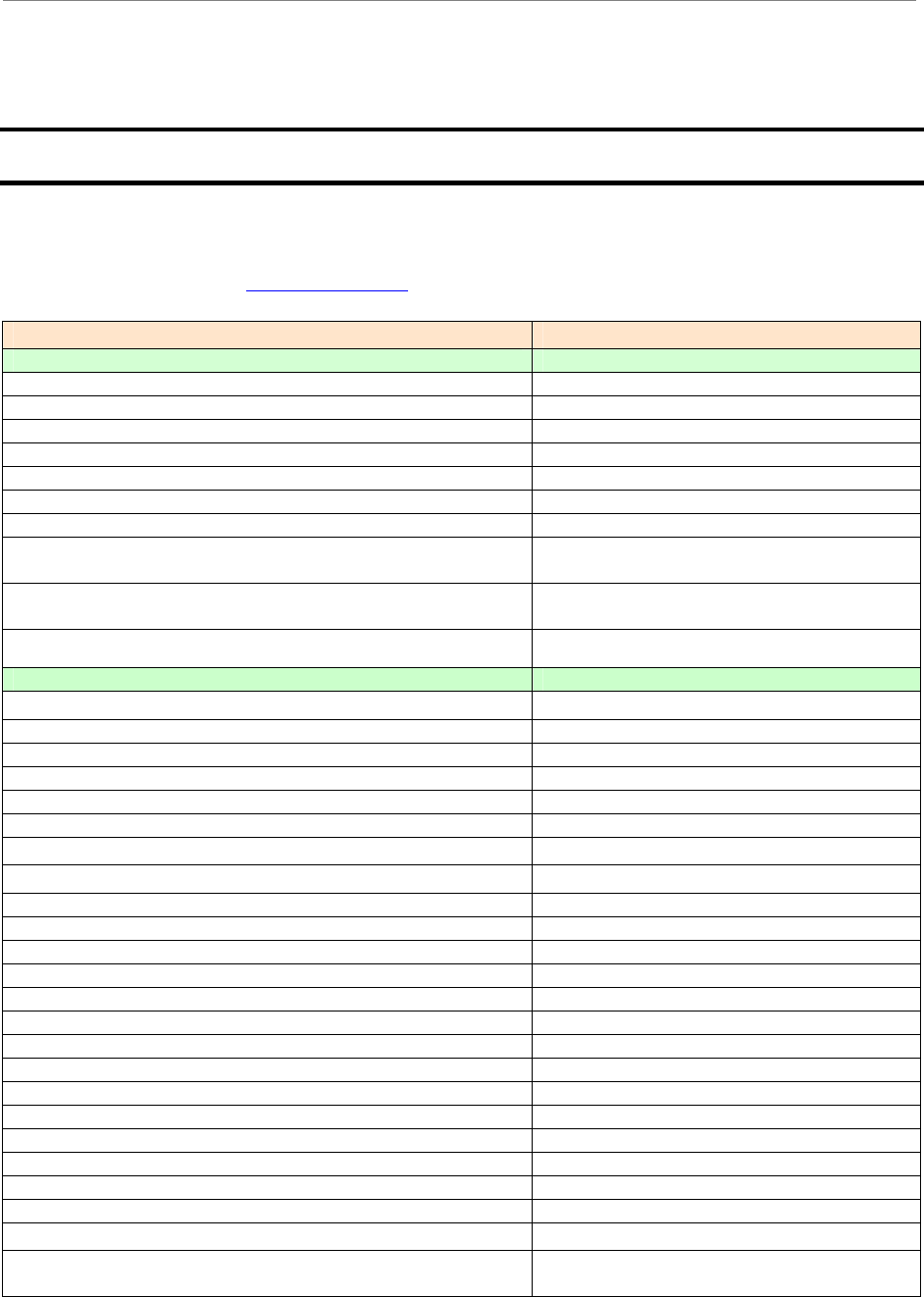
Navini Networks, Inc. Ripwave Base Station I&C Guide
Part #40-00047-00 Rev D v1.0 119
February 28, 2003
Appendix A: Ordering Documentation & Forms
Navini Networks product documentation and forms may be ordered by calling 1-972-852-4200,
or by using the web site: www.navini.com. Select Support / Technical Support.
Document Name Component/Part Number
STANDARD DOCUMENTATION CD 95-00116-00
EMS Overview Manual 40-00016-03
EMS Software Installation Guide 40-00017-00
EMS Administration Guide 40-00031-00
Ripwave Configuration Guide 40-00016-01
EMS Configuration CLI Reference Manual 40-00016-02
EMS Alarm Resolution Reference Manual 40-00033-00
EMS Diagnostic Tools Guide 40-00032-00
Ripwave Modem Quick Installation Guide 40-00112-00/40-00098-00 English
/40-00096-00 Spanish
Ripwave Modem User Guide 40-00111-00/40-00097-00 English
/40-00099-00 Spanish
Ripwave Modem Software Update Tool - Quick Guide 40-00066-00
VAR I&C DOCUMENTATION CD 95-00017-00
Site Design Documents:
RFS Omni Data Sheet 44-00037-00
RFS Panel Data Sheet 44-00038-00
BTS Outdoor Selection Guide 44-00035-00
Rectifier/Battery Back-up (BBU) Specification 44-00036-00
Responsibility Assignment Matrix (RAM) Template 00-30003-00
Installation & Commissioning Documents:
Base Station Installation & Commissioning Guide 40-00047-00
EMS Software Installation 40-00017-00
RFS Configuration Quick Guide 40-00067-00
BTS Configuration Data Form 44-00032-00
EMS Configuration Data Form 44-00034-00
CPE Configuration Data Form 44-00033-00
Site Candidate Evaluation Form 40-00091-00
RFS System Test Form 40-00085-00
Base Station Installation Certification Form 40-00092-00
Base Station Calibration Verification Form 40-00059-00
Location (FTP) Tests Form 40-00077-00
Drive Study Survey Procedures 40-00087-00
Drive Study Survey Form 40-00076-00
Customer Acceptance Form 40-00117-00
Operations Documents:
Ripwave Modem Quick Installation Guide 40-00112-00/40-00098-00 English
/40-00096-00 Spanish

Ripwave Base Station I&C Guide Navini Networks, Inc.
120 Part #40-00047-00 Rev D v1.0
February 28, 2003
Ripwave Modem User Guide 40-00111-00/40-00097-00 English
/40-00099-00 Spanish
EMS Administration Guide 40-00031-00
Ripwave Configuration Guide 40-00016-01
EMS CLI Reference Manual 40-00016-02
EMS Alarm Resolution Reference Manual 40-00033-00
EMS Diagnostic Tools User Guide 40-00032-00
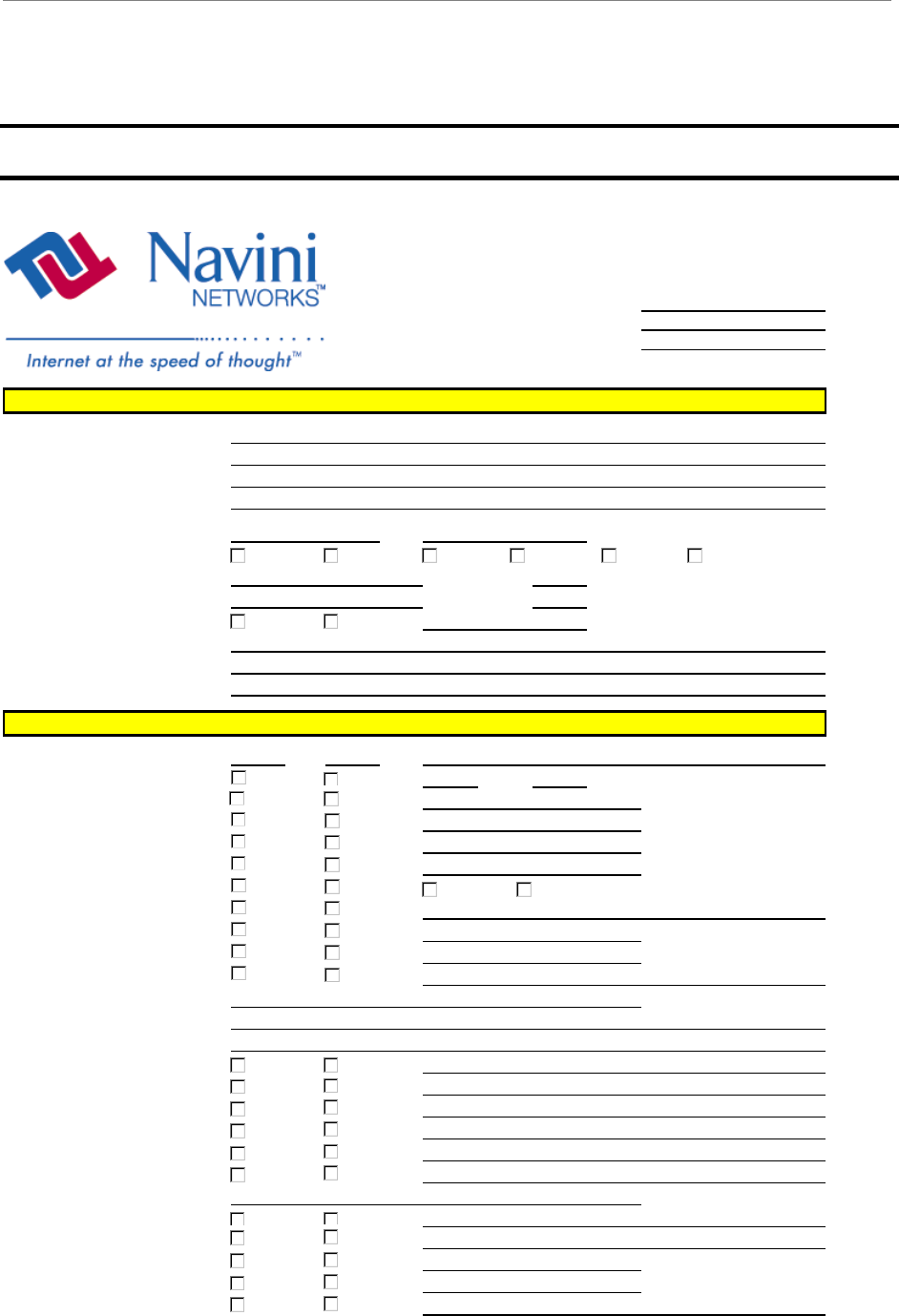
Navini Networks, Inc. Ripwave Base Station I&C Guide
Part #40-00047-00 Rev D v1.0 121
February 28, 2003
Appendix B: Site Candidate Evaluation Form
NAVINI NETWORKS
SITE EVALUATION FORM
PN - 40-00091-00
Site Name
Date
FSE
COMPANY NAME
ADDRESS
SITE OWNER
SITE CONTACT NO.
GPS COORDINATES LAT LONG
ANT TYPE (OMNI, PANEL)
ENCLOSURE TYPE (HUT, ETC) ELEV (AMSL) FEET
TOWER TYPE (SS, MP,ETC) HEIGHT (AGL) FEET
SITE ACCESS RESTRICTIONS OTHER
DRIVE TO DIRECTIONS
BTS Space Availability (3' x 3') x
Room for Expansion BTS x
Type/Size of Cabinet required FEET
110VAC, 20A Available/Distance FEET
AC Outlet Available/Distance FEET
24VDC, 60A Available/Distance FEET
Breaker(s) Required
Sub-metering Required
Ground Available/Distance FEET
Gnd Buss Bar Available/Distance FEET
Cable Entry Available
Cable Routing Distance FEET
Kind of Entry Material
Kind of Sealing Required
Site Plans Available
Cable Tray Available
Cable Hangers Required
Floor/Wall Drilling Permitted
Airconditioning Available
Telco/LAN/WAN Available
Demarc Location/Distance FEET
Room has Adequate Lighting
Room has Adequate Ventilation
Any Door Entry Restrictions DOOR DIMENSION
Enclosure Access OTHER
Crane/Heavy Eqpmt Required
SITE INFORMATION
SITE CONSTRUCTION INFORMATION
YES NO
INDOOR OUTDOOR
OMNI PANEL 2.3GHZ 2.4GHZ
24HRS 8-5PM
YES NO
YES NO
YES NO
YES NO
YES NO
YES NO
YES NO
YES NO
YES NO
Ground Elevator
YES NO
A
CDC
NO
YES
NO
YES
NO
YES
NO
YES
NO
YES
NO
YES
NO
YES
NO
YES
2.5GHZ 2.6GHZ
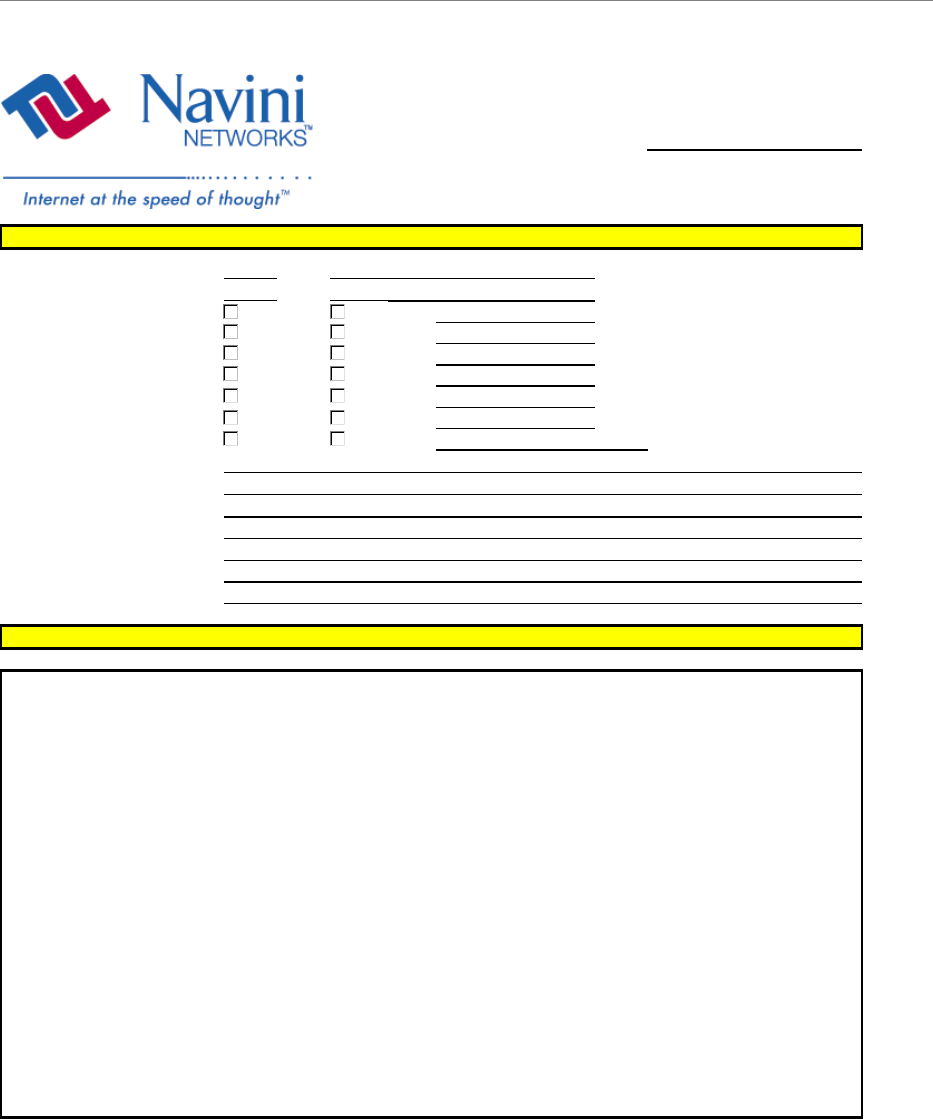
Ripwave Base Station I&C Guide Navini Networks, Inc.
122 Part #40-00047-00 Rev D v1.0
February 28, 2003
NAVINI NETWORKS
SITE EVALUATION FORM
Site Name 0
Proposed Antenna Height FEET COMMENTS
Cable Run Length to entry port FEET COMMENTS
Ant Space Available (10' spacing) OTHER
Special Bracket Required OTHER
Cable Hangers Required OTHER
Crane/Heavy Eqpmt Required OTHER
Structural Test Required OTHER
Interference Test Required OTHER
GPS Location Available CABLE RUN LENGTH IN FEET
GPS Comments / Details
Detailed Tower Description
TOWER/ANTENNA CONSTRUCTION INFORMATION
TOWER PICTURE
YES NO
YES NO
YES NO
YES NO
YES NO
YES NO
YES NO
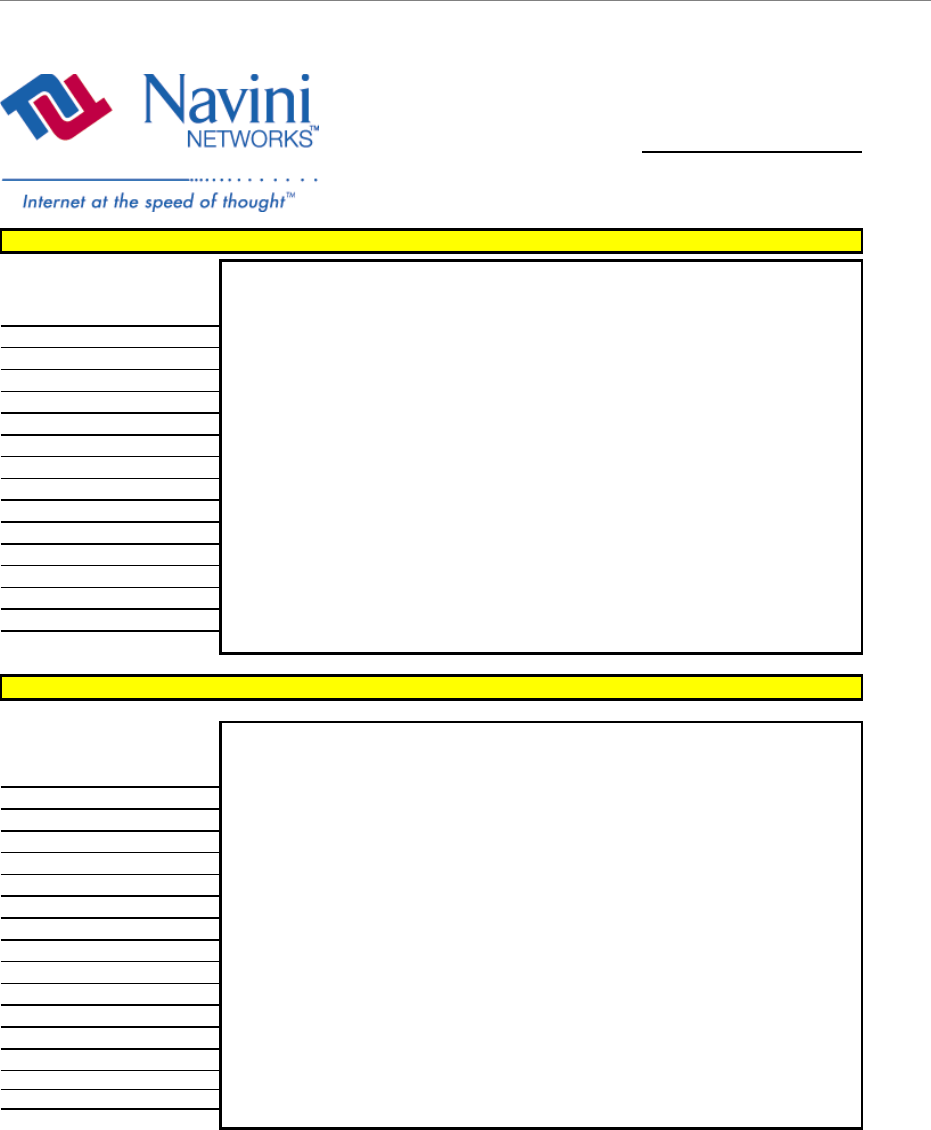
Navini Networks, Inc. Ripwave Base Station I&C Guide
Part #40-00047-00 Rev D v1.0 123
February 28, 2003
NAVINI NETWORKS
SITE EVALUATION FORM
Site Name 0
Comments
Comments
SITE MAP / SKETCH
GPS ANTENNA LOCATION
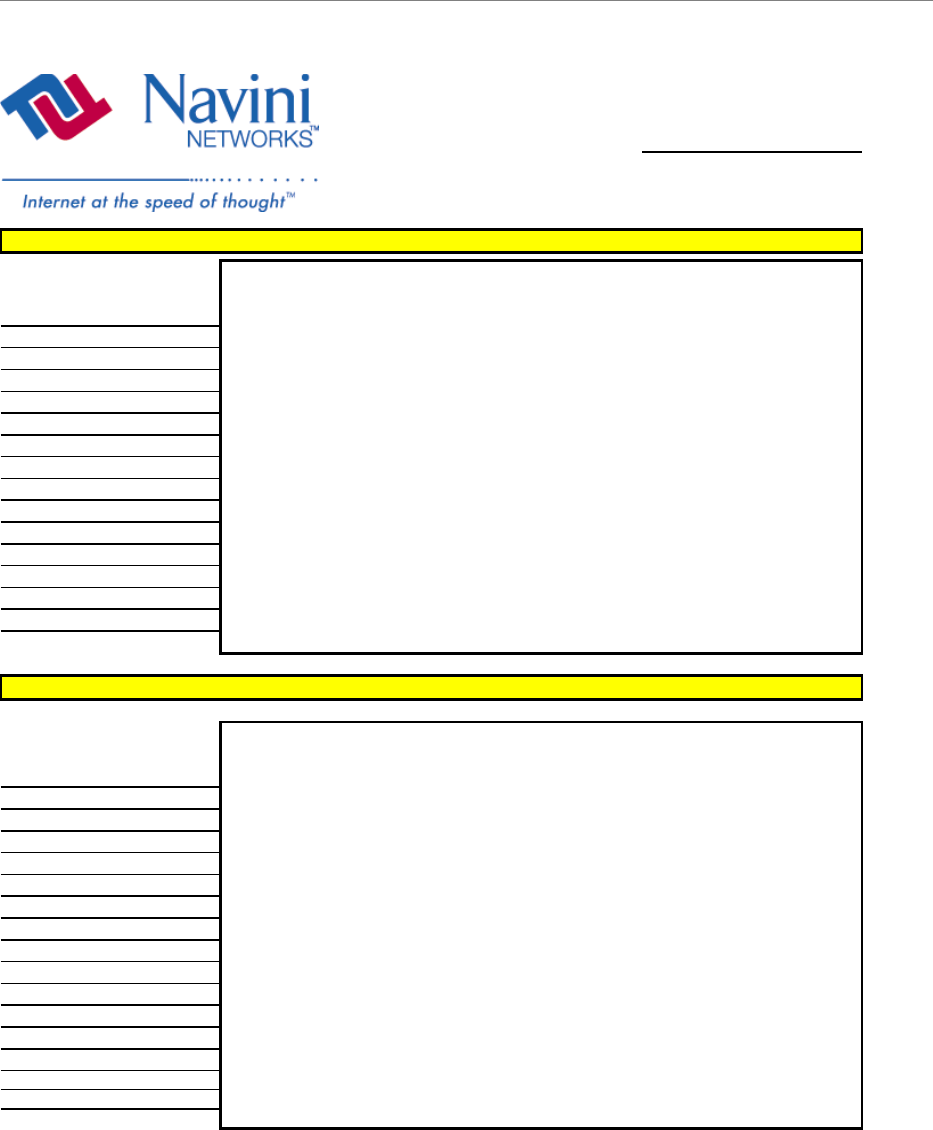
Ripwave Base Station I&C Guide Navini Networks, Inc.
124 Part #40-00047-00 Rev D v1.0
February 28, 2003
NAVINI NETWORKS
SITE EVALUATION FORM
Site Name 0
Comments
Comments
NORTH VIEW
NORTHEAST VIEW
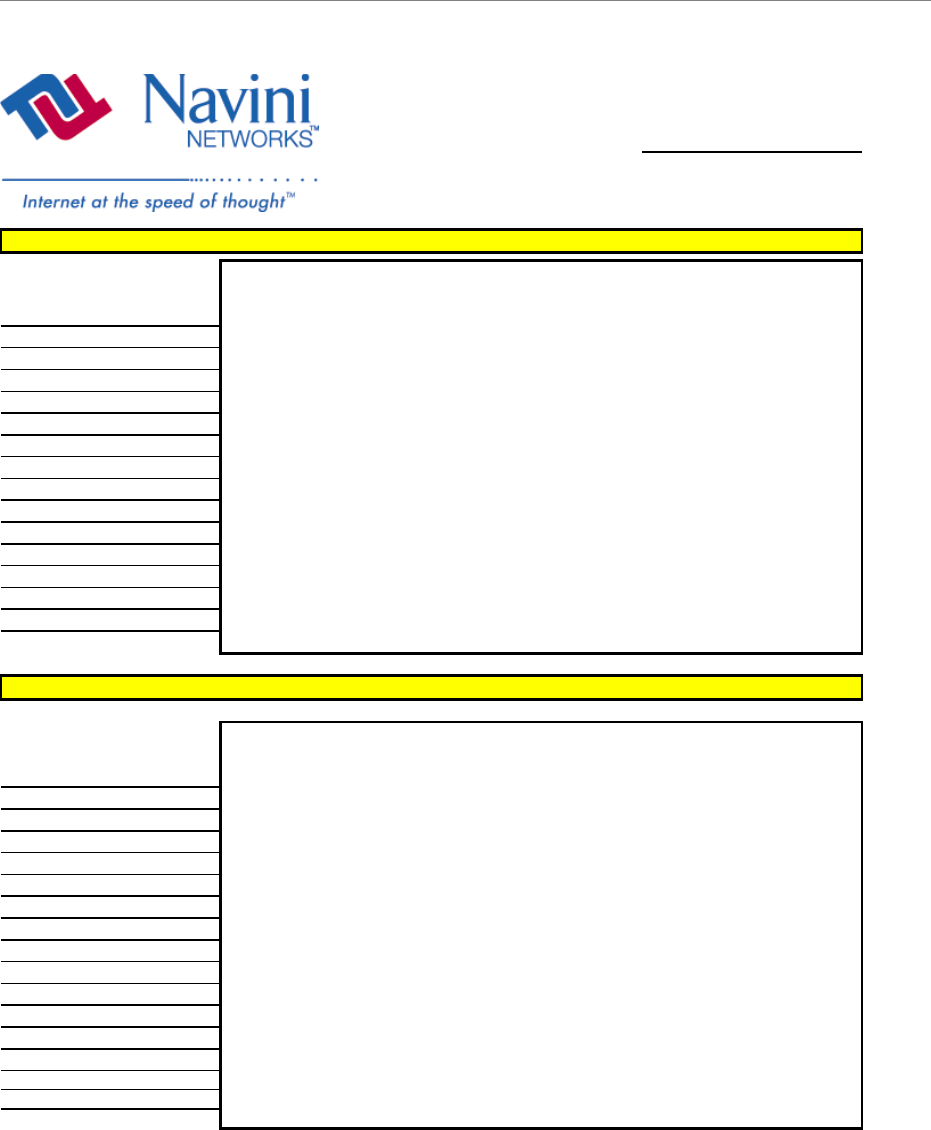
Navini Networks, Inc. Ripwave Base Station I&C Guide
Part #40-00047-00 Rev D v1.0 125
February 28, 2003
NAVINI NETWORKS
SITE EVALUATION FORM
Site Name 0
Comments
Comments
EAST VIEW
SOUTHEAST VIEW
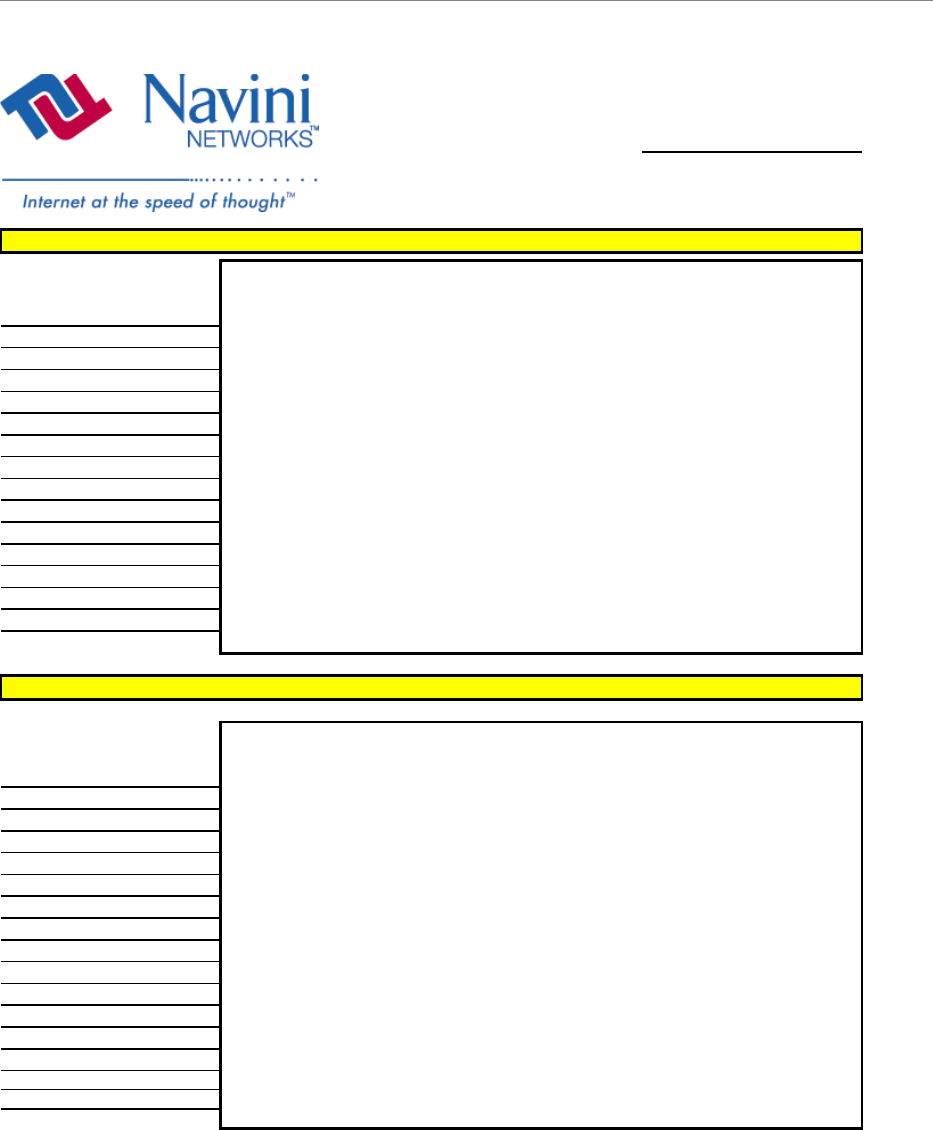
Ripwave Base Station I&C Guide Navini Networks, Inc.
126 Part #40-00047-00 Rev D v1.0
February 28, 2003
NAVINI NETWORKS
SITE EVALUATION FORM
Site Name 0
Comments
Comments
SOUTH VIEW
SOUTHWEST VIEW
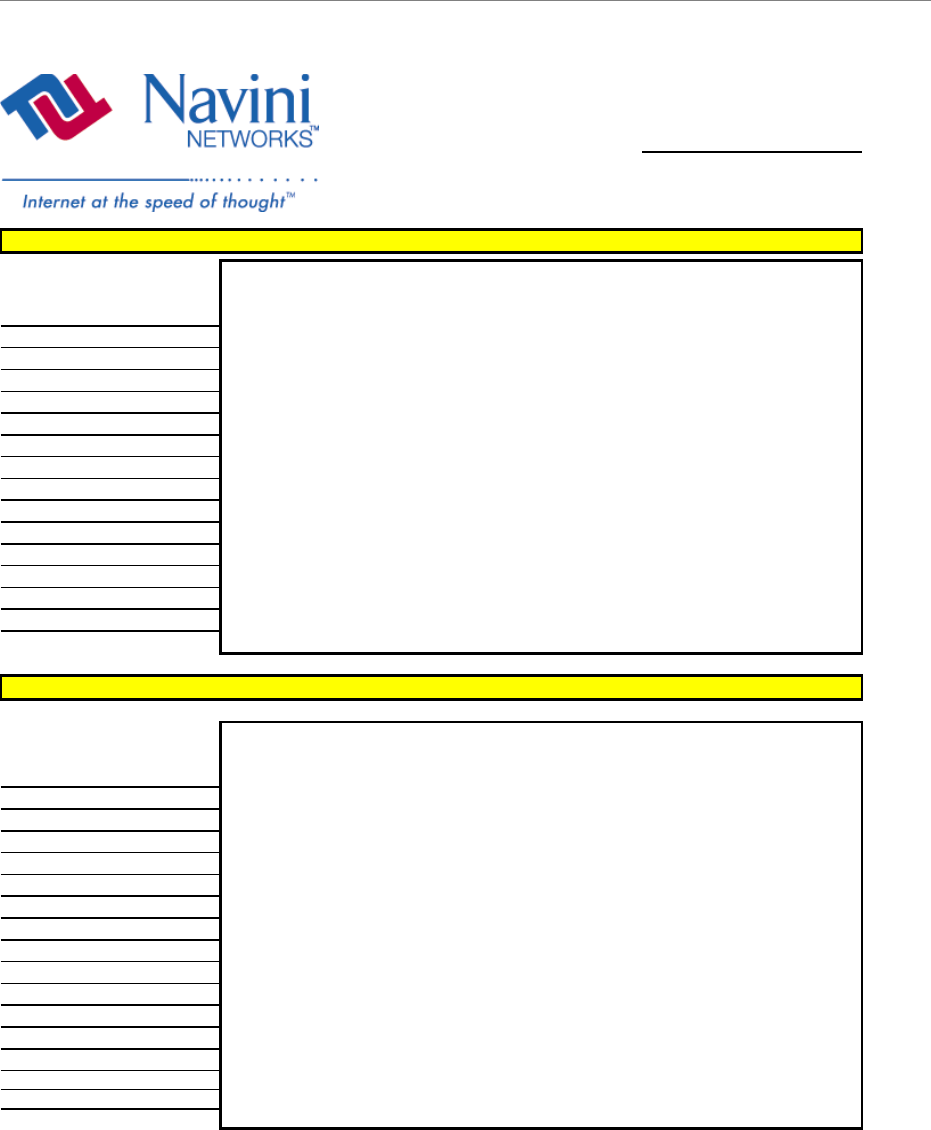
Navini Networks, Inc. Ripwave Base Station I&C Guide
Part #40-00047-00 Rev D v1.0 127
February 28, 2003
NAVINI NETWORKS
SITE EVALUATION FORM
Site Name 0
Comments
Comments
WEST VIEW
NORTHWEST VIEW
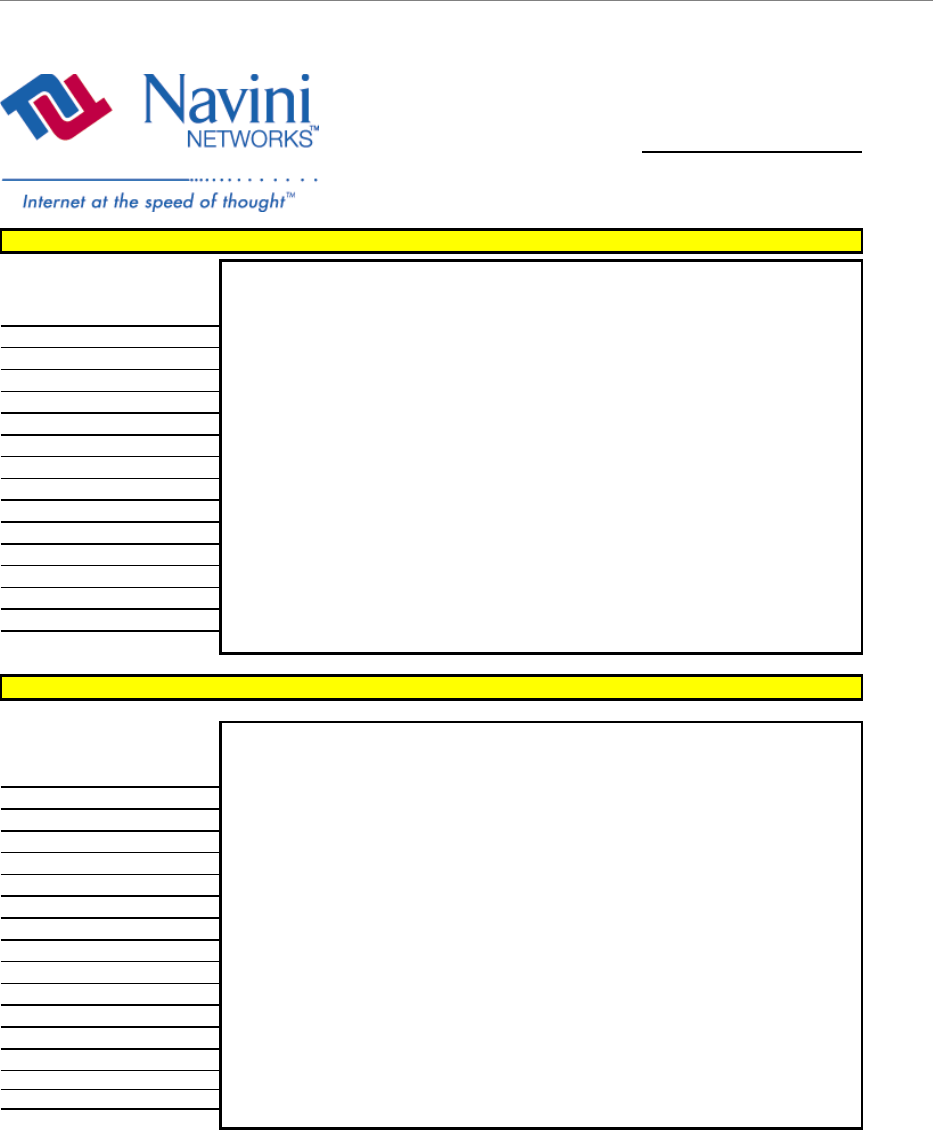
Ripwave Base Station I&C Guide Navini Networks, Inc.
128 Part #40-00047-00 Rev D v1.0
February 28, 2003
NAVINI NETWORKS
SITE EVALUATION FORM
Site Name 0
Comments
Comments
EXISTING COMPOUND PICTURE
GROUNDING
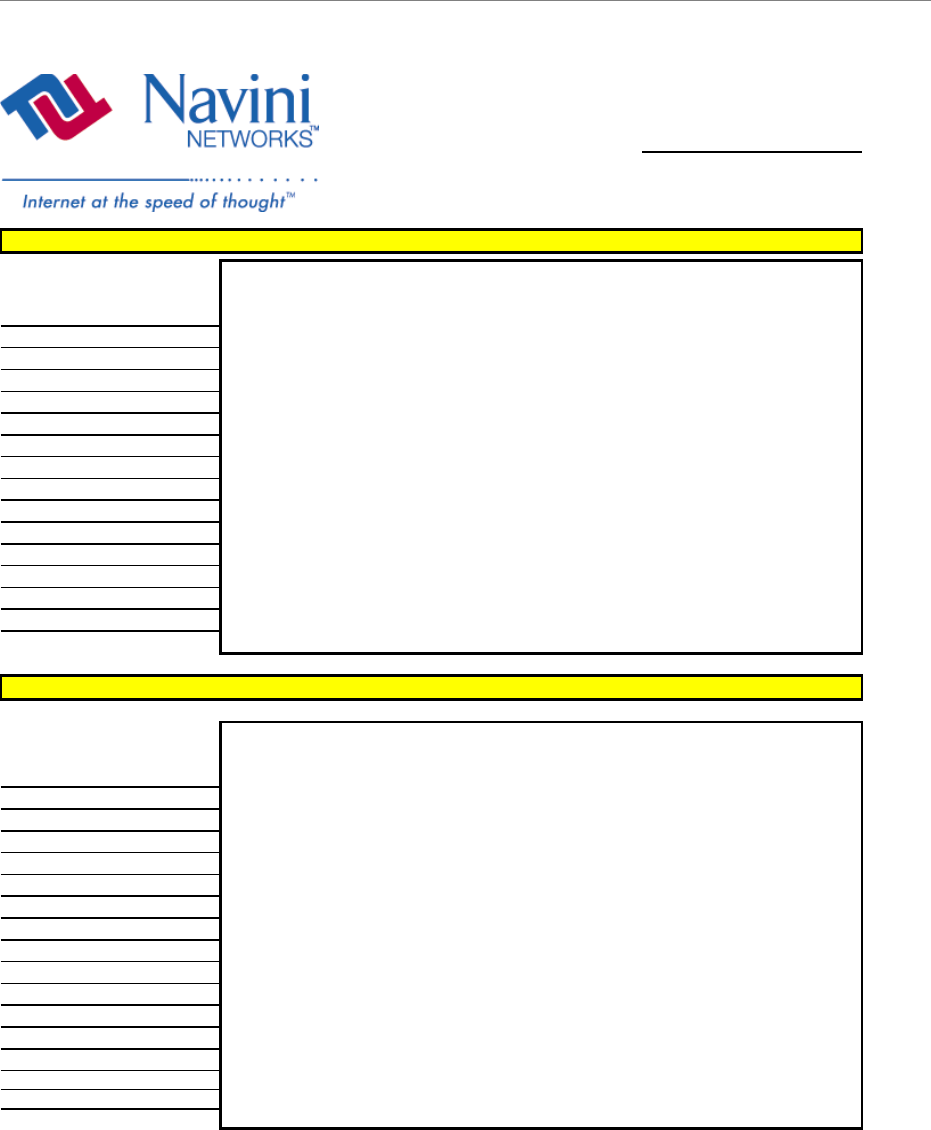
Navini Networks, Inc. Ripwave Base Station I&C Guide
Part #40-00047-00 Rev D v1.0 129
February 28, 2003
NAVINI NETWORKS
SITE EVALUATION FORM
Site Name 0
Comments
Comments
INGRESS
EGRESS
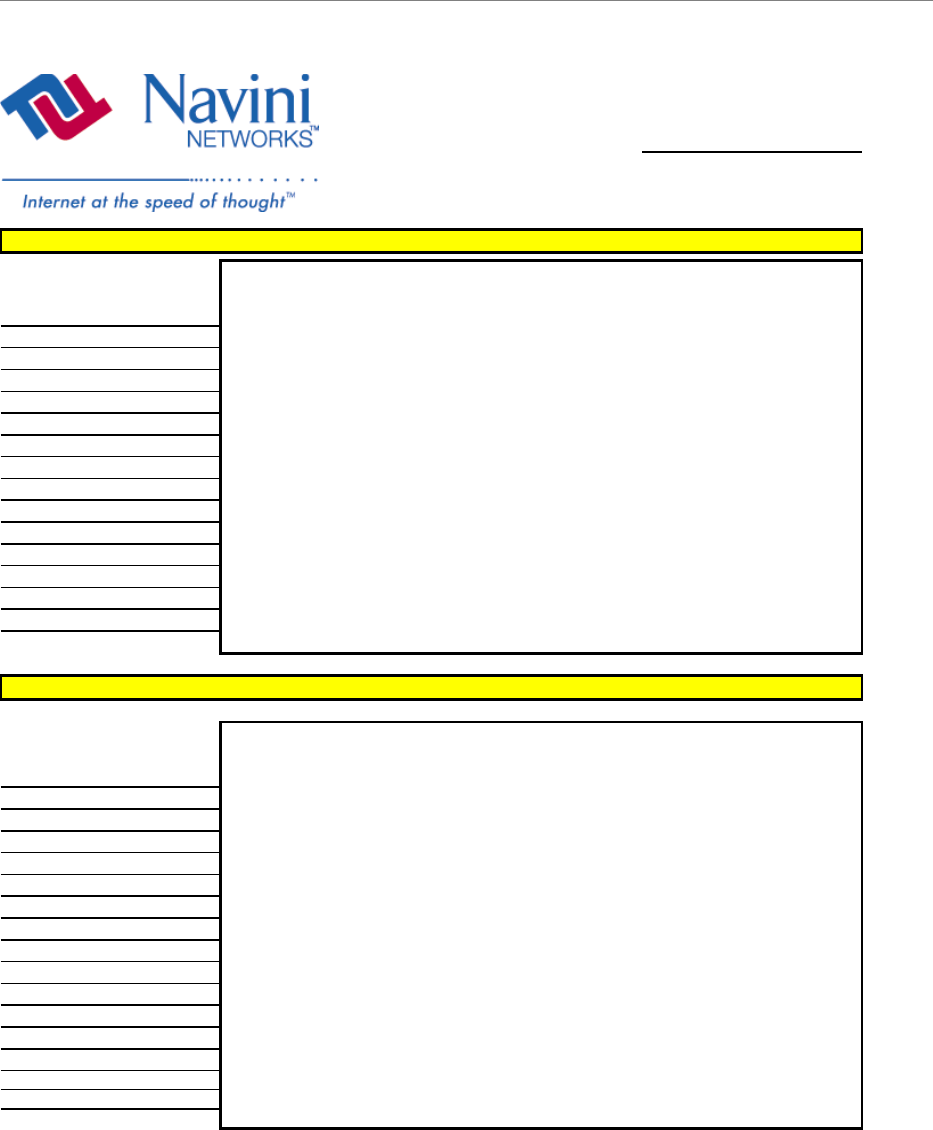
Ripwave Base Station I&C Guide Navini Networks, Inc.
130 Part #40-00047-00 Rev D v1.0
February 28, 2003
NAVINI NETWORKS
SITE EVALUATION FORM
Site Name 0
Comments
Comments
POWER
TELCO
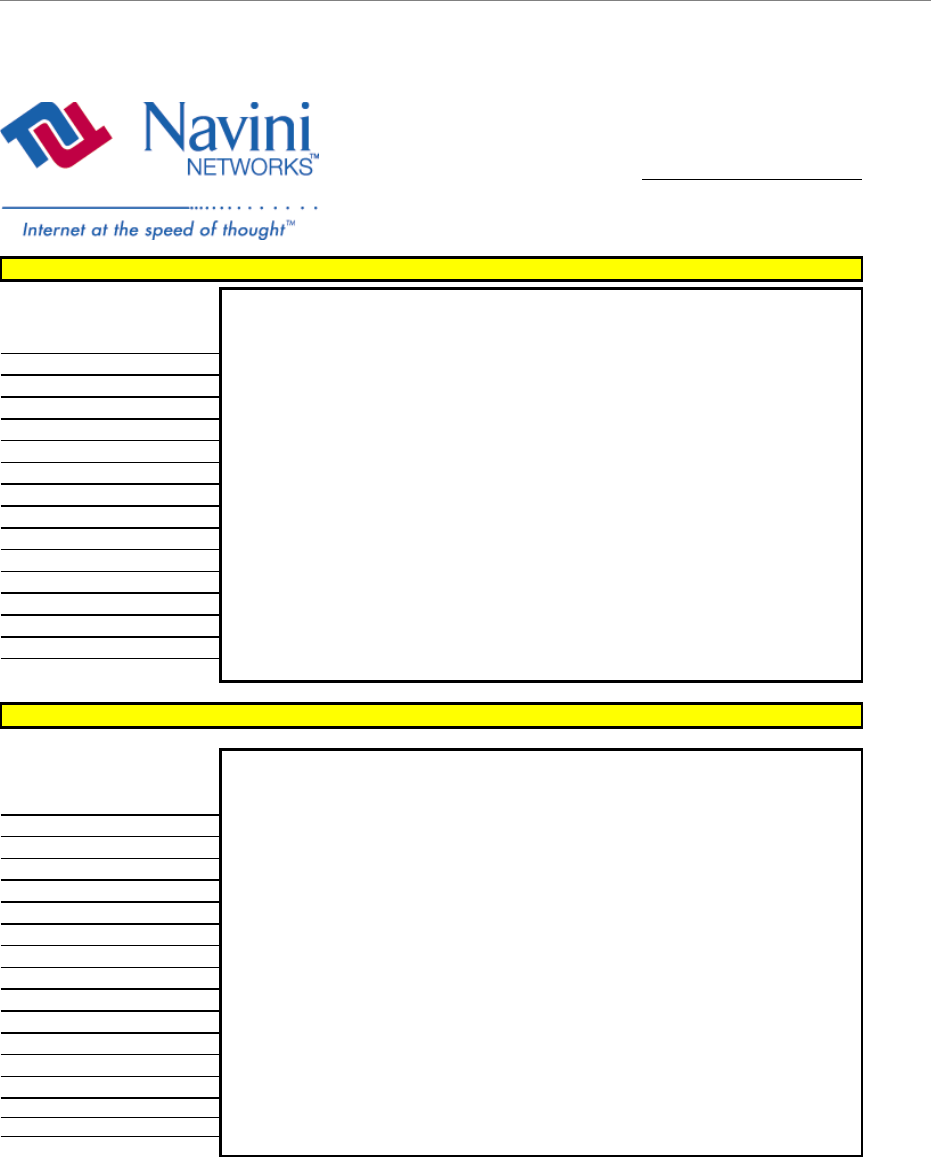
Navini Networks, Inc. Ripwave Base Station I&C Guide
Part #40-00047-00 Rev D v1.0 131
February 28, 2003
NAVINI NETWORKS
SITE EVALUATION FORM
Site Name 0
Comments
Comments
SHELTER PICTURE
SHELTER LAYOUT AND DIMENSION DRAWING

Ripwave Base Station I&C Guide Navini Networks, Inc.
132 Part #40-00047-00 Rev D v1.0
February 28, 2003
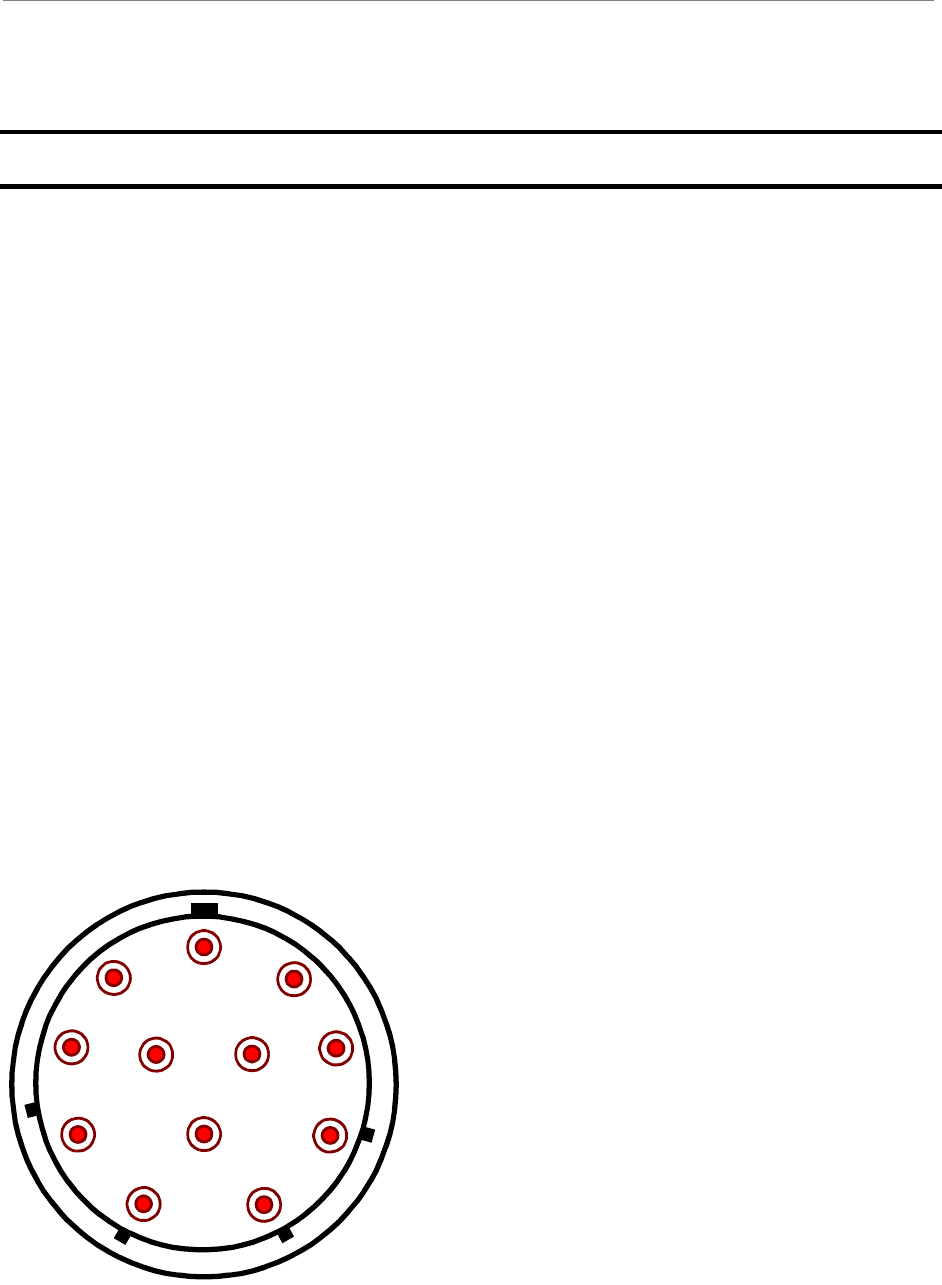
Navini Networks, Inc. Ripwave Base Station I&C Guide
Part #40-00047-00 Rev D v1.0 133
February 28, 2003
Appendix C: RFS System Test (Cable Sweeps)
Introduction
Before installing a Base Station at a site, the RFS and the associated cables must be tested, and
the results of the tests documented. The tests verify the performance of three major components:
the data/power cable, the RF cables, and the RFS unit. This procedure includes, as well, the full
RFS sub-assembly with the associated cables. All results for the RFS and cable testing are
recorded in the RFS System Test Form, P/N 40-00093-00.
Procedures
RFS Data/Power Cable
This test will check the integrity of the data/power cable. The cable being tested consists of six
twisted pairs of conductors. The conductors will be tested for continuity, opens, and shorts. Male
connectors are on both ends of the cable. Each connector is wired the same. You will need to
check all cables – the main cable from the RFS to the data/power cable surge protector, and the
jumper cable from the data/power cable surge protector to the BTS. The pin layout is shown in
Figure C1, looking at the connector face. Table C1 provides the pinout details.
Figure C1: Pin Layout
A
B
C
D
E
F
G
H
J
K
L
M
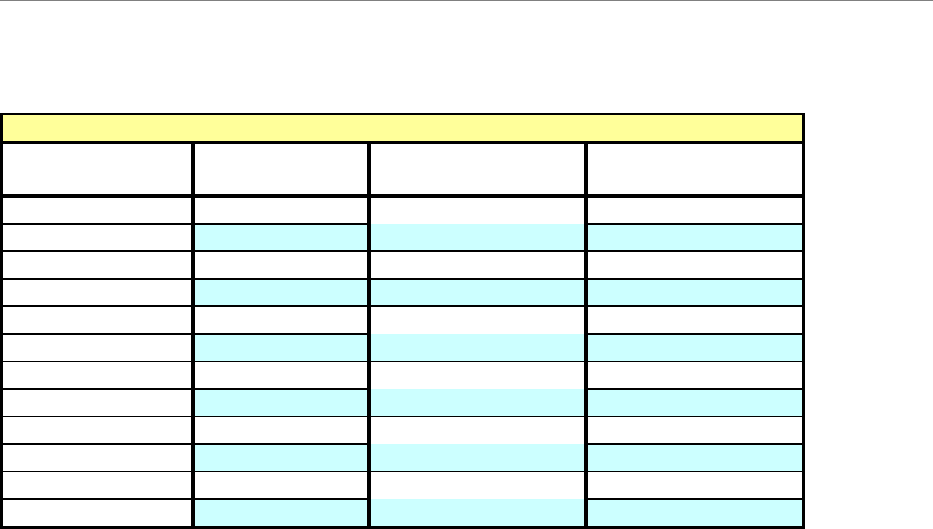
Ripwave Base Station I&C Guide Navini Networks, Inc.
134 Part #40-00047-00 Rev D v1.0
February 28, 2003
Table C1: Pinout Details
Perform the continuity test with both the Volt Ohm Meter (VOM) and the power/data cable
tester. If the power/data cable tester is not available, perform the continuity test with the VOM.
Required Equipment
• VOM – Continuity tester
• Jumper for shorting pins
• RFS power/data cable tester
Continuity Test With VOM
Step 1. On one end of the cable, short a pair of conductors using a shorting device.
Step 2. Using a VOM/Digital Volt Meter (DVM) set to ohms, verify a short is present on the
pair at the other end.
Step 3. Leaving one probe on one of the paired pins, contact all of the other pins with the other
probe, ensuring an open connection.
Step 4. Check all 6 pairs of wires in the same manner.
Step 5. Verify continuity from the connector case to the drain wire (pin D) on each end of the
cable and between each connector case.
Step 6. Verify an open circuit from the connector case to each individual wire, except to the
drain wire.
Wire Color Wire Color Signal Name
RED PAIR +12V A
BLACK +12V A RTN
BROWN Heater
DRAIN GND (Shield Wire)
BLACK PAIR RX_EN_B-
WHITE RX_EN_B+
BLUE PAIR RX_EN_A+
BLACK RX_EN_A-
BLACK PAIR Diagbus-
GREEN Diagbus+
BLACK PAIR +12V B Return
YELLOW +12V B
POWER CABLE PIN OUT
A
B
C
D
Circular
Connector(s)
J
K
L
M
E
F
G
H
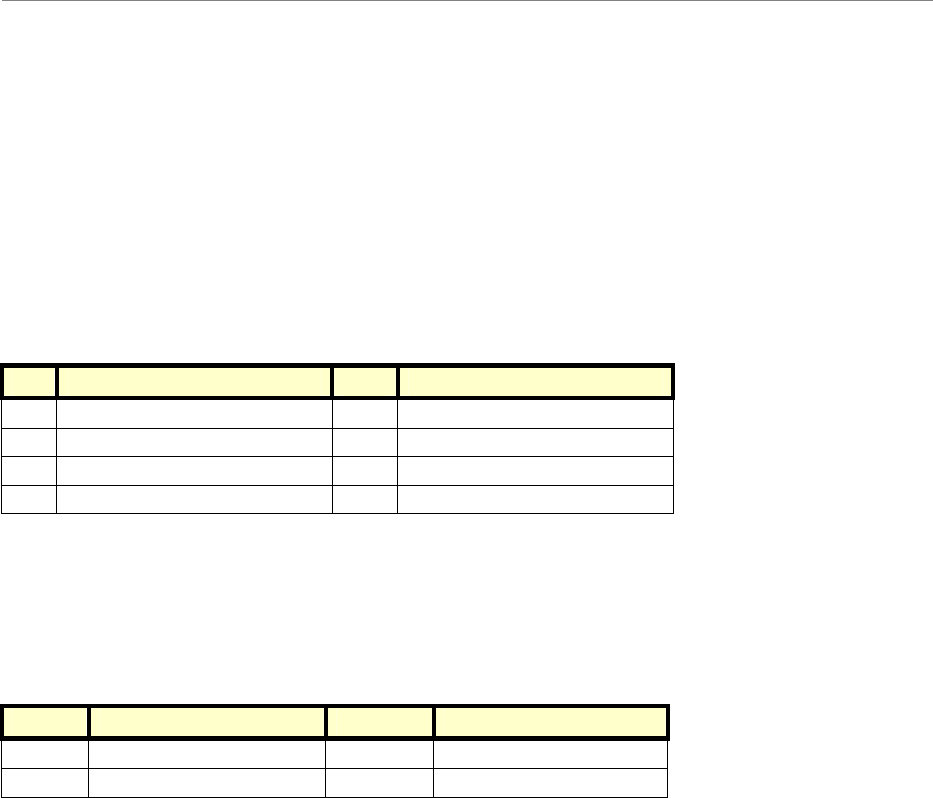
Navini Networks, Inc. Ripwave Base Station I&C Guide
Part #40-00047-00 Rev D v1.0 135
February 28, 2003
Continuity Test With Power/Data Cable Tester
Step 1. Connect one end of the power/data cable to the connector on the power/data cable
tester.
Step 2. Using a VOM/DVM set to ohms, check resistance to ground on the other end of the
cable. Resistance is checked from the case of the connector to the individual pin.
Resistance readings (+/- 10 percent ) are shown in Table C2.
Table C2: Resistance to Ground
Pin Resistance Pin Resistance
A 1K ohms G 6.2K ohms
B 2K ohms H 8.2K ohms
E 3.3K ohms L 10K ohms
F 5.1K ohms M 12K ohms
Step 3. Using a VOM/DVM set to ohms, check resistance between the pairs on the other end
of the cable. Resistance should be the sum of the resistance of the two pairs, +/- 10
percent. Refer to Table C3.
Table C3: Resistance of Two Pairs
Pins Resistance Pins Resistance
A & B 3K ohms G & H 14.4K ohms
E & F 8.4K ohms L & M 22K ohms
Step 4. Remove the power/data cable tester from the power/data cable.
Sweep Test of RF Cables & RFS
Sweep testing of the RF cables and the RFS is performed in three separate steps.
• Sweep of the cables
• Sweep of the RFS
• Sweep of the cables and the RFS together
All results will be entered in the RFS System Test Form, P/N 40-00093-00. The total of the
insertion loss for the cables and the RFS will be equal to the insertion loss of both parts swept
together. The minimum and maximum cable loss are listed in Table C4.
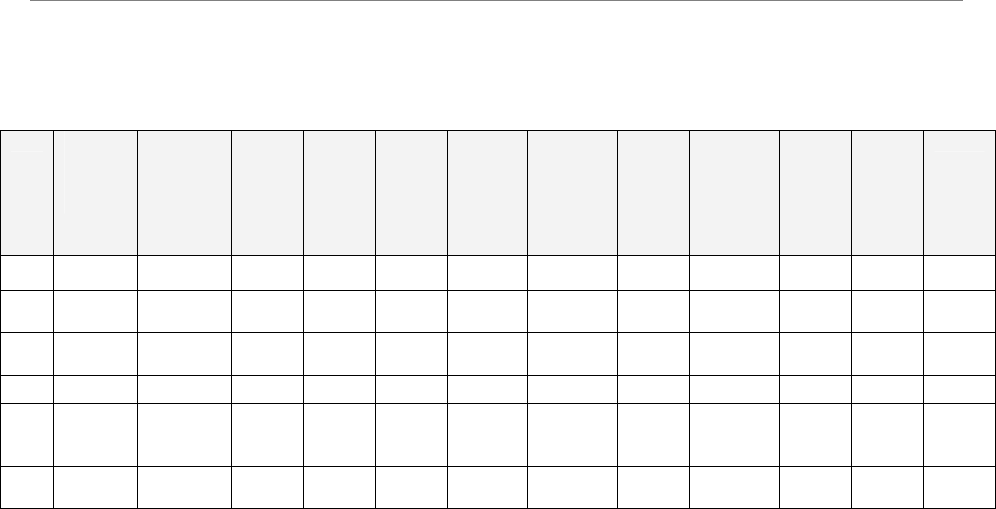
Ripwave Base Station I&C Guide Navini Networks, Inc.
136 Part #40-00047-00 Rev D v1.0
February 28, 2003
Table C4: Active & Passive RFS Loss / Operating Parameters
PA Max
Output
Power
[dBm]
BTS Max
Output
power
with
*Filter
[dBm]
CAL
Cable
Min
Loss
CAL
Cable
Max
Loss
RF
Cable
Min
Loss
[dB]
Active
RFS
Loss
Typ
[dB]
Passive
RFS
Loss Typ
[dB]
TX
Pwr
to
Ant
Min
[dBm]
TX
Pwr
to
Ant Max
[dBm]
RX
Power
to Ant
Min
[dBm]
RX
Power
to Ant
Max
[dBm]
Notes
2.3 +38 +37 3.0 6.0 0 3.2 1.7 20 35 -95 -75
2.4 +37 N/A 4.0 9.5 0 3.2 1.7 10 25 -85 -65 -05
SYN
2.4 +37 N/A 3.0 4.5 0 3.2 1.7 18 30 -95 -70 -01
SYN
2.5 +39 +38 3.0 6.0 0 3.2 1.7 20 35 -95 -75
2.6
EF
GH
+39 +38 3.0 6.0 0 3.2 1.7 20 35 -95 -75
2.6
EF
+37 +35 3.0 4.5 0 3.2 1.7 20 35 -95 -75 -05
SYN
* Channel filter for 2.5/2.6 or Block Filter for 2.3 has 1.0 +/- 0.2 dB Insertion Loss
* Channel filter for 2.6 EF Combo is 1.8 +/- 0.2 dB including cable to backplane.
Equipment Required
• Signal Generator - Agilent 8648C, or suitable alternative, tunable to the RFS center
frequency
• Spectrum Analyzer - Agilent E4402B, or equivalent
• Signal Generator cable and Spectrum Analyzer cable – Gender can be changed using a
barrel connector
• Male and Female barrel connectors for Signal Generator cable and Spectrum Analyzer
cable connections
• Power/data test cable
• Navini RFS Test Box
Equipment Settings
Spectrum Analyzer:
• Spectrum Analyzer - 5M
• RBW - 100 KHz
• VBW - 100 KHz
• Sweep Time - Auto
• Frequency (Provided in Table C5)
Signal Generator:
• Amplitude - 0 dB
• Frequency (Provided in Table C5)
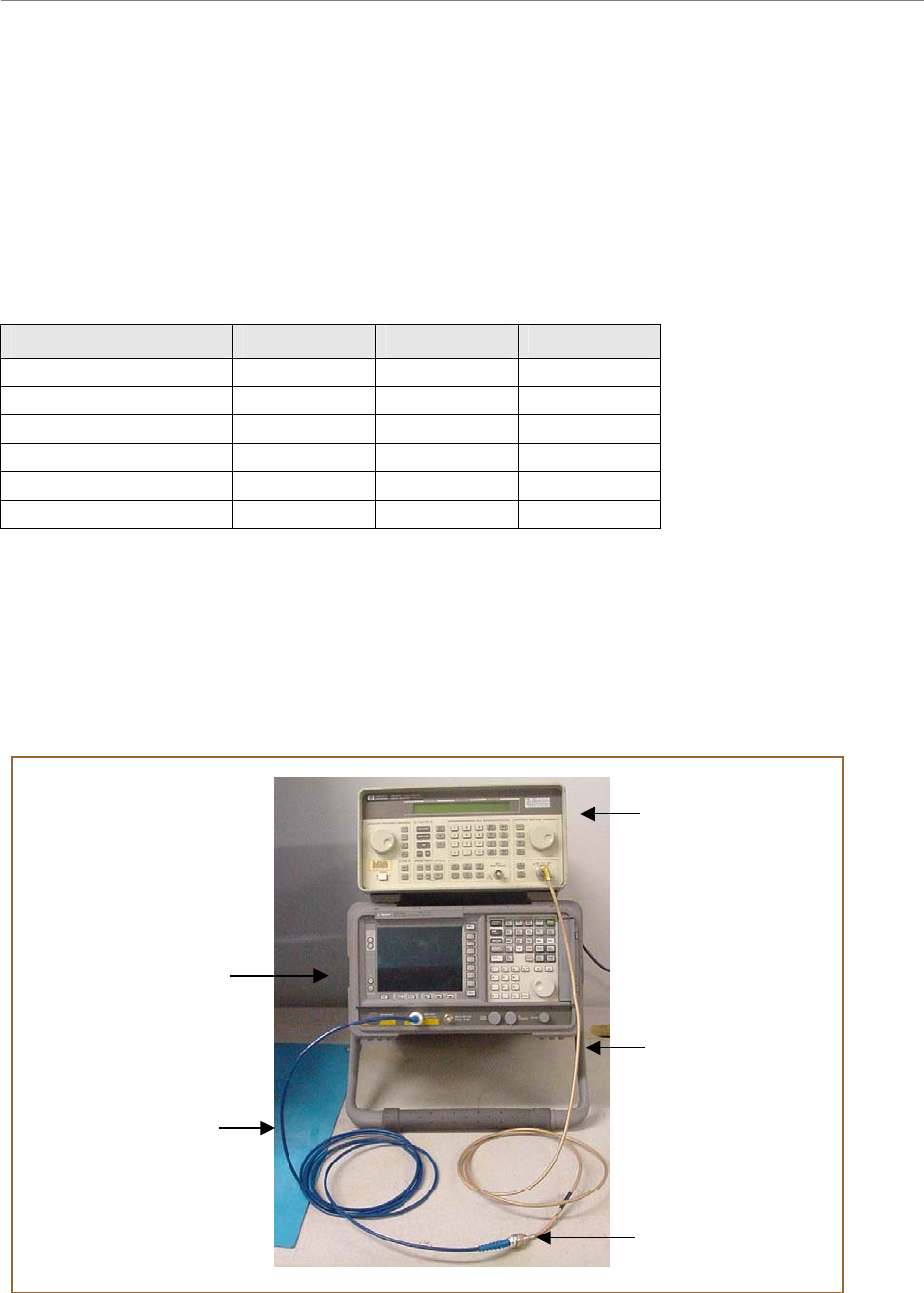
Navini Networks, Inc. Ripwave Base Station I&C Guide
Part #40-00047-00 Rev D v1.0 137
February 28, 2003
Test Setup
When performing each type of sweep, the sweep has to be performed at certain frequency
intervals (Table C5). Perform the complete test at the first frequency. Go to the next frequency
and recalibrate the test setup. Perform the complete test again. Do the same for the third
frequency. Refer to Figure C2.
Table C5: Sweep Frequencies
System Sweep 1 Sweep 2 Sweep 3
2.3 GHz High band 2348.25 2352.50 2357.50
2.3 GHz Low band 2307.50 2312.50 2316.75
2.4 GHz 2400.00 2440.00 2473.50
2.5 GHz 2500.00 2548.00 2596.00
2.6 GHz 2602.00 2620.00 2641.00
2.6 GHz EFGH 2602.00 2641.00 2683.00
1. Connect the Signal Generator cable to the Signal Generator.
2. Connect the Spectrum Analyzer cable to the Spectrum Analyzer.
3. Connect the other end of the cables together. Use a barrel connector if needed.
Figure C2: Test Setup
Spectrum Analyzer
Signal Generator
Barrel Connector
(if needed)
Signal Generator
Cable
Spectrum Analyzer
Cable
Spectrum Analyzer
Signal Generator
Barrel Connector
(if needed)
Signal Generator
Cable
Spectrum Analyzer
Cable
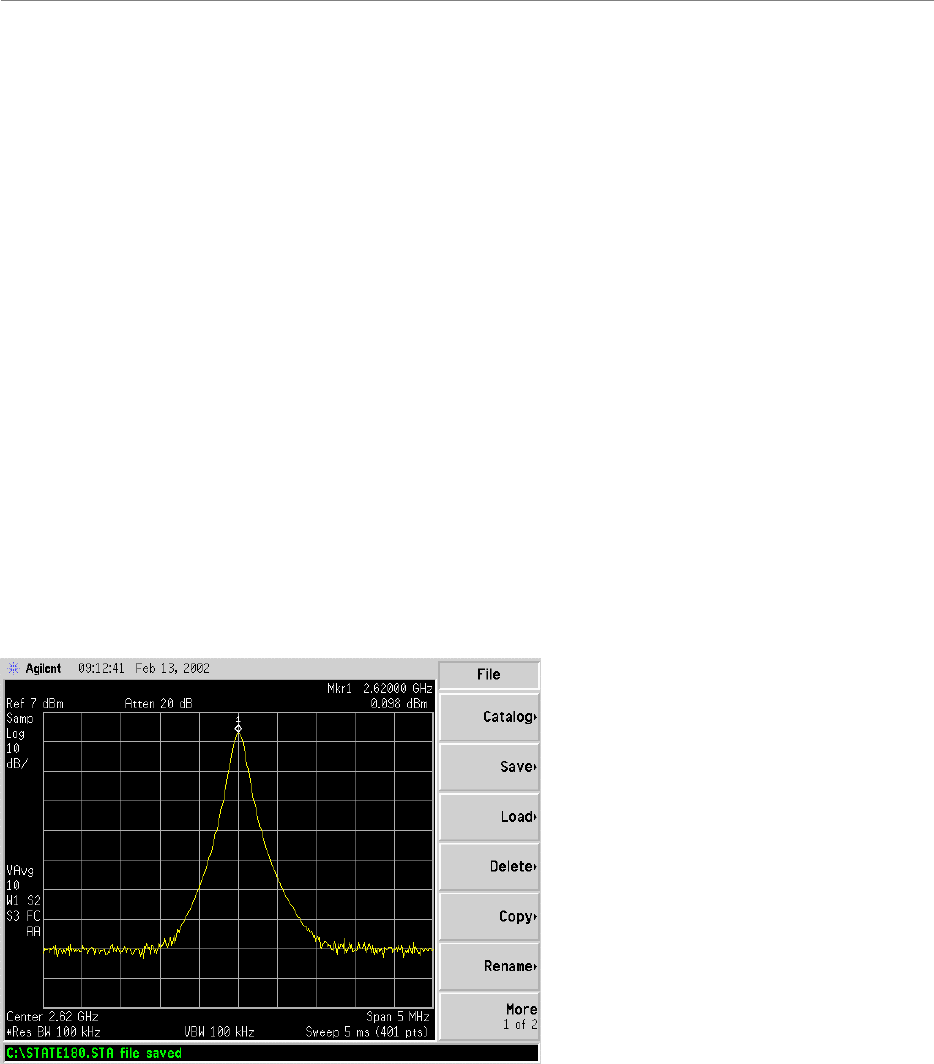
Ripwave Base Station I&C Guide Navini Networks, Inc.
138 Part #40-00047-00 Rev D v1.0
February 28, 2003
Test Procedure
The following procedures are for the Agilent E4402B Spectrum Analyzer. If alternative
equipment is used, refer to the manufacturer’s calibration procedures. The key point is to make
accurate microwave frequency power measurements.
Step 1. Turn the Signal Generator and Spectrum Analyzer on. Allow the equipment to warm
up for 15 minutes for the output to stabilize.
Step 2. Set the Signal Generator frequency to the desired test frequency (Table C5) of the RFS
under test.
Step 3. Set the Signal Generator output amplitude to 0 dBm.
Step 4. Set the center frequency of the Spectrum Analyzer to the center frequency of the RFS
under test.
Step 5. Set the Spectrum Analyzer to Span = 5 MHz and Resolution Bandwidth = 100kHz.
Step 6. Take a marker measurement on the Spectrum Analyzer by using the ‘marker to peak’
or the ‘peak search’ function. The screen on the Spectrum Analyzer should look similar
to that shown in Figure C3.
Figure C3: Sweep Test Marker Measurement Example
Step 7. If the marker measurement doesn’t read 0.0 dBm, adjust the amplitude on the Signal
Generator until the Spectrum Analyzer marker reads 0.0 dBm, or as close to 0.0 dBm
as possible. This will remove all losses associated with the test cables. All
measurement data should be recorded one digit to the right of the decimal point. For
example, 31.5dB.
Once the test setup is calibrated, these cables will remain in place and will be used
throughout the whole test. If the test cables are removed or changed, incorrect readings
will result.
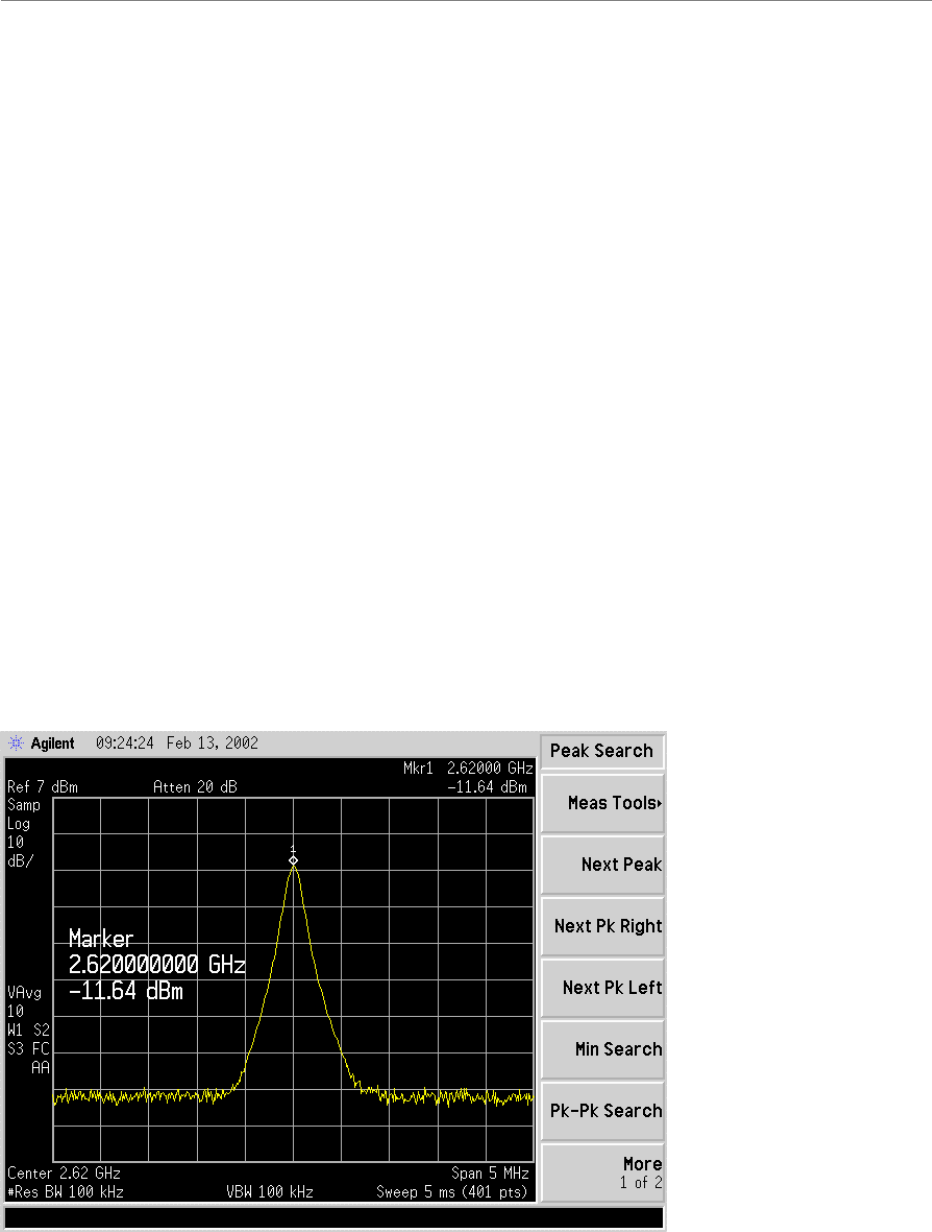
Navini Networks, Inc. Ripwave Base Station I&C Guide
Part #40-00047-00 Rev D v1.0 139
February 28, 2003
RF Cable Insertion Loss
This test is performed on all RF cables that are installed in the system. This includes the eight
antenna cables, the system calibration cable, and all jumper cables. Follow the procedures for
either the cables on the ground or cables run up the tower.
Test Procedure For RF Cables on the Ground
Step 1. Ensure calibration of the test setup has been performed each time the test frequency is
changed.
Step 2. If present, remove the barrel connector from between the Signal Generator and
Spectrum Analyzer cables.
Step 3. Connect the cable from the Signal Generator to one end of the cable. Use a barrel
connector to change the gender, if required.
Step 4. Connect the cable from the Spectrum Analyzer to the other end of the cable. Use a
barrel connector to change the gender, if required.
Step 5. Take a marker measurement on the Spectrum Analyzer by using the ‘marker to peak’
or the ‘peak search’ function. The screen on the Spectrum Analyzer should look similar
to the one shown in Figure C4.
Figure C4: Insertion Loss (Cables on Ground) Marker Measurement Example

Ripwave Base Station I&C Guide Navini Networks, Inc.
140 Part #40-00047-00 Rev D v1.0
February 28, 2003
Step 6. The result should be within +/- 0.5 dB of the calculated value. If the insertion loss
results do not agree with the manufacturer’s data, check the connectors for proper
connection to the cable, and check for kinks in the cable. If the Spectrum Analyzer has
a distance to fault (DTF) function, it can be used to help troubleshoot kinks in the
cable.
CAUTION! Cables with results greater than the specified limits (i.e., 2 or 3 dB high)
should not be installed, as a potential hardware fault exists.
Step 7. Record the data in the RFS System Test Form under “MAIN FEEDER LOSS” or
“JUMPER LOSS”. Ensure that the information is recorded under the channel number
that is on the cable label.
Step 8. Repeat steps 3 through 7 for all remaining cables and jumpers.
Step 9. Change the frequency to the next test frequency (refer back to the Test Setup section of
these procedures). Perform steps 1 – 8 until all cables have been successfully tested at
the frequencies shown in Table C5.
Test Procedure For RF Cables Already Run Up the Tower
Step 1. Ensure calibration of the test setup has been performed each time the test frequency is
changed.
Step 2. If present, remove the barrel connector from between the Signal Generator and
Spectrum Analyzer cables.
Step 3. Have a member of the tower crew, positioned at the upper end of the cables on the
tower, connect the calibration cable to antenna cable 1 with a barrel connector.
Step 4. At the lower end of the RF cables, connect the cable from the Signal Generator to the
calibration cable. Use a barrel connector to change the gender, if required.
Step 5. Connect the cable from the Spectrum Analyzer to antenna cable 1. Use a barrel
connector to change the gender, if required.
Step 6. Calculate the marker using the following formula: (the length of BOTH the calibration
cable and the antenna cable) x (loss per foot at the RFS center frequency for the type of
cable used).
Step 7. Take a marker measurement on the Spectrum Analyzer by using the ‘marker to peak’
or the ‘peak search’ function. The screen on the Spectrum Analyzer should look similar
to the one shown in Figure C5.
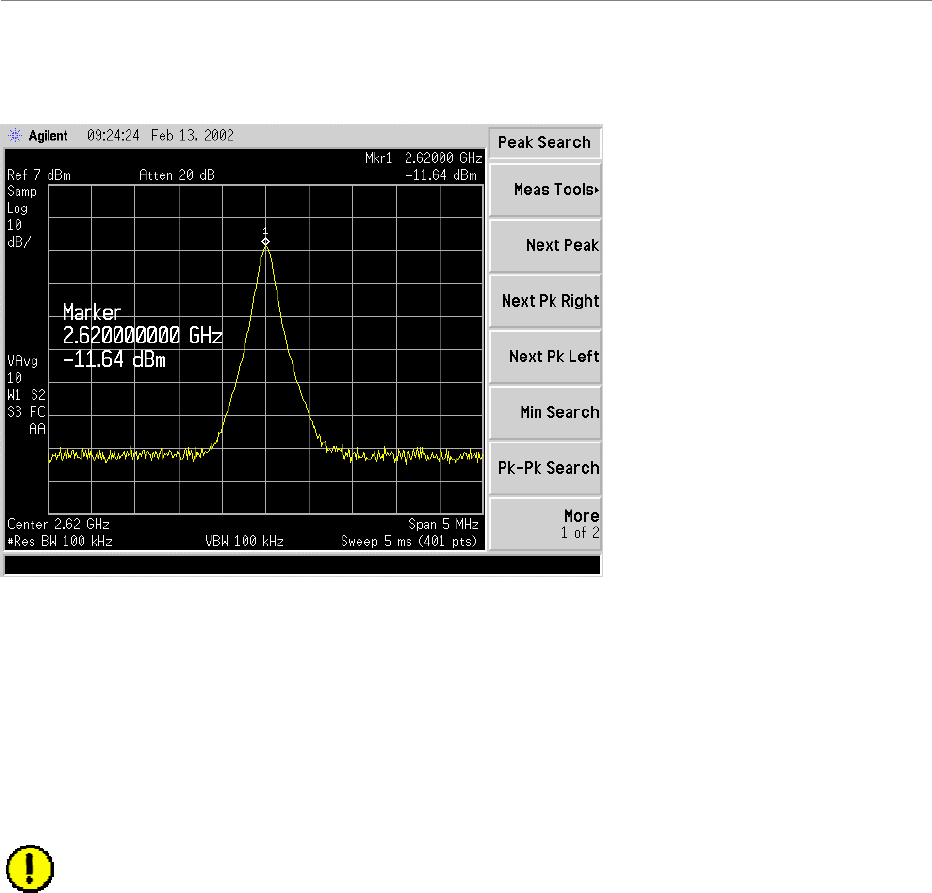
Navini Networks, Inc. Ripwave Base Station I&C Guide
Part #40-00047-00 Rev D v1.0 141
February 28, 2003
Figure C5: Insertion Loss (Cables on Tower) Marker Measurement Example
Step 8. The result should be within +/- 0.5 dB of the calculated value. If the insertion loss
results do not agree with the manufacturer’s data, check the cable connectors for proper
connection to the cable, and check for kinks in the cable. If the Spectrum Analyzer has
a distance to fault (DTF) function, this can be used to help troubleshoot kinks in the
cable.
Step 9. Divide this value in half and assign the result to the calibration cable and to the antenna
cable.
Caution: Cables with results greater than the specified limits (i.e., 2 or 3 dB high) should
not be installed, as a potential hardware fault exists.
Step 10. Record the data in the RFS System Test Form under “MAIN FEEDER LOSS”. Ensure
that the information is recorded under the channel number that is on the cable label.
Step 11. Repeat steps 3 through 10 for antenna cables 2 through 8.
Step 12. When finished, take the average of the eight values obtained for the calibration cable.
Use this value for the insertion loss of the calibration cable.
Step 13. Change the frequency to the next test frequency (refer back to Test Setup). Perform
steps 1 – 12 until all cables have been successfully tested at the frequencies given in
Table C5.
Step 14. Check the value of the nine jumpers at all three frequencies, per the procedure for
cables on the ground. Record the data in the RFS System Test Form under “JUMPER
LOSS”. Ensure that the information is recorded under the channel number that is on the
cable label.
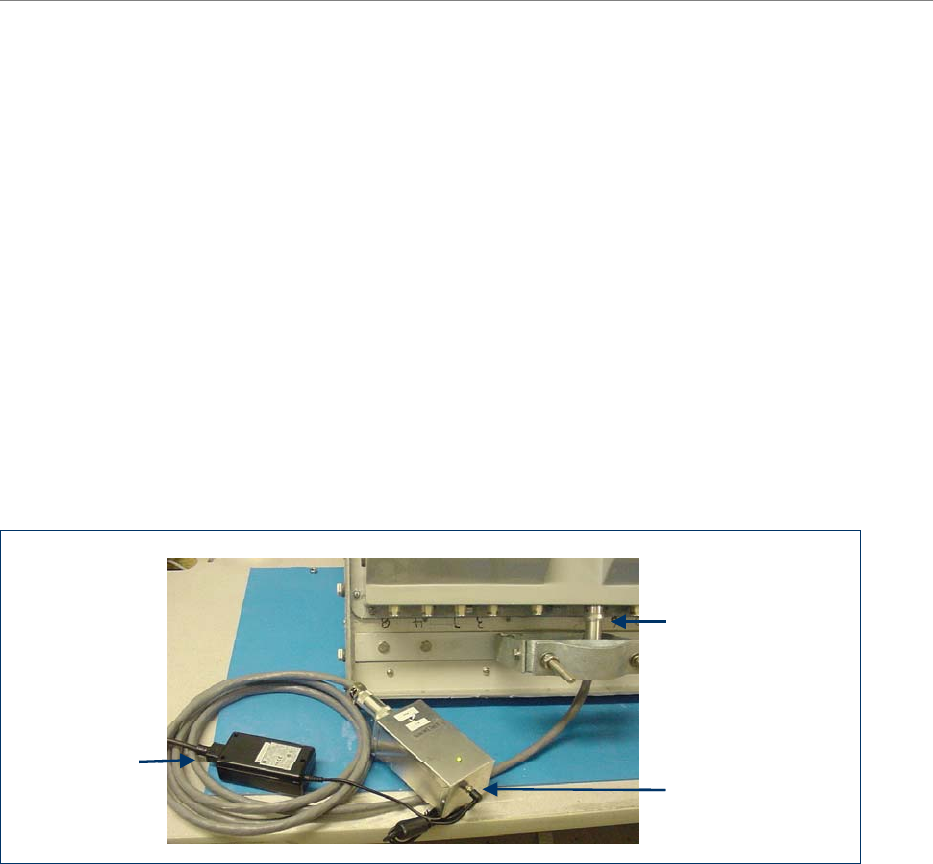
Ripwave Base Station I&C Guide Navini Networks, Inc.
142 Part #40-00047-00 Rev D v1.0
February 28, 2003
RFS Test Box Setup
Step 1. For RFS only testing, connect the power/data test cable to the data connector on the
RFS and to the RFS Test Box.
OR
For RFS and cable testing, connect the installation power/data cable to the data
connector on the RFS and to the RFS Test Box.
Refer to Figure C6.
Step 2. Connect the RFS Test Box power supply to the RFS Test Box.
Step 3. Plug the RFS Test Box power supply into a 110 VAC outlet.
Figure C6: RFS Only Testing Setup
RFS Only Transmit Verification
Ensure that the calibration of the test setup and RFS Test Box setup for RFS Only has been
performed each time the test frequency is changed. Refer to Figure C7.
Step 1. Switch the RFS Test Box to the transmit (Tx) mode.
Step 2. Connect the cable from the Spectrum Analyzer to the RFS cal connector. Use a barrel
connector to change the gender, if required.
Step 3. Connect the cable from the Signal Generator to the RFS antenna input number 1. Use a
barrel connector to change the gender, if required.
Power/Data cable
connected to the RFS
RFS Test Box
RFS Test Box
power supply
Power/Data cable
connected to the RFS
RFS Test Box
RFS Test Box
power supply
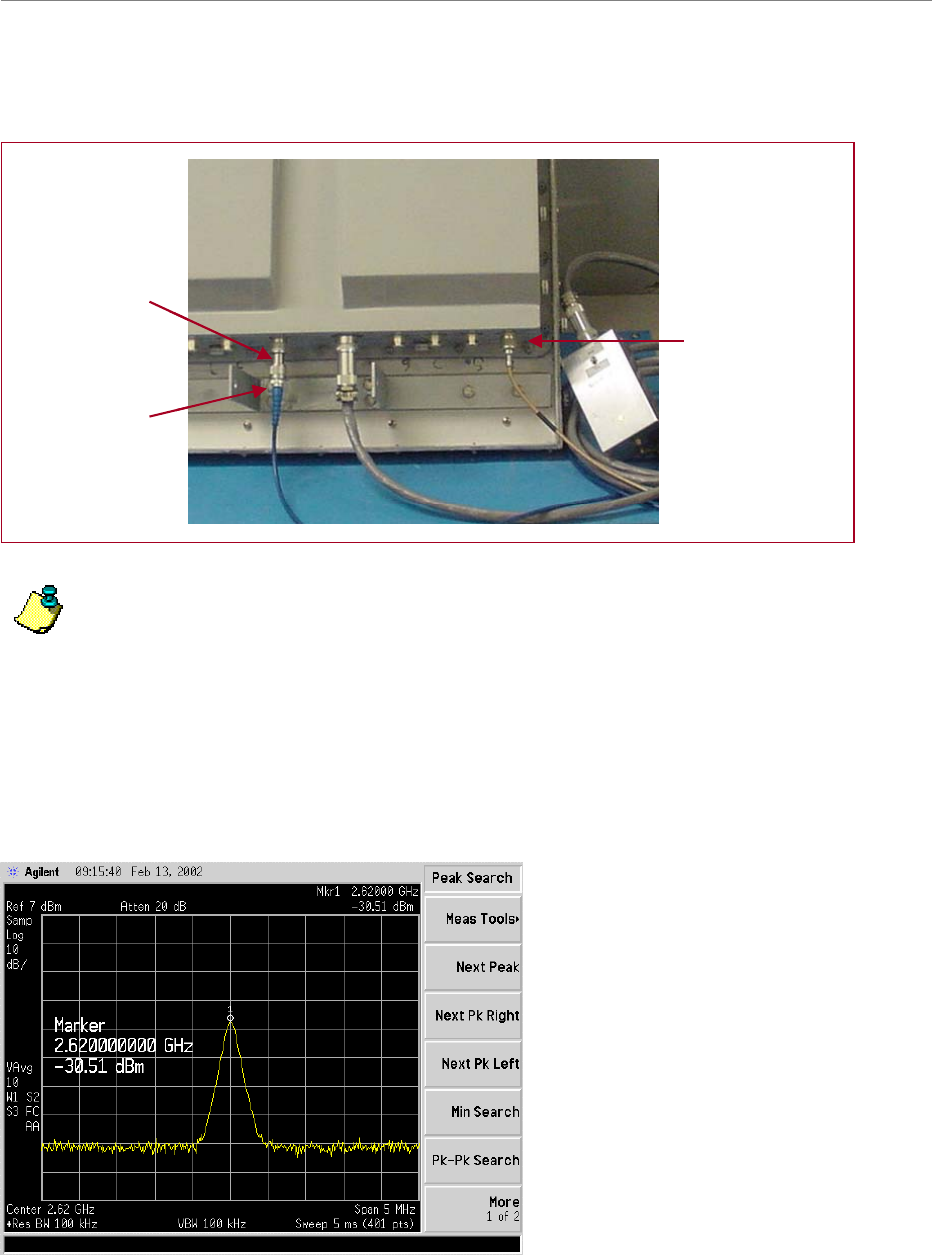
Navini Networks, Inc. Ripwave Base Station I&C Guide
Part #40-00047-00 Rev D v1.0 143
February 28, 2003
Figure C7: RFS Only Tx Verification
Note: The position of the RFS will vary the sweep results due to reflections from the test
surface.
Step 4. Take a marker measurement on the Spectrum Analyzer by using the ‘marker to peak’
or the ‘peak search’ function. The screen on the Spectrum Analyzer should look similar
to the one shown in Figure C8.
Figure C8: RFS Only Tx Marker Measurement Example
Barrel connector
Signal Generator
cable to RFS
antenna 1 connector
Spectrum Analyzer
cable to RFS cal
connector
Barrel connector
Signal Generator
cable to RFS
antenna 1 connector
Spectrum Analyzer
cable to RFS cal
connector
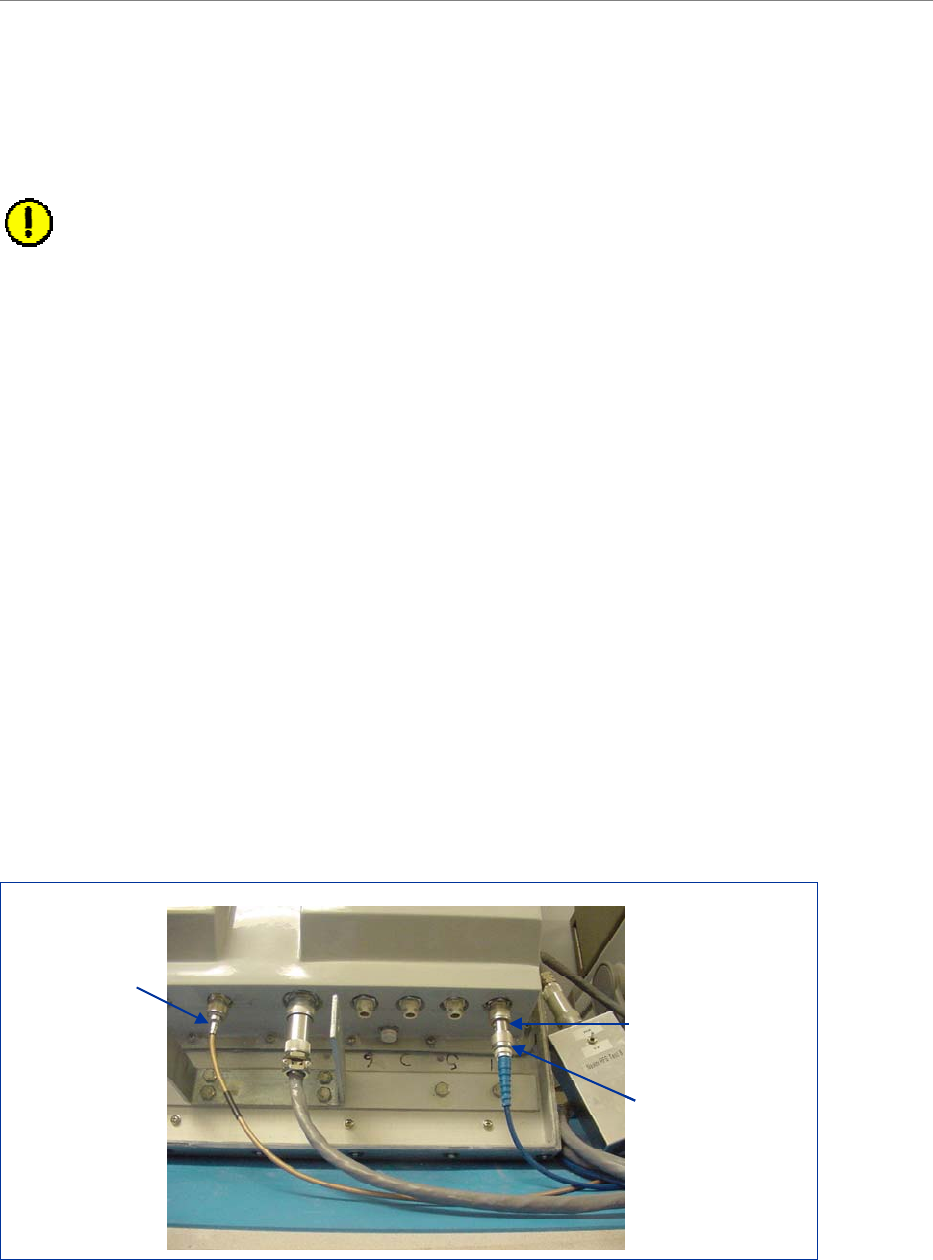
Ripwave Base Station I&C Guide Navini Networks, Inc.
144 Part #40-00047-00 Rev D v1.0
February 28, 2003
Step 5. The marker value should be equal to the RFS Only Tx insertion loss within +/- 2.0 dB,
per the manufacturer’s data. If the insertion loss results do not agree with the
manufacturer’s data, check the test setup.
Caution: An RFS with results greater than the +/- 2.0 dB limits should not be installed,
as a potential hardware fault exists. Contact Navini Networks Technical Support.
Step 6. Record the data in the RFS System Test Form under “RFS TX PATH LOSS (RFS
ONLY)”. Ensure that the information is recorded under the channel number of the RFS
antenna that is being tested.
Step 7. Repeat steps 5 and 6 for the remaining seven antenna inputs on the RFS.
Step 8. Change the frequency to the next test frequency (refer back to Test Setup). Perform
steps 1 – 8 until the RFS has been successfully tested at the frequencies shown in Table
C5.
RFS Only Receive Verification
Step 1. Ensure calibration of the test setup and RFS Test Box setup for RFS Only has been
performed each time the test frequency is changed.
Step 2. Switch the RFS Test Box to the Receive (Rx) mode.
Step 3. Connect the cable from the Signal Generator to the RFS cal connector. Use a barrel
connector to change the gender, if required.
Step 4. Connect the cable from the Spectrum Analyzer to the RFS antenna input number 1.
Use a barrel connector to change the gender, if required. See Figure C9.
Figure C9: RFS Only Rx Verification
Signal Generator
cable to RFS cal
connector
Barrel connector
Spectrum Analyzer
cable to RFS antenna
1 connector
Signal Generator
cable to RFS cal
connector
Barrel connector
Spectrum Analyzer
cable to RFS antenna
1 connector
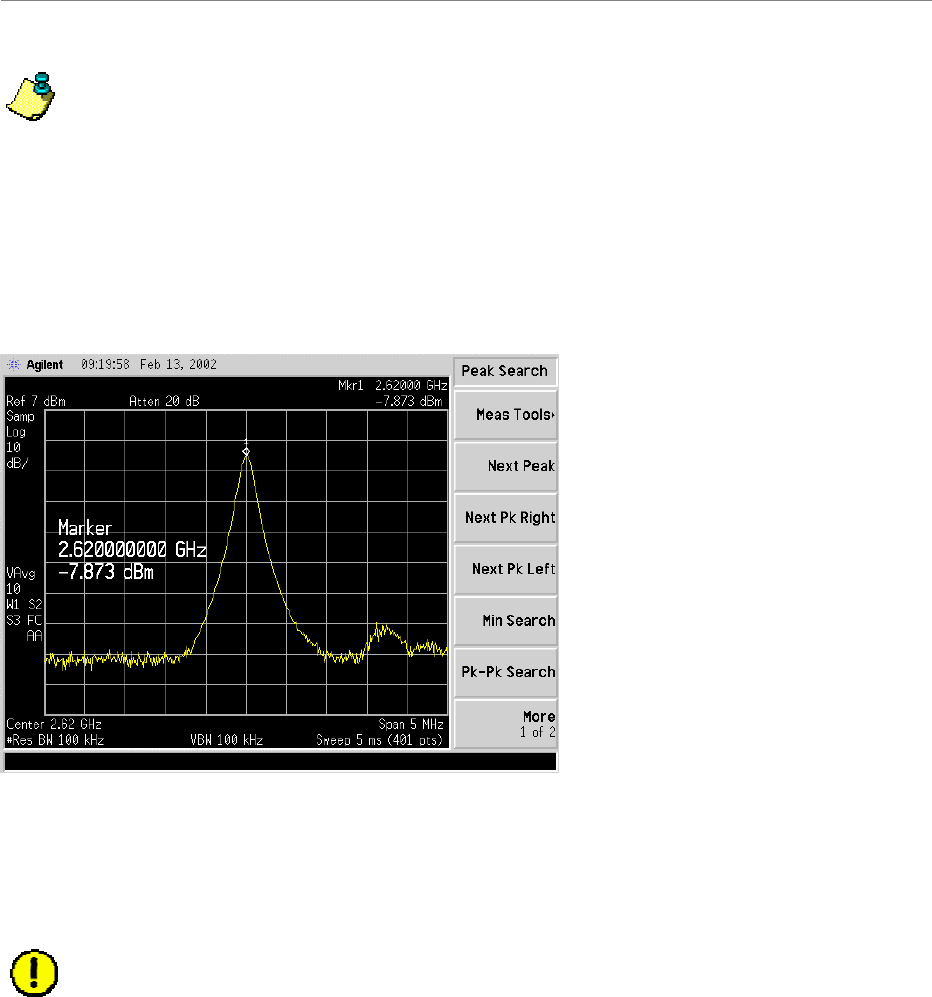
Navini Networks, Inc. Ripwave Base Station I&C Guide
Part #40-00047-00 Rev D v1.0 145
February 28, 2003
Note: The position of the RFS will vary the sweep results due to reflections from the test
surface.
Step 5. Take a marker measurement on the Spectrum Analyzer by using the ‘marker to peak’
or the ‘peak search’ function. The screen on the Spectrum Analyzer should look similar
to the one shown in Figure C10.
Figure C10: RFS Only Rx Marker Measurement Example
Step 6. The marker value should be equal to the RFS Only Rx insertion loss within +/- 2.0 dB,
per the manufacturer’s data. If the insertion loss results do not agree with the
manufacturer’s data, check the test setup.
Caution: An RFS with results greater than the +/- 2.0 dB limits should not be installed,
as a potential hardware fault exists. Contact Navini Networks Technical Support.
Step 7. Record the data in the RFS System Test Form under “RFS RX PATH LOSS (RFS
ONLY)”. Ensure that the information is recorded under the channel number that is on
the RFS antenna that is being tested.
Step 8. Repeat steps 5 through 7 for the remaining seven antenna inputs on the RFS.
Step 9. Change the frequency to the next test frequency (refer back to Test Setup). Perform
steps 1 – 8 until the RFS has been successfully tested at the frequencies shown in Table
C5.
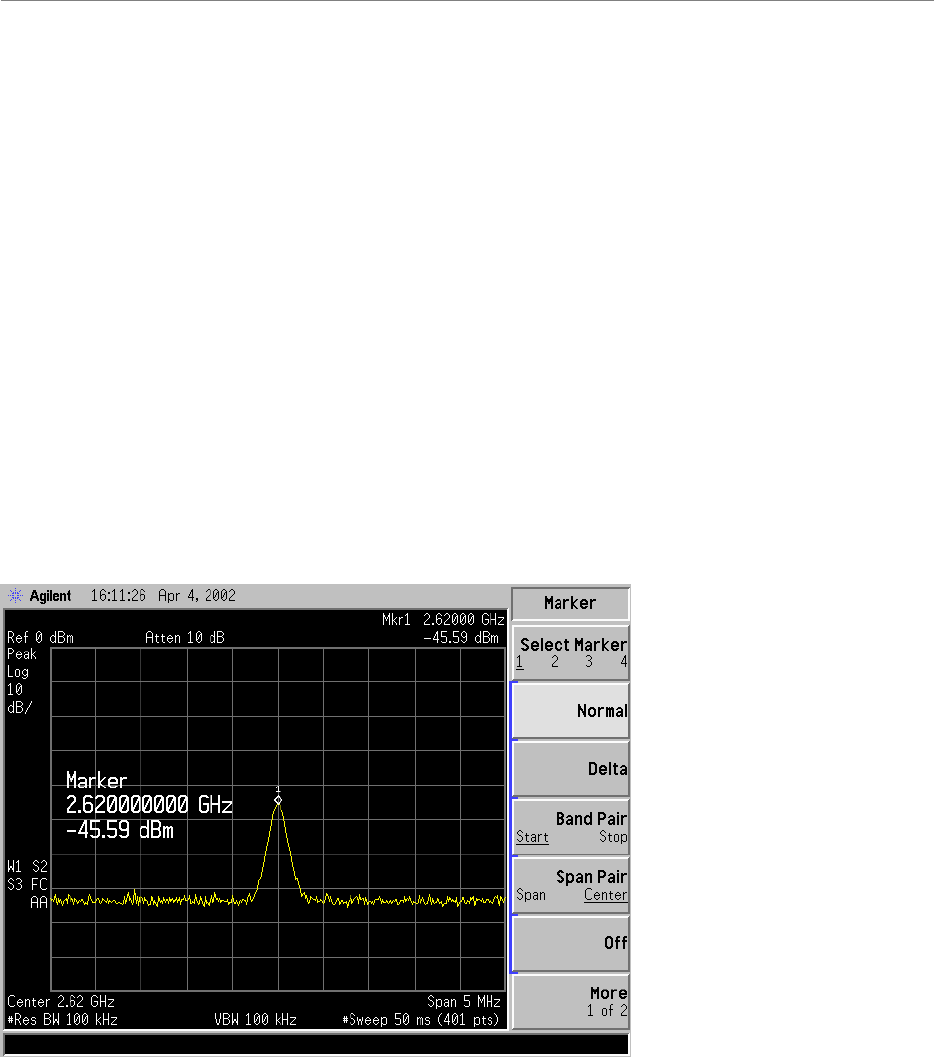
Ripwave Base Station I&C Guide Navini Networks, Inc.
146 Part #40-00047-00 Rev D v1.0
February 28, 2003
RFS & Cables Transmit Verification
This test is performed after the RFS is installed and the antenna cables, calibration cable, and
power/data cable are connected to the inputs on the RFS.
Step 1. Ensure calibration of the test setup and RFS Test Box setup for RFS and cables has
been performed each time the test frequency is changed.
Step 2. Switch the RFS Test Box to the Transmit (Tx) mode.
Step 3. Connect the cable from the Spectrum Analyzer to the RFS calibration cable connector.
Use a barrel connector to change the gender, if required.
Step 4. Connect the cable from the Signal Generator to the RFS antenna cable number 1
connector. Use a barrel connector to change the gender, if required.
Step 5. Take a marker measurement on the Spectrum Analyzer by using the ‘marker to peak’
or the ‘peak search’ function. The screen on the Spectrum Analyzer should look similar
to the one shown in Figure C11.
Figure C11: RFS & Cables Tx Marker Measurement Example
Step 6. The marker value should be equal to the RFS Only Tx insertion loss + calibration cable
loss + antenna cable loss + antenna cable jumper loss. Transmit insertion loss should be
within +/- 2.0 dB of the sum of the parts. If the insertion loss results do not agree with
the manufacturer’s data, check the test setup and the cable connections.
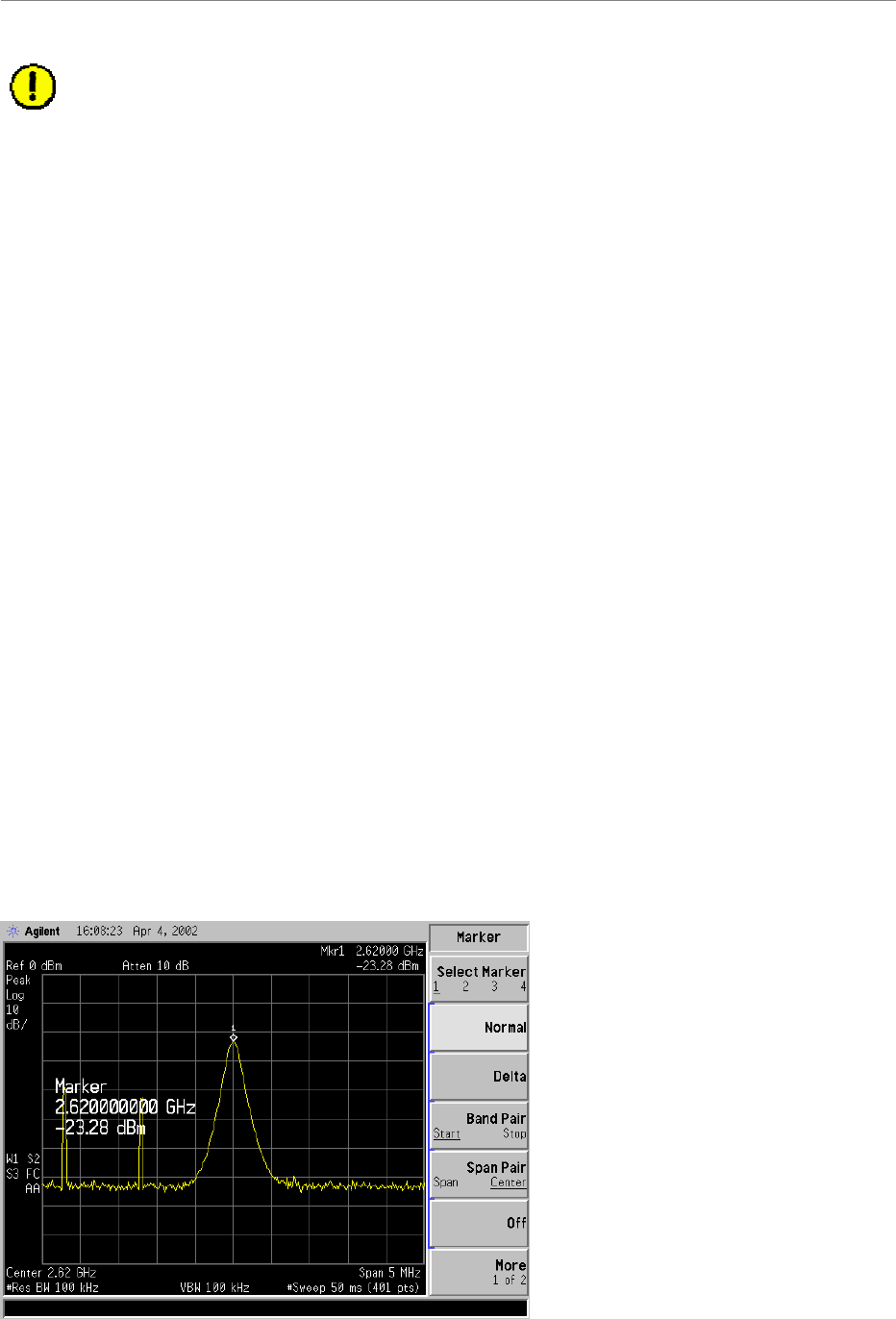
Navini Networks, Inc. Ripwave Base Station I&C Guide
Part #40-00047-00 Rev D v1.0 147
February 28, 2003
Caution: If RFS & cables test results are greater than the +/- 2.0 dB limits, they should
not be installed on a tower, as a potential hardware fault exists. Verify the connections
and contact Navini Networks Technical Support.
Step 7. Record the data in the RFS System Test Form under “TOTAL TX PATH LOSS
(CABLE-RFS)”. Ensure that the information is recorded under the channel number that
is on the cable label.
Step 8. Repeat steps 5 through 7 for the remaining seven antenna cable inputs on the RFS.
Step 9. Change the frequency to the next test frequency (refer to Test Setup). Perform steps 1-8
until the RFS has been successfully tested at the frequencies shown in Table C5.
RFS & Cables Receive Verification
This test is performed after the RFS is installed and the antenna cables, calibration cable, and
power/data cable are connected to the inputs on the RFS.
Step 1. Ensure that the calibration of the test setup and RFS Test Box setup for RFS and cables
has been performed each time the test frequency is changed.
Step 2. Switch the RFS Test Box to the Receive (Rx) mode.
Step 3. If present, remove the barrel connector from between the Signal Generator and
Spectrum Analyzer cables.
Step 4. Connect the cable from the Signal Generator to the RFS calibration cable connector.
Use a barrel connector to change the gender, if required.
Step 5. Connect the cable from the Spectrum Analyzer to the RFS antenna cable number 1
connector. Use a barrel connector to change the gender, if required.
Step 6. Take a marker measurement on the Spectrum Analyzer by using the ‘marker to peak’
or the ‘peak search’ function. The screen on the Spectrum Analyzer should look similar
to the one shown in Figure C12.
Figure C12: RFS & Cables Rx Marker Measurement Example

Ripwave Base Station I&C Guide Navini Networks, Inc.
148 Part #40-00047-00 Rev D v1.0
February 28, 2003
Step 7. The marker value should be equal to the RFS Only RX Insertion Loss + Calibration
Cable Loss + Antenna Cable Loss + Antenna Cable Jumper Loss. RX Insertion Loss
should be within +/- 2.0 dB of the sum of the parts. If the Insertion Loss results do not
agree with the manufacturers data, check the test setup and the cable connections.
Caution: If RFS & cables test results are greater than the +/- 2.0 dB limits, they should
not be installed on a tower, as a potential hardware fault exists. Verify connections and
contact Navini Networks Technical Support.
Step 8. Record the data in the RFS System Test Form under “TOTAL RX PATH LOSS
(CABLE-RFS)”. Ensure that the information is recorded under the channel number that
is on the cable label.
Step 9. Repeat steps 5 through 8 for the remaining seven antenna cable inputs on the RFS.
Step 10. Change the frequency to the next test frequency (refer to Test Setup). Perform steps 1-9
until the RFS has been successfully tested at the frequencies given in Table C5.

Navini Networks, Inc. Ripwave Base Station I&C Guide
Part #40-00047-00 Rev D v1.0 149
February 28, 2003
2.4 RFS System Test Form
RFS SN
NAME
DATE
MEASUREMENT DESCRIPTION CHANNEL
RFS TX PATH LOSS (RFS ONLY) 1 - - - - 0.00
RFS TX PATH LOSS (RFS ONLY) 2 - - - - 0.00
RFS TX PATH LOSS (RFS ONLY) 3 - - - - 0.00
RFS TX PATH LOSS (RFS ONLY) 4 - - - - 0.00
RFS TX PATH LOSS (RFS ONLY) 5 - - - - 0.00
RFS TX PATH LOSS (RFS ONLY) 6 - - - - 0.00
RFS TX PATH LOSS (RFS ONLY) 7 - - - - 0.00
RFS TX PATH LOSS (RFS ONLY) 8 - - - - 0.00
RFS RX PATH LOSS (RFS ONLY) 1 - - - - 0.00
RFS RX PATH LOSS (RFS ONLY) 2 - - - - 0.00
RFS RX PATH LOSS (RFS ONLY) 3 - - - - 0.00
RFS RX PATH LOSS (RFS ONLY) 4 - - - - 0.00
RFS RX PATH LOSS (RFS ONLY) 5 - - - - 0.00
RFS RX PATH LOSS (RFS ONLY) 6 - - - - 0.00
RFS RX PATH LOSS (RFS ONLY) 7 - - - - 0.00
RFS RX PATH LOSS (RFS ONLY) 8 - - - - 0.00
JUMPER LOSS 1 - - - - 0.00
JUMPER LOSS 2 - - - - 0.00
JUMPER LOSS 3 - - - - 0.00
JUMPER LOSS 4 - - - - 0.00
JUMPER LOSS 5 - - - - 0.00
JUMPER LOSS 6 - - - - 0.00
JUMPER LOSS 7 - - - - 0.00
JUMPER LOSS 8 - - - - 0.00
JUMPER LOSS CAL - - - - 0.00
MAIN FEEDER LOSS 1 - - - - 0.00
MAIN FEEDER LOSS 2 - - - - 0.00
MAIN FEEDER LOSS 3 - - - - 0.00
MAIN FEEDER LOSS 4 - - - - 0.00
MAIN FEEDER LOSS 5 - - - - 0.00
MAIN FEEDER LOSS 6 - - - - 0.00
MAIN FEEDER LOSS 7 - - - - 0.00
MAIN FEEDER LOSS 8 - - - - 0.00
MAIN FEEDER LOSS CAL - - - - 0.00
TOTAL CABLE RUN LOSS 1 - 0.00 - 0.00 - 0.00 - 0.00
TOTAL CABLE RUN LOSS 2 - 0.00 - 0.00 - 0.00 - 0.00
TOTAL CABLE RUN LOSS 3 - 0.00 - 0.00 - 0.00 - 0.00
TOTAL CABLE RUN LOSS 4 - 0.00 - 0.00 - 0.00 - 0.00
TOTAL CABLE RUN LOSS 5 - 0.00 - 0.00 - 0.00 - 0.00
TOTAL CABLE RUN LOSS 6 - 0.00 - 0.00 - 0.00 - 0.00
TOTAL CABLE RUN LOSS 7 - 0.00 - 0.00 - 0.00 - 0.00
TOTAL CABLE RUN LOSS 8 - 0.00 - 0.00 - 0.00 - 0.00
TOTAL CABLE RUN LOSS CAL - 0.00 - 0.00 - 0.00 - 0.00
TOTAL TX PATH LOSS (CABLE-RFS) 1 - - - - 0.00
TOTAL TX PATH LOSS (CABLE-RFS) 2 - - - - 0.00
TOTAL TX PATH LOSS (CABLE-RFS) 3 - - - - 0.00
TOTAL TX PATH LOSS (CABLE-RFS) 4 - - - - 0.00
TOTAL TX PATH LOSS (CABLE-RFS) 5 - - - - 0.00
TOTAL TX PATH LOSS (CABLE-RFS) 6 - - - - 0.00
TOTAL TX PATH LOSS (CABLE-RFS) 7 - - - - 0.00
TOTAL TX PATH LOSS (CABLE-RFS) 8 - - - - 0.00
TOTAL RX PATH LOSS (CABLE-RFS) 1 - - - - 0.00
TOTAL RX PATH LOSS (CABLE-RFS) 2 - - - - 0.00
TOTAL RX PATH LOSS (CABLE-RFS) 3 - - - - 0.00
TOTAL RX PATH LOSS (CABLE-RFS) 4 - - - - 0.00
TOTAL RX PATH LOSS (CABLE-RFS) 5 - - - - 0.00
2400MHz 2440MHz 2473MHz AVERAGE
2.4 GHz RFS INSTALL
TEST RESULT FORM
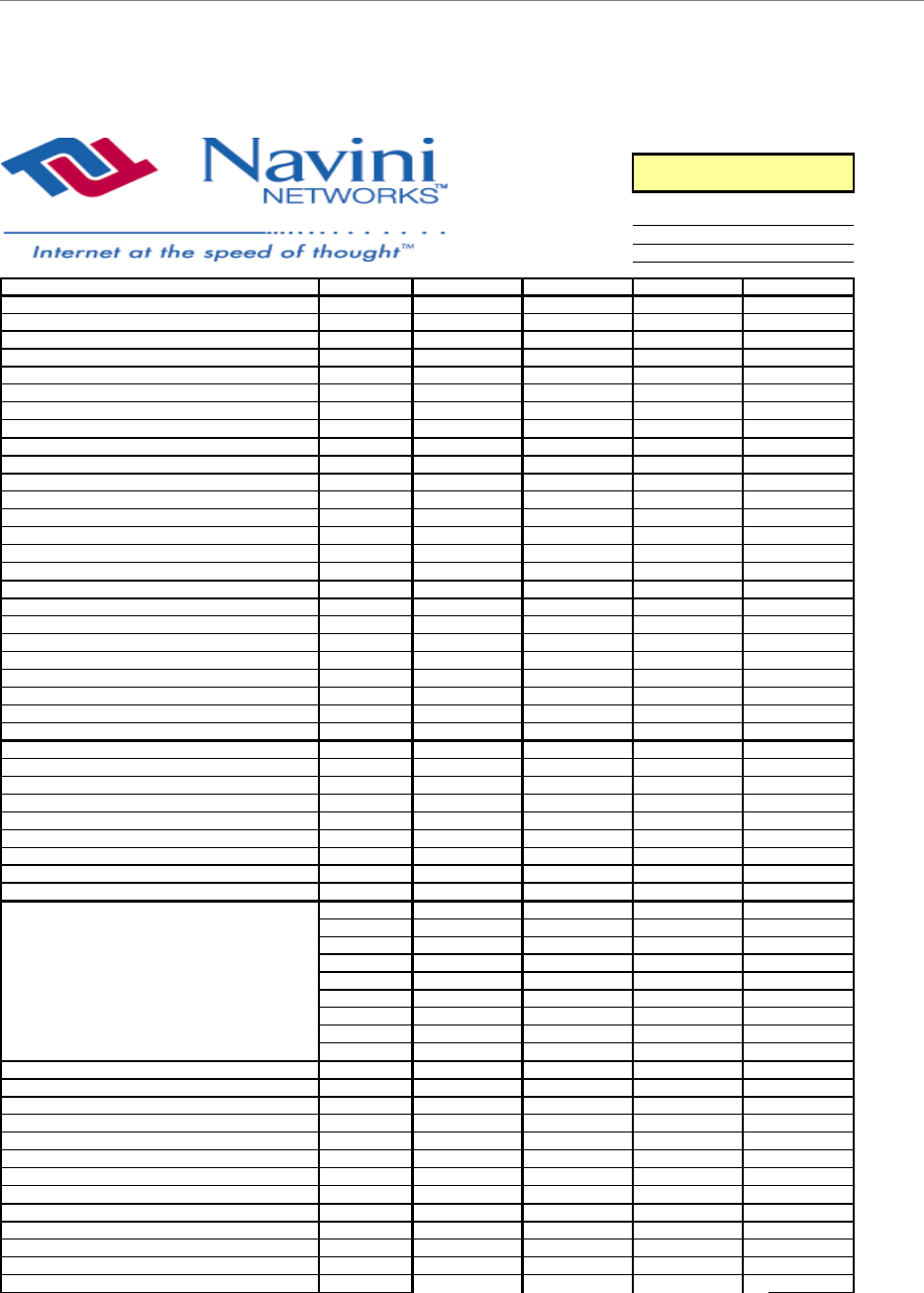
Ripwave Base Station I&C Guide Navini Networks, Inc.
150 Part #40-00047-00 Rev D v1.0
February 28, 2003
2.6 RFS System Test Form
RFS SN
NAME
DATE
MEASUREMENT DESCRIPTION CHANNEL
RFS TX PATH LOSS (RFS ONLY) 1 - - - - 0.00
RFS TX PATH LOSS (RFS ONLY) 2 - - - - 0.00
RFS TX PATH LOSS
(
RFS ONLY
)
3- - - -0.00
RFS TX PATH LOSS
(
RFS ONLY
)
4- - - -0.00
RFS TX PATH LOSS (RFS ONLY) 5 - - - - 0.00
RFS TX PATH LOSS (RFS ONLY) 6 - - - - 0.00
RFS TX PATH LOSS
(
RFS ONLY
)
7- - - -0.00
RFS TX PATH LOSS (RFS ONLY) 8 - - - - 0.00
RFS RX PATH LOSS (RFS ONLY) 1 - - - - 0.00
RFS RX PATH LOSS (RFS ONLY) 2 - - - - 0.00
RFS RX PATH LOSS (RFS ONLY) 3 - - - - 0.00
RFS RX PATH LOSS
(
RFS ONLY
)
4- - - -0.00
RFS RX PATH LOSS
(
RFS ONLY
)
5- - - -0.00
RFS RX PATH LOSS (RFS ONLY) 6 - - - - 0.00
RFS RX PATH LOSS (RFS ONLY) 7 - - - - 0.00
RFS RX PATH LOSS (RFS ONLY) 8 - - - - 0.00
JUMPER LOSS
(
Measured
)
1- - - -0.00
JUMPER LOSS (Measured) 2 - - - - 0.00
JUMPER LOSS (Measured) 3 - - - - 0.00
JUMPER LOSS
(
Measured
)
4- - - -0.00
JUMPER LOSS
(
Measured
)
5- - - -0.00
JUMPER LOSS (Measured) 6 - - - - 0.00
JUMPER LOSS (Measured) 7 - - - - 0.00
JUMPER LOSS (Measured) 8 - - - - 0.00
JUMPER LOSS (Measured) CAL - - - - 0.00
MAIN FEEDER LOSS
(
Measured
)
1- - - -0.00
MAIN FEEDER LOSS (Measured) 2 - - - - 0.00
MAIN FEEDER LOSS (Measured) 3 - - - - 0.00
MAIN FEEDER LOSS
(
Measured
)
4- - - -0.00
MAIN FEEDER LOSS
(
Measured
)
5- - - -0.00
MAIN FEEDER LOSS (Measured) 6 - - - - 0.00
MAIN FEEDER LOSS (Measured) 7 - - - - 0.00
MAIN FEEDER LOSS (Measured) 8 - - - - 0.00
MAIN FEEDER LOSS (Measured) CAL - - - - 0.00
TOTAL CABLE RUN LOSS (Measured) 1 - 0.00 - 0.00 - 0.00 - 0.00
TOTAL CABLE RUN LOSS (Measured) 2 - 0.00 - 0.00 - 0.00 - 0.00
TOTAL CABLE RUN LOSS (Measured) 3 - 0.00 - 0.00 - 0.00 - 0.00
TOTAL CABLE RUN LOSS
(
Measured
)
4 - 0.00 - 0.00 - 0.00 - 0.00
TOTAL CABLE RUN LOSS
(
Measured
)
5 - 0.00 - 0.00 - 0.00 - 0.00
TOTAL CABLE RUN LOSS (Measured) 6 - 0.00 - 0.00 - 0.00 - 0.00
TOTAL CABLE RUN LOSS (Measured) 7 - 0.00 - 0.00 - 0.00 - 0.00
TOTAL CABLE RUN LOSS (Measured) 8 - 0.00 - 0.00 - 0.00 - 0.00
TOTAL CABLE RUN LOSS (Measured) CAL - 0.00 - 0.00 - 0.00 - 0.00
TOTAL TX PATH LOSS (CABLE-RFS) 1 - - - - 0.00
TOTAL TX PATH LOSS (CABLE-RFS) 2 - - - - 0.00
TOTAL TX PATH LOSS (CABLE-RFS) 3 - - - - 0.00
TOTAL TX PATH LOSS
(
CABLE-RFS
)
4- - - -0.00
TOTAL TX PATH LOSS
(
CABLE-RFS
)
5- - - -0.00
TOTAL TX PATH LOSS (CABLE-RFS) 6 - - - - 0.00
TOTAL TX PATH LOSS (CABLE-RFS) 7 - - - - 0.00
TOTAL TX PATH LOSS (CABLE-RFS) 8 - - - - 0.00
TOTAL RX PATH LOSS
(
CABLE-RFS
)
1- - - -0.00
TOTAL RX PATH LOSS (CABLE-RFS) 2 - - - - 0.00
TOTAL RX PATH LOSS (CABLE-RFS) 3 - - - - 0.00
TOTAL RX PATH LOSS (CABLE-RFS) 4 - - - - 0.00
TOTAL RX PATH LOSS
(
CABLE-RFS
)
5- - - -0.00
2.6 GHz RFS INSTALL
TEST RESULT FORM
AVERAGE
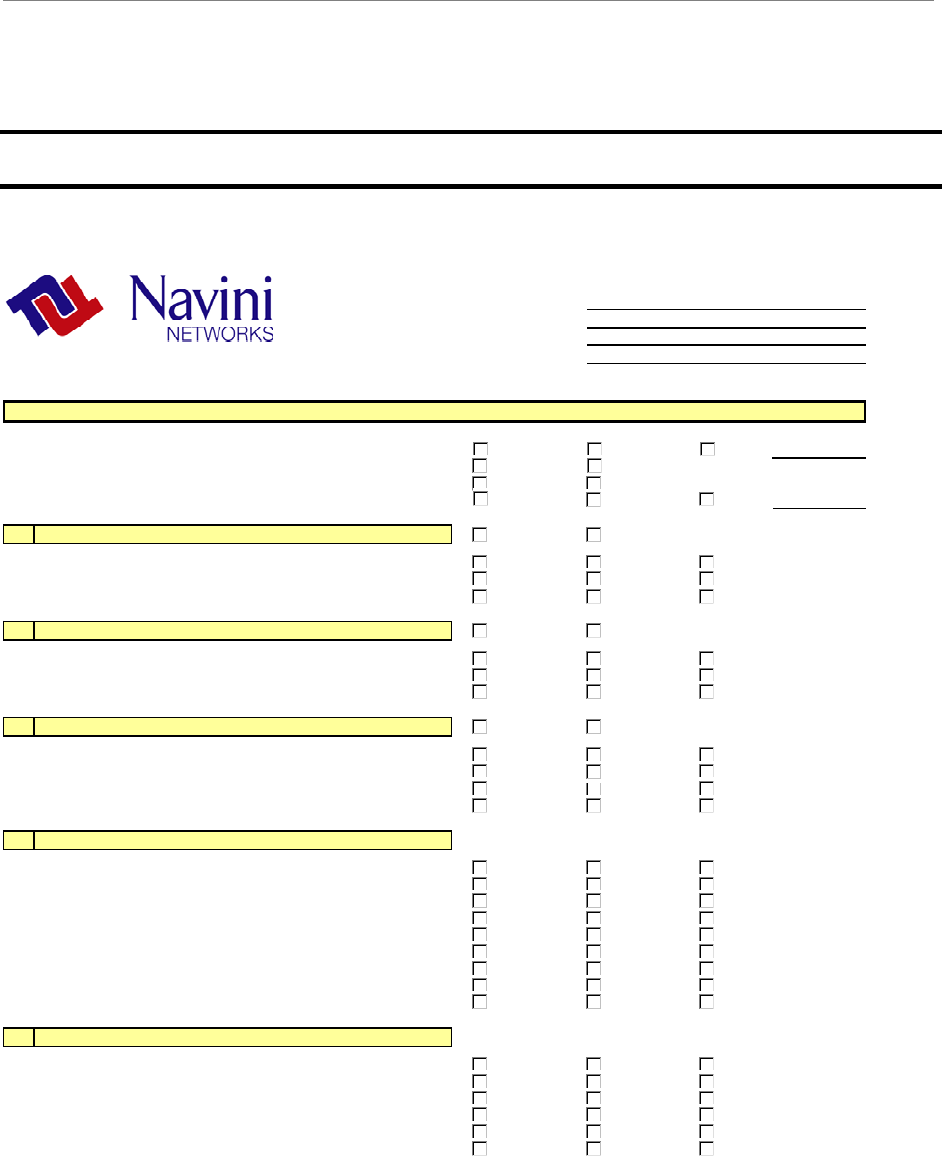
Navini Networks, Inc. Ripwave Base Station I&C Guide
Part #40-00047-00 Rev D v1.0 151
February 28, 2003
Appendix D: Base Station Installation Certification
COMPANY
SITE NAME
SITE NO
LOCATION
SITE TYPE
ANTENNA TYPE
FREQUENCY BAND
BTS ENCLOSURE
A
1 Equipment Installed and Secured Per Plan
2 Roof/Ceiling/Wall Penetrations Patched, Sealed and Painted
3 Penetration(s) Inspected by Landowner Representative
B
1 Equipment Installed and Secured Per Plan
2 Structural Upgrades to Roof Installed Per Plan
3 Equipment Support Frame Installed
C
1 Equipment Installed and Secured Per Plan
2 Special Inspection for Foundation Steel Complete
3 Concrete Placed and Vibrated
4 Concrete Break Test Report Complete
D
1 Fencing Complete (Tie-In to Ground System) Per Plan
2 Gravel/Crushed Rock Placed over Weed Barrie
r
3 Above Ground Conduits Installed Plumb
4 Landscaping/ Erosion Control Complete Per Plan
5 Access Road Complete Per Plan
6 All Trash and Debris Hauled Off Site
7 Site Area restored to Original Condition
8 Unistruts, iron angles and Rods properly cold galvanized
9 RF Safety Signage Installed where Required
E
1 Monopole/Tower Plumb, Torqued and Free of Visible Defects
2 Orientation of Monopole/Tower Per Plan
3 Safety Climb Installed and Tensioned per Manufacturer Spec.
4 Weep Hole Free of Obstructions
5 Step Bolts Installed/ Removed Below 30 feet
6 Monopole/Tower Tie-In to Ground Ring Complete
BASE STATION INSTALLATION CHECKLIST 40-00092-00
Equipment Installed in Building
Equipment Installed on Roof
Equipment Installed on Grade
Civil/Site Work
Monopole/Tower
YES NO
N/AYES NO
N/AYES NO
N/AYES NO
YES NO
N/AYES NO
N/AYES NO
N/AYES NO
YES NO
N/AYES NO
N/AYES
N/AYES NO
N/AYES NO
NO
N/AYES NO
N/AYES NO
N/AYES NO
N/AYES NO
N/AYES NO
N/AYES NO
N/AYES NO
N/AYES NO
N/AYES NO
N/AYES NO
N/AYES NO
N/AYES NO
N/AYES NO
N/AYES NO
N/AYES NO
MONOPOLE CO-LOCATE
OMNI SECTORIZED
2.4GHz 2.6GHz
IND O O R OUTDOOR
OTHER
OTHER
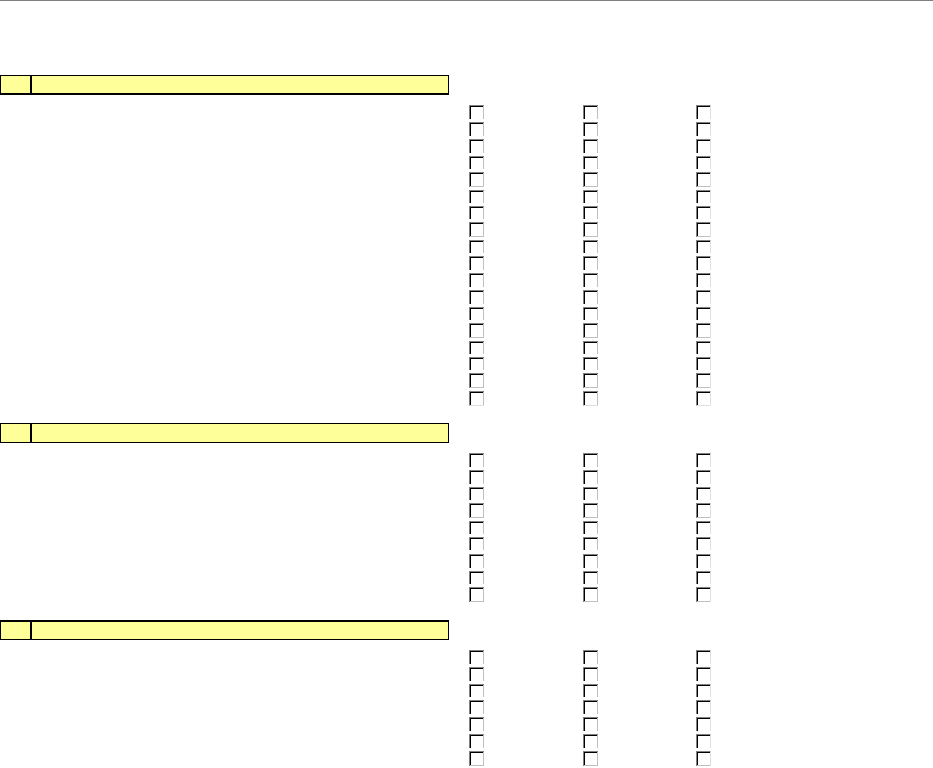
Ripwave Base Station I&C Guide Navini Networks, Inc.
152 Part #40-00047-00 Rev D v1.0
February 28, 2003
F
1 Monopole/Tower Grounding Installed
2 Ground Wire Types and Size meet construction Specs
3 Lightning Rod Provided and Installed Per Plan
4 5 Ohm Megger Ground Resistance Test Complete
5 Buss Bars Installed Per Plan
6 Surge Protector Installed Between RFS Antenna and Cable
7 Coax Ground Kits Installed at RFS Antenna Per Plan
8 Coax Ground Kits Installed at Tower Base Per Plan
9 Coax Ground Kits Installed at Buss Bar Prior to BTS Per Plan
10 Double Lug Connectors Used at All Buss Bar Attachments
11 Cable Tray/Ice Bridge Bonded and Grounded to Buss Bar
12 Surge Protectors Mounted and Secured on ground Buss Ba
r
13 Master Ground Buss Bar Tied-In to Ground Ring
14 Equipment Rack Ground Per Plan
15 Power Supply/UPS, Rectifier Ground Per Plan
16 Meter and Telco box Ground Per Plan
17 Fence Work Grounded Per Plan
18 Additional Equipment Tied-In to BTS properly Grounded
G
1 Power and Telco Conduits Installed Per Plan
2 Conduits Are Labeled and Pull Strings are Provided
3 Meter and Telco Box are Installed Per Plan
4 Circuit Breakers Installed and Properly Labeled
5 UPS Installed and All Internal Connections Made
6 Rectifier Installed, Output and Wiring to BTS Checked
7 Telco Tie-In to Source, Tested and Complete
8 Network/Telco Tie-In to BTS, Tested and Complete
9 EMS Installed and Connected to Network
H
1 Cabinet is Positioned, Secured and Leveled Per Plan
2 Cabinet Outer Surfaces Free from scratches, dents, corrosion
3 All Hardware Connections within BTS are tightened/secured
4 RF/GPS Coax Connectors Securely Connected to BTS
5 Signal/Power Cable Securely Connected to BTS
6 Ethernet/T1 cables Dressed and Secured to BTS
7 Documents, License are Stored or Posted on BTS
BTS System
Grounding
Electrical, Telco and Network
N/AYES NO
N/AYES NO
N/AYES NO
N/AYES NO
N/AYES NO
N/AYES NO
N/AYES NO
N/AYES NO
N/AYES NO
N/AYES NO
N/AYES NO
N/AYES NO
N/AYES NO
N/AYES NO
N/AYES NO
N/AYES NO
N/AYES NO
N/AYES NO
N/AYES NO
N/AYES NO
N/AYES NO
N/AYES NO
N/AYES NO
N/AYES NO
N/AYES NO
N/AYES NO
N/AYES NO N/AYES NO
N/AYES NO
N/AYES NO
N/AYES NO
N/AYES NO
N/AYES NO
N/AYES NO
N/AYES NO
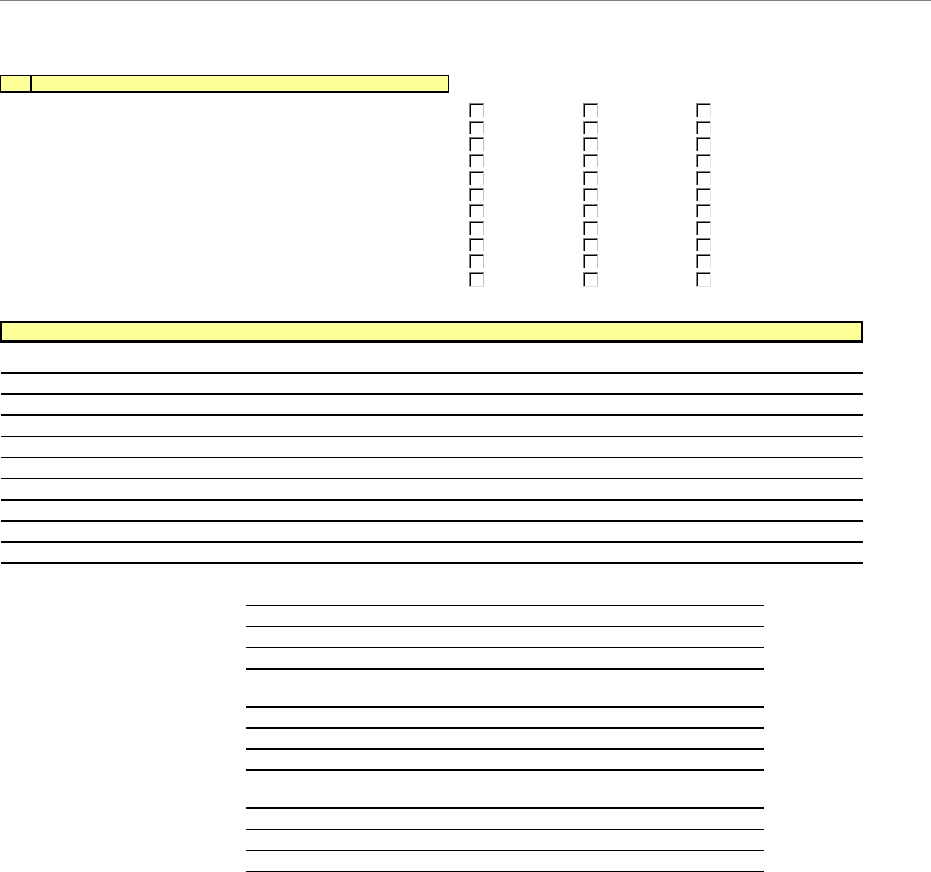
Navini Networks, Inc. Ripwave Base Station I&C Guide
Part #40-00047-00 Rev D v1.0 153
February 28, 2003
J
1 RFS Antenna Height and Orientation Per Plan
2 RFS Antenna Mount Plumb Per Axis
3 GPS Antenna Mounted Per Plan
4 Zinc Cold Galvanizing compound used everywhere
5 Coaxial Cables Run Straight (Not Exceeding Bend Radius)
6 Coaxial Cables Tagged and Color Coded Per Plan
7 Connectors and Jumpers Installed and Weatherproofed
8 Cable Hangers, Bands or Ties Spaced up every 3 Feet
9 Antenna Power and Data Cable Continuity Tested
10 Antenna System Sweep Test Performed and Passed
11 SW and Hard Copy of Antenna Sweep Test Results Provided
Printed Name
Signature / Date
Company
Phone No.
Printed Name
Signature / Date
Company
Phone No.
Printed Name
Signature / Date
Company
Phone No.
NOTES
Antenna and Feeder System
N/AYES NO
N/AYES NO
N/AYES NO
N/AYES NO
N/AYES NO
N/AYES NO
N/AYES NO
N/AYES NO
N/AYES NO
N/AYES NO
N/AYES NO
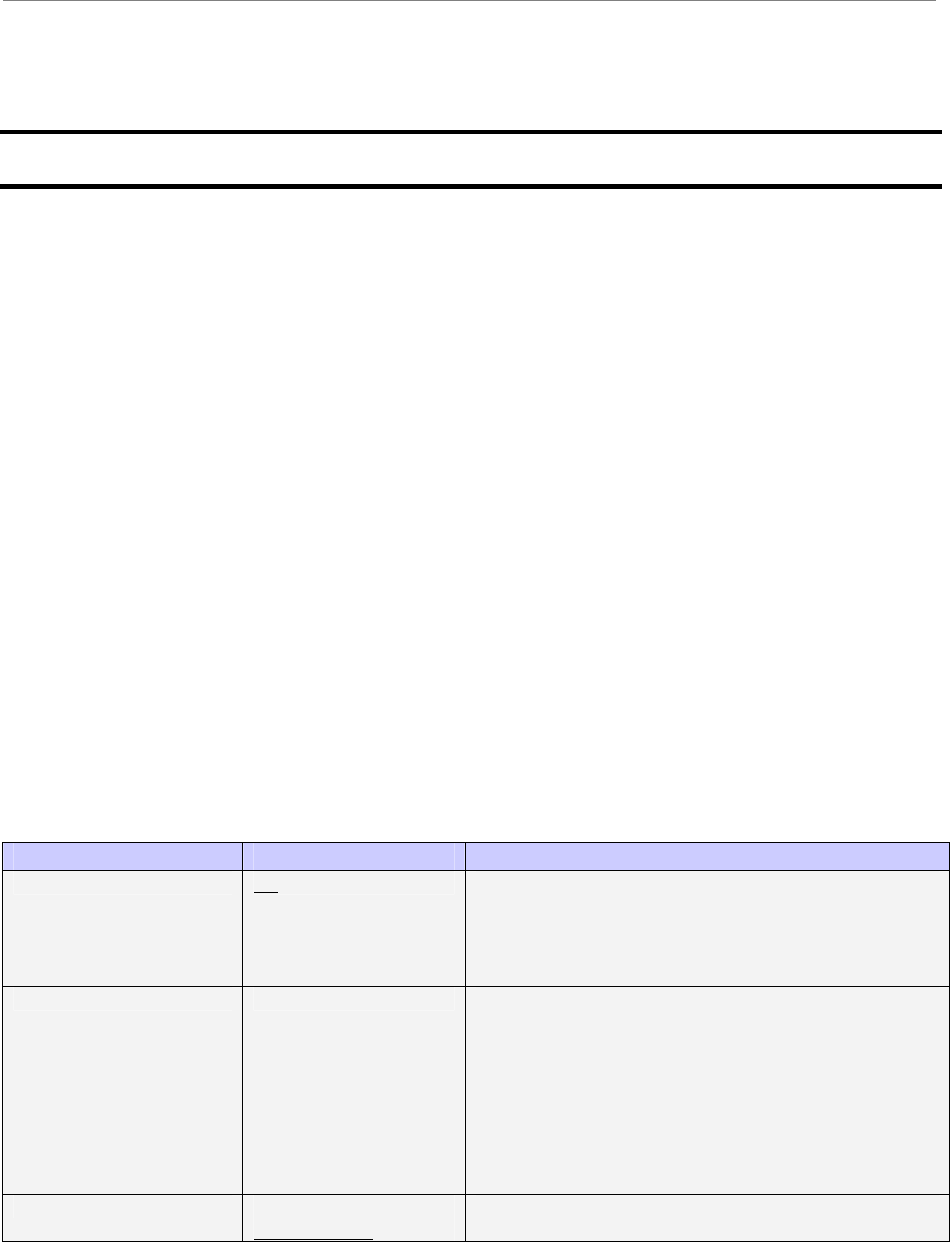
Ripwave Base Station I&C Guide Navini Networks, Inc.
154 Part #40-00047-00 Rev D v1.0
February 28, 2003
Appendix E: Configuration Forms
The configuration forms are used to plan and design the operating parameters for the system. The
parameters for every system element are defined in the EMS Server.
BTS Configuration Form
Company:_________________________________________________________
Your Name:______________________________________ Date:____________
BTS ID/NAME:____________________________________________________
NOTE 1: Field Values in gray rows indicate data that ordinarily should not be changed or that is populated
automatically by the system.
NOTE 2: Default Field Values are underlined.
General Parameters
Status
Field Name Values Description
RF Admin Status Up or Down Determines if the BTS is transmitting Radio Frequency
(RF). Up means transmitting. Down means not
transmitting. To bring the RF Admin Status Up, execute
the Enable action. To bring it Down, execute the Disable
action.
Connected Status True or False Display only. The user cannot set this field. Indicates if
the EMS can communicate with the BTS. The EMS
Server sends a message to the BTS periodically. If the
BTS responds, the EMS sets this field to True. If the BTS
does not respond in a reasonable amount of time, the
EMS changes the Connected Status to false. If the
Connected Status is False, the EMS will not send any
configuration messages to the BTS because it cannot
communicate.
Provisioned Status Provisioned or
Unprovisioned
If Provisioned, the BTS has been configured and is ready
for use.
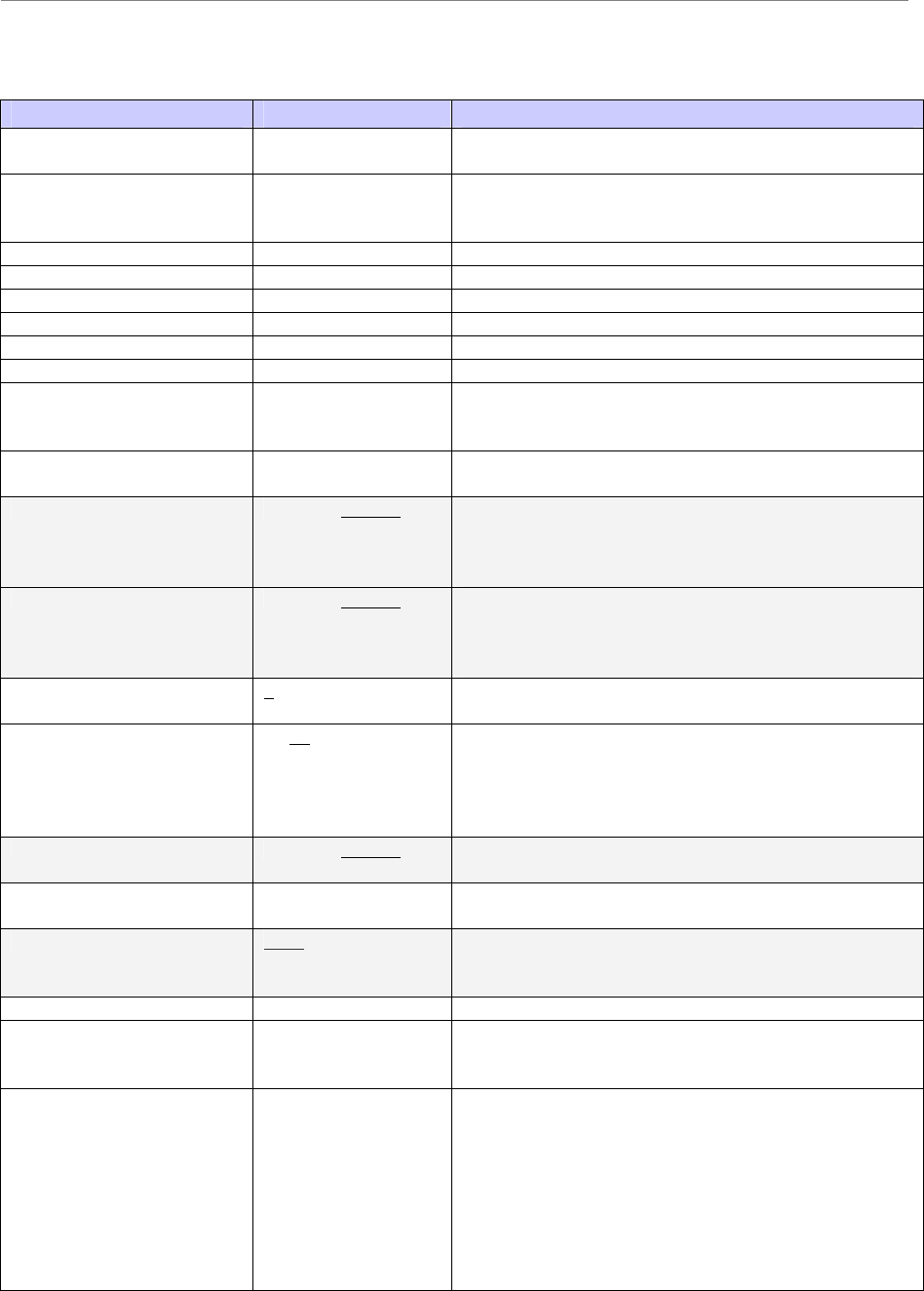
Navini Networks, Inc. Ripwave Base Station I&C Guide
Part #40-00047-00 Rev D v1.0 155
February 28, 2003
IP
Field Name Values Description
BTS IP Address Unique IP address for each BTS. Space bar used to
remove or skip existing digits.
EMS Server IP Address Unique IP address for an EMS. Defaults to the IP on
which the EMS Server is running. Space bar used to
remove or skip existing digits.
BTS Default Gateway Default Gateway used to route IP packets for a BTS.
BTS Subnet Mask Subnet Mask used to route IP packets for a BTS.
Street Address Physical location of this BTS.
City City in which BTS is located.
State State in which BTS is located.
Zip Zip code for location in which BTS is located
BTS ID Unique numeric identification number for this BTS.
Cannot be changed once the BTS is created in the
system.
BTS Name Unique name given to this BTS. No two BTS’s can have
the same name.
Suppress Alarms TRUE or FALSE To suppress alarms from BTS to EMS, set to TRUE until
problem is resolved. Useful if BTS is flooding EMS and
affecting its performance. To allow alarms to be sent, set
to FALSE.
Suppress CPE Registration TRUE or FALSE Determines if BTS can send CPE Registration messages
to EMS. Useful if BTS is flooding EMS and affecting its
performance. To allow messages to be sent, set to
FALSE.
Calibration Interval
(hours)
1 - 24 The interval of hours by which on-line calibration occurs.
Bridge Aging Timer
(minutes)
1 - 60 BTS Bridge Table timer that controls how long a PVC is
assigned to an EID (CPE). The PVC to EID association is
removed when no user traffic is received for the timer
interval. Applicable only when dynamic PVC assignment
is used.
Enable PVC Loopback TRUE or FALSE Determines if any PVC on this BTS can perform
loopback test.
BTS Contact Personnel Textual identification of a contact person for this BTS
and how to contact them.
BTS Configuration Source EMS or BTS Determines where the BTS obtains its configuration data
when reset. If provisioning BTS for first time, set to
EMS. After successful reset, defaults to BTS.
Interface Type Ethernet or ATM Indicates the backhaul to which the BTS is connected.
BTS Profile Type Unlicensed 2.4 GHz
MMDS 2.6 GHz
Select the correct system. 2.4 GHz is the only unlicensed
frequency. Any other system, 2.3, 2.5, and 2.6, select
MMDS.
Frequency 2.305 GHz - 2.359
GHz
2.40 GHz - 2.473
GHz
2.50 GHz - 2.595
GHz
Scroll bar that allows you to set the center frequency for
the BTS operation. The range depends on the type of
system, i.e., 2.3 GHz, 2.4 GHz, 2.5 GHz, 2.6 GHz. The
field is operated by clicking on the center frequency
scroll bar and moving it left or right. The center
frequency of an MMDS band BTS must match what is
hard-wired on the RFS. During installation, the installers
should check that the configured center frequency is
identical to the center fre
q
uenc
y
labeled on the Channel
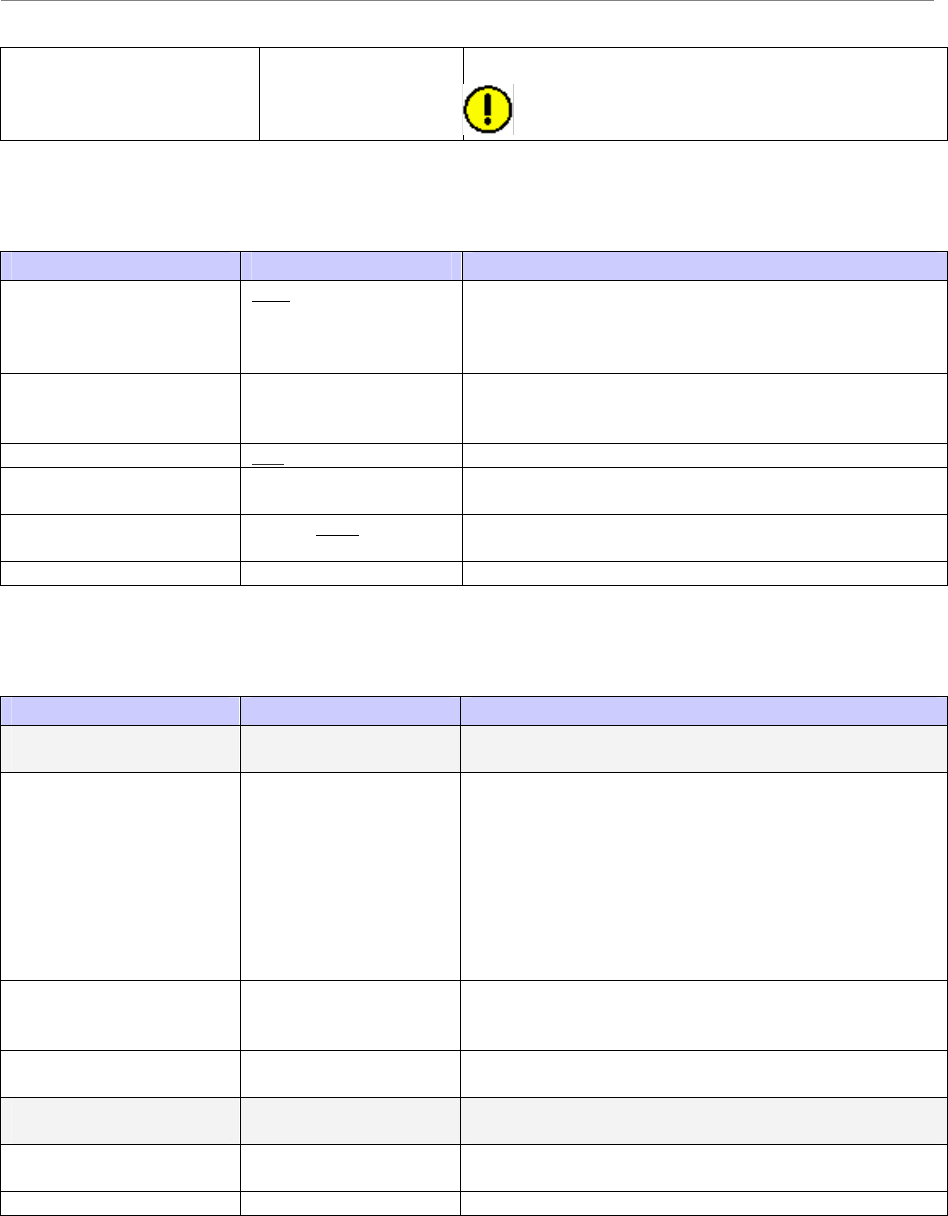
Ripwave Base Station I&C Guide Navini Networks, Inc.
156 Part #40-00047-00 Rev D v1.0
February 28, 2003
2.602 - 2.686 GHz Filter component of the RFS.
CAUTION: Changing an MMDS BTS center
frequency may result in destruction of the PA’s.
Diagnostics
Field Name Values Description
Enable Const Display True or False Determines if the BTS Constellation Display application
can be logged into and used on this BTS. If set to True,
this BTS can be logged into and its Constellation Display
viewed.
Max Beamform Displays 0-9 The maximum number of CPE’s that can be viewed
simultaneously using the BTS Beamforming diagnostic
display.
User Name ems Authorized user of all diagnostic tools.
Password The password used to authenticate the login to all
diagnostic tools.
Enable Spec Analyzer
Display
True or False Determines if the BTS Spectrum Analyzer (frequency)
application can be logged into and used on this BTS.
Confirm Password Confirms that the correct password is entered.
Performance
Field Name Values Description
Perf Log Server IP
Address
IP address of the performance log collection server.
Perf Log Storage
Directory
The name of the directory at the Performance Log server
where the performance logs are to be sent. Note: The
location of the log directory is “<ftp root directory>/<pm
data directory>”. Example: If the FTP root directory is set
to “d:/naviniems/ftp” and the pm data directory is set to
“performance”, the location of the log directory will be
“d:/naviniems/ftp/performance”. Therefore, when
configuring the FTP Daemon, set the FTP root directory
to “<ems install directory>/ftp”.
Upload Interval (minutes
or hours)
Disable, 15 minutes, 30
minutes, 1 hour, 2
hours, etc.
The interval that the BTS uploads performance data to the
EMS.
Collection Interval
(minutes or hours)
Disable, 15 minutes, 30
minutes, 1 hour
The interval that the BTS collects the performance logs.
Perf Log FTP User
Name
The FTP user name set in the FTP Daemon running on
the server where performance logs are captured.
Perf Log FTP Password The FTP password set in the FTP Daemon running on the
server capturing performance logs.
Confirm Password Re-enter password to confirm authorized access.
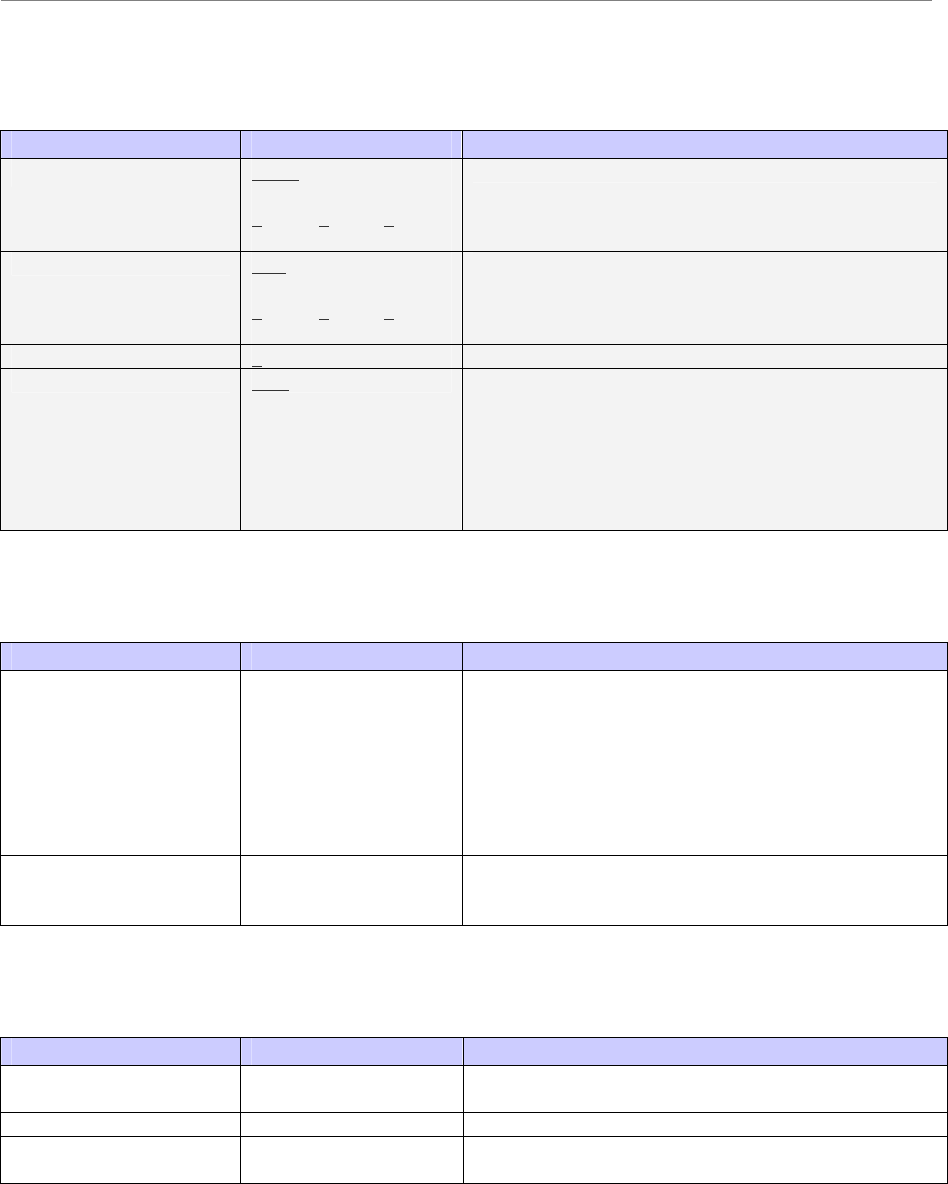
Navini Networks, Inc. Ripwave Base Station I&C Guide
Part #40-00047-00 Rev D v1.0 157
February 28, 2003
GPS
Field Name Values Description
GPS Latitude North or South
0 (deg) 0 (min) 0 (sec)
The latitude of the BTS in degrees, minutes, and seconds.
GPS Longitude East or West
0 (deg) 0 (min) 0 (sec)
The longitude of the BTS in degrees, minutes, and
seconds.
GPS Height (cm) 0 The height of the BTS in centimeters.
GPS Gmt Offset (min) -360 The difference in time (minutes) between Greenwich
Mean Time (GMT), which is zero, and the time zone
where the BTS is located. For example, if the BTS is
located in Dallas, Texas, the local time is 6 hours earlier
than GMT. In this example, you would enter -360, which
is 6 hrs x 60 mins. If the local time is ahead of GMT, you
would enter a + in front of the number.
Neighbor BTS Frequency List
Field Name Values Description
Center Frequency (Scroll
Bar)
2.305 GHz - 2.359 GHz
2.40 GHz - 2.473 GHz
2.50 GHz - 2.595 GHz
2.602 - 2.686 GHz
The frequency at which the neighboring BTS is
transmitting.
Colocated Checkmark or blank Click to place a checkmark indicating that the
neighboring BTS is located on the same tower as the
current BTS.
CPE Ping Table
Field Name Values Description
Ping Sequence 0, 1, 2, 3, etc. Order in which the element with this IP address is
pinged.
Ip Address IP address of the element being added to the Ping Table.
Display String Alphanumeric (up to 30
characters)
User-assigned designation (name/string) for this element.
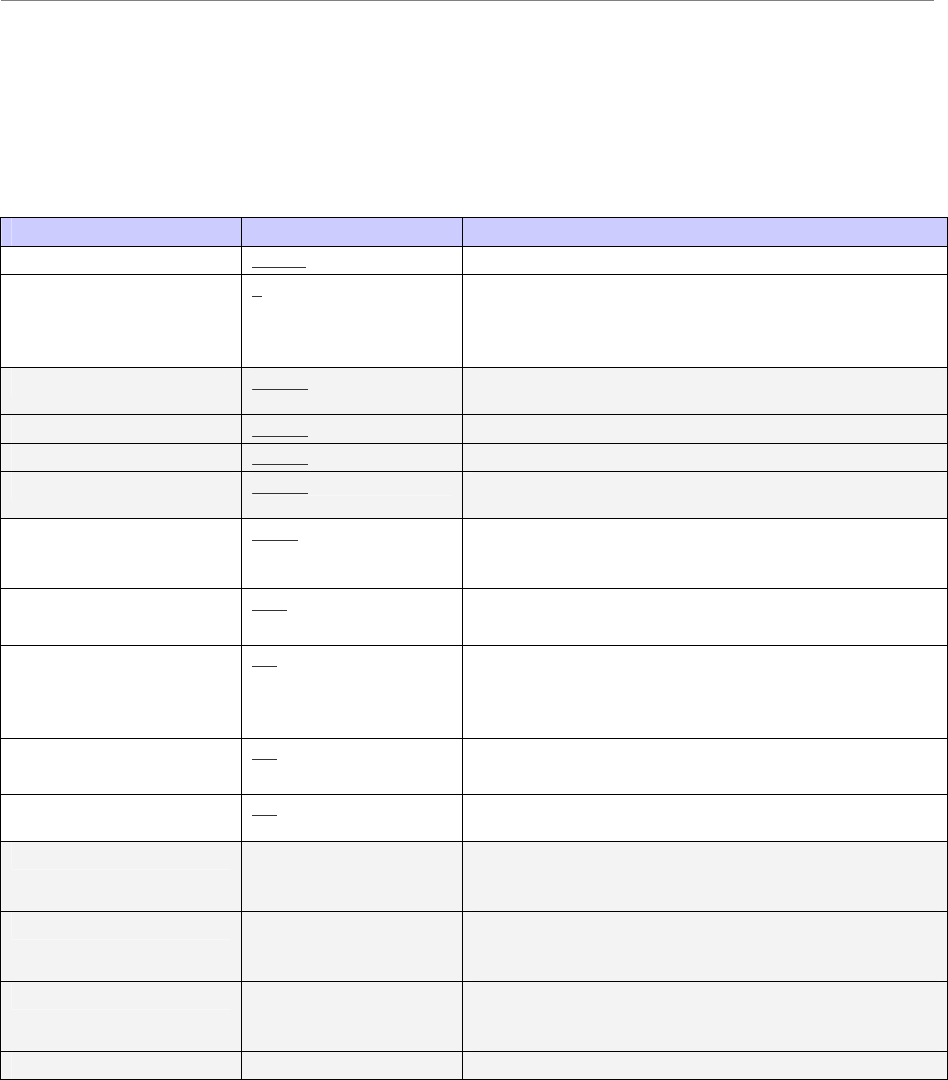
Ripwave Base Station I&C Guide Navini Networks, Inc.
158 Part #40-00047-00 Rev D v1.0
February 28, 2003
Air Interface Parameters
Layer 1 - General
Field Name Values Description
RFS Active or Passive Specifies whether the RFS has active or passive circuitry.
Gps Offset 0 This is the GPS timing offset to apply to the BTS in order
of chips (2.5us). The GPS offset must be different for
each BTS sharing the same frequency so they do not
interfere with each other.
Sync Scale 0.1125 The scale setting applied to the transmitted
synchronization signal.
Acc Scale 0.0557 The scale setting applied to the Access Channel.
Tcc Scale 0.0197 The scale setting applied to the Traffic Channel.
Max Scale 0.2516 The maximum allowable scale setting for each of the
above scales: Sync, ACC, TCC.
Rx Sensitivity (-
dBm)
100.0 The target Receiver sensitivity for each antenna. This
target is used during full calibration. If it is changed, full
calibration must be performed for it to take effect.
Antenna Power
(dBm)
30.0 The target antenna power for each antenna. This target is
used during full calibration.
Cal Cable Loss (dB) 0.0 Entered in the EMS during commissioning as one of
several inputs for performing full calibration. This value
is the measured calibration cable loss. If it is changed,
full calibration must be performed for it to take effect.
Cal Backplane Loss
(dB)
5.0 Calibration Backplane Loss (dB)
Cal Total Loss (dB) 0.0 Displays the total calibration loss, calculated from the
values in Cal Cable Loss and Cal Backplane Loss fields.
Synthesizer Tx Gain Displays the Transmitter gain setting for the Synthesizer
used during calibration. This field is a result that is
automatically returned from full calibration.
Synthesizer Rx Gain Displays the Receiver gain setting for the Synthesizer
used during calibration. This field is a result that is
automatically returned from full calibration.
Synthesizer Sc Gain Displays the Loopback gain setting for the Synthesizer
used during calibration. This field is a result that is
automatically returned from full calibration.
Synthesizer Level Displays the power level of the Synthesizer.
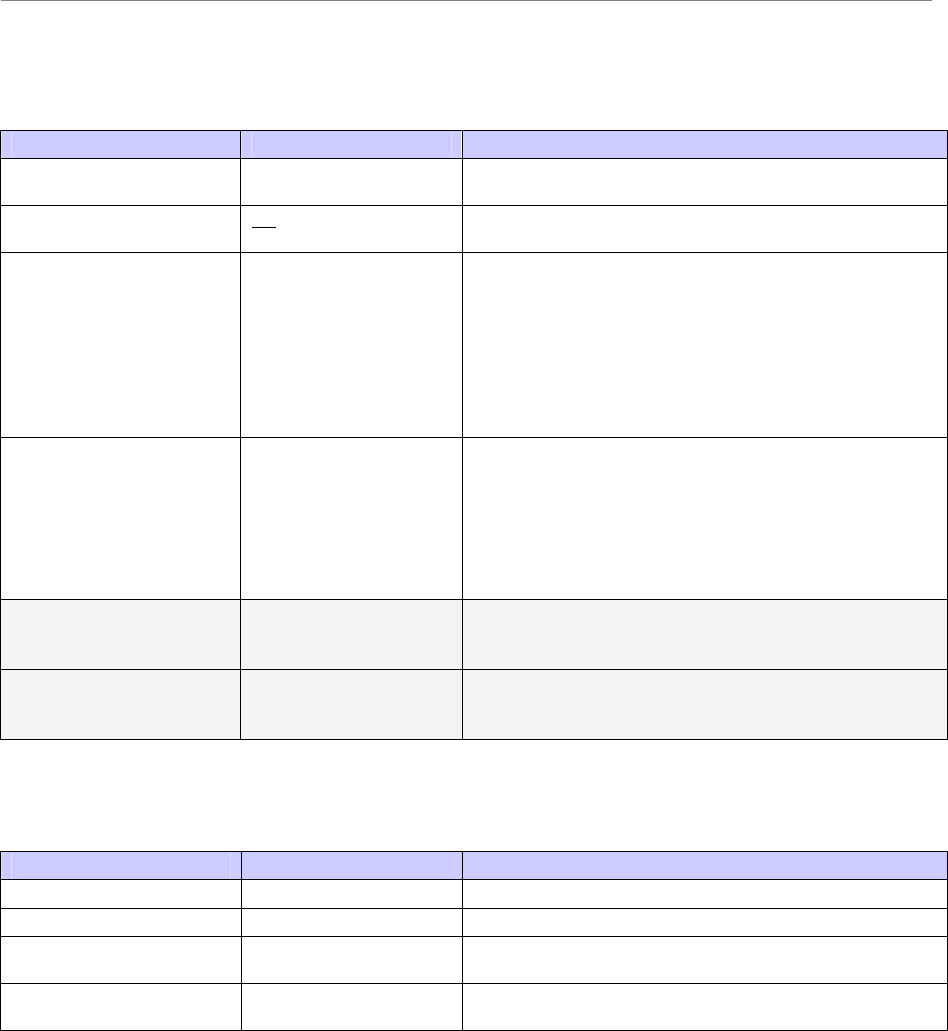
Navini Networks, Inc. Ripwave Base Station I&C Guide
Part #40-00047-00 Rev D v1.0 159
February 28, 2003
Layer 1 - Antenna Table
Field Name Values Description
Antenna Index 1-8 The number of the antenna (1-8) that maps to a specific
antenna element in the RFS.
Admin Status Up or Down Determines if the antenna is transmitting RF. Up means
transmitting; Down means not transmitting.
Power Splitter_I The real element of the calibrator board characteristics
that is found in the RFS. This information captures the
loss and phase information of the board. The Power
Splitter data is unique to each RFS. An RFS
Configuration CD ships with the equipment. It provides
an RFS script and instructions for selecting the correct
value to match the specific RFS that is physically
installed with the BTS.
Power Splitter_Q The imaginary element of the calibrator board that is
found in the RFS. This information captures the loss &
amplitude information of the board. The Power Splitter
data is unique to each RFS. An RFS Configuration CD
ships with the equipment. It provides an RFS script and
instructions for selecting the correct value to match the
specific RFS that is physically installed with the BTS.
RF Tx Gain 0-255 The Transmit gains for each antenna element, ranging
from 0-255, with 0 being the lowest gain. This data is
returned as a result of full calibration.
RF Rx Gain 0-255 The Receive gains for each antenna element, ranging
from 0-255, with 0 being the lowest gain. This data is
returned as a result of full calibration.
Layer 1 - w0 Table
Field Name Values Description
Sub Carrier Id 1-5 The subcarrier number. Subcarriers are assigned in pairs.
Antenna Index 1-8 The number of the antenna element.
W0 Weight_I Real elements of the vector used to control ACC spatial
pattern.
W0 Weight_Q Imaginary elements of the vector used to control ACC
spatial pattern.
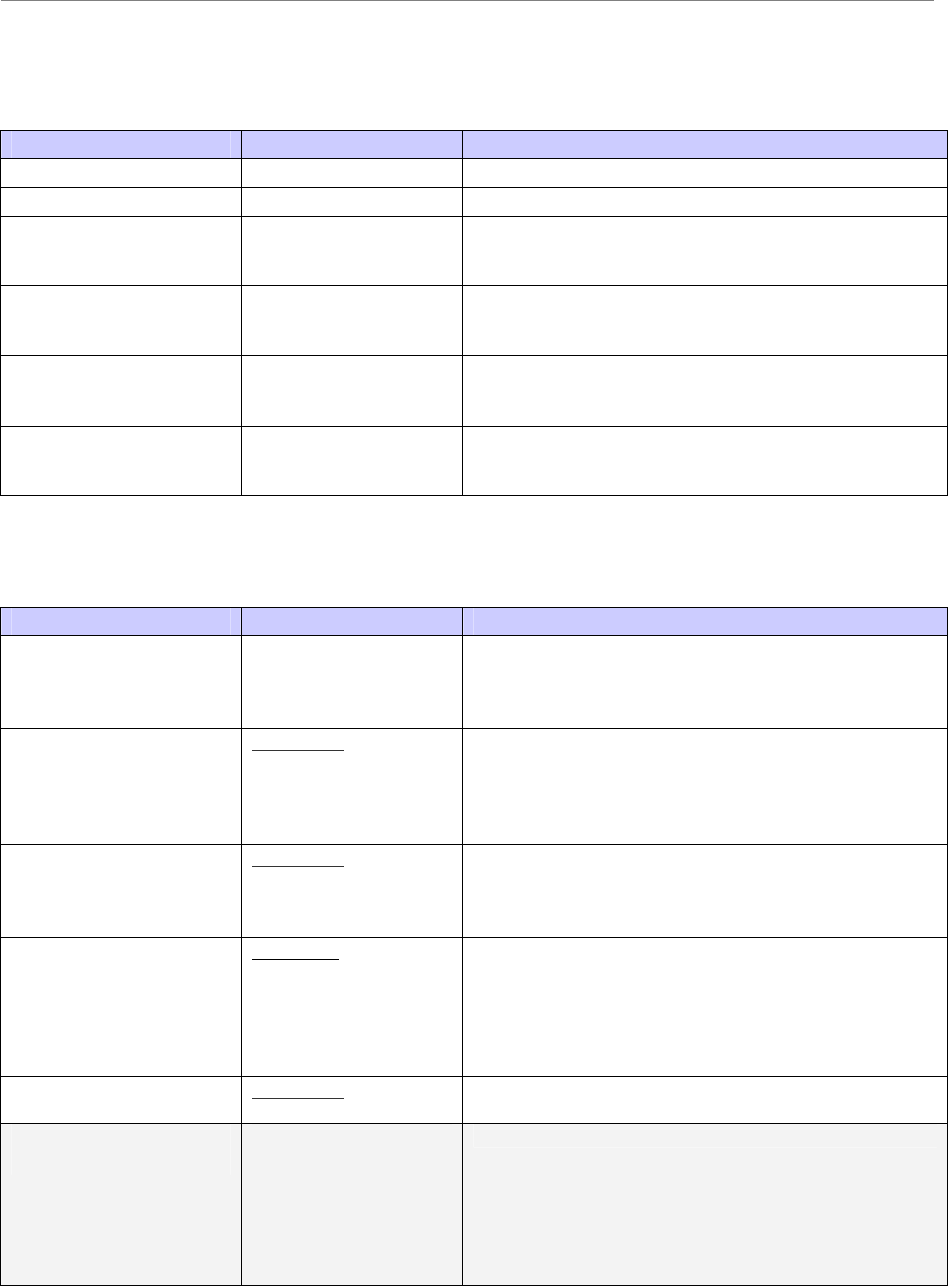
Ripwave Base Station I&C Guide Navini Networks, Inc.
160 Part #40-00047-00 Rev D v1.0
February 28, 2003
Layer 1 - Calibration Table
Field Name Values Description
Sub Carrier Id 1-10 The subcarrier number.
Antenna Index 1-8 The number of the antenna element.
Tx Weight_I Real elements of the vector used while transmitting to
control ACC spatial pattern. This data is returned as a
result of any of the calibration modes.
Tx Weight_Q Imaginary elements of the vector used while transmitting
to control ACC spatial pattern. This data is returned as a
result of any of the calibration modes.
Rx Weight_I Real elements of the vector used during Receive to
control ACC spatial pattern. This data is returned as a
result of any of the calibration modes.
Rx Weight_Q Imaginary elements of the vector used during Receive to
control ACC spatial pattern. This data is returned as a
result of any of the calibration modes.
Layer 2 - Carrier Data
Field Name Values Description
Sub Carrier Number
/ Sub Carrier
1-2, 3-4, 5-6, 7-8, 9-10 These two fields identify the 10 subcarriers. You can
click on the pair of subcarriers to be enabled for this
BTS. Subcarriers are assigned in pairs, one for uplink and
one for downlink.
Access Channel Checkmark or blank Access Code Channels: The ACC Channel occupies the
Code Channel with Walsh Index 0 configured on a
specified subcarrier frequency. Each checkbox indicates
which pair of subcarriers is used for the Access
Channel(s).
Broadcast Channel Checkmark or blank Broadcast Code Channel: If the box is checked, then this
channel is used to broadcast BTS related information. If
left blank, then information is broadcast on the ACC
channel.
TDD Symmetry
Ratio
Symmetric or
Asymmetric
Symmetric Ratio is 1:1. Asymmetric Ratio is 1:3. This
parameter determines the variable uplink and downlink
ratio in a TDD frame. If set to Asymmetric, the downlink
will have 3 times more bandwidth than the uplink. This is
sometimes desired due to the types of users on the
system, i.e., downloading files off the Internet.
Repeat Uplink Pkts Checkmark or blank If the box is checked, this carrier will repeat uplink
packets.
Frequency
(Scroll Bar)
2.305 GHz - 2.359 GHz
2.40 GHz - 2.473 GHz
2.50 GHz - 2.595 GHz
2.602 - 2.686 GHz
Indicates the center frequency of the BTS transmit signal.
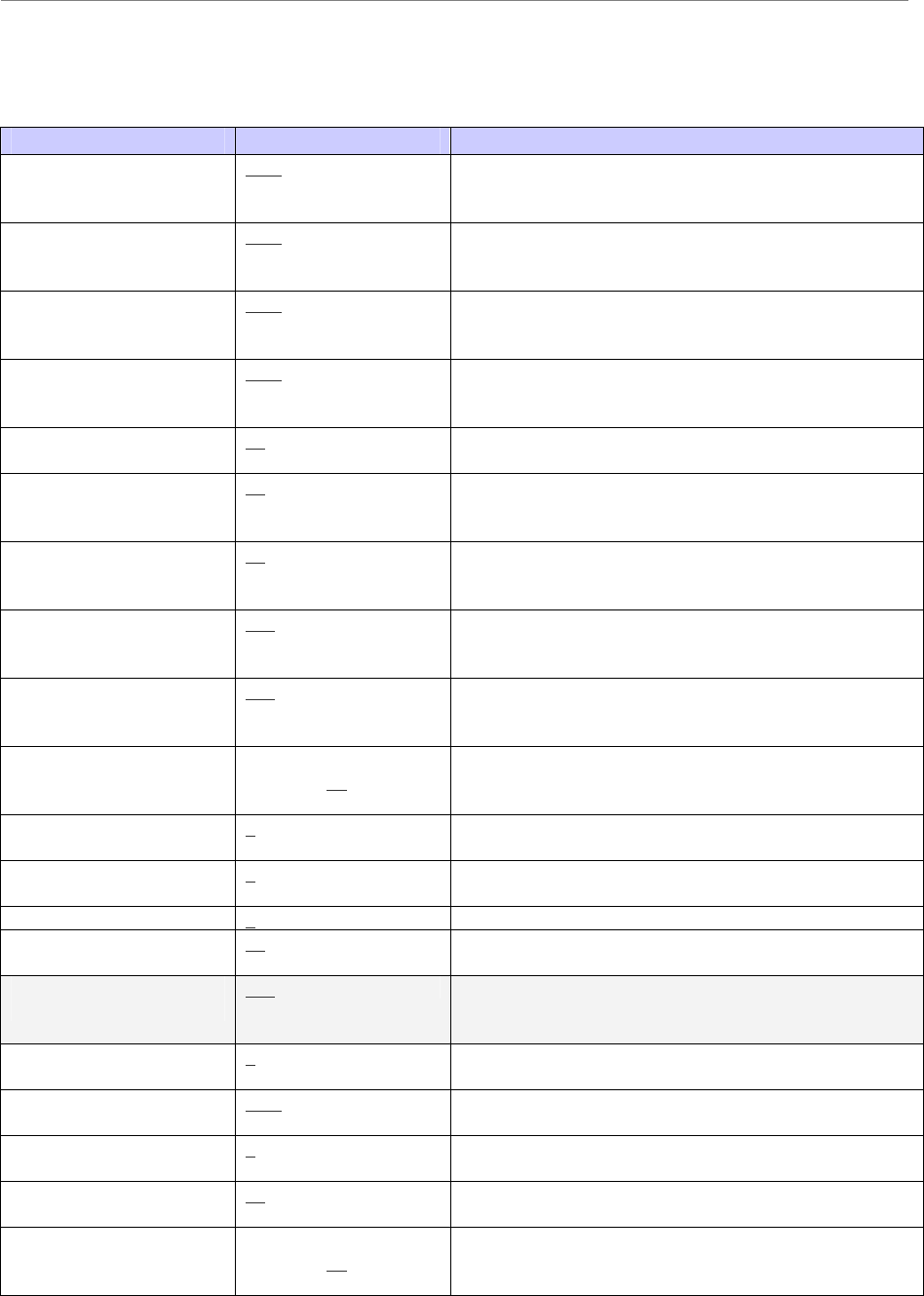
Navini Networks, Inc. Ripwave Base Station I&C Guide
Part #40-00047-00 Rev D v1.0 161
February 28, 2003
Layer 2 - Bandwidth
Field Name Values Description
Underload Threshold
(%)
80% The threshold crossing in which a BTS changes its load
congestion state from Overload (either Positive Access
Overload or Negative Access Overload) to Underload.
Overload Threshold (%) 85% The threshold crossing in which a BTS changes its load
congestion state from Underload to Positive Access
Overload.
Positive Access Overload
Threshold (%)
90% The threshold crossing in which a BTS changes its load
congestion state from Negative Access Overload to
Positive Access Overload.
Negative Access
Overload Threshold (%)
95% The threshold crossing in which a BTS changes its load
congestion state from either Underload or Positive
Access Overload.
Reserved Channels for
Accesses
12 Number of channels reserved for access when in the
Underload state.
CPE Inactive Time (min) 15 When a CPE has not communicated with a BTS for the
set Inactive Time, the status of the CPE changes from
active to inactive, as expressed in minutes.
Bandwidth Adjust
Interval (10ms)
20 A user’s bandwidth (uplink or downlink) is adjusted
every Adjust Time if needed when on TCC. Expressed in
units of 10 milliseconds.
Realtime Session Hold
Time (10ms)
250 The length of time a user with realtime data holds RF
resources after the incoming packet queue is empty.
Expressed in units of 10 milliseconds.
Non-realtime Session
Hold Time (10ms)
250 The length of time a user with non-realtime data holds
RF resources after the incoming packet queue is empty.
Expressed in units of 10 milliseconds.
Non RT PreRelease BW
(Kbps)
0 - 2,048
Default is 32
The bandwidth a user is assigned while in Non-realtime
Session Hold Time. The Non RT PreRelease BW is in
units of MAC packets.
Denied Req Number 5 The number of consecutive times a user’s access request
fails due to lack of RF resources before access is denied.
Average LCC Q LEN
Factor
2 Factor used to determine the average LLC queue length.
Exponential For Average 1 Average exponent for all statistical variables but power.
Average Burst Time (ms) 50 Average time for a data burst, expressed in units of 10
milliseconds.
Max Bts Power (TCC
Power)
320 Maximum RF power a BTS has. It is in units of
maximum TCC power per channel. This field is not
configurable.
DL ACC Power Per
Channel (TCC Power)
8 Downlink ACC RF power per channel. It is expressed in
units of maximum TCC power per channel.
TCC Initial Setup Power
(%)
25% Initial setup power of a TCC channel. Expressed in units
of the percentage of the max. TCC power per channel.
Average Exponential
Factor
1 Average exponent for average power.
TCC Power per Channel
Range (dB)
19 Number of decibels the downlink TCC power per
channel can vary.
Min Realtime Data
Bandwidth (Kbps)
0 - 2,048
Default is 32
The minimum bandwidth a user with realtime data holds
that is not used for acknowledgement. Expressed in units
of MAC packets (data rate).
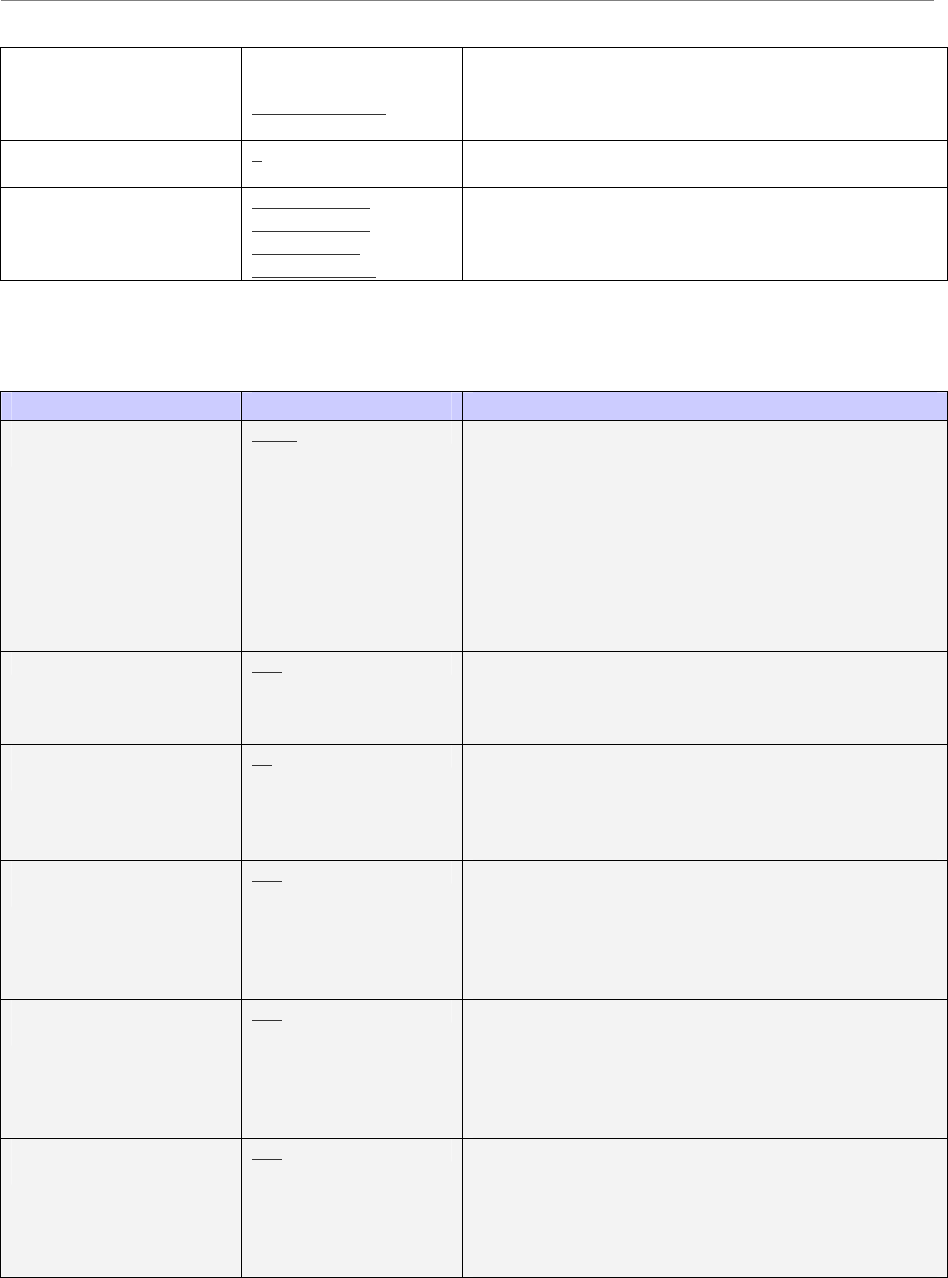
Ripwave Base Station I&C Guide Navini Networks, Inc.
162 Part #40-00047-00 Rev D v1.0
February 28, 2003
Supported Modulations QAM4
QAM4 QAM8
QAM4 QAM16
QAM4 QAM8 QAM16
The highest QAM Rank the BTS can process.
Total Priority Level
Num.
8 The total number of QoS classes the BTS can maintain.
Each class is associated with a priority.
Max Bandwidth for
Priority 1-8 (%)
1 default 85%
2 default 10%
3 default 5%
4-8 default 0%
The percentage of the total bandwidth a QoS class
associated with a certain priority is entitled to.
Layer 2 - WAN Congestion Control
Field Name Values Description
Average Queue Size
Weight (%)
100.0 For downlink, this value - expressed as a percentage -
indicates how much the current queue size contributes to
the calculation of the average queue size. The average
queue size is used by the BTS Resource Management
software to determine how many resources (Code
Channels) to give a CPE. The greater the weight, the
greater influence the current queue size has on the
average queue size. The lower the weight, the more the
queue size is an actual average of the current queue size
over time.
Max Queue Size (KB) 512 For downlink, the maximum queue size - in kilobytes -
for each priority queue (high, low, voice). Once the
queue is full (at Min Drop Threshold) all packets are
dropped.
Min to Max Drop
Probability (%)
10 For downlink, the probability of a packet being dropped
when the Min Threshold has been reached. The higher
this number, the more likely a packet will be dropped
between the Min Threshold and the Max Threshold.
NOTE: All packets are dropped at the Max Threshold.
Realtime Min Drop
Threshold (%)
100 For downlink, the minimum queue size in which voice
priority packets are considered for being dropped. For
example, if set to 10%, once the queue size reaches 11%
or more, voice priority packets may be dropped. The
Max Drop Probability field determines if a packet is
dropped once the Min Threshold is exceeded.
High Priority Min Drop
Threshold (%)
100 For downlink, the minimum queue size in which high
priority packets are considered for being dropped. For
example, if set to 10%, once the queue size reaches 11%
or more, high priority packets may be dropped. The Max
Drop Probability field determines if a packet is dropped
once the Min Threshold is exceeded.
Low Priority Min Drop
Threshold (%)
100 For downlink, the minimum queue size in which low
priority packets are considered for being dropped. For
example, if set to 10%, once the queue size reaches 11%
or more, high priority packets may be dropped. The Max
Drop Probability field determines if a packet is dropped
once the Min Threshold is exceeded.

Navini Networks, Inc. Ripwave Base Station I&C Guide
Part #40-00047-00 Rev D v1.0 163
February 28, 2003
Layer 2 - CPE Uplink Congestion Control
Field Name Values Description
Avg Queue Size Weight
(%)
100.0 For the uplink, this value - expressed as a percentage -
indicates how much the current queue size contributes to
the calculation of average queue size. The average queue
size is used by the BTS Resource Management software
to determine how many resources (Code Channels) to
give a CPE. The greater the weight, the greater influence
the current queue size has on the average queue size. The
lower the weight, the more the average queue size is an
actual average of the current queue size over time.
Max Queue Size (KB) 512 For the uplink, the maximum queue size for each priority
queue (high, low, voice). Once the queue is full (at Min
Drop Threshold) all packets are dropped.
Min to Max Drop
Probability (%)
10 For the uplink, the probability of a packet being dropped
when the Min threshold has been reached. The higher this
number, the more likely a packet will be dropped
between the Min Threshold and Max Threshold. Note:
All packets are dropped at the Max Threshold.
Realtime Min Drop
Threshold (%)
100 For the uplink, the minimum queue size in which voice
priority packets are considered for being dropped. For
example, if set to 10% once the queue size reaches 11%
or more, voice priority packets may be dropped. The Max
Drop Probability field determines if a packet is dropped
once the Min Threshold is exceeded.
High Priority Min Drop
Threshold (%)
100 For the uplink, the minimum queue size in which high
priority packets are considered for being dropped. For
example, if set to 10% once the queue size reaches 11%
or more, high priority packets may be dropped. The Max
Drop Probability field determines if a packet is dropped
once the Min Threshold is exceeded.
Low Priority Min Drop
Threshold (%)
100 For the uplink, the minimum queue size in which low
priority packets are considered for being dropped. For
example, if set to 10% once the queue size reaches 11%
or more, low priority packets may be dropped. The Max
Drop Probability field determines if a packet is dropped
once the Min Threshold is exceeded.
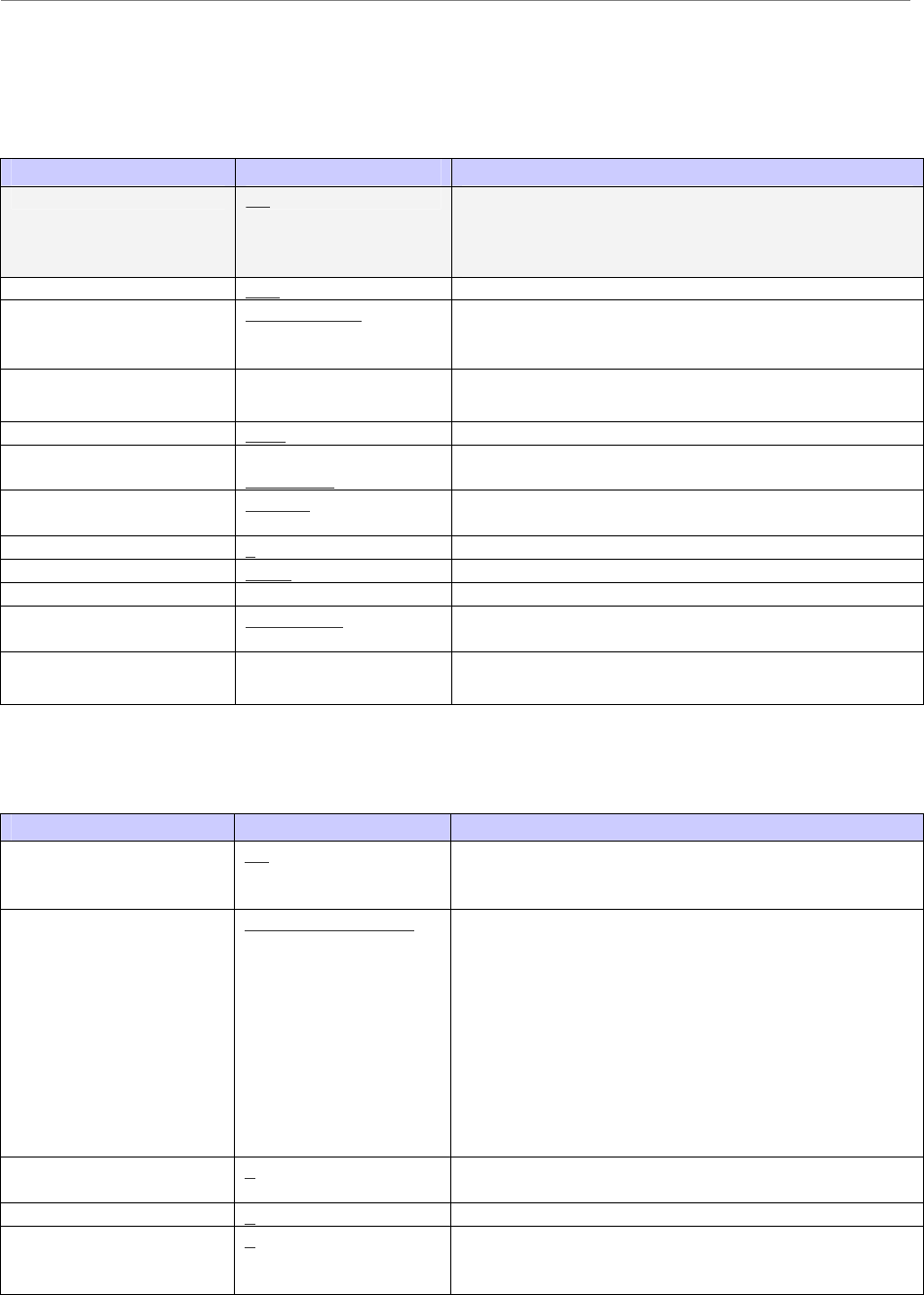
Ripwave Base Station I&C Guide Navini Networks, Inc.
164 Part #40-00047-00 Rev D v1.0
February 28, 2003
Backhaul Interface Parameters
T1
Field Name Values Description
Admin Status Up Up or Down. Display only. The administrative
(operational) status of this T1. If Down, no traffic is able
to go through this interface. This field is not
configurable.
Line Type ESF or D4 Framing format
Send Code Send line code, Send No
Code, Send Payload
Code, Send Reset Code
Selection of codes used for far-end loopback tests
Signal Mode
None
Always None
Line Length (foot) 5000 Length of T1 cables from BTS to terminating equipment
Fdl None, Att54016,
AnsiT1403
Facility Data Link (FDL) signaling type
Line Status Change Trap Enabled or Disabled Enables generation of traps based on changes to the line
status
Line Index 1 The ATM IF index that this T1 is associated with
Line Coding B8ZS or AMI Type of coding used to encode bits on the line
Circuit Identifier Transmission vendor’s circuit identifier
Transmit Clock Source Loop timing or Local
Timing
Source of the framer Transmit clock
Channelization
Disabled
Always Disabled (clear channel)
IMA Groups
Field Name Values Description
Admin Status Up Up or Down. This is the administration (operational)
status of the IMA group. If Down, no traffic is able to go
through this interface.
Symmetry Symmetric operation,
Symmetric &
Asymmetric, or
Asymmetric
Three options for the relationship of the Transmit and
Receive link throughput:
Symmetric operation - all links should be configured
in both directions. Tx and Rx must both be active to
use the disk.
Symmetric and Asymmetric operation - all links
should be configured in both directions. Transmitting
is allowed when Tx is active and Rx is not active.
Asymmetric operation - not required to configure the
IMA links in both Tx and Rx directions.
Min Num Rx Links 3 Minimum number of active Receive links that is
necessary for the IMA group to be active.
Tx Ima Id 0 Near-end (Transmit) IMA ID.
Alpha Value 2 Used to specify the number of consecutive valid ICP
cells to be detected before moving to the IMA hunt state
from the IMA sync state.
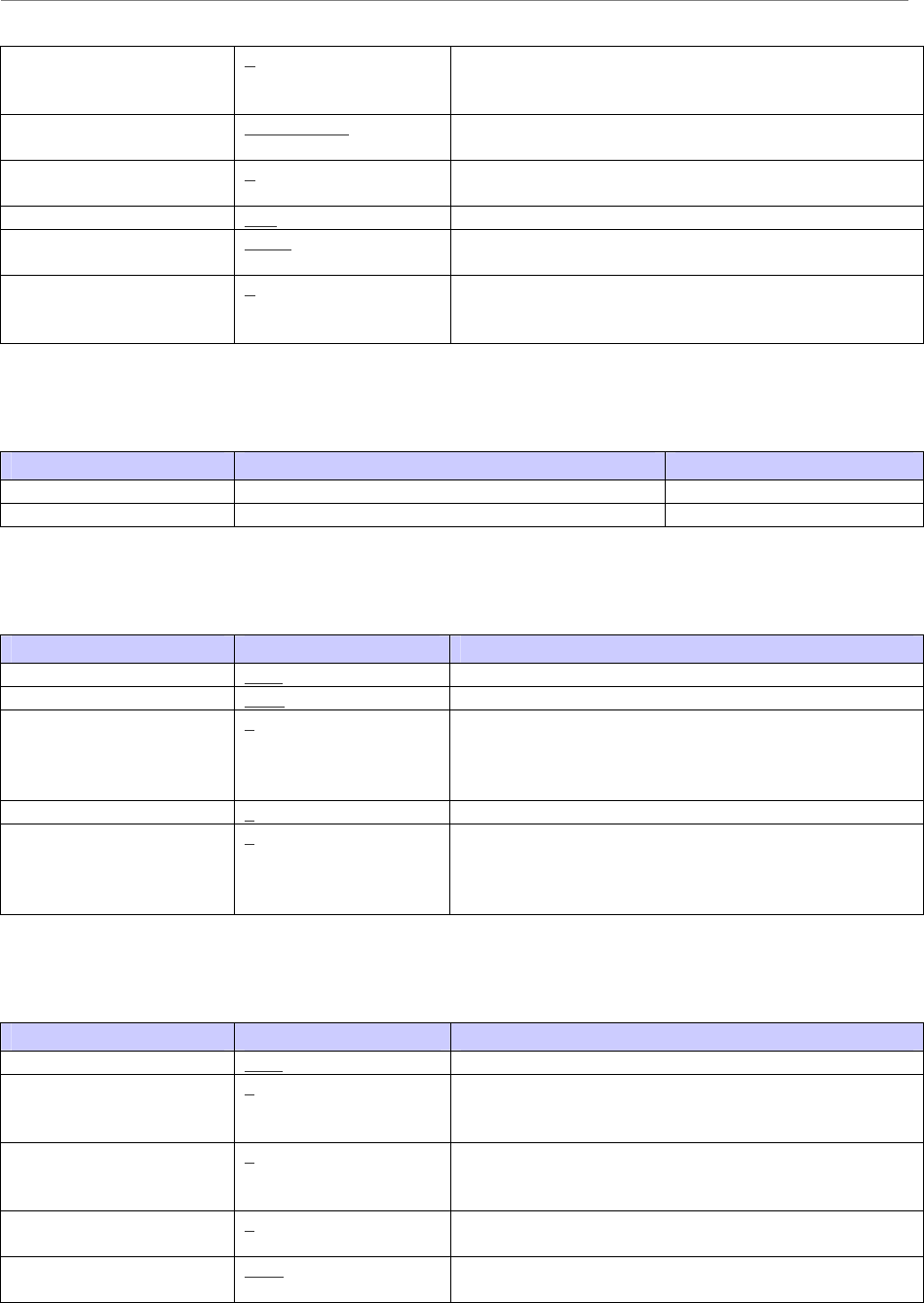
Navini Networks, Inc. Ripwave Base Station I&C Guide
Part #40-00047-00 Rev D v1.0 165
February 28, 2003
Gamma Value 1 Used to specify the number of consecutive valid ICP
cells to be detected before moving to the IMA sync state
from the IMA pre-sync state.
Index IMA group 2 IMA Group 1 or 2. Unique sequence number of the IMA
group.
Min Num Tx Links 1 Minimum number of Transmission links that have to be
active for the IMA group to be active.
Ne Tx Clk Mode ITC Near-end Transmit clock mode.
Tx Frame Length M128 Length of IMA frame being transmitted. It is defined as
M consecutive cells.
Beta Value 2 Used to specify the number of consecutive ICP cells with
errors to be detected before moving to the IMA hunt state
from the IMA sync state.
Add T1’s to IMA Groups
IMA Group T1’s Associated With this IMA Group Notes
IMA 1
IMA 2
ATM
Field Name Values Description
If Index T1-1 (first T1 ID) Interface (IF) Index associated with this ATM interface.
Max Vccs 1001 Maximum Virtual Channel Circuits for this interface.
Max Active Vci Bits 9 The number of bits for Virtual Channel Identifier (VCI).
Determines the maximum VCI value allowed for this
interface. The Max Value is calculated by 2^ (max active
vci bits).
Max Vpcs 0 Maximum Virtual Private Circuits for this interface.
Max Active Vpi Bits 3 The number of bits for Virtual Private Identifier.
Determines the maximum VPI value allowed for this
interface. The max value is calculated by 2^ (max active
vpi bits).
PVC
Field Name Values Description
if Index T1-1 The ATM IF index that this PVC is associated with.
Vpi (start and end) 0 Virtual Path Identifier. The VPI + VCI are in the cell
header and identify the next destination of a cell as it
passes through a series of ATM switches.
Vci (start and end) 0 Virtual Channel Identifier. The VPI + VCI are in the cell
header and identify the next destination of a cell as it
passes through a series of ATM switches.
Tr/Re Traffic Descr
Indexes
2 Index of the ATM Descriptor that applies to this PVC.
The Transmit and Receive Descriptors are the same.
AAL5 CPCS Tx SDU
Size (Byte)
1528 The maximum AAL5 CPCS SDU size, in bytes, that is
supported in the Transmit direction.
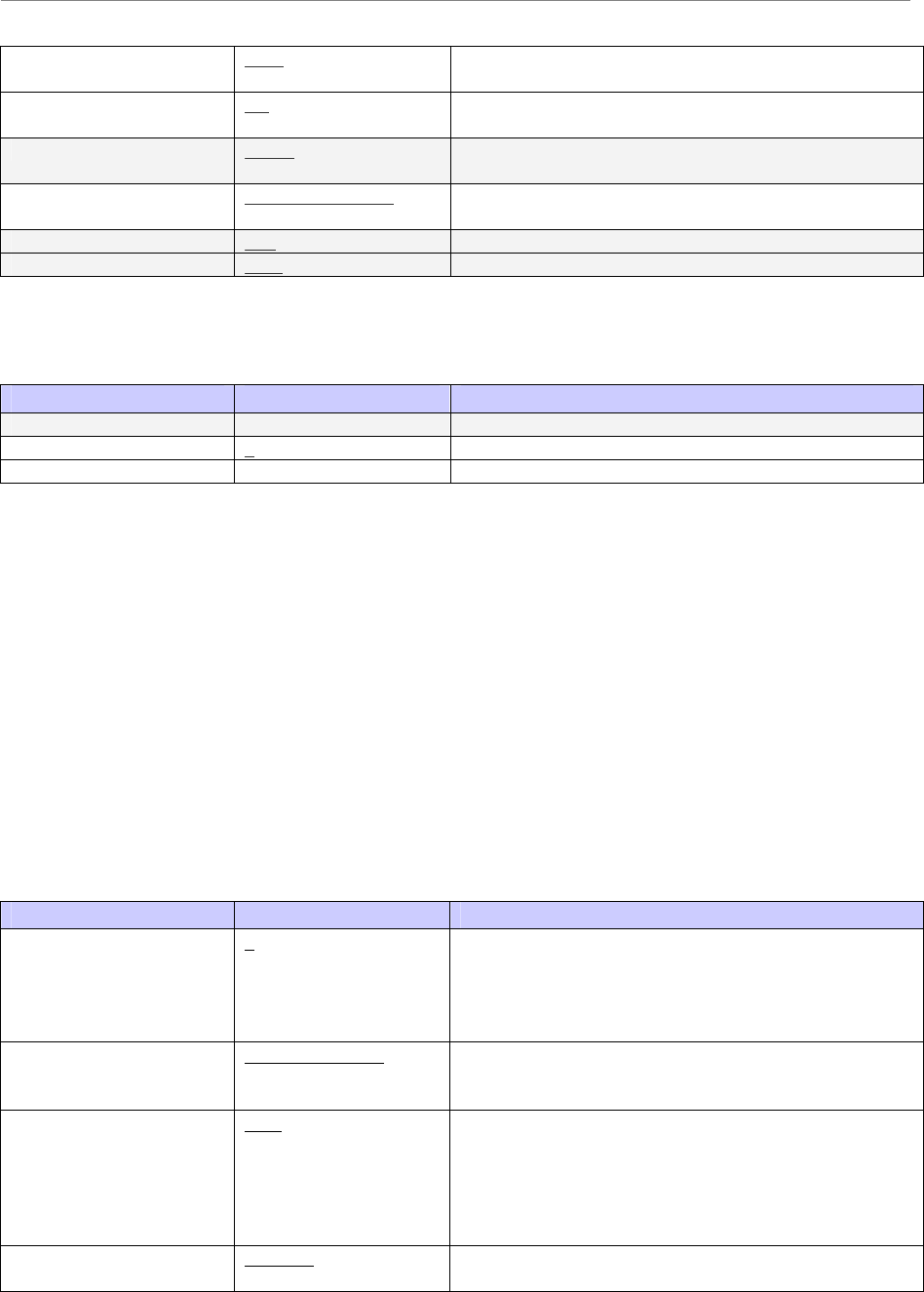
Ripwave Base Station I&C Guide Navini Networks, Inc.
166 Part #40-00047-00 Rev D v1.0
February 28, 2003
AAL5 CPCS Rx SDU
Size (Byte)
1528 The maximum AAL5 CPCS SDU size, in bytes, that is
supported in the Receive direction.
Admin Status Up Up or Down. The administrative (operational) state of the
PVC. If it is Down, this PVC may not be used for traffic.
AAL Type AAL5 (1-5) The type of ATM Adaptation Layer (AAL) used on this
PVC: AAL1, AAL2, AAL3, AAL4, or AAL5.
AAL5 Encap Type LLC encapsulation The type of data encapsulation used over the AAL5
SSCS layer.
Cast Type P2P The connection topology type.
Conn Kind PVC The type of VCL. This is always PVC.
Assign CPE to PVC
Field Name Values Description
PVC T1-1-1-100 (example) Identifies the PVC to be assigned to the specified CPE.
CPE 0 CPE assigned to specified PVC.
Data Denotes what type of PVC to assign.
**********
CPE Configuration Data Form
Company:__________________________________________________________
Your Name:______________________________________Date:______________
NOTE 1: Field Values in gray rows indicate data that ordinarily should not be changed or that is populated
automatically by the system.
NOTE 2: Default Field Values are underlined.
Add CPE
Field Name Values Description
EID (hex) 0 Equipment Identifier unique to each CPE. This value is
determined during the manufacturing process and is
displayed on the case of the CPE hardware, as well as
entered and displayed as a hexadecimal number in this
field.
Descriptor Name CPE Descriptor-1 The name of the CPE Descriptor to be used with this
CPE. The CPE Descriptor level affects Quality-of-
Service (QoS) for this CPE’s data packets.
Collect Perf Data True True or False. Collect Performance Data. If True, this
CPE sends performance metrics to the BTS at the set
interval. The BTS then uploads the performance data to
the EMS at set intervals. The interval setting for
collection and upload from the BTS to the EMS is set in
the Performance fields for the BTS.
Nomadic Disabled Enabled or Disabled. If Enabled, this CPE can access any
BTS in the network that is defined in its Available Home
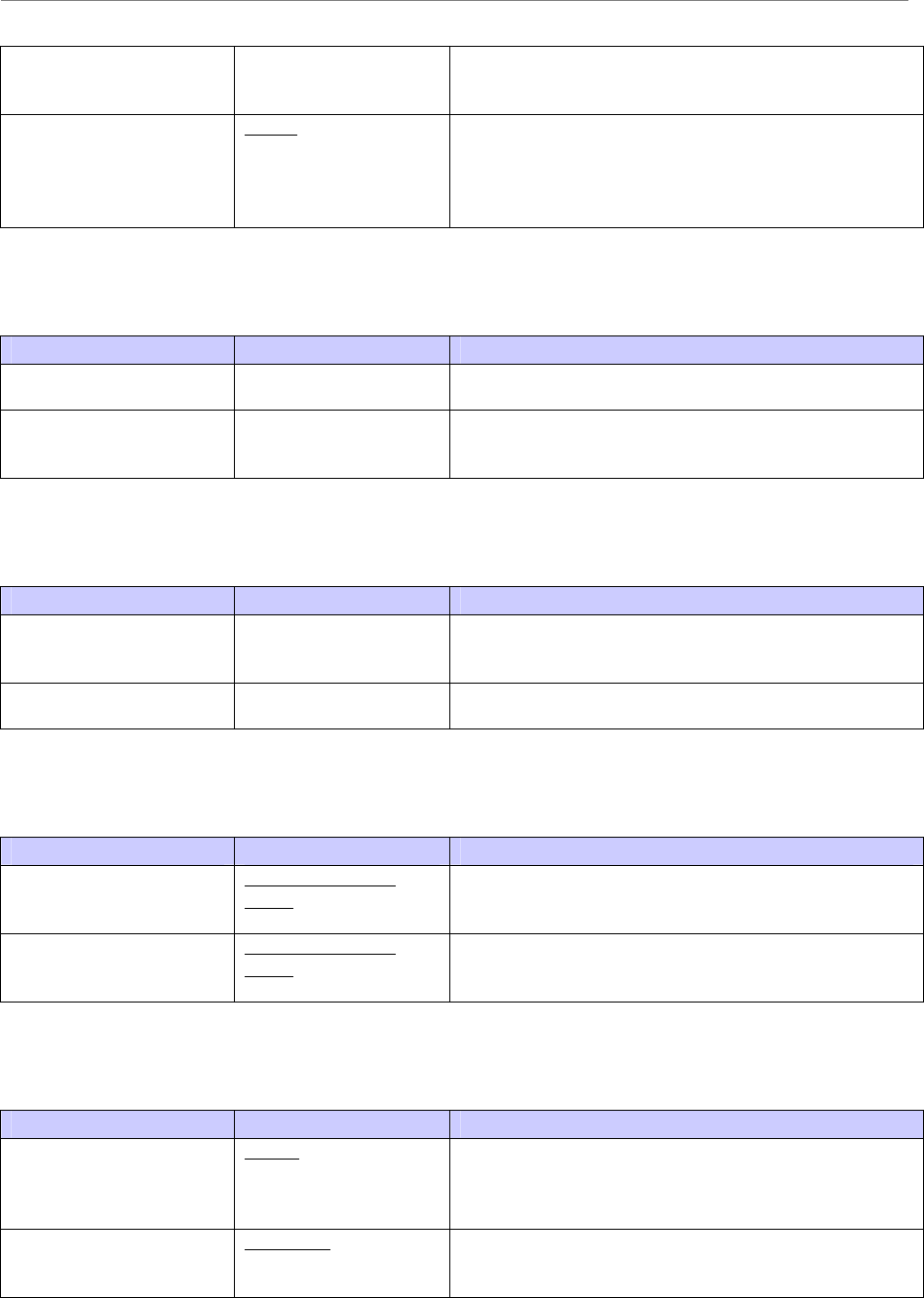
Navini Networks, Inc. Ripwave Base Station I&C Guide
Part #40-00047-00 Rev D v1.0 167
February 28, 2003
BTS list at the bottom of the screen. When enabled, the
Current Home BTS list is ignored. If disabled, this CPE
can only access a BTS in its Available Home BTS list.
Admin Status Active Active or Suspended. If suspended, the CPE cannot
access any BTS. A Service Provider may decide to make
the CPE suspended due to late service payments, security
concerns, etc., rather than deleting the CPE from the
system database.
Home BTS
Field Name Values Description
Available Home BTS Add or Remove BTS Names. A list of available BTS’s to
include in the Current Home BTS list for this CPE.
Current Home BTS Add or Remove BTS Names. If Nomadic is disabled,
these are the only BTS’s this CPE can access. If Nomadic
is enabled, this list is ignored.
Layer 3
Field Name Values Description
Ingress Acl (Checkbox) If checkbox is clicked “on” any incoming packet whose
MAC address cannot be found in the current CPE
Authenticated IP List will be discarded.
Ingress Broadcast (Checkbox) If checkbox is clicked “on” any incoming MAC
broadcast message will be discarded.
DHCP Relay
Field Name Values Description
Free Address High Drop
Policy
Drop most recently
leased or Drop least
recently leased
Drop the most recently leased or least recently leased IP
addresses
Max Address Number Drop most recently
leased or Drop least
recently leased
Drop the most recently leased or least recently leased IP
addresses
IP Address
Field Name Values Description
Static Client IP Address 0.0.0.0 Use static, rather than dynamic, IP addressing for this
device. If static IP assignment is being made, add this IP
address to the Ingress Filter Authenticated IP List.
Otherwise, leave zeroes.
Hardware Address 0:0:0:0:0:0 Enter the Ethernet address of the host computer to which
the CPE is connected and that corresponds to the above
Client IP Address.

Ripwave Base Station I&C Guide Navini Networks, Inc.
168 Part #40-00047-00 Rev D v1.0
February 28, 2003
**********
EMS Configuration Data Form
(To configure EMS Servers & Clients in the Ripwave System)
Company:__________________________________________________________
Your Name:______________________________________ Date:_____________
NOTE 1: Field Values in gray rows indicate data that ordinarily should not be changed or that is populated
automatically by the system.
NOTE 2: Default Field Values are underlined.
Field Name Values Description
EMS Id Unique identifier for this EMS.
Alarm AutoAck True True or False. If True, the EMS will automatically
acknowledge all alarms except alarms with a severity
level of Warning (blue). An Alarm Engineer will only
see current alarms on the system. However, all alarm
activity is logged to an alarm file.
Server Ip Address IP address of the EMS Server.
Database Schema
Version
01 (example) Version of the EMS server database schema.
Mib Version 1.19.01 (example) Version of the BTS Management Information Base
(MIB).
BTS/CPE SW Directory loads (example) Directory where BTS and CPE software loads are stored.
Used by the EMS to obtain the location of the software
loads during downloads. Copy BTS and CPE software
loads to this directory during initial installations or
upgrades. Otherwise, the EMS cannot download the
software to the BTS. This field is used in conjunction
with the FTP Server Root Path field by the EMS to
obtain the software loads. The full path the EMS searches
for software loads is <FTP Server Root Path>\<BTS/CPE
SW Directory>. Example - C:\naviniems\ftp\loads.
FTP Server Root Path The Root directory where BTS and CPE software loads
are stored. This field must match what is configured in
the FTP Daemon. Otherwise, the EMS will not be able to
download BTS and CPE software loads to the BTS. This
path is used by the EMS to obtain the location of the
software loads during downloads. Copy BTS and CPE
software loads to this root directory during initial
installations or upgrades. This field is used in conjunction
with the BTS/CPE SW Directory field by the EMS to
obtain the software loads. The full path the EMS searches
for software loads is <FTP Server Root Path>\<BTS/CPE
SW Directory>. Example - C:\naviniems\ftp\loads.
Network ID Unique identifier for this Service Provider’s wireless
network. Intended to ensure other Service Providers’
CPE’s cannot operate in the identified network. A CPE
with a different BTS network ID cannot be
p
rovided

Navini Networks, Inc. Ripwave Base Station I&C Guide
Part #40-00047-00 Rev D v1.0 169
February 28, 2003
service by that BTS.
Server Name Host name of the EMS Server machine.
EMS Version 1.19.01 (example) Version of the EMS Server software.
Idl Build Number 1.18.09 (example) CORBA networking software IDL version used by the
EMS Server.
BTS/CPE SW Ftp User
Name
User name for downloading BTS and CPE software from
the EMS. This field must match what is configured in the
FTP Daemon. Otherwise, the EMS cannot download
BTS and CPE software loads to the BTS.
BTS/CPE SW Ftp
Password
Password used when downloading BTS and CPE
software. This field must match what is configured in the
FTP Daemon. Otherwise, the EMS cannot download
BTS and CPE software loads to the BTS.
Confirm Password Password must be re-entered for security purposes.
CPE AutoProvisioning Disabled Enable or Disable. Determines if the EMS is in
AutoProvision mode during CPE registration. If enabled,
the EMS will allow unprovisioned CPE’s to access the
system with minimum bandwidth for a short period of
time. The minimum bandwidth is defined by the first
entry in the CPE Descriptor table. Once the CPE is
allowed limited access to the system, it can connect to a
default web site to enter billing information and the CPE
can be provisioned automatically with the EMS. If
disabled, the EMS will NOT allow an unprovisioned
CPE to access the system.
**********
Global Parameters Configuration Form
Company:__________________________________________________________
Your Name:______________________________________Date:______________
NOTE 1: Field Values in gray rows indicate data that ordinarily should not be changed or that is populated
automatically by the system.
NOTE 2: Default Field Values are underlined.
ATM Descriptor
Field Name Values Description
Index 0 Identifier for this ATM Descriptor
Type NOCLPNOSCR, NOCLPSCR,
CLPNOTAGGINGSCR,
CLPTAGGINGSCR,
CLPNOTAGGINGMCR,
CLPTRANSPARENTNOSCR,
CLPTRANSPARENTSCR,
NOCLPTAGGINGNOSCR
Type of ATM
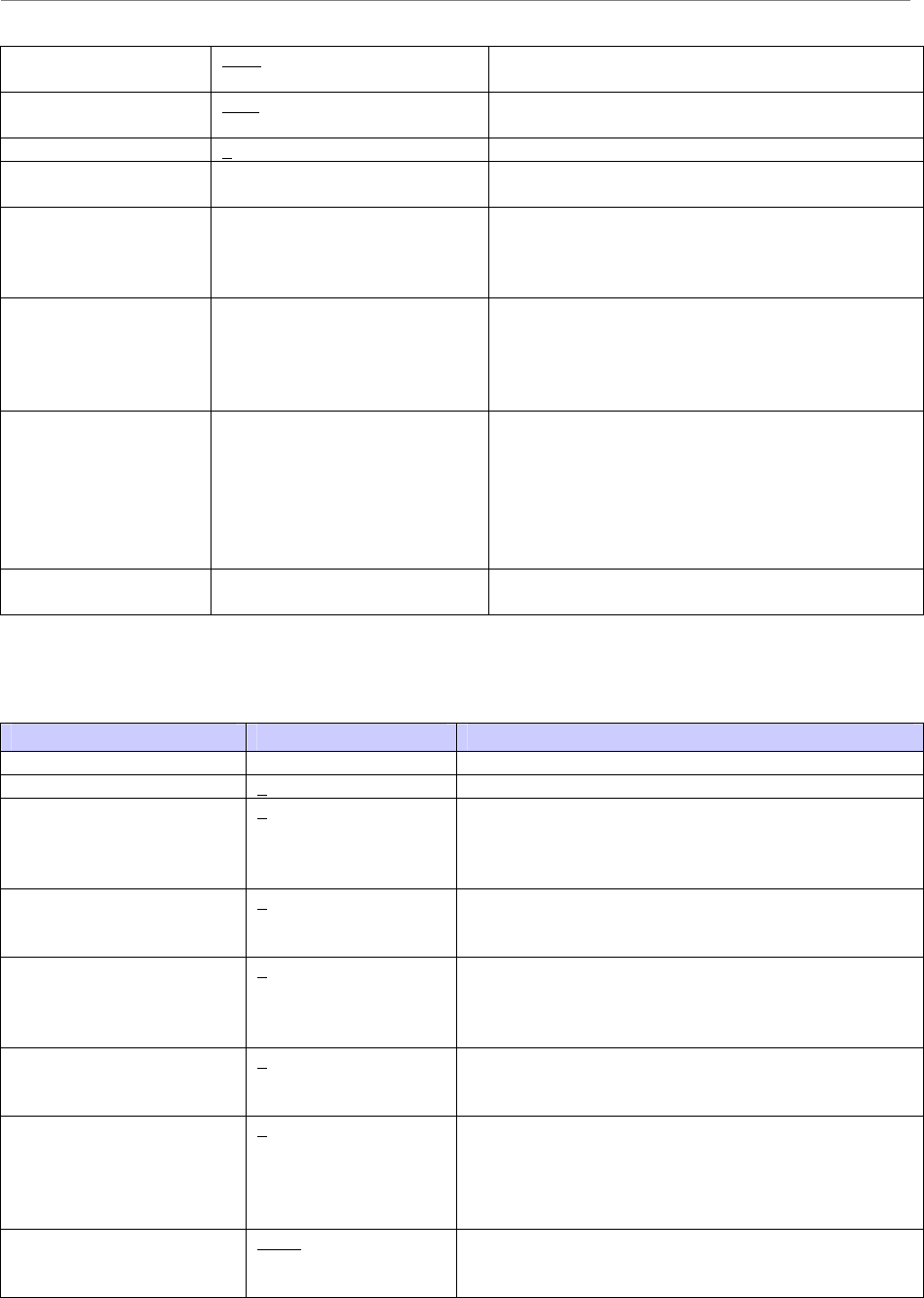
Ripwave Base Station I&C Guide Navini Networks, Inc.
170 Part #40-00047-00 Rev D v1.0
February 28, 2003
Category CBR, RTVBR, NRTVBR,
ABR, UBR
Category of this ATM (see parameters, below)
Frame Discard True True or False. If set to True, enables the ability to
discard ATM frames.
Param1 - Param5 0 Described below
CBR Parameters:
PCR
Peak Cell Rate
RTVBR Parameters:
PCR
SCR
MBS
Peak Cell Rate
Sustainable Cell Rate
Maximum Burst Size
NRTVBR
Parameters:
PCR
SCR
MBS
Peak Cell Rate
Sustainable Cell Rate
Maximum Burst Size
ABR Parameters:
PCR
MCR
ICR
RDF
RIF
CDF
Peak Cell Rate
Minimum Cell Rate
Initial Cell Rate
Rate Decrease Factor
Rate Increase Factor
Cutoff Decrease Factor
UBR Parameters:
PCR
Peak Cell Rate
CPE Descriptor
Field Name Values Description
Name Name given to this CPE Descriptor.
Index 1 (1-8) Unique index identifier for this CPE Descriptor.
Priority 0 The priority that a CPE with this assigned Descriptor
will receive from the BTS Resource Manager software
when requesting RF resources. This field maps to the
Layer 2 > Bandwidth Data component in the BTS.
UL Max Bandwidth
(Kbps)
0, 32, 64, 96, 128, 160,
192, 224, etc.
Maximum uplink bandwidth allowable for a CPE with
this Descriptor. The maximum number of code channels
allocated for a CPE is directly related to this field.
UL Min Bandwidth
(Kbps)
0, 32, 64, 96, 128, 160,
192, 224, etc.
Minimum uplink bandwidth allowable for a CPE. This
field determines the number of code channels allocated
when a CPE begins a data session. The larger this value,
the more code channels allocated at session startup.
DL Max Bandwidth
(Kbps)
0, 32, 64, 96, 128, 160,
192, 224, etc.
Maximum downlink bandwidth allowable for a CPE.
The maximum number of code channels allocated for a
CPE is directly related to this field.
DL Min Bandwidth
(Kbps)
0, 32, 64, 96, 128, 160,
192, 224, etc.
Minimum downlink bandwidth allowable for a CPE.
This field determines the number of code channels
allocated when a CPE begins a data session. The larger
this value, the more code channels allocated at session
startup.
Avg Queue Size Weight
(%)
100.0 How much the current queue size contributes to the
calculation of average queue size. The average queue
size is used b
y
the BTS Resource Mana
g
er to determine
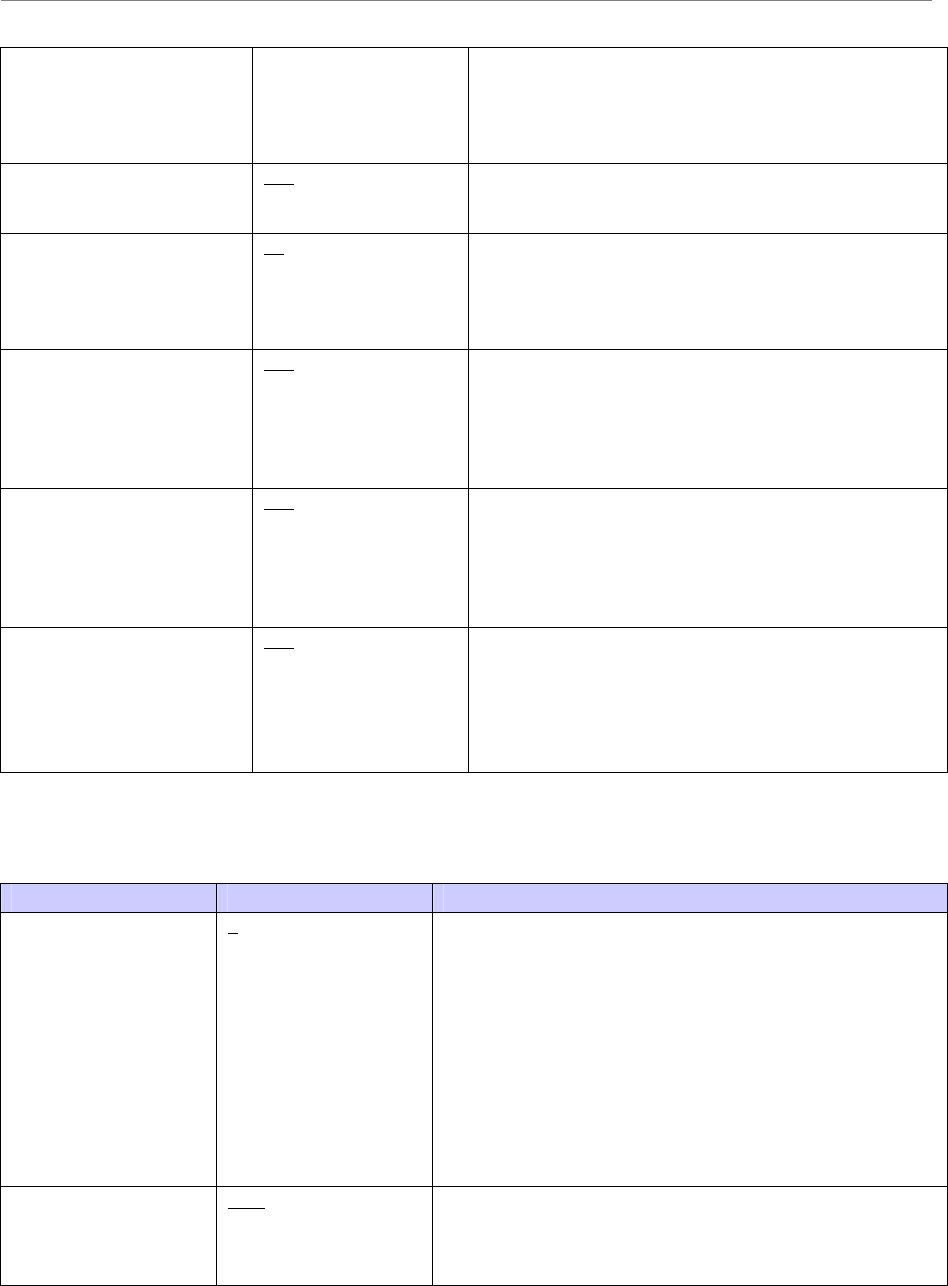
Navini Networks, Inc. Ripwave Base Station I&C Guide
Part #40-00047-00 Rev D v1.0 171
February 28, 2003
how many resources (code channels) to give a CPE. The
greater the weight, the greater influence the current
queue size has on the average queue size. The lower the
weight, the more the average queue size is an actual
average of the current queue size over time.
Max Queue Size (KB) 512 Maximum queue size for each priority queue (high, low,
voice). Once full (Max Threshold) all packets are
dropped.
Min to Max Drop
Probability (%)
10 The probability of a packet being dropped when the Min
Threshold has been reached. The higher this number, the
more likely a packet will be dropped between the Min
and Max Threshold. All packets are dropped at Max
Threshold.
Realtime Min Drop
Threshold (%)
100 The minimum queue size at which voice priority packets
are considered for being dropped. For example, if set to
10% once the queue size reaches 11% or more, voice
priority packets may be dropped. The Max Threshold
Probability field determines if a packet is dropped once
the Min Threshold is exceeded.
High Priority Min Drop
Threshold (%)
100 The minimum queue size which high priority packets are
considered for being dropped. For example, if set to
10%, once the queue size reaches 11% or more, high
priority packets may be dropped. The Max Threshold
Probability field determines if a packet is dropped once
the Min Threshold is exceeded.
Low Priority Min Drop
Threshold (%)
100 The minimum queue size which low priority packets
are considered for being dropped. For example, if set
to 10%, once the queue size reaches 11% or more,
low priority packets may be dropped. The Max
Threshold Probability field determines if a packet is
dropped once the Min Threshold is exceeded.
DiffServ
Field Name Values Description
Code Point 0 Unique index (bit) to be mapped to a defined Differentiated
Service. The code point is structured as follows:
01234567
+---+---+---+---+---+---+---+---+
|DSCP|CU|
+---+---+---+---+---+---+---+---+
DSCP: Differentiated Services Code Point
CU: Currently Unused
The Type of Service (ToS) bits are included in the DSCP.
Priority Low, High, Voice Low, High, or Voice. This is the priority given to data
packets associated with this Code Point/Service. The BTS
processes data packets with Voice, then High priority before
Low priority packets.
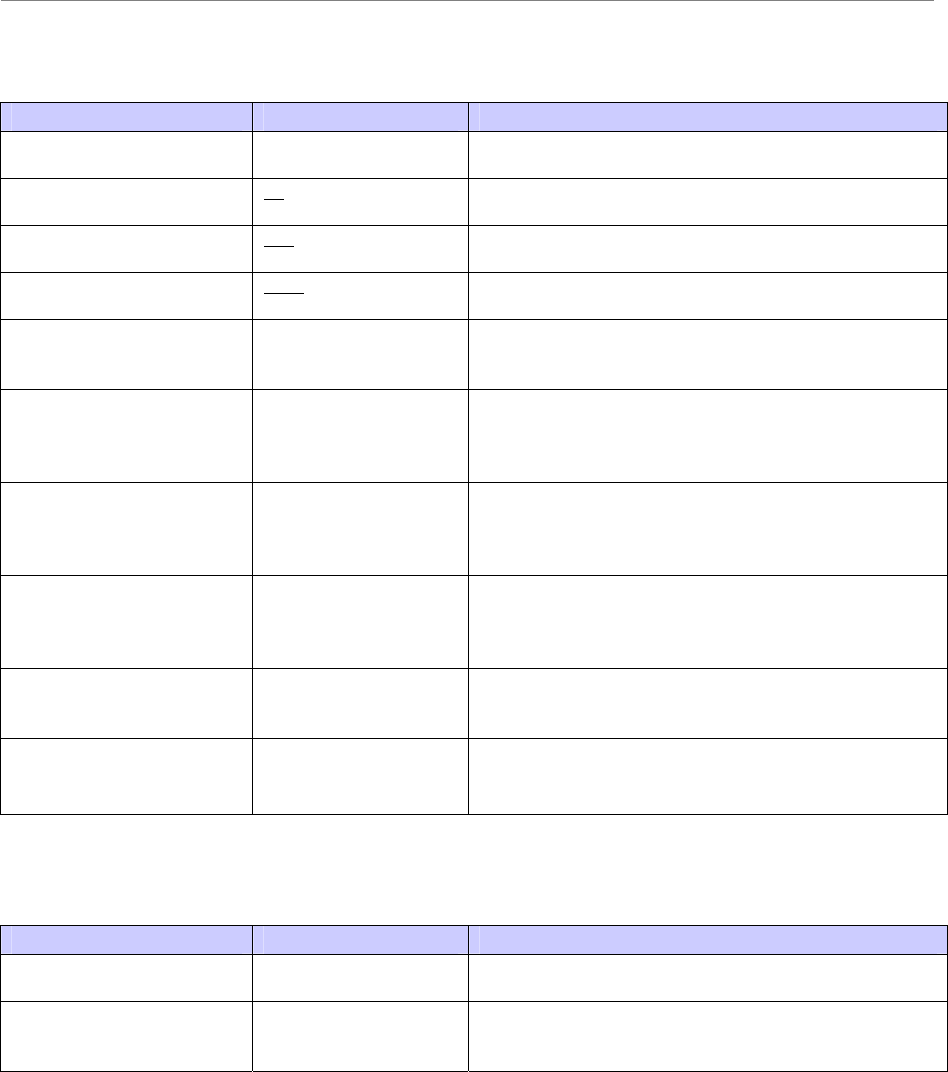
Ripwave Base Station I&C Guide Navini Networks, Inc.
172 Part #40-00047-00 Rev D v1.0
February 28, 2003
DHCP Relay
Field Name Values Description
Relay Config Enabled (Checkbox) Enable or Disable. Clicking on the checkbox enables the
DHCP Relay feature.
Free Address Low Agent
Threshold
80
Free Address High Agent
Threshold
100
Relay Config MaxDhcp
Size
1488
Option 82 Tagging (Checkbox) Enable or Disable. Clicking on the checkbox enables the
inclusion of one or more of the following Relay
Information sub-options.
Remote Id (Checkbox) If checked (enabled), include the CPE’s EID as the
Remote ID Relay Information sub-option. It will be
formatted as a 6 octet string “0000<EID>”. This format
is often used in cable modem scenarios.
Circuit Id (Checkbox) If checked (enabled), include the BTS’s ID as the Circuit
ID Relay Information sub-option. It will be formatted as
a 4-octet string “<BTS ID>”. This format is often used
in cable modem scenarios.
VPN Id (Checkbox) If checked (enabled), include the CPE’s EID as the VPN
ID Relay Information sub-option. It will be formatted as
a text string “navini<EID>”. This format is often used in
DSL scenarios.
Subnet Selection/Addr (Checkbox) If checked (enabled), include the specified Subnet
Address as the Subnet Selection Relay Information sub-
option.
DOCSIS Device/Class (Checkbox) If checked (enabled), include the specified DOCSIS
Device Class as the DOCSIS Device Relay Information
sub-option.
ARP Proxy
Field Name Values Description
ARP Ingress Proxy (Checkbox) If clicked, this enables the BTS to respond to ARP
messages coming from the CPE's/Modems to the BTS.
ARP Egress Proxy (Checkbox) If clicked, this enables the BTS to respond to ARP
messages coming from the network (backhaul) to the
BTS on behalf of the CPE's/Modems.
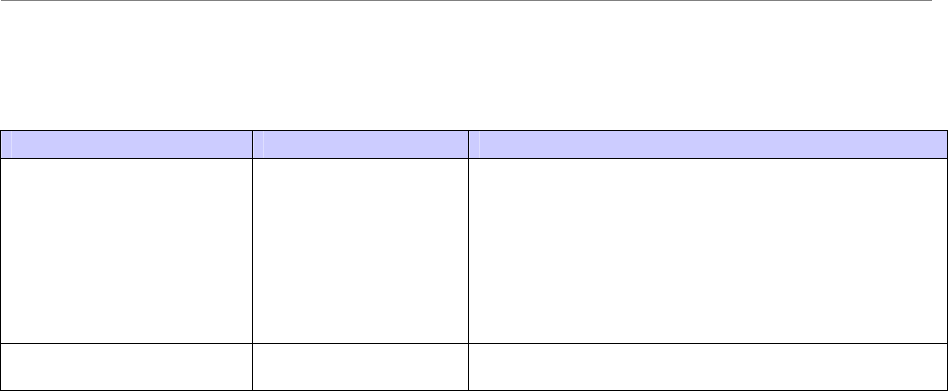
Navini Networks, Inc. Ripwave Base Station I&C Guide
Part #40-00047-00 Rev D v1.0 173
February 28, 2003
Layer 3 Filter
Field Name Values Description
Dynamic Acl (Checkbox) If clicked, this enables the Dynamic Access Control List.
It provides the filtering rules for DHCP Relay - where a
BTS configured with these capabilities may add learned
addresses to the CPE’s Authenticated IP List (the CPE’s
Ingress Filter). When BTS’s and CPE’s are configured
for this feature, any packet whose MAC address cannot
be found in the current CPE Authenticated IP List will
be discarded.
Egress Broadcast Filter (Checkbox) If clicked, this enables configured BTS’s to drop all
Ethernet Broadcast packets.

Ripwave Base Station I&C Guide Navini Networks, Inc.
174 Part #40-00047-00 Rev D v1.0
February 28, 2003

Navini Networks, Inc. Ripwave Base Station I&C Guide
Part #40-00047-00 Rev D v1.0 175
February 28, 2003
Appendix F: Base Station Calibration Verification*
Instructions
This procedure and form are created to explain how and what to enter into the Base Station
Calibration Verification spreadsheet, as well as define each cell’s function. The cells that need an
entry are shown in green. This procedure and form are to be used in conjunction with the
Installation & Commissioning manual.
General Information
A. Site Name (D4) - Enter the site name or customer designation.
B. BTS ID (D5) - Enter the BTS identification number or customer description.
C. Date (D6) - Excel will enter the current date.
D. Software Release (D7) - Enter the release number of the software load being used.
E. Personnel (D8) - Enter your name.
F. 2.4 GHz (B12) - Enter an X or some other mark in the appropriate box for
the frequency slot that the system will be operating at.**
G. 2.6 GHz (B17-F17) - Enter an X or some other mark in the appropriate box for
the frequency slot that the system will be operating at.**
H. Cal Path Loss (average) (H21) - This is a calculated value determined from the
data entered in Section II.
I. Receiver Sensitivity (set in the EMS) (H23) - Enter the same number entered in
the EMS under Air Interface > Layer 1 > General tab > Receiver sensitivity.
J. Test Cable Loss (H24) - Enter the loss of the test cable that will be used to
connect the signal generator to the calibration cable. Do not try to approximate
this value. Measure all test cables before starting any testing. If no additional
cable is necessary, enter zero (0). Include the minus sign, as it is a loss.
K. RF Power Injected at Cal Cable to Get Sensitivity at Antenna (H25) - This is a
calculated value determined from the values in H21-H24.
L. Antenna Power (in the EMS) (H30) - Enter the same number entered in the EMS
under Air Interface > Layer 1 > General tab > Antenna power.
M. Coupler/Test Cable Loss (H31) - Enter the loss of the coupler’s coupled port plus
the test cable that will be used to connect the spectrum analyzer to the BTS’s
output ports. Do not try to approximate this value. Measure all test items and
cables before starting any testing.
_______________
*Sometimes called the RF Sanity Test.

Ripwave Base Station I&C Guide Navini Networks, Inc.
176 Part #40-00047-00 Rev D v1.0
February 28, 2003
**The Ripwave Radio Frequency Sub-system (RFS) is pre-programmed for your specific
operating environment. Before configuring the RFS parameters, follow the procedures below.
(Note: These are also found in the Ripwave RFS Configuration Quick Guide). You will need
access to the EMS Server console to perform the configuration. Please note that each
Configuration disk is unique to the individual RFS that is shipped. You cannot use the same disk
on other RFS equipment.
Configuration Procedure
Step 1. Remove the RFS Configuration disk from the RFS packaging, and insert it in the
floppy drive.
Step 2. Copy the folder named “RFS” that is on the disk to the EMS Server: <ems install
dir>/scripts. It will take approximately 20 seconds to complete.
Step 3. Open the new folder on the EMS server . You will see a list of file names. The format
of the file names is as follows:
RFS_serial number_frequency.cli
Example: “RFS_024300001_2402500.cli” - This sample configuration file is for an
RFS with serial number 024300001 and a center frequency of 2.4025.
Verify the correct serial number in the file name against the serial number of the RFS
equipment. The equipment serial number may be found on the back of the RFS panel
or on the side of the bottom cylinder of the omni antenna.
Step 4. Determine which file you need to run, depending on the provisioned frequency of your
BTS.
NOTE: For 2.6 GHz systems, select the frequency that is closest to your provisioned
center frequency. To find the provisioned center frequency for your BTS, open the
EMS Configuration & Alarm Manager (CAM) application. Select the BTS tab and
specific BTS, then Air Interface / Layer 2 / Carrier Data / Show Configuration. This
will display the center frequency information.
Step 5. Open the selected “ CLI” file for editing using any text processing application
program. Note the power splitter values listed there (i.e., write them down or print
them out).
Step 6. Modify the line that starts with “bts” by changing the BTS ID for your BTS. The
default is “BTS 1”. For example, if the ID for your BTS is 252, change the “1” to
“252”.

Navini Networks, Inc. Ripwave Base Station I&C Guide
Part #40-00047-00 Rev D v1.0 177
February 28, 2003
Step 7. Save this file as text, and then close it.
Step 8. Start the EMS CONFIG CLI application to run “script <CLI script>. Do this by
entering the following:
>enable <user name> <password>
>configure
>script scripts/rfs/rfs_<serial number>_<7-digit frequency>.cli
NOTE: For Unix operating systems, the CLI text is case sensitive and the slash marks
should be backward slashes instead of forward slashes.
Step 9. View the Power Splitter values in EMS to verify that the CLI script ran as expected.
The Power Splitter values may be found under Layer 1 / Show Configuration >
Antenna Table. You will need to “Refresh” the active screen to view the
update/changes.
Step 10. Type “Exit” twice to exit CLI edit mode.
Cable & RFS Performance
A. Cable Loss (B40-D48) - Enter the values measured during the cable sweeps.
Include the minus sign on all entries. Include jumpers and surge protectors.
B. Insertion Loss Through Cal Cable and RFS (C54 - E69) - Enter values measured
during the RF sweeps of the cables and the RFS. Include the minus sign for all
entries.
C. Cal Path Loss (calculated) (H54-H69) - A calculated value based on absolute loss
measured during RF sweeps. The measured cable loss for antenna 1 plus 3dB for
inherent loss in the RFS (internal cables and LNA loss) is subtracted from the
measured TX path loss to give absolute calibration path loss. It is important to
check this value to ensure that it does not exceed -45dB.
D. LNA Gain (calculated) (J55 - L69) - A calculated value based on absolute loss
measured during RF sweeps. The absolute value of the difference between TX
path loss and RX path loss equals LNA gain for each antenna path.
Receiver Performance
A. Backplane Slot & Pin # (A76-A83) - These are the pin numbers for the baseband
output of the two channel processor slots. Only accessible in the Ripwave 2.4
GHz system if the back plate is removed. Only used in extreme situations where
access from the front using the CHP test card is not available. Do not use this
method in a Ripwave 2.6 GHz system. Damage will occur to the interconnecting
RF cables on the channel filters.

Ripwave Base Station I&C Guide Navini Networks, Inc.
178 Part #40-00047-00 Rev D v1.0
February 28, 2003
B. Test CHP Card (D76-D83) - These are the jack identifiers for the CHP test card,
which is modified to provide baseband signals to the front panel. Be aware that
the order on the card is not sequential from top to bottom. The first (top) jack is
channel #4, the second jack is channel #2, the third jack is channel #3, and the last
(bottom) jack is channel #1.
C. Noise Level (mVrms) (F76-F83) - Measured baseband noise level of each
channel. This measurement includes noise generated by the BTS (Noise figure)
plus ambient noise of the surrounding environment.
D. Noise + Signal (mVrms) (G76-G83) - The signal level measured when a
Continuous Wave tone is injected at the calibration cable. Tone amplitude is
calculated in cell H25. This is a composite signal including noise.
E. Signal (H76-H83) - The calculated signal level. Noise is subtracted from signal +
noise using the following formula: square root of the signal plus noise level,
squared, minus the square of the noise level:
Signal = SQRT ((signal+noise)2 - (noise) 2).
F. Signal-to-Noise Ratio (SNR) (I76-I83) - Calculated value of the signal-to-noise
ratio. Determined by the following formula: Log10 of the signal + noise level,
divided by the noise level, multiplied by 20. Dividing gives you the ratio. Taking
the Log10 of the ratio converts to power. Multiple by 20 to convert to dB:
SNR = Log10 (signal+noise/noise)*20
G. Noise Power (J76-J83) - Calculated value of the noise power at the baseband
input to the Channel Processor. Calculated by adding the signal level injected at
the antenna (RX sensitivity) plus the SNR value. Unit of measure is dBm.
H. Relative Noise Figure (K76-K83) - Calculated noise figure of the system. Since
the noise level includes thermal and ambient noise in addition to the BTS noise
figure, and we have no control over the signal source noise, it is labeled as
“relative” and is then referenced to the thermal noise floor. It is calculated by
subtracting the theoretical thermal noise floor (Ktb) (-106 dBm, in a 6 MHz
bandwidth) from the noise power calculation. This establishes a noise figure that
includes any noise from the signal source as well as the BTS noise figure.
I. RX Gain (DAC Word) (L76-L83) - The hex data generated during calibration for
the receiver gain DAC that controls the IF attenuator. It is found in the EMS
under Air Interface > Layer 1 > Show Configuration > Antenna tab.
Transmitter Performance
A. Analyzer Readings (A90-B97)
1. Peak - The peak amplitude of the sync signal measured on the spectrum
analyzer. The measurement is taken with the spectrum analyzer in time
domain (0 Hz span) and RBW set for 5 MHz. Sweep time is typically
between 10 and 20 ms. When taking the measurement, the sync signal will
have peaks and valleys associated with it. Make sure to measure the
absolute peak.

Navini Networks, Inc. Ripwave Base Station I&C Guide
Part #40-00047-00 Rev D v1.0 179
February 28, 2003
2. RMS - This is a calculated value based on measurements taken on several
occasions, comparing peak power to RMS power on a Rhode & Schwartz
spectrum analyzer. It has been determined that the correction factor for
peak to average on a standard spectrum analyzer is 9.5dB. This correction
factor is the default entry in this section. If it is possible to make the RMS
measurement with the proper equipment, then that is the preferred method.
The calculation is very straight-forward:
Peak Power minus 9.5dB = Power RMS.
B. P out Transceiver (D90-E97) - Power peak and Power RMS are calculated values
using the value from the spectrum analyzer readings and the value entered for
coupler/test cable loss. (Cell H31)
C. Power at Antenna (RMS) (G90-G97) - Calculated value using the P out of the
transceivers and the Cable Loss plus the inherent loss of the RFS.
D. Radiated Power (RMS) (I90 - I97) - Calculated value using Power at the antenna
and the value entered for antenna gain. (Cell H32)
E. TX Gain (DAC Word) - The hex data generated during calibration for the
transmit gain DAC that controls the IF attenuator. It is found in the EMS under
Air Interface > Layer 1 > Show Configuration > Antenna tab.
F. Max Power Deviation Across All Antennae (E99, G99, I99) - Calculated value
showing the deviation between the lowest power antenna and highest power
antenna for each column.
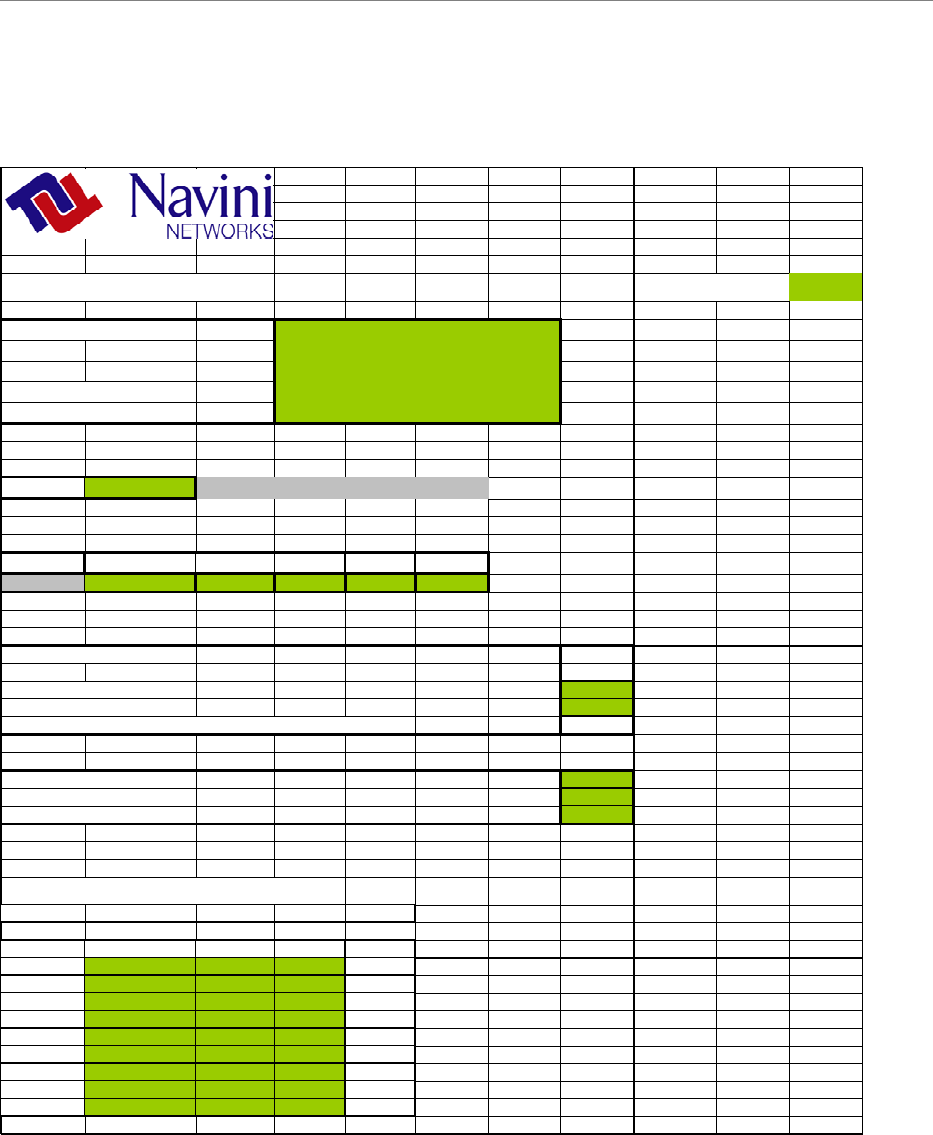
Ripwave Base Station I&C Guide Navini Networks, Inc.
180 Part #40-00047-00 Rev D v1.0
February 28, 2003
Calibration Verification Form
General information Data input by user
Site Name
BTS ID Test data #1
Date 9/16/2002
Software release 1.13
Personnel
2.4 GHz MHz
2.6 GHz E1 E2 E3 F1 F2
Cal path loss (averaged) -33.0
RX sensitivity (set in EMS) -90.0
Test cable loss -2.0
RF power injected at cal cable to get sensitivity at antenna -55.0
Antenna power (in EMS)= 18.0
Coupler/test cable loss = -22.0
Antenna gain= 8.0
Cable and RFS performance
Cable Loss
Cable Low Mid High Avg. loss
1 -6.0 -6.0 -6.0 -6.0
2 -6.0 -6.0 -6.0 -6.0
3 -6.0 -6.0 -6.0 -6.0
4 -6.0 -6.0 -6.0 -6.0
5 -6.0 -6.0 -6.0 -6.0
6 -6.0 -6.0 -6.0 -6.0
7 -6.0 -6.0 -6.0 -6.0
8 -6.0 -6.0 -6.0 -6.0
cal -6.0 -6.0 -6.0 -6.0
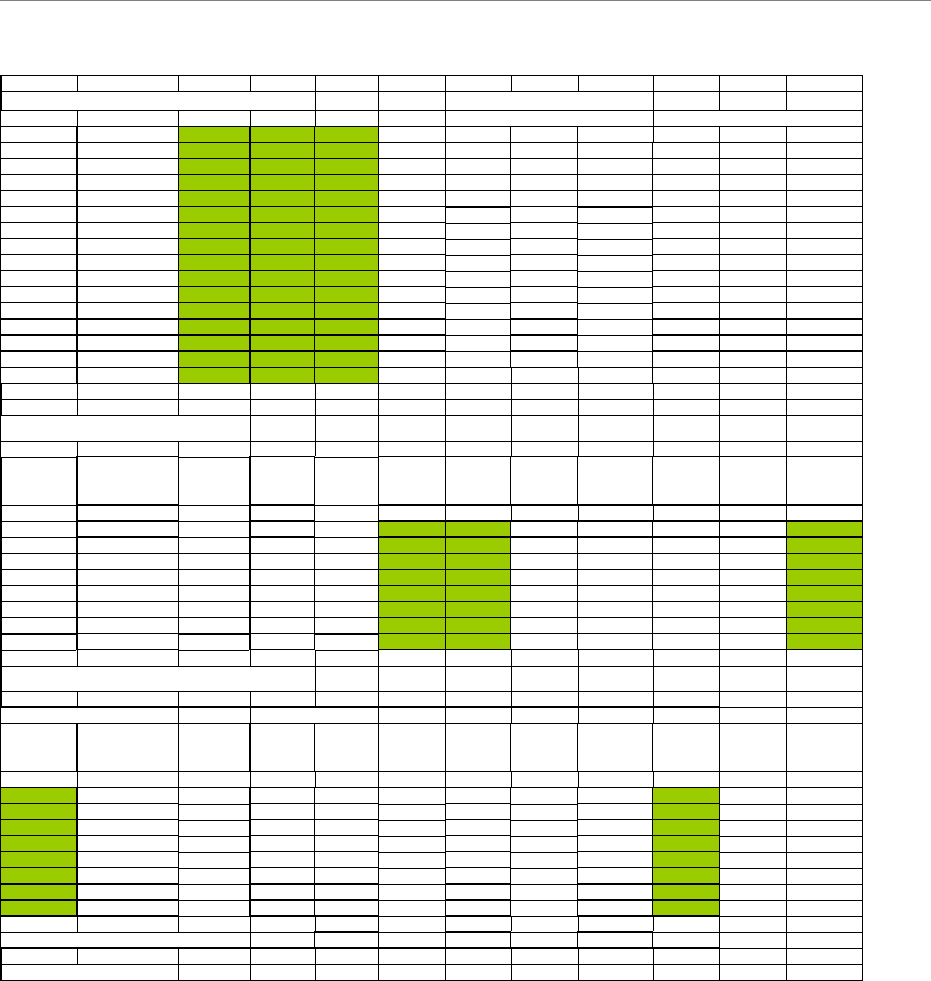
Navini Networks, Inc. Ripwave Base Station I&C Guide
Part #40-00047-00 Rev D v1.0 181
February 28, 2003
Insertion loss thru cal cable and RFS Cal path loss LNA gain
Low Mid High Average (calculated) (calculated)
1TX path -42.0 -42.0 -42.0 -42.0 -33.0
RX path -22.0 -22.0 -22.0 -22.0 20.0 20.0 20.0
2TX path -42.0 -42.0 -42.0 -42.0 -33.0
RX path -22.0 -22.0 -22.0 -22.0 20.0 20.0 20.0
3TX path -42.0 -42.0 -42.0 -42.0 -33.0
RX path -22.0 -22.0 -22.0 -22.0 20.0 20.0 20.0
4TX path -42.0 -42.0 -42.0 -42.0 -33.0
RX path -22.0 -22.0 -22.0 -22.0 20.0 20.0 20.0
5TX path -42.0 -42.0 -42.0 -42.0 -33.0
RX path -22.0 -22.0 -22.0 -22.0 20.0 20.0 20.0
6TX path -42.0 -42.0 -42.0 -42.0 -33.0
RX path -22.0 -22.0 -22.0 -22.0 20.0 20.0 20.0
7TX path -42.0 -42.0 -42.0 -42.0 -33.0
RX path -22.0 -22.0 -22.0 -22.0 20.0 20.0 20.0
8TX path -42.0 -42.0 -42.0 -42.0 -33.0
RX path -22.0 -22.0 -22.0 -22.0 20.0 20.0 20.0
Reciever performance
Backplane Slot
and pin #
Test CHP
card
Noise
level
(mVrms)
Noise +
Signal
(mVrms) Signal SNR
Noise
Power
Relative
Noise
figure
RX Gain
(DAC) word
Ant 1 CH-A-2d Jack
A
40.0 125.0 118.4 9.9 -99.9 6.1 150
Ant 2 CH-A-6d Jack B 40.0 125.0 118.4 9.9 -99.9 6.1 150
Ant 3 CH-A-10d Jack C 40.0 125.0 118.4 9.9 -99.9 6.1 150
Ant 4 CH-A-14d Jack D 40.0 125.0 118.4 9.9 -99.9 6.1 150
Ant 5 CH-B-2d Jack
A
40.0 125.0 118.4 9.9 -99.9 6.1 150
Ant 6 CH-B-6d Jack B 40.0 125.0 118.4 9.9 -99.9 6.1 150
Ant 7 CH-B-10d Jack C 40.0 125.0 118.4 9.9 -99.9 6.1 150
Ant 8 CH-B-14d Jack D 40.0 125.0 118.4 9.9 -99.9 6.1 150
Transmitter Performance
Analyzer readings P out Transceive
r
Peak RMS
Power
(peak)
Power
(RMS)
Power at
antenna
(RMS)
Radiated
power
(
RMS
)
TX Gain
(DAC
word
)
15.0 5.5 37.0 27.5 18.5 26.5 200
15.0 5.5 37.0 27.5 18.5 26.5 200
15.0 5.5 37.0 27.5 18.5 26.5 200
15.0 5.5 37.0 27.5 18.5 26.5 200
15.0 5.5 37.0 27.5 18.5 26.5 200
15.0 5.5 37.0 27.5 18.5 26.5 200
15.0 5.5 37.0 27.5 18.5 26.5 200
15.0 5.5 37.0 27.5 18.5 26.5 200
Max power deviation across all antennea 0.0 0.0 0.0
P out = Power Out

Ripwave Base Station I&C Guide Navini Networks, Inc.
182 Part #40-00047-00 Rev D v1.0
February 28, 2003
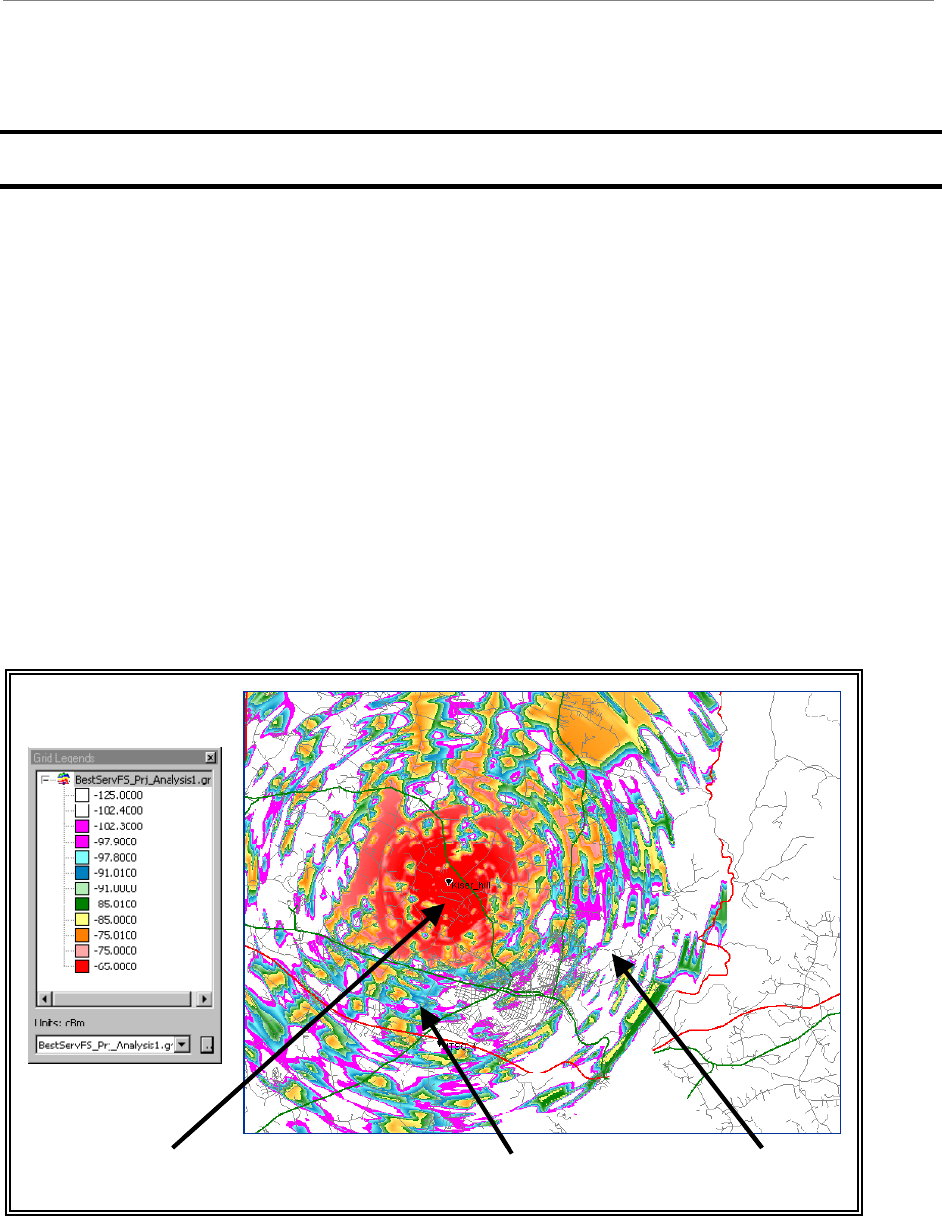
Navini Networks, Inc. Ripwave Base Station I&C Guide
Part #40-00047-00 Rev D v1.0 183
February 28, 2003
Appendix G: Drive Study
Overview
The Drive Study is performed to confirm Base Station coverage. It is used to validate that the
Base Station can be “seen” by a CPE throughout its predicted coverage area.
The RF coverage analysis displays areas of coverage from “good” to “bad” by the use of color-
coding. An RF coverage analysis and its legend may be seen in Figure G1. The legend on the left
displays the decibel strength for a given area, with red designating ‘good coverage’ and white
designating ‘bad coverage’. The RF coverage analysis is used to map out the Drive Study route
(Figure G2), along with geographic areas of concern. You should pay particular attention to null
(white) areas and the cell edges.
Figure G1: RF Coverage Analysis Example
Good coverage
area Medium
coverage area
Bad coverage
area
Good coverage
area Medium
coverage area
Bad coverage
area
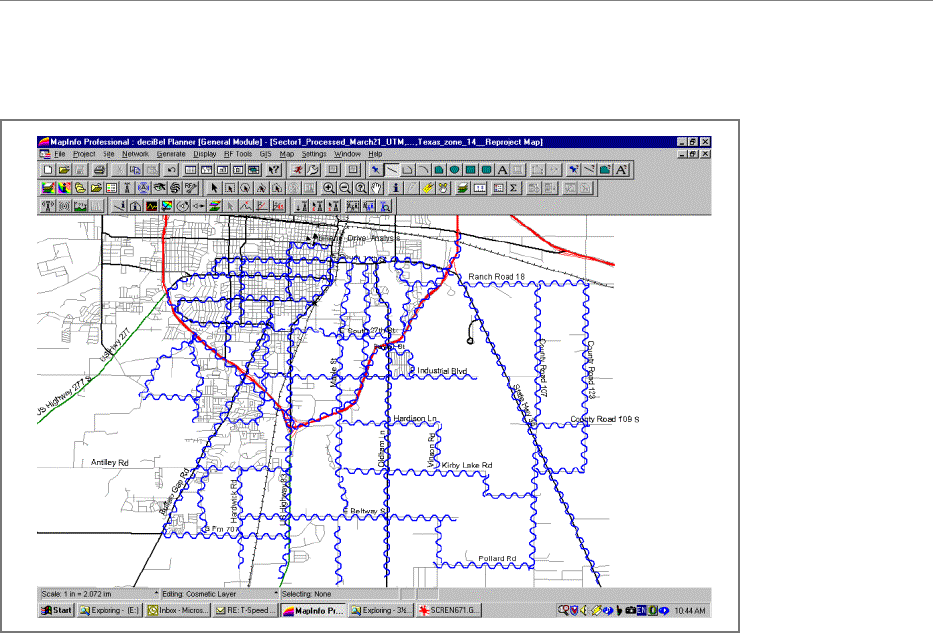
Ripwave Base Station I&C Guide Navini Networks, Inc.
184 Part #40-00047-00 Rev D v1.0
February 28, 2003
Figure G2: Drive Study Route Example
Equipment Required
• Omni-directional antenna mounted outside vehicle
• GPS with serial cable
• CPE
• Ethernet Cable
• CPE power supply
• DC to AC power converter
• Laptop computer
• Drive Study Form <shown later in this section>
Drive Test Procedure
While driving you will collect statistics to validate the coverage plot. The application takes a
reading every second and records the data in comma delimited file format. It is important to
ensure that the GPS is on and that you can see the GPS coordinates in the application.
Since the Ripwave system is not a mobile system, do not exceed 10 mph during the Drive Study.
Going any faster will negate the adaptive beamforming, as the vehicle will not be in the exact
position calculated by the Base Station.

Navini Networks, Inc. Ripwave Base Station I&C Guide
Part #40-00047-00 Rev D v1.0 185
February 28, 2003
Step 1. Ensure that the Base Station has successfully completed calibration and RF sanity
measurements at the frequency and TX/RX signal levels that were determined during
the site survey. Ensure that the Base Station is powered on and able to TX/RX data.
Step 2. Create a CPE Descriptor, and assign it to the CPE’s to be used for the Drive Study:
CPE Descriptor Parameters
Name: Drive Study
Index: Next available number
Priority: 1
UpLink Max Bandwidth: 64
UpLink Min Bandwidth: 32
DownLink Max Bandwidth: 96
DownLink Min Bandwidth: 64
Other parameters: Use defaults.
Step 3. Mount an omni-directional antenna on the roof of the vehicle. This will serve as the
antenna for the CPE.
Step 4. Bring the RF cable from the omni-directional antenna into the vehicle through the
window. Attach the antenna to the antenna input of the CPE. The rotating upright
antenna on the CPE needs to be removed to perform this step. You will also need to
disconnect the patch antennas inside (Figure G3).
Figure G3: Patch Antennas

Ripwave Base Station I&C Guide Navini Networks, Inc.
186 Part #40-00047-00 Rev D v1.0
February 28, 2003
Step 5. Connect the DC to AC power converter to the power port in the vehicle.
Step 6. If applicable, place the external antenna on the top of the vehicle.
Step 7. Connect the CPE power supply to the CPE and to the DC to AC power converter.
Step 8. Connect the Ethernet cable to the Ethernet port on the laptop computer and to the
Ethernet port on the CPE.
Step 9. Connect the GPS to the serial port on the laptop computer.
Step 10. Optional: Connect the laptop power supply to the DC to AC power converter. (The
laptop can be run off of its battery.)
Step 11. Power on the GPS and the laptop computer.
Step 12. On the laptop computer, start the Navini Networks Drive Study application.
Step 13. Verify that the GPS location – latitude, longitude, and time – is seen in the application.
Step 14. Power on the CPE.
Step 15. Enter a memo into the log file comment field of the Constellation Debugger about the
route of the Drive Study being performed. When finished, click the log comment
button.
Step 16. Start driving along the Drive Study route determined during the RF coverage analysis.
Do not exceed 10 - 15 mph.
Step 17. When testing is completed, prepare the file(s) to be sent back to Navini for post-
processing and analysis.
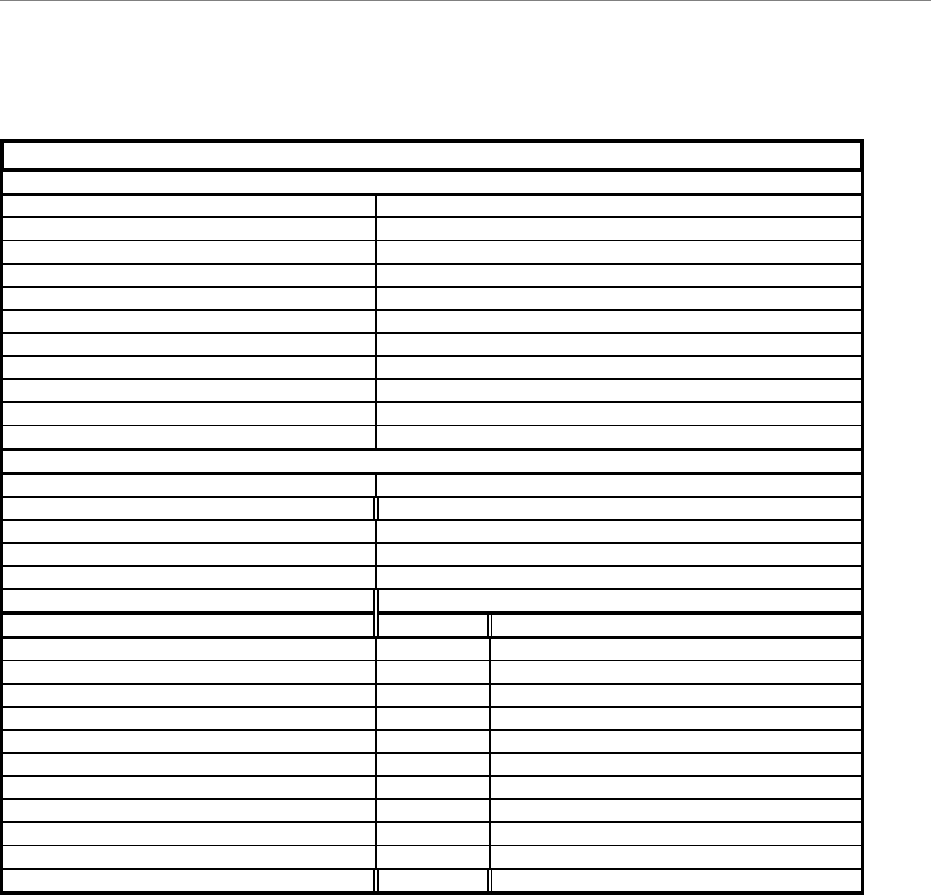
Navini Networks, Inc. Ripwave Base Station I&C Guide
Part #40-00047-00 Rev D v1.0 187
February 28, 2003
Drive Study Form
Drive test area name
Date of Drive Test
Drive Tester Name
Standard Vehicle Name and Type
CPE EID
Frequency Band (ISM, MMDS)
CPE test device RF cable loss (dB)
CPE Test device Antenna gain (calibrated)
Drive Route (Map attached)
Drive test file name
BTS Transmit Power
BTS ID
BTS antenna height
BTS antenna Omni/Patch
Mounted on the top or side
Antenna Azimuth
Antenna downtilt
Drive Test Route Plan Yes / No Typical Clutter Height
High Density Urban Covered
Commercial/Industrial
Residential with Trees
Residential with Few Trees
Paved Areas
Grass/Agriculture
Open Area
Forested Areas
Water
Airports
Others
Things to pay attention to:
1. Make sure that the GPS data on the constellation debugger is updating all the time during the drive te
s
2. Make sure that the antenna only selects the omni port all the time.
3. Make sure that the CPE is locked to the correct BTS by checking the BTS ID and frequency.
4. Make sure that the RF connections are good all the time. Check this by observing the stability of the
R
5. Please make proper log information in certain important locations.
Fill the site configuration
Navini Networks Drive Test Check list
Specify the following items before the drive test

Ripwave Base Station I&C Guide Navini Networks, Inc.
188 Part #40-00047-00 Rev D v1.0
February 28, 2003
Appendix H: Location (FTP) Tests
Introduction
The Location, or FTP, Test is performed to check the Ripwave system operation through file
transfers between the Base Station and the CPE. The test measures the data rate performance at
various locations within the coverage area. Data throughput is measured by executing file
transfers using the FTP protocol for both upstream and downstream links. A file server must be
in place on the same subnet with the BTS to accurately perform the file transfer, and the CPE
User computer must be loaded with an FTP Client. As the file transfer is running, a data file is
captured by the CPE tool. Data rates are captured by the FTP program.
Data is recorded in a spreadsheet format. The spreadsheet lists the location, GPS, and other
information. As data rates are captured, the results are entered manually. An average SNR and
sync RSSI can be read from the debug tool, and recorded, for quick comparison to the acceptable
criteria (see “Acceptable Criteria” section of this appendix). For NLOS indoor locations, tests are
performed both outside the building and inside, so that the obstruction loss for the building can
be determined. Unless the customer can provide indoor access, all results will be LOS or Near
NLOS.
Planning the Locations
Before the actual testing is conducted, you will need to select the locations for the testing to
occur. The sites should meet specific criteria and include a mixture of the following
environments:
• High Power (A), low clutter; close in, residential
• High Power (A), high clutter; close in, commercial
• Medium Power (B), low clutter; mid-range, residential
• Medium Power (B), high clutter; mid-range, commercial
• Low Power (C), low clutter; distant, residential
• Lower Power (C), high clutter; distant, commercial
Where:
(A) High Power is equal to > -70 dBm sync value
(B) Medium Power is equal to < -70 dBm and > -85 dBm sync value
(C) Low Power is equal to < -85 dBm, but > -95 dBm sync value
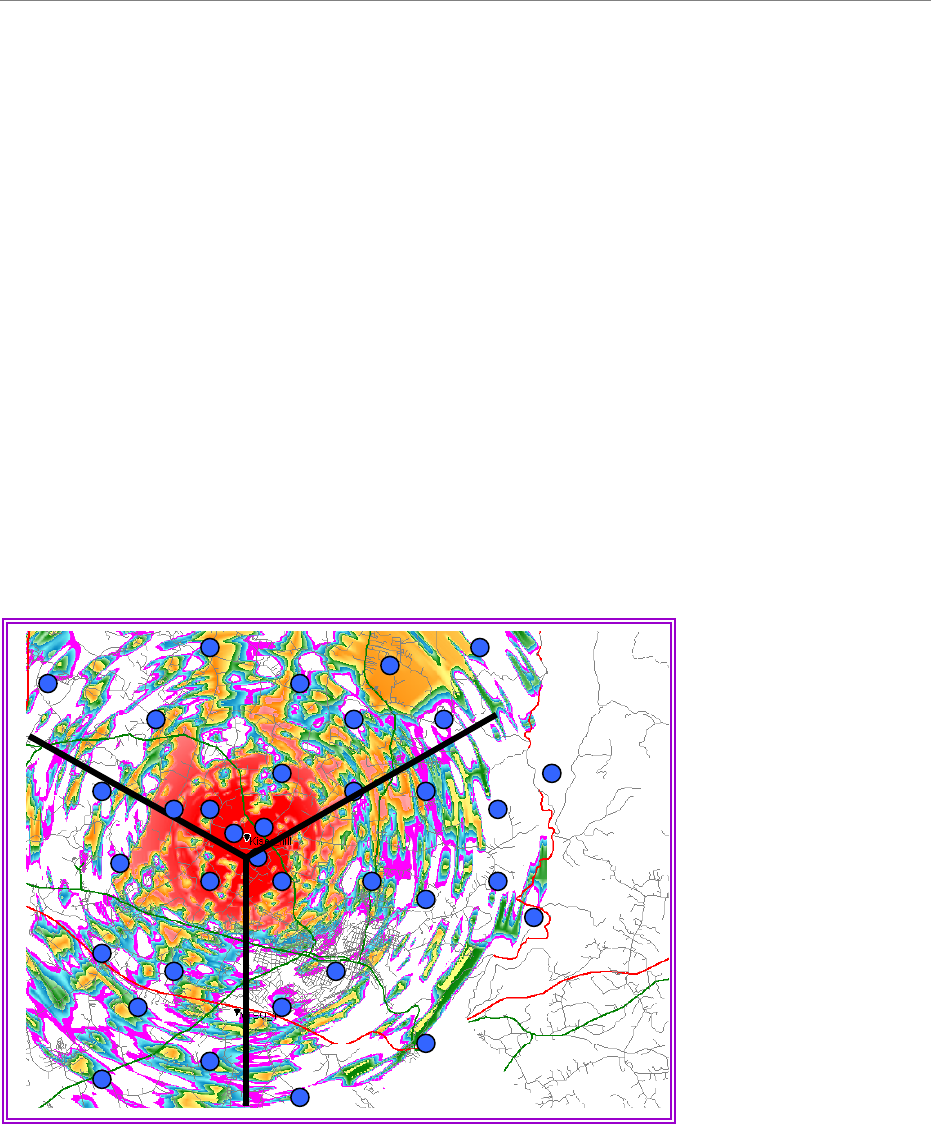
Navini Networks, Inc. Ripwave Base Station I&C Guide
Part #40-00047-00 Rev D v1.0 189
February 28, 2003
At least 5 test points for each type are attempted. This may be difficult, depending upon the
actual deployment scenario. Results may yield a very large percentage in one of the categories.
For selecting an even spread across a 120 degree sector for a panel antenna installation, divide
the 120 degrees into 6 even slices of 20 degrees each. Then divide each slice into 2 Km
segments. This spaces each location at an approximate even distance throughout the complete
sector and yields 36 test sites.
To select an even spread across a 360 degree cell for an omni antenna installation, divide the 360
degree cell into 12 even slices of 30 degrees each. Next, divide each slice into segments based on
distance (1 Km or 2 Km, depending upon propagation). This will approximately space each
location an even distance from each other throughout the complete cell, yielding approximately
48 test sites (based on a 4 Km cell radius). To do this, split the cell into 4 quadrants. Using the
RF coverage analysis, select up to 16 locations per quadrant (Figure H1). Pay particular attention
to null areas and the cell edges. At these locations you will perform a file transfer to measure the
data rates available. The FTP/Location Test Tool program and the BTS Beamforming Display
tool will be used to record RF parameters during each test. Figures H1 and H2 provide examples
of simple guidelines for selecting an even spread across a cell area.
Figure H1: Example of a 3-sector Site
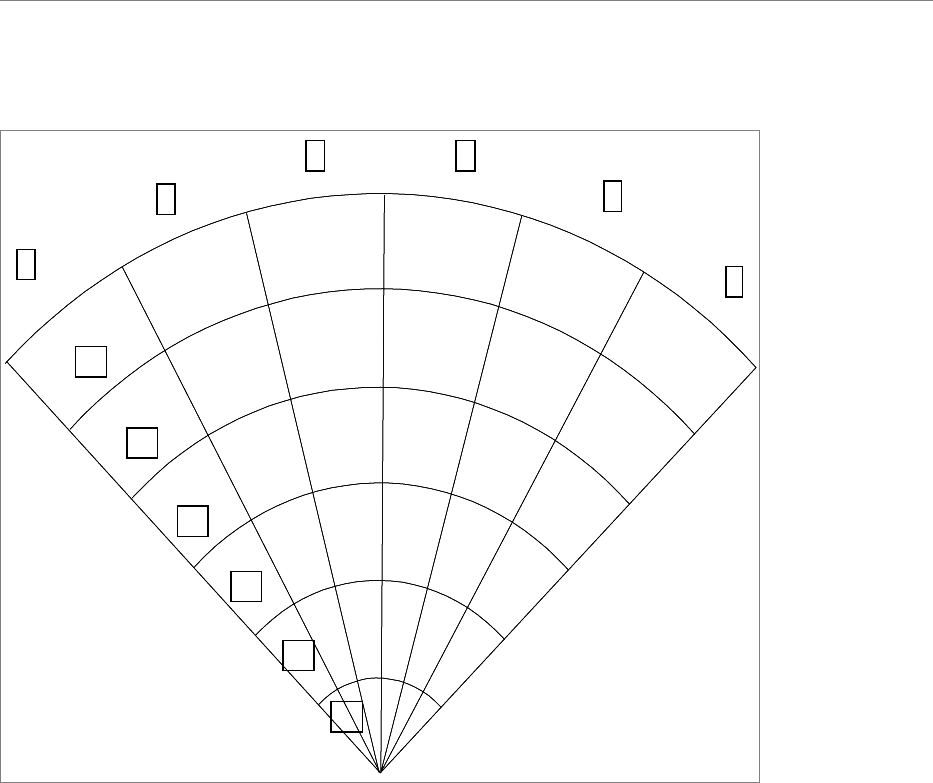
Ripwave Base Station I&C Guide Navini Networks, Inc.
190 Part #40-00047-00 Rev D v1.0
February 28, 2003
Figure H2: Example of 120° of an Omni Site
Acceptable Criteria
In order to evaluate the test results, several criteria are reviewed. These criteria are valid for both
LOS and NLOS measurements.
Processed Sync Signal Strength: For a given test location, +/- 2 dB variation during FTP
Absolute Sync Signal Strength - Processed Sync Signal Strength: <= to 2 dB variation during
FTP
SNR values consistent during the FTP for all carriers used:
a. QPSK: >= 11 dB
b. 8 PSK: >= 16 dB
c. QAM 16: >= 19 dB
UL and DL Packet Error Rates (PER) <= 1%. This will vary according to interference levels,
but may not render the system inoperable.
Uplink Beamforming Gain: <= 21 dB and >= 16 dB. Perform a comparison of UL and DL,
Beamforming Gain differences should be <= 3 dB.
A
B
C D
E
F
A1
A2
A3
A4
A5
A6
A
B
C D
E
F
A1
A2
A3
A4
A5
A6
A
B
C D
E
F
A1
A2
A3
A4
A5
A6

Navini Networks, Inc. Ripwave Base Station I&C Guide
Part #40-00047-00 Rev D v1.0 191
February 28, 2003
CPE Transmit Power < 25 dBm; BTS Transmit Power < 0 dBm per code channel with power
control
Sync vs. Data Rate:
Absolute Sync (dBm) UL Data Rate (Mbps) DL Data Rate (Mbps)
(A) -55 to -70 0.6 to 1.0 1.5 to 2.0
(B) -70 to -85 0.5 to 1.0 1.2 to 2.0
(C) -85 to -95 0.10 to 0.5 0.3 to 1.0
Process
The recommended process for performing the Location (FTP) tests is described below.
First: Verify that a single CPE transmits and receives data at expected rates, as indicated
previously.
Second: Verify that multiple CPE’s simultaneously transmit and receive data at acceptable rates,
and the parameters listed above are being met. NOTE: The exact number of CPE’s is determined
by field conditions. The minimum is two.
Third: Verify operation at the full range of the system*. Include LOS Location Tests at cell
edges. The height of CPE and uplink and downlink data rates are recorded for each site. Data
rates are to be compared with expected results, as seen in the last item (Sync vs. Data Rate) of
Acceptance Criteria. For example:
*2.6 GHz : ~12 Km
*2.4 GHz: ~ 3 Km
Equipment Required
• Laptop computer
• GPS with serial cable
• FTP/Location Test Tool application
• BTS Beamforming diagnostic tool
• CPE
• CPE power supply
• DC to AC power converter
• Ethernet Cable

Ripwave Base Station I&C Guide Navini Networks, Inc.
192 Part #40-00047-00 Rev D v1.0
February 28, 2003
Location (FTP) Test Procedure
Two people are needed to perform this procedure. One will be in the car performing the location
test, and the other will be at the Base Station checking the operation using the BTS Beamforming
diagnostic tool.
1. Ensure that the Base Station has successfully completed calibration, RF sanity
measurements, and the Drive Study at the frequency and TX/RX signal levels that were
determined by the cell site survey. Also ensure that the Base Station is powered on and is
able to transmit and receive data.
2. Connect the DC to AC power converter to the power port in the vehicle.
3. Connect the CPE power supply to the CPE and to the DC to AC power converter.
4. Connect the Ethernet cable to the Ethernet port on the laptop computer and to the Ethernet
port on the CPE.
5. Connect the GPS to the serial port on the laptop computer.
6. Drive to one of the locations selected on the RF coverage analysis. Stop and turn off the
vehicle.
7. Power on the GPS, the CPE, and the laptop computer. Place the CPE on the roof of the
vehicle.
8. Start the Navini Networks FTP/Location Test Tool program.
9. Verify that the Base Station is transmitting and that the CPE establishes sync and can
communicate with the Base Station. Ping a device address on the network side of the Base
Station, and verify that a reply is received. While monitoring the Constellation Debugger,
position the CPE to reduce the difference between absolute sync and processed sync levels to
2 or less.
10. Enter a memo into the comment field about which link of the test is being performed.
11. Verify that the GPS input is seen in the application.
12. Put the location number/site identifier into the comment field of the Navini Networks
Constellation Debugger, and press the Enter key. This will identify the site location.
13. On the EMS connected to the Base Station, start the BTS Beamforming diagnostic tool.
14. From the laptop computer with the CPE connected to it, start a downlink FTP file transfer.
Record the results on the site page or in the log.
15. On the EMS connected to the Base Station, using the BTS Beamforming diagnostic tool
verify the strength and direction of the beam during the file transfer. Record the results on the
site page or in the log.
16. Repeat the file transfer three times, stopping and starting the Debugger and Beamforming
tool for each transfer
17. Repeat steps 14-15, this time performing an uplink FTP transfer.

Navini Networks, Inc. Ripwave Base Station I&C Guide
Part #40-00047-00 Rev D v1.0 193
February 28, 2003
18. When finished, remove the CPE from the roof and secure equipment for travel.
19. Drive to the next location selected on the RF coverage analysis. Stop, and turn off the
vehicle.
20. Repeat steps 7 to 19 until all locations are tested. At this point send this data to the RF
Engineers to analyze, or continue until each quadrant in the cell is complete. When you send
the results depends upon the schedule or results from the file transfers.
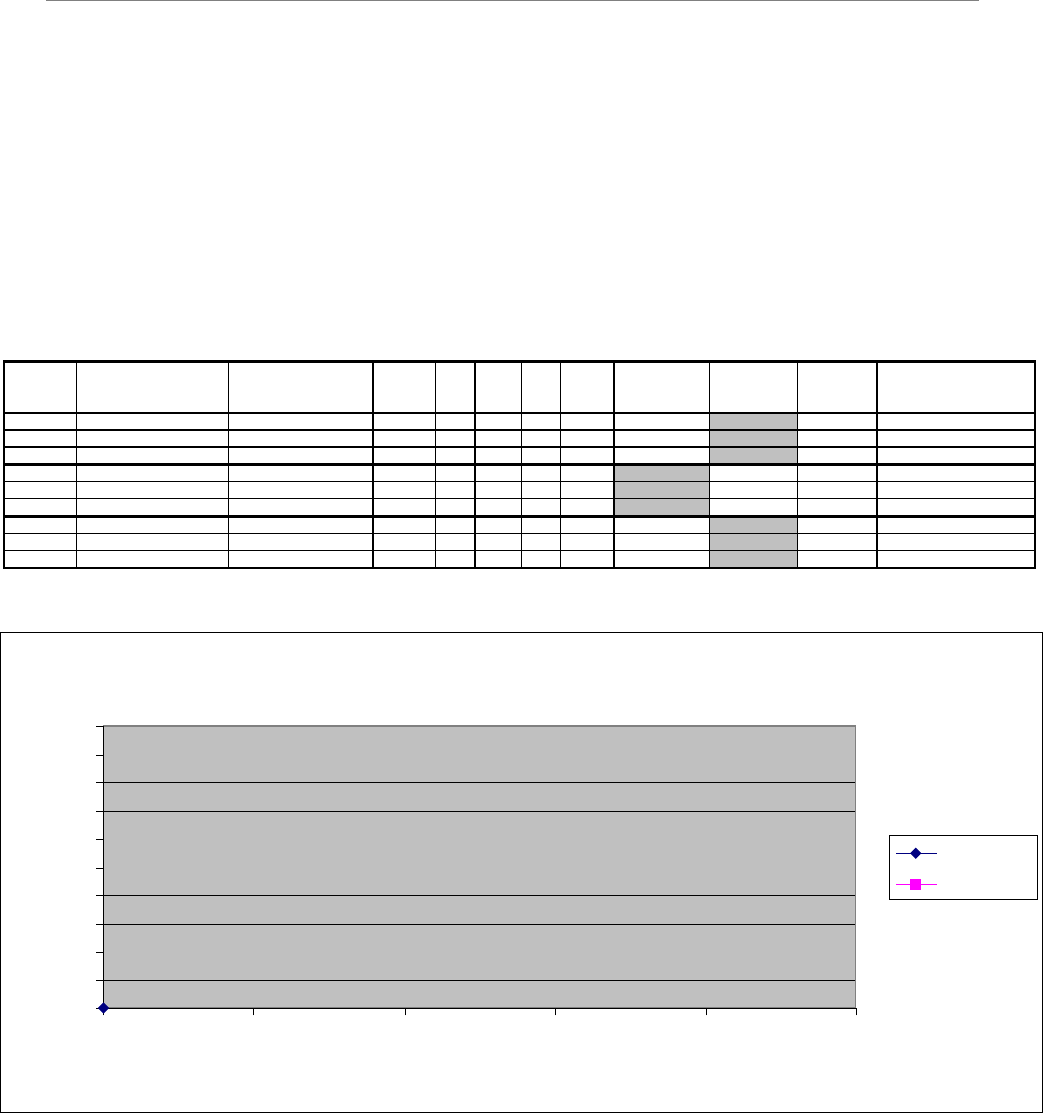
Ripwave Base Station I&C Guide Navini Networks, Inc.
194 Part #40-00047-00 Rev D v1.0
February 28, 2003
Location (FTP) Test Form
The form for recording the Location (FTP) test results is an Excel spreadsheet. Shown in Table
H1, the actual column headers go across the top of the form, but are broken into two sections
here for readability.
Table H1: Location (FTP) Test Form
BTS ID Sector Software Release
Site name File name; CPE File name; BTS
Distance
(Km) LOS NLOS CPE
CPE w/
ext
FTP
D
a
t
a
R
a
t
e
Downlink
(Kbps)
FTP
D
a
t
a
Rate Uplink
(Kbps)
Absolute
Sync (dB) Remarks
00
0
288
0
0.1
0.2
0.3
0.4
0.5
0.6
0.7
0.8
0.9
1
0 0.2 0.4 0.6 0.8 1
distance Km
data rate Mbps
Downlink
Uplink
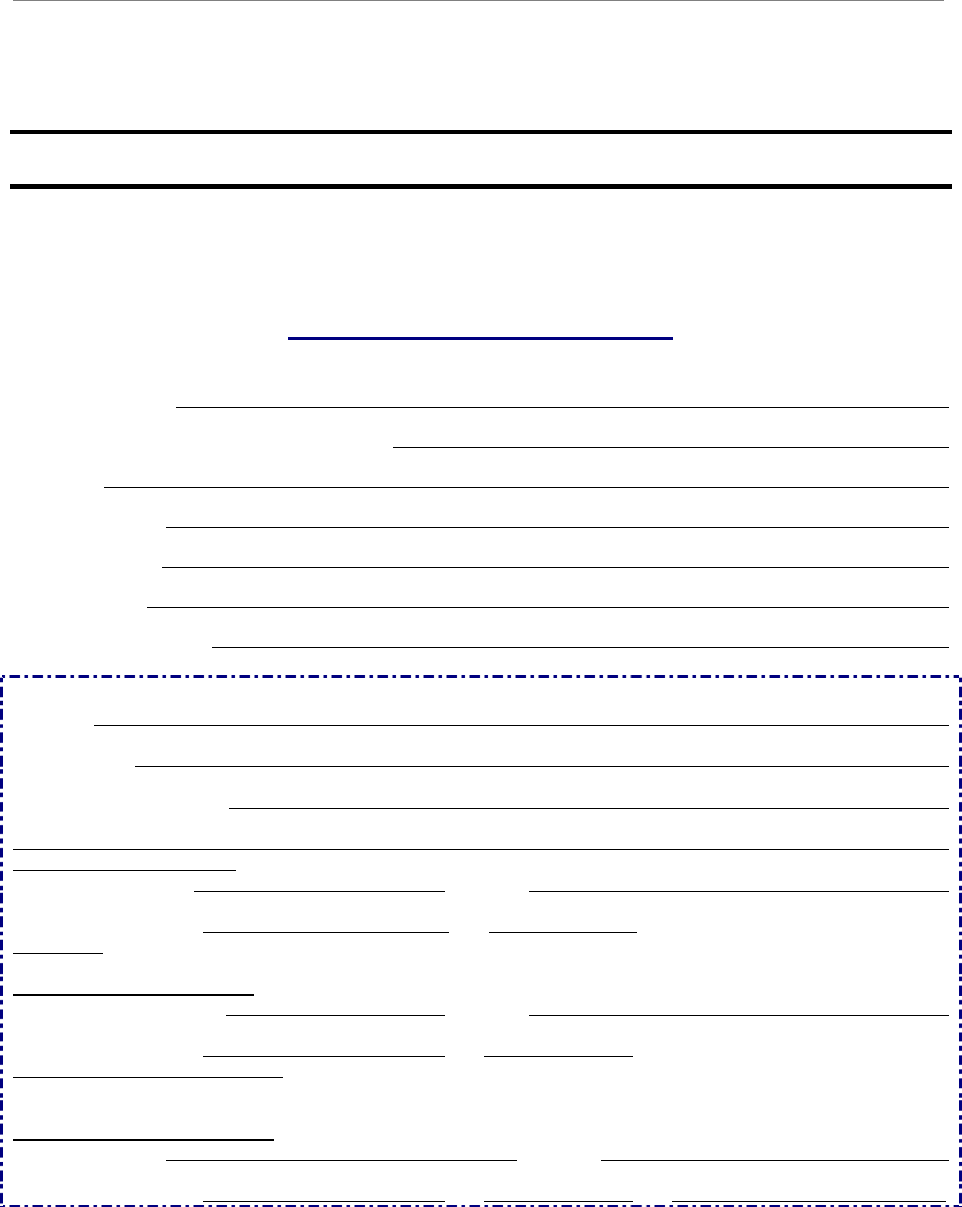
Navini Networks, Inc. Ripwave Base Station I&C Guide
Part #40-00047-00 Rev D v1.0 195
February 28, 2003
Appendix I: Customer Acceptance
Base Station Installation & Commissioning Services
Customer Acceptance Form
Customer Name:
Customer’s Authorized Representative:
Job Title:
Office Address:
Email Address:
Office Phone:
Cell Phone or Pager:
Site Name:
Site Description: ________
Site Physical Address:
INSTALLATION SECTION:
Date Installation Started: Completed: ________
Customer Acceptance By: _____________________ Title: ________________Date:
__________
COMMISSIONING SECTION:
Date Commissioning Started: Completed: _________
Customer Acceptance By: _____________________ Title: ________________Date:
______________________________
TEST ACCEPTANCE SECTION:
Date Testing Started: Completed:
Customer Acceptance By: _____________________ Title: ________________Date: ______________________________

Ripwave Base Station I&C Guide Navini Networks, Inc.
196 Part #40-00047-00 Rev D v1.0
February 28, 2003
This Customer Acceptance Form is subject to and governed by all of the terms and conditions set
forth in the Master Supply Agreement between the parties. The Customer acknowledges,
understands and agrees that when it’s Authorized Representative signs-off the Test Acceptance
Section of this Form, Customer has thoroughly inspected the installation and commissioning
services, and Customer’s sign-off means that completion of on-site verification that the
Equipment installed by Seller performs in accordance with the Acceptance Criteria set forth in
the Master Supply Agreement between the parties. The completed Navini Networks’ Site
Installation and Commissioning Documents referenced below and attached hereto are
incorporated by reference into this Customer Acceptance Form for all purposes.
Navini Networks Site Installation and Commissioning Documents (double-click on the box to
check or de-select a checkmark when completing the form):
Site Candidate Evaluation Report
Site Materials BoM
Site Drawings
Site Construction Specific Tests, as required – Grounding System Test Results, Concrete
Break Test Results, Tower Guy Tensioning Test Results, etc.
Site Specific Digital Photographs, as Required
RFS System Tests
Base Station Installation Certification
Base Station Calibration Verification
Location (FTP) Tests
Drive Studies
Coverage Predictions Maps
Soft Copies of Test Results, if Requested

Navini Networks, Inc. Ripwave Base Station I&C Guide
Part #40-00047-00 Rev D v1.0 197
February 28, 2003
Appendix J: Outdoor Enclosures
Overview
The information in this Appendix is intended to assist Navini Networks’ customers in identifying
typical features and requirements for an outdoor telecommunications equipment enclosure
(outdoor cabinet or cabinet) that is compatible with Navini Networks Base Transceiver Station
(BTS) equipment. This document is not intended to be an all-inclusive explanation of outdoor
cabinet design and selection requirements.
Instead, it is focused on providing customers with design suggestions for an outdoor cabinet that
will attempt to replicate an environmentally controlled indoor environment for Navini Networks
BTS equipment. Additionally, other design and performance suggestions are provided in an
effort to assist customers, who may be unfamiliar with developing requirements for outdoor
cabinets, to communicate more effectively a set of design and performance requirements to a
cabinet manufacturer.
The information in this document pertains only to Navini Networks BTS equipment. Customers
are advised to consult with a manufacturer specializing in the construction of customized outdoor
cabinets and to take the manufacturer’s recommendations for designing an outdoor cabinet that
will meet Navini Networks BTS equipment installation and operating requirements.
Due to (a) customer-specific site installation requirements and/or installation standards and the
use of customer supplied ancillary equipment, including but not limited to rectifiers, batteries,
microwave radios, networking equipment, network interface equipment, or other electronic,
electrical, and mechanical components, and (b) customer supplied third-party installation
services, Navini Networks cannot guarantee the operational performance of BTS equipment
installed within an outdoor cabinet that does not maintain an operating environment within the
defined operating parameters of the Navini Networks BTS equipment.
Navini Networks does not manufacture or sell outdoor cabinets, and does not recommend
the use of any particular manufacturer’s outdoor cabinet.
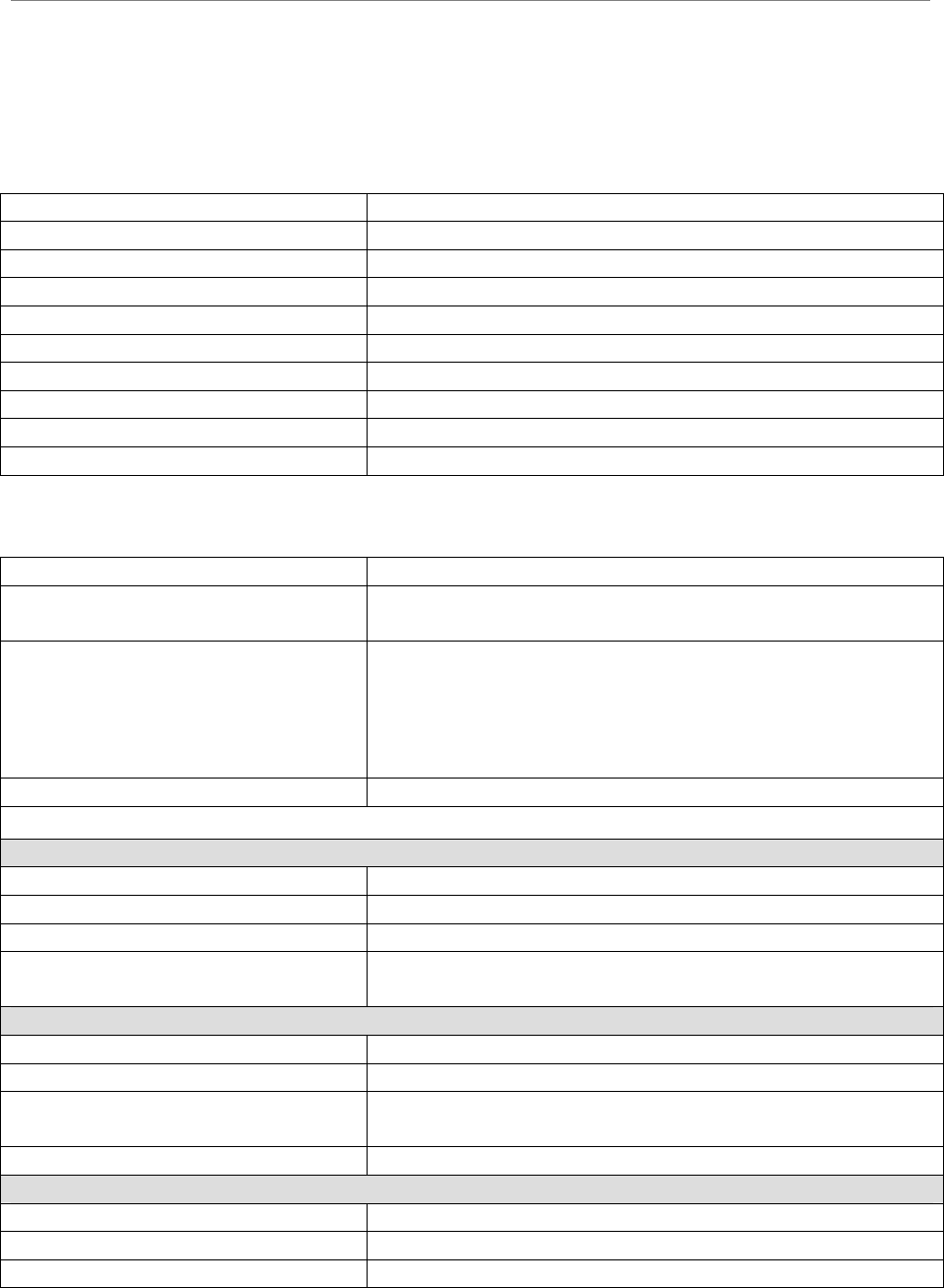
Ripwave Base Station I&C Guide Navini Networks, Inc.
198 Part #40-00047-00 Rev D v1.0
February 28, 2003
BTS Mechanical & Electrical Specifications
Table J1: 2.6 GHz BTS
Physical: 2.3, 2.6GHz Split Digital & RF Chassis
Mechanical Dimensions Digital: 19” X 19” X 13” (HWD)
Mechanical Dimensions RF 14” X 19” X 13” (HWD)
DC Power: 1,353 Watts, 21VDC to 28VDC @ 56A (4,618 BTU)
DC Power Interface: 2 - ¼” lugs for +24Vdc and 24VReturn
Operational Temperature Range: 0 to +50 degrees C
Storage Temperature Range: -40 to +70 degrees C
Weight: 100 lbs.
Service Accessibility: Front and rear access required
Humidity: 0 to 95% non-condensing
Table J2: BTS to RFS Interface
RFS Antenna (per BTS): 8 Type N Female Connectors
RFS Antenna Calibration (per
BTS):
1 Type N Female Connector
RFS Antenna Power/Data (per
BTS):
Burndy G6B14-92PNE-32 Power Connector (1.0625”
OD). The power connector is part of a pre-terminated
cable assembly ordered in 25’ increments. The power
data cable assembly utilizes an Alpha Wire (P/N 5136C)
composite cable.
GPS Antenna: 2 Type N Female Connectors
Network (WAN) Interfaces
T1/E1 Interface
Number of T1/E1’s: 8
Standards Compliance: ANSI, Bellcore ANSI T1.403
Line Coding: AMI/B8ZS
Inverse Multiplexing ATM
(IMA):
Spec 1.1
ATM
Standards Compliance: UNI 4.0
Number of PVC’s: 2000
ATM Adaptation: AAL5 ATM Adaptation (VBR real, VBR Non-Real,
UBR)
Bridging Protocol: RFC 1483 (LLC, SNAP)
Ethernet
Standards Compliance: 10/100BaseT (Ipv4) Ethernet
QoS: Diffserv, Class based queuing (3 priority queues), WFQ
Packet Format: IEEE 802.3 / Ethernet II

Navini Networks, Inc. Ripwave Base Station I&C Guide
Part #40-00047-00 Rev D v1.0 199
February 28, 2003
Outdoor Cabinet Features & Considerations
General
Outdoor cabinets are designed to house electronic equipment, electrical equipment, and other
ancillary components (equipment) in outdoor environments where temperature, dirt, dust, oil,
water, and other contaminants may be a factor in the operation of the equipment.
Cabinet Construction
Frames, Doors & Mounting Rails
Outdoor cabinets may have any number of metallic and non-metallic (non-conductive) corrosion
resistant materials in their construction. Predominantly due to a combination of acceptable
overall cost, strength, weight, and corrosion resistance, .125 (1/8”) thick 5052 H32 aluminum or
other similar alloys are typically utilized in cabinet construction. Aluminum alloys provide
approximately the same stiffness as steel at about half the weight of steel, even though about
40% more aluminum is required to attain the same stiffness as steel.
Fabrication
Outdoor cabinets are typically constructed of a combination of welded, bolted, hinged, or
screwed panels attached or bonded to structural components. Construction methods used are
determined by a combination of price and function.
NEMA Rating
Outdoor cabinets normally utilize fabrication and assembly methods that will meet NEMA Type
3R or Type 4 rating requirements. The use of either NEMA Type 3R or Type 4 cabinets is
subject to the customer’s specific design requirements. Other types of NEMA rated enclosures
may be provided by a cabinet manufacturer to meet customer design requirements.
NEMA Type 4
NEMA Type 4 enclosures are rated for indoor or outdoor use to provide a degree of protection
against splashing water, windblown dust and rain, and hose directed water, and to remain
undamaged by the formation of ice on the enclosure. NEMA Type 4 enclosures do not provide
protection against submersion. Gaskets are typically utilized to provide weather tight seals for
hinged, bolted, and screwed panels on NEMA 4 rated enclosures.

Ripwave Base Station I&C Guide Navini Networks, Inc.
200 Part #40-00047-00 Rev D v1.0
February 28, 2003
NEMA Type 3R
NEMA Type 3R enclosures are rated for indoor or outdoor use to provide a degree of protection
against falling rain and sleet and to remain undamaged by the formation of ice on the enclosure.
NEMA Type 3R enclosures do not provide protection against submersion. Typical examples of
NEMA 3R cabinets are external enclosures containing above-ground electrical panels, and other
equipment, that may or may not require ventilation
Finishes
Outdoor cabinets are normally finished with UV resistant powder-coated polyurethane coatings.
The finishes are baked on after coating, provide excellent resistance to damage, are very durable,
and provide superior corrosion resistance. Normal colors are tan, white, and green, in shades
typically used by traditional telecom service providers. Other types of coatings and colors may
be available from a cabinet manufacturer to meet specific zoning requirements. In the event that
a cabinet manufacturer is unable to provide a specific custom color, the cabinet manufacturer
will usually be able to provide a refinishing process and third-party coating sources that can
supply coatings that are compatible with the original factory finish.
Bullet Resistance
Due to the emphasis on being light-weight, low maintenance, and corrosion resistance, outdoor
cabinets are not normally constructed to provide bullet resistance, although a cabinet
manufacturer may be able to provide this functionality.
Expandability
Outdoor cabinets come in both single- and multi-cabinet styles in order to meet the design
criteria of the customer. Manufacturer designs of multi-bay cabinets may utilize either single
cabinet modular sections that bolt together to form larger multi-bay cabinets with seals between
cabinets, or welded multi-bay cabinets that do not utilize seals between cabinet equipment
mounting bays. Care should be taken to ensure that multi-bay cabinet designs or expansions of
single-bay cabinets provide adequate airflow between cabinet equipment bays.
Lifting Eyes
Cabinets are usually equipped by the manufacturer with lifting eyes to permit placement on site
using a crane. Depending on the manufacturer, the lifting eyes may or may not be removable.
Equipment Access
BTS equipment will require an outdoor cabinet that provides front and rear access for installation
and maintenance of the BTS equipment.

Navini Networks, Inc. Ripwave Base Station I&C Guide
Part #40-00047-00 Rev D v1.0 201
February 28, 2003
Sizing
Outdoor cabinets should be sized or designed to provide:
• Unrestricted maintenance access to all installed equipment, wiring, cabling, and conduits by
field maintenance personnel.
• Placement of equipment at internal mounting elevations, relative to ground level, that will
provide field maintenance personnel with access to installed equipment at reasonable
working heights, for all or the majority of installed equipment. These requirements may be
met through the use of base extenders, bottom mounted battery cabinets, taller equipment
bays, or a combination of all of these design techniques.
• Sufficient space for the routing and termination of all internal wiring, cables, and conduits,
consistent with minimum bend radius requirements, and direction and/or manner of entry
into or out of the equipment cabinet.
• Sufficient space in front of, behind, above, and below installed equipment to allow for
unrestricted airflow within the cabinet.
• Sufficient reserve space in front of, behind, above, and below installed equipment to support
minor changes to installed equipment mechanical dimensions, as a result of changes in
vendor equipment utilized, or to support future vendor equipment design modifications.
Optional Cabinet Components
Integral AC Load Center
Integral AC load centers provide the ability to connect the outdoor cabinet’s commercial AC
power input directly to a power utility transformer. A typical load center will employ a meter
base, service disconnect, and breaker equipped load center, installed on the cabinet by the
manufacturer.
Advantages
Factory installation of an integral AC load center offers lower field installation costs; quicker
cabinet field deployment; improved site installation quality; and reduced instances of cabinet
damage caused by installation personnel unfamiliar with the cabinet design, construction,
penetration, and weather sealing requirements.
Disadvantages
Higher initial costs.

Ripwave Base Station I&C Guide Navini Networks, Inc.
202 Part #40-00047-00 Rev D v1.0
February 28, 2003
Air Conditioner(s)
Air conditioners provide active cooling to equipment in the outdoor cabinet and are normally
used on cabinets where thermoelectric coolers, multiple air insulated walls, Air to Air Heat
Exchangers, and Forced Air cooling do not provide adequate capability to maintain internal
cabinet air temperatures within acceptable ranges for installed equipment. Air conditioners may
be equipped with economizers to reduce operating costs, as well as heat strips, to prevent ice
formation on the evaporator coils, and heat to the interior of the cabinet. The use of air
conditioners requires careful consideration of airflow within the interior of the cabinet, to ensure
that adequate cooling is provided to all equipment in the cabinet and that hot spots are not
created.
Sizing
Air conditioners should be sized to provide for an optimal duty cycle and reserve cooling
capacity. A high duty cycle will typically lead to early failure of the air conditioner, since air
conditioners are not normally intended to have an extremely high duty cycle. Significant over-
sizing of an air conditioner will lead to inefficient operation and greater initial air conditioner
and cabinet costs required to support the larger air conditioner.
Consideration should be given to providing a percentage of reserve capacity to allow for
additions to the installed equipment, increases in power requirements of installed equipment, and
loss of efficiency of the air conditioner due to age or leakage of refrigerant over time. Reserve
capacity is likely to be reflected in a reduced duty cycle for the installed air conditioner.
Advantages
Air conditioners can be sized to support thermal loads in excess of those that can be managed
with other active and passive cooling techniques. Additionally, internal cabinet temperatures and
humidity levels can be maintained at consistent levels, which may contribute to greater
equipment stability and longevity.
Disadvantages
The loss of commercial power to an outdoor cabinet equipped with an air conditioner and a
backup power system may not prevent the site from failing, even if adequate backup power
exists to power the equipment installed in the cabinet for the duration of the power outage, due to
the inability of the backup power system to operate the air conditioner. Without the air
conditioner removing waste heat generated by the equipment installed in the cabinet and by heat
contributed by solar gain, during summer months, the internal air temperature inside the cabinet
may reach a sufficiently high level to cause failure to one or more pieces of installed equipment
within the cabinet, as a result of overheating. Additionally, utility costs and maintenance costs
will be higher for sites with air conditioners installed in an outdoor cabinet.

Navini Networks, Inc. Ripwave Base Station I&C Guide
Part #40-00047-00 Rev D v1.0 203
February 28, 2003
Backup Power System
General
Backup power systems provide a means of extending operations of the installed equipment
during periods of extended commercial power failure. Backup power systems may be as simple
as providing a combination of suitably sized rectifiers and DC storage batteries, or may include
more complicated site installed generators in combination automatic transfer switches, and
storage batteries.
Rectifiers
The AC/DC rectifier(s) should be chosen based on power delivered to the load(s). For example,
the DC Power requirements listed for the Base Station RF & Digital chassis may be just part of
the overall power requirement. It is recommended that the AC/DC rectifier’s rating exceed the
expected load by some 20%, or per the rectifier manufacturer’s guidelines based on
consideration not limited to expected load, temperature range, and reliability.
Storage Batteries
Storage batteries provide variable capacity backup power to extend installed equipment
operations. Storage batteries utilized for outdoor, uncontrolled environment operations normally
consist of valve regulated lead acid batteries. The selection of storage batteries depends on a
combination of factors that may include, but are not limited to
• The surrounding environmental conditions in which the outdoor cabinet will be placed;
• The amount of backup time desired by the customer;
• The stability of the local power grid;
• The historical duration of commercial power outages; and
• Local environmental regulations.
Low Voltage Disconnect
Low voltage disconnect should be provided to protect the batteries & the Base Station equipment
once the batteries reach the manufacturer’s rating for minimum cell voltage. The Base Station is
rated to 20VDC minimum. It should be noted that as battery voltage declines, the current
demanded increases as power required remains constant.
Generator
Power generators provide an alternative for back-up power. Generator ratings are again based on
the power required by the loads, which, as mentioned above, include the Base Station RF &
Digital chassis as well as other supporting equipment. Consult with the manufacturer’s
recommendations when selecting a particular generator based on required installation.

Ripwave Base Station I&C Guide Navini Networks, Inc.
204 Part #40-00047-00 Rev D v1.0
February 28, 2003
Generator Receptacle
Typically, enclosures and generators are custom entities. The receptacle that is chosen is
influenced by the generator chosen, the outdoor enclosure, and the customer’s needs. Several
types are used, and we recommend consulting with the generator & enclosure manufacturers.
External Battery Compartment
General:
External battery compartments provide ventilated enclosure space suitable for the installation of
batteries that will allow extended operation of installed electrical and electronic equipment in the
event of the loss of primary electrical power at the site where the cabinet is installed. The use of
an external battery compartment is generally recommended to prevent battery gases from
reaching electronic and electrical equipment located inside a NEMA 4 Type outdoor cabinet.
Construction:
Battery compartments normally utilize NEMA 3R ventilated enclosures to allow venting of
battery gases, and are normally installed beneath a NEMA Type 4 cabinet containing electrical
and electronic equipment and components. The use of a battery compartment usually improves
access for field maintenance personnel by elevating the electrical and electronic equipment
inside the main cabinet to a better working height.
Battery Warmer
The use of a better warming pad is generally recommended for backup power systems utilizing
storage batteries, in climates where air temperatures may drop sufficiently low to reduce the
available capacity of storage batteries or cause the battery to freeze.
Base Extender
The use of a base extender should be considered to elevate the base of the cabinet above a
foundation to prevent the accumulation of water in contact with the cabinet base, or to permit the
accumulation of minor amounts of snow or other debris at a level cabinet base. Depending on the
environment in which the outdoor cabinet is installed, the lack of a base extender may contribute
to accelerated corrosion of the cabinet or allow moisture and debris entry into either the cabinet
or a battery compartment.

Navini Networks, Inc. Ripwave Base Station I&C Guide
Part #40-00047-00 Rev D v1.0 205
February 28, 2003
Thermal Management
General
Outdoor cabinets utilize various methods to maintain a cabinet’s internal temperature with
acceptable operating ranges of equipment installed within the cabinet. Thermal management
includes management of heat gain from internal and external sources, as well as heat loss, to a
lesser extent, due to low winter air and ground temperatures. A BTS installed in an outdoor
cabinet will likely be impacted to a greater extent by environmental conditions during summer
months, due to a combination of radiant solar heat gain and outside air/ground temperatures,
which limit the cabinet’s ability to dissipate internally generated heat out of the cabinet. During
winter conditions, except in extreme conditions, thermal dissipation by electric and electronic
equipment and components inside the cabinet are generally sufficient to maintain the interior
temperature of the cabinet at a level within the operational range of all installed equipment.
Heat Transfer
Heat may enter (or exit) an outdoor cabinet in one of three transfer modes: conduction,
convection, and radiation (radiant heat). Heat gain and loss from conduction is a result of direct
contact between the cabinet and the foundation or other structure with which the cabinet is in
contact. Convection heat gain and loss results from the transfer of heat between the cabinet and
the outside air in contact with the cabinet. Radiant heat gain and loss results from absorption of
radiant energy from a warmer source by a cooler source. Radiant energy is transferred through
air without heating the air. Every material or object with a temperature above absolute zero emits
radiant energy in all directions until it is deflected or absorbed.
For an outdoor cabinet, the primary method of heat gain into the interior of the cabinet is usually
from radiant heat from the sun, although convection and conduction will play varying but usually
lesser roles. Control of each type of heat gain or loss usually requires different techniques by
cabinet manufacturers. The selection of one or more methods used to control heat gain or loss is
dependent upon the customer’s specific equipment requirements.
External Heat Sources
External cabinet heat sources primarily consist of the following:
• Radiant - sun, rooftops, nearby structures.
• Convection - structures or material in direct contact with the cabinet.
• Convection - air surrounding the cabinet.

Ripwave Base Station I&C Guide Navini Networks, Inc.
206 Part #40-00047-00 Rev D v1.0
February 28, 2003
Internal Heat Sources
Internal cabinet heat sources primarily consist of installed electrical and electronic equipment
that dissipate waste heat during operation of the BTS equipment. Waste heat may be controlled
to a limited extent by careful selection of electrical and electronic components that operate more
efficiently and thus dissipate less waste heat into the interior of the cabinet.
Equipment Thermal Dissipation
The limiting factor in the operation of the BTS will be the single component or piece of electrical
or electronic equipment installed within the cabinet that is most susceptible to failure as a result
of the internal temperature of the cabinet, whether it is the BTS or another piece of ancillary
equipment. Based on the climate, operating environment, amount and type of equipment
installed within the cabinet, and susceptibility of installed equipment to the internal
environmental conditions within the cabinet, different thermal management solutions may be
required to maintain an acceptable operating temperature range within the cabinet. Cabinet
manufacturers utilize various types of active and passive cooling systems:
• Air Conditioners
• Air to Air Heat Exchangers
• Multiple Wall and Heat Shields
• Forced Air
• Insulation
Airflow
Sufficient airflow must be provided around installed equipment to eliminate hot spots that may
contribute to shortened installed equipment life or failure.

Navini Networks, Inc. Ripwave Base Station I&C Guide
Part #40-00047-00 Rev D v1.0 207
February 28, 2003
Security
Locks
In order to restrict access to internal areas of the outdoor cabinet to only authorized maintenance
personnel, the cabinet should be equipped with (a) corrosion resistant integral keyed locks for all
hinged access doors; and (b) corrosion resistant fasteners, which require the use of special tools
for access points, where routine entry is not allowed.
External Lighting
Consideration should be given to the site location where the outdoor cabinet will be installed.
While lighting is not a cabinet specific function, in the event that external lighting is necessary or
anticipated, allowances should be made during the cabinet design to support the necessary
requirements placed on the cabinet in this event. This includes but is not limited to requirements
for power, cabinet penetrations, and light control equipment placement.
Site Placement
Ground installation
The outdoor cabinet should be placed on a solid foundation or equipment platform designed by a
licensed engineer. Foundation design should be based on the bearing capacity of the soil on
which the foundation or platform is located.
Building Rooftop or Equipment Room Installation
A structural analysis should be performed by a licensed Structural Engineer. The Structural
Engineer will determine if (a) a rooftop or interior equipment room floor must be reinforced; (b)
the cabinet should be relocated to another point on the rooftop; or (c) another site should be
selected to prevent damage to the rooftop or to the building structure. The combination of the
weight of the cabinet material and the installed electrical, electronic, or mechanical components
may readily exceed the design load capacity of the rooftop or floor on which the cabinet is
installed.

Ripwave Base Station I&C Guide Navini Networks, Inc.
208 Part #40-00047-00 Rev D v1.0
February 28, 2003
Maintenance Access
Ensure either through on-site measurement or through review of site A&E, survey, or building
drawings that the outdoor cabinet, as placed at the final site location, will permit:
• Unrestricted access to all points of access to the cabinet interior.
• All cabinet doors to fully open and latch (if equipped). In inclement weather conditions,
unrestrained access doors are a potential hazard to maintenance personnel and equipment
located between the cabinet frame and the door.
• Required separation from certain electrical equipment and panels in compliance with the
latest edition of the National Electrical Code (NFPA 70).
Conduit & Cable Access
Placement of the cabinet should take into consideration the routing, size, bend radius, and
maintenance access of all required power, signal, RF, or other cables and conduits that must
enter and exit the cabinet. Care should be taken in the routing of all conduits placed at ground
level that may restrict access to maintenance battery compartments or that may create a potential
personnel hazard when placed in access routes used by maintenance personnel.
Penetrations
General
Numerous penetrations into an outdoor cabinet may be required, and the total quantity and
location are dependent upon the cabinet design, installed equipment, unique site requirements,
and customer preference. For an environmentally controlled cabinet that is designed to maintain
a weather tight seal, all penetrations - whether utilized or not - should be sealed with an
appropriate and durable seal, gasket, plate, or other material that will maintain the weather-tight
integrity of the outdoor cabinet.
Failure to maintain an adequate seal may allow the entry of moisture, insects, small animals, or
battery gases into the outdoor cabinet. An inadequate seal may also negatively impact the ability
of the environmental equipment to maintain the installed equipment within the designed
operating range, or to incur greater energy utilization.

Navini Networks, Inc. Ripwave Base Station I&C Guide
Part #40-00047-00 Rev D v1.0 209
February 28, 2003
Design
Cabinet penetrations should be designed, sized, and located to permit the easy entry of required
wiring and cabling into and out of the cabinet, and should be of sufficient size to permit the
insertion/removal of pre-terminated cables and wires, if utilized. Cabinet penetrations should
support site-specific installation requirements. For example, the RFS antenna coaxial cable type
and size will vary due to the combination of the height of the installed antenna and the horizontal
and vertical runs from the cabinet to the antenna support structure, as well the customer’s choice
of vendor for the coaxial cables.
Cabinets should be designed to prevent weakening of the cabinet structure due to close proximity
or excessive penetrations within a confined space. Reinforcement of the cabinet, or special
access ports, may be utilized by a cabinet manufacturer to mitigate or eliminate this as a concern.
Cabinets should maintain the bend radius of all wire and cables penetrating the cabinet within
acceptable tolerances. Obstructions within the cabinet, either singularly or in combination, may
be created as a result of internal placement of cabinet structural components, or installed
electrical, electronic, mechanical equipment. Cabinet design should minimize or eliminate
potential personnel hazards caused by cables and conduit exiting the cabinet.
Penetrations Required
Subject to other considerations defined in this document, the following penetrations may or may
not be utilized:
• AC Power (service entrance, convenience outlet(s), external lighting, etc.)
• DC Power (connection to battery compartment)
• Generator receptacle
• Grounding (electrical, antenna lightning arrestors, AC surge protection, Telco surge
protection)
• Network Transport (microwave, fiber, T1, Ethernet, etc..)
• Telco (POTS)
• Alarm
• Antenna (multiple - refer to Navini BTS requirements)

Ripwave Base Station I&C Guide Navini Networks, Inc.
210 Part #40-00047-00 Rev D v1.0
February 28, 2003
Outdoor Cabinet Manufacturers
General
This section includes a list of several outdoor cabinet manufacturers, with available contact
information. Inclusion of a manufacturer on this list does not represent an endorsement of the
manufacturer or its products by Navini Networks.
Manufacturers List
EMAR
EMAR Inc.
2200 E. Memorial Drive
Muncie, Indiana 47302
Phone: (765)-289-3777
Fax: (765)-289-3785
http://www.emarinc.com
email: info@emarinc.com
Hendry
Hendry
55 Castilian Drive
Santa Barbara, CA 93117-3080
Phone: (805) 968-5511
Fax: (805) 968-9561
http://www.hendry.com
Contacts:
Jim Heath, Eastern Region Sales Manager, Phone: (321) 733-7850, email: jheath@hendry.com

Navini Networks, Inc. Ripwave Base Station I&C Guide
Part #40-00047-00 Rev D v1.0 211
February 28, 2003
Emerson Energy Systems
Emerson Energy Systems Limited Inc.
Phone: (972) 367-4300
Fax: (972) 367-0066
http://www.-emersonenergy-na.com/
email: US@EmersonEnergy-NA.com
Contacts:
Hans Heimersson, Product Manager, Phone: (972)-367-4376
Henrik Schubert, Business Development Manager, (972) 367-4380
Marconi
Marconi Communications
4350 Weaver Parkway
Warrenville, IL 60555
Phone: (630) 579-5000
Fax: (630) 579-5050
http://www.marconi.com/osp

Ripwave Base Station I&C Guide Navini Networks, Inc.
212 Part #40-00047-00 Rev D v1.0
February 28, 2003

Navini Networks, Inc. Ripwave Base Station I&C Guide
Part #40-00047-00 Rev D v1.0 213
February 28, 2003
Appendix K: Install Connectors on Cables
The following procedures are for installing Times connectors on LMR cable. The procedure may
vary for different types of connectors and cables.
You will need to install connectors on both ends of each cable. Install EZ-600 N-type male
connectors on all LMR 600 cables. Install EZ-400 N-type male connectors on all LMR 400
cables. The steps below can be used for both connectors.
Step 1. Ensure that the cable is cut straight.
Step 2. Slide the heat shrink boot and crimp ring onto the cable. Strip the cable end using the
ST-600-EZ prep/strip tool by inserting the cable into End 1 and rotating the tool.
Remove any residual plastic from the center conductor.
Step 3. Insert the cable into End 2 of the ST-600-EZ prep/strip tool and rotate the tool to
remove the plastic jacket.
Step 4. Debur the center conductor using the DBT-01 deburring tool.
Step 5. Flare the braid slightly and push the connector body onto the cable until the connector
meets resistance and then snaps into place. Then slide the crimp ring forward, creasing
the braid.
Step 6. Slide the crimp ring back, and trim the excess braid at the crease line. Slide the crimp
ring forward until it butts up against the connector body.
Step 7. Position the heavy duty HX-4 crimp tool with the appropriate dies (.510”hex) directly
behind and adjacent to the connector body, and crimp the connector. The crimp tool
automatically releases when the crimp is complete.
Step 8. Position the heat shrink boot as far forward on the connector body as possible without
interfering with the coupling nut. Use a heat gun to shrink the heat shrink and form a
weather tight seal.
Step 9. Label all cables on both ends. Label the nine LMR-600 cables RFS 1 through RFS 8
and CAL. Label the two LMR-400 cables GPS 1 and GPS 2. Label the data/power
cable (from the supplier) as POWER.

Ripwave Base Station I&C Guide Navini Networks, Inc.
214 Part #40-00047-00 Rev D v1.0
February 28, 2003
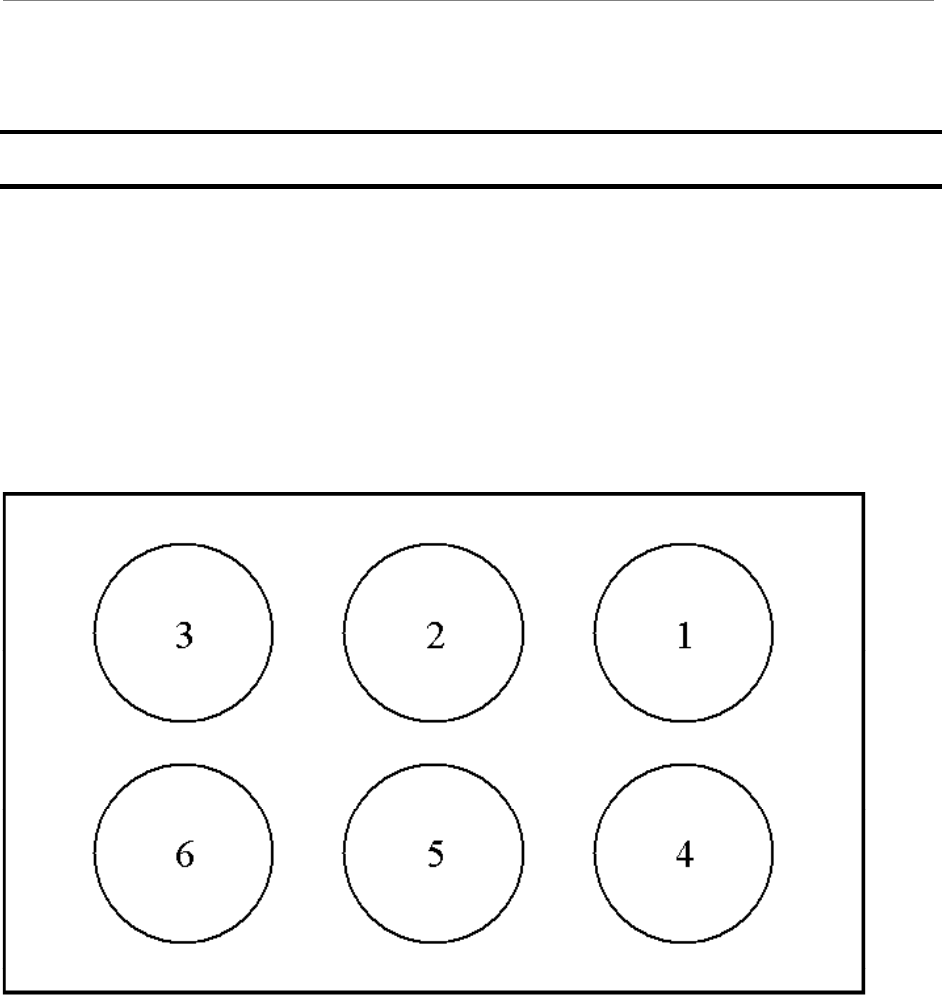
Navini Networks, Inc. Ripwave Base Station I&C Guide
Part #40-00047-00 Rev D v1.0 215
February 28, 2003
Appendix L: Chassis Alarms
The chassis contains two connectors that are used to send alarm indications to the BTS. One of
the connectors, labeled CABINET ALARM, is used to trigger alarm conditions that occur within
the external chassis. The second connector, labeled BBU, is used to process alarms from the
battery backup unit. Both connectors contain six pins. The pin orientation, as seen from the back
of the chassis, is shown in Figure L1.
Figure L1: Pin Orientation
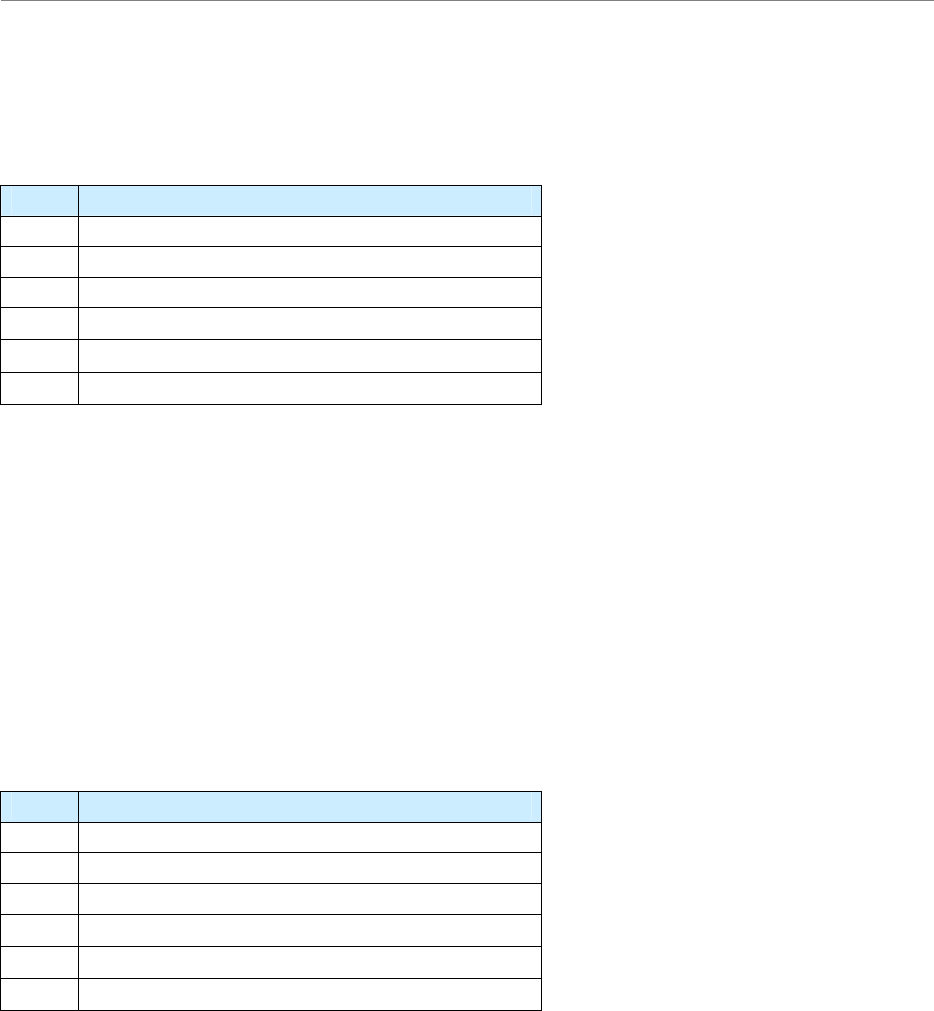
Ripwave Base Station I&C Guide Navini Networks, Inc.
216 Part #40-00047-00 Rev D v1.0
February 28, 2003
The alarm connector uses only four of the six pins. The pin names can be found in Table L1.
Table L1: Pin Names
Pin Name
1 General Fail Alarm
2 Ground reference for General Fail Alarm
3 Door Open Alarm
4 Ground reference for Door Open Alarm
5 Not Connected
6 Not Connected
The first pin of the alarm connector is the General Fail Alarm. This signal should be left open to
indicate an alarm condition from the HMC module located in the outdoor chassis. If no alarm
condition exists, this pin should be driven low. Pin 2 is used as the ground reference for this
alarm. The second alarm sent to the chassis is located on pin 3, Door Open Alarm. This signal
should be driven low when the door is closed. To indicate that the door of the outdoor chassis is
open, this signal should be left open. The associated ground reference for this signal is taken
from pin 4.
The BBU connector contains four alarm signals. These signal names are listed in Table L2.
Table L2: BBU Signal Names
Pin Name
1 Digital Ground Reference
2 BBU Battery Low
3 BBU Rectifier Fail
4 BBU AC Line Fail
5 BBU Charge Fail
6 Analog Ground Reference
The first alarm signal is located on pin 2, BBU Battery Low. If the BBU’s battery is running low,
the signal on pin 2 should be left open. BBU Rectifier Fail alarm is the next alarm and is located
on pin 3. This signal should be left open to indicate a failure on the Battery Backup Unit’s
rectifier. The next alarm condition occurs if the AC Line to the BBU fails. In this condition,
signal BBU AC Line Fail on pin 4 should be left open. If the BBU is unable to hold a charge,
then the BBU Charge Fail signal on pin 5 should be left open. For non-alarm conditions (normal
operation), these signals should be driven low. The digital ground reference for these signals is
located on pin 3. The analog ground reference should be located on pin 4.
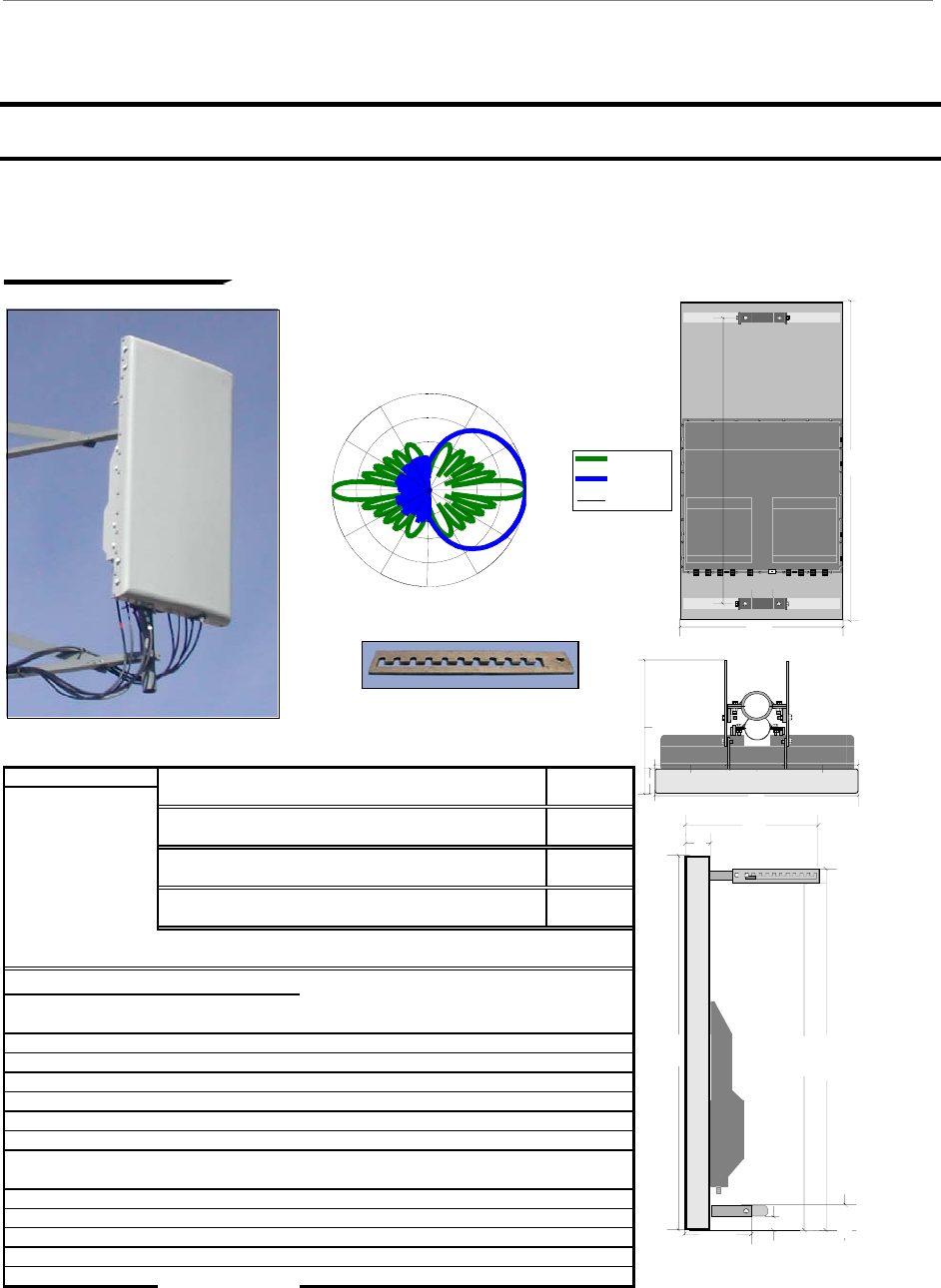
Navini Networks, Inc. Ripwave Base Station I&C Guide
Part #40-00047-00 Rev D v1.0 217
February 28, 2003
Appendix M: Antenna Drawings
Panel Antenna
95-10043-00
95-00043-00
95-10005-00
95-00005-00
95-10005-05
95-00005-05
95-10005-10
95-00005-10
DESCRIPTION
Frequency Range
Polarization
Antenna Gain
Horizontal HPBW
Vertical HPBW
Connector Type's
Lateral Thrust at 100 MPH (161 KM/HR) w/o ice
Mounting Configurations
Electrical Downtilt
Mechanical Downtilt
Weight 64 LB. Including Bracket Mount no pipe
Broadband Sectored Panel Antenna
Navini RFS
194 LB. Lateral Load
To Pipe Mount - 2 3/4" TO 3" OD
0 Degrees
0 - 10 Degrees Mechanical
Standard Downtilt Bracket
9 Female "N" Type
1 - 12 Pin Female Circular
NAVINI PART NUMBER:
2.6GHz EF range = 2.602GHz through 2.638GHz
17 dBi FOR 120 Degree Sectored
5 Degrees
2.4GHz range = 2.4GHz through 2.473GHz
2.6GHz EFGH range = 2.596GHz through 2.686GHz
Vertical or Horizontal
80 Degrees
2.6GHz- EFGH without LNAs, Horizontal Polarization
2.6GHz- EFGH with LNAs, Horizontal Polarization
2.6GHz- EFGH without LNAs, Vertical Polarization
2.6GHz- EFGH with LNAs, Vertical Polarization
2.4GHz- without LNAs
2.4GHz- with LNAs
2.6GHz- EF without LNAs, Vertical Polarization
2.6GHz- EF with LNAs, Vertical Polarization
3" o d
Max
3"
1'-11"
1'-4"
DOWNTILT
BRACKETS
8 1/ 8" 8 1/8"
6 1/8"
TOP VIEW
MOUNTING
CLAMP S
3" od
Max
4'-1/ 8"
1 3/4"
3'-8 3/4"
1'-4"
3"
8 1/16"
3'-10 1/2"
3 1/4"
Downtilt Bracket
0 1 2 3 4 5 6 7 8 9 10
REAR VIEW
4'-1/8"
18743
CAL PW R/DA TA 652
3"
1'-11"
3'-7"
Panel RFS Antenna Pattern
-20.00
-15.00
-10.00
-5.00
0.00
Vertical
Horizontal
Scale
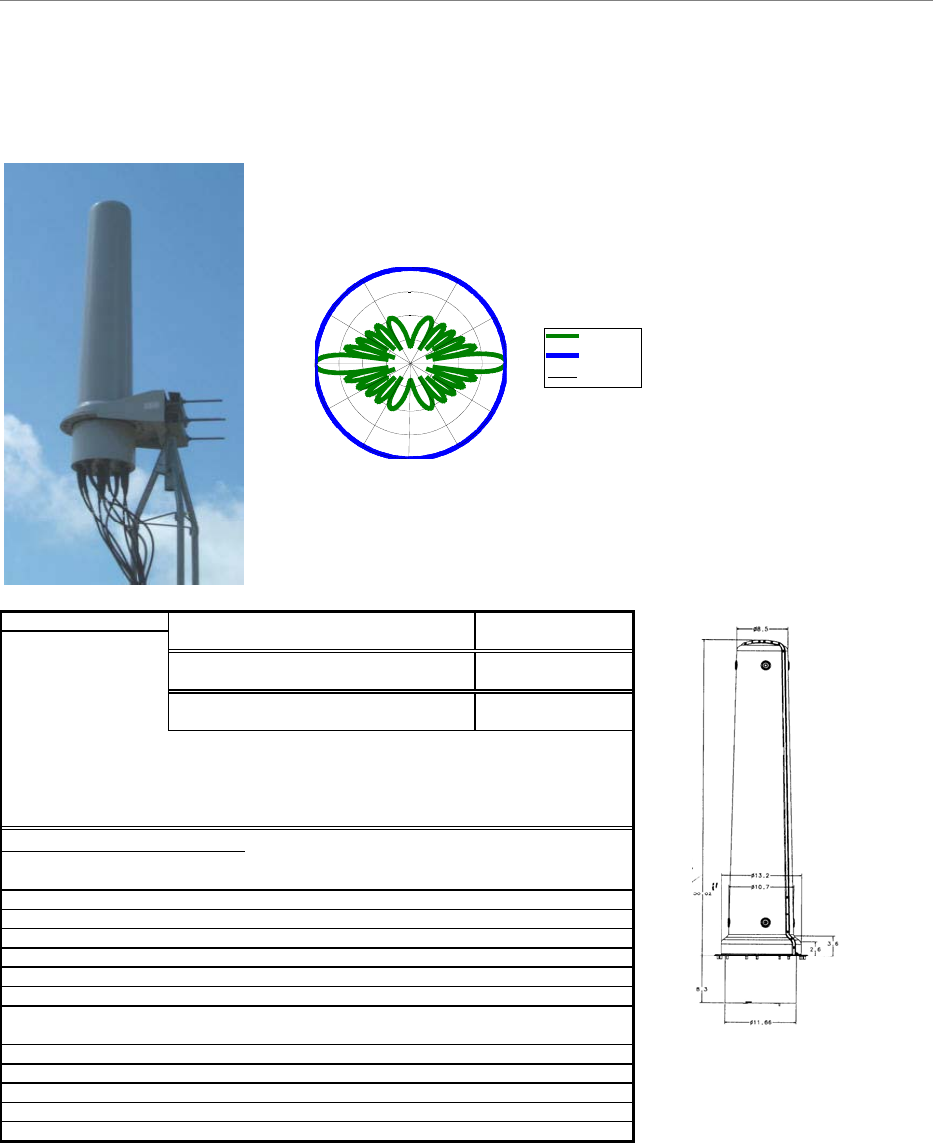
Ripwave Base Station I&C Guide Navini Networks, Inc.
218 Part #40-00047-00 Rev D v1.0
February 28, 2003
Omni Antenna
NAVINI PART NUMBERS:
2.6GHz- EF without LNAs
2.6GHz- EF with LNAs
2.6GHz- EFGH without LNAs
2.6GHz- EFGH with LNAs
* for 2.4GHz and 2.6GHz EF products, the present downtilt options are 0, 3, 5, and 7 degrees,
to be specified by a -00, -03, -05, and -07 in place of -xx
** for 2.6GHz EFGH, the downtilt options are 2 and 4 degrees,
to be specified by a -02 or a -04 in place of -xx
Frequency Range
Polarization
Antenna Gain
Horizontal HPBW
Vertical HPBW
Connector Type's
Lateral Thrust at 100 MPH (161 KM/HR) w/o ice
Mounting Configurations To Pipe Mount
Electrical Downtilt
Mechanical Downtilt
Weight
N/A
43 LB. Including Mount
DESCRIPTION
Broadband Omnidirectional Antenna
Navini RFS
95-24108-xx*
95-24008-xx*
95-26308-xx*
95-26108-xx*
95-26108-xx**
2.4GHz- without LNAs
2.4GHz- with LNAs
2.4GHz range = 2.4GHz through 2.473GHz
2.6GHz EF range = 2.602GHz through 2.638GHz
0, 2, 3, 4, 5, and 7 Degree
8dBi
2.6GHz EFGH range = 2.596GHz through 2.686GHz
95-26008-xx**
110 LB. Lateral Load
Vertical
Omni
15 Degrees
9 Female "N" Type
1 - 12 Pin Female Circular
Omni RFS Antenna Pattern
-20.00
-15.00
-10.00
-5.00
0.00
Vertical
Horizontal
Scale
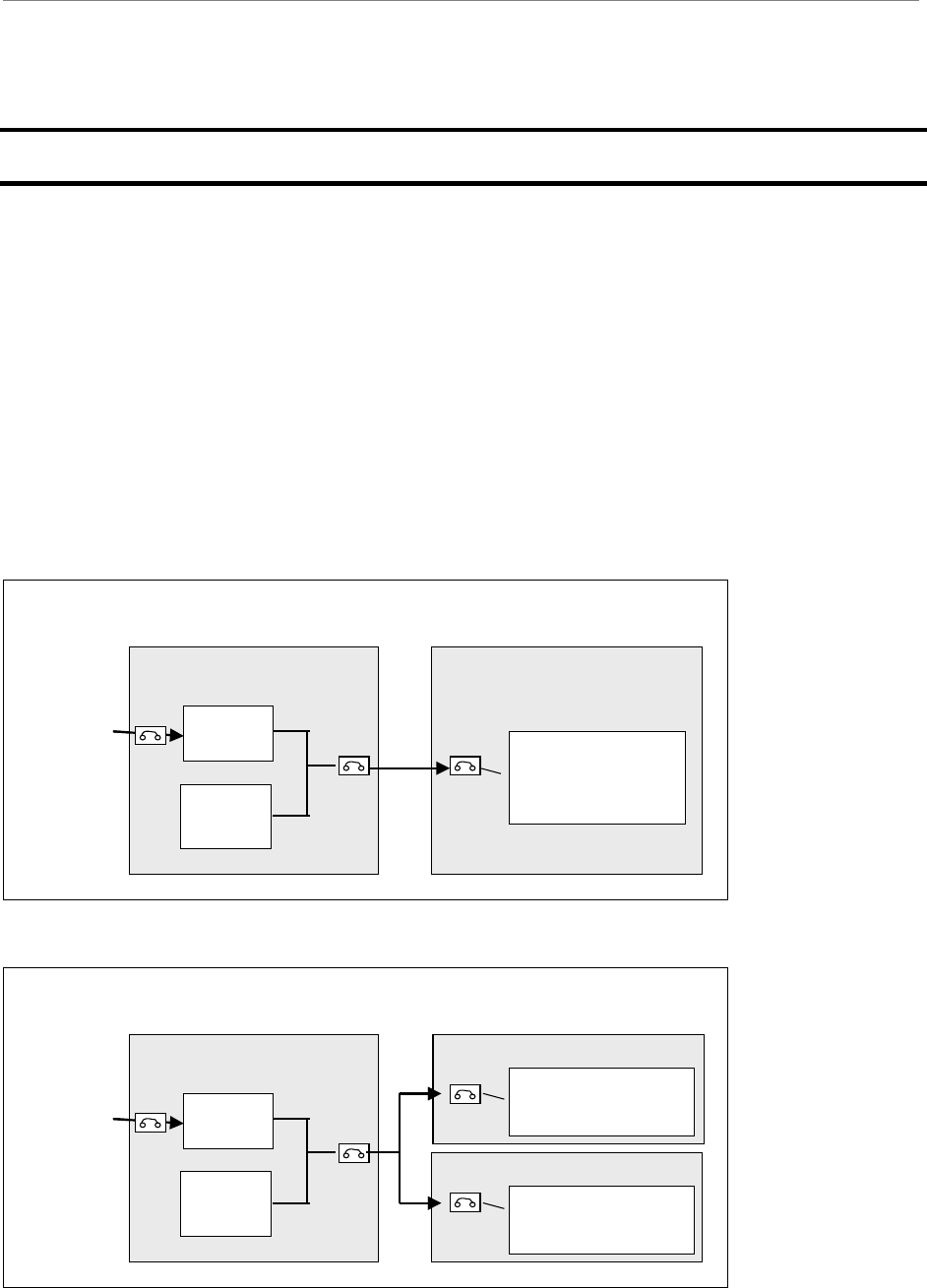
Navini Networks, Inc. Ripwave Base Station I&C Guide
Part #40-00047-00 Rev D v1.0 219
February 28, 2003
Appendix N: Rectifier/BBU Specifications
System Block Diagram
Navini Networks uses a 1000 Watt Rectifier/Battery Backup Unit (BBU) for the Ripwave Base
Transceiver Station (BTS) combo chassis, and a 1500 watt Rectifier/BBU for the Ripwave BTS
split chassis. The system diagrams in Figure N1 depict the current flow from incoming AC
voltage to BBU and the converted power into the BTS. The BBU is designed to provide a four-
hour battery backup for the BTS. The rectifier is designed with hot-swappable modules. Module
redundancy of N+1 is required.
Figure N1: System Diagrams
Combo Chassis (ISM)
AC INPUT:
180-265 VAC
OR 115VAC 27V
AC/DC
Converter
Battery
200 AH
B B U B T S
Circuit
Breaker
Inner Loop Fans
Power @ 1000 Watts
50 Amp
AC INPUT:
180-265 VAC
OR 115VAC
27V
AC/DC
Converter
Battery
200 AH
B B U B T S
Circuit
Breaker
Inner Loop Fans
Power @ 400 Watts
Inner Loop Fans
Power @ 1100 Watts
Digital Shelf
RF Shelf
50 Amp
20 Amp
Split Chassis (MMDS/WCS)
Combo Chassis (ISM)
AC INPUT:
180-265 VAC
OR 115VAC 27V
AC/DC
Converter
Battery
200 AH
B B U B T S
Circuit
Breaker
Inner Loop Fans
Power @ 1000 Watts
50 Amp
AC INPUT:
180-265 VAC
OR 115VAC
27V
AC/DC
Converter
Battery
200 AH
B B U B T S
Circuit
Breaker
Inner Loop Fans
Power @ 400 Watts
Inner Loop Fans
Power @ 1100 Watts
Digital Shelf
RF Shelf
50 Amp
20 Amp
Split Chassis (MMDS/WCS)
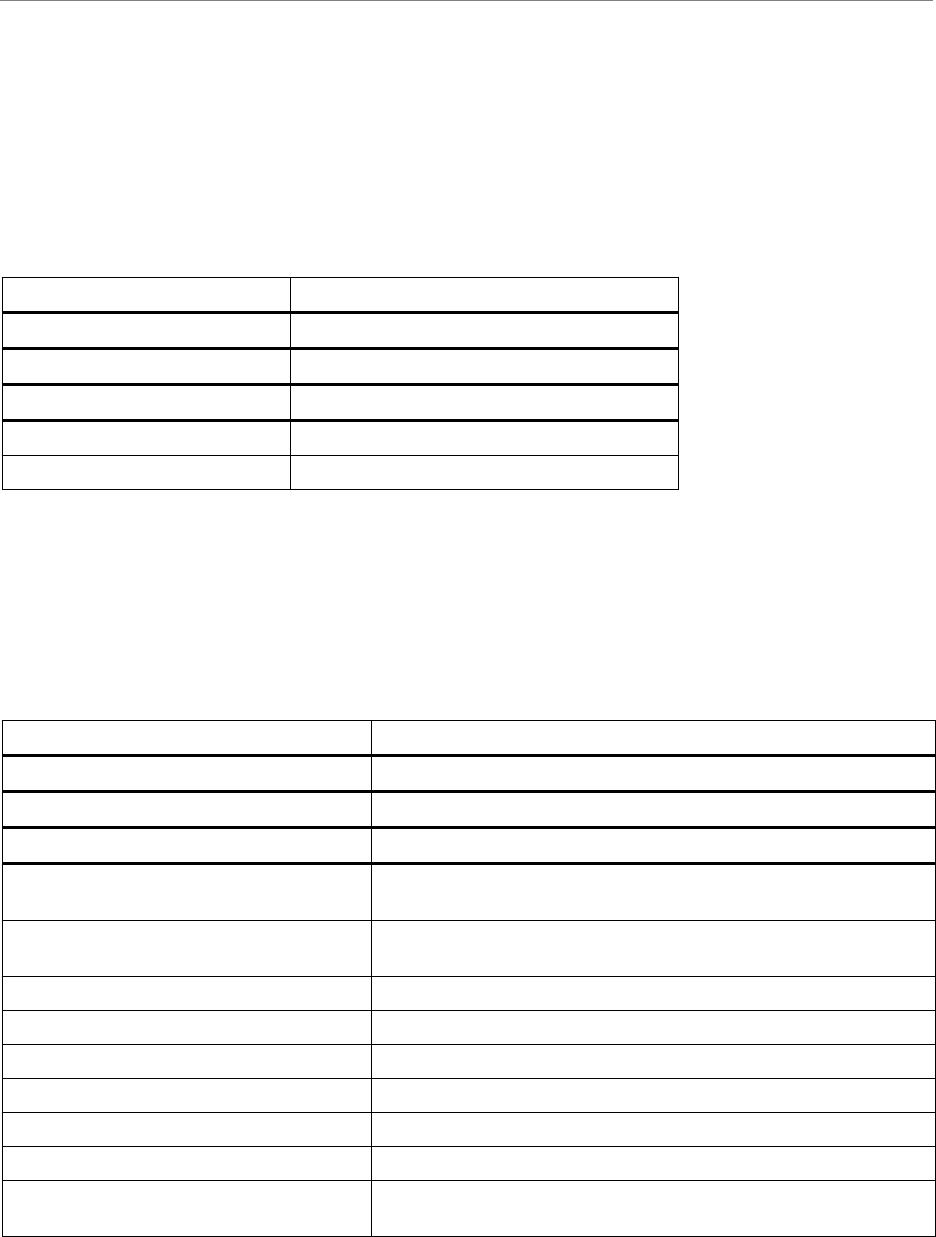
Ripwave Base Station I&C Guide Navini Networks, Inc.
220 Part #40-00047-00 Rev D v1.0
February 28, 2003
Input Specifications
The information in Table N1 shows the input required for the Ripwave BTS backup unit.
Table N1: Input Specifications
Input Voltage: 180 to 265 VAC
(Optional) Input Voltage: 92-125 VAC
Frequency: 47 to 63 Hz
Input Circuit Protection: Circuit Breaker
Surge Voltage/Current: 6 kV / 3 kA
Connection: 4 wire – 220V, 3 wire – 110V
Output Specifications
In Table N2 are the output specifications for the Ripwave BTS backup unit.
Table N2: Output Specifications
Nominal Rectifier DC Voltage: +27.2V +/- 2% (grounded negative pole)
Permitted Output Voltage Range: +22V ~ +28V (battery backup range: +21.0V ~ +27V)
Shutoff Voltage: At 21V
Load: 10% to maximum load
Recharge Maximum Battery
Voltage: +27.6V
Dynamic Load Response Time: <5% - overshoot/undershoot for 10% to 90% load step
in 50 uS.
Ripple & Noise: Psophometric voltage: less than 2mV rms
10Hz ~ 14MHz: less than 250mVp-p
10Hz ~ 10MHz: less than 50mV rms
Wideband ripple and noise 1% of output voltage
Stability of Output Voltage: Line regulation: +/- 0.2%
Load regulation: +/- 0.5%
Output Circuit Breakers: Each rectifier module requires input and output
overload protection
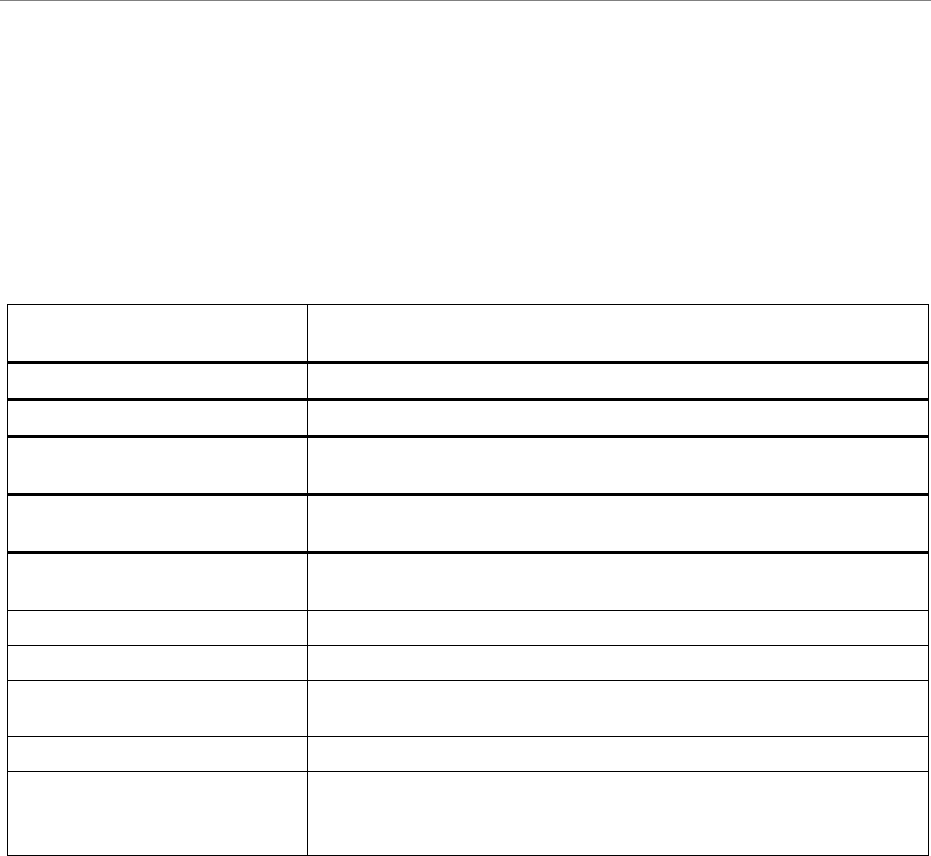
Navini Networks, Inc. Ripwave Base Station I&C Guide
Part #40-00047-00 Rev D v1.0 221
February 28, 2003
General Specifications
The information in Table N3 provides other specifications for the Ripwave BTS backup unit.
Note that some specifications vary by BTS frequency model: 2.3, 2.4, 2.5, or 2.6 GHz.
Table N3: General Specifications
BTS Power Consumption: 1000 Watts – Combo Chassis
1500 Watts – Split Chassis
Efficiency: Minimum of 88 % (at maximum load)
Power Factor: Minimum of 95% (at 50 ~ 100% load)
Redundancy: Any single failure in the rectifier or controller shall not turn
off output or cause voltage dip.
Battery Charge: Charge time shall be less than 10 hours.
Charge method to be temperature compensated.
Turn on Delay: 1 sec maximum.
The rectifier shall start with any load.
Leakage Current: Maximum of 3.5 mA
Withstanding Voltage: 1 minute/ 3.5 kVac (10mA)
Recharging: If the electricity fails, the battery must immediately turn on.
When electricity is restored, it must begin recharging.
Floating: When the battery has been fully charged.
Hot Swappable:
Rectifier consists of modules, which are hot-swappable.
+/- 5% maximum voltage change when inserting or extracting
one module.
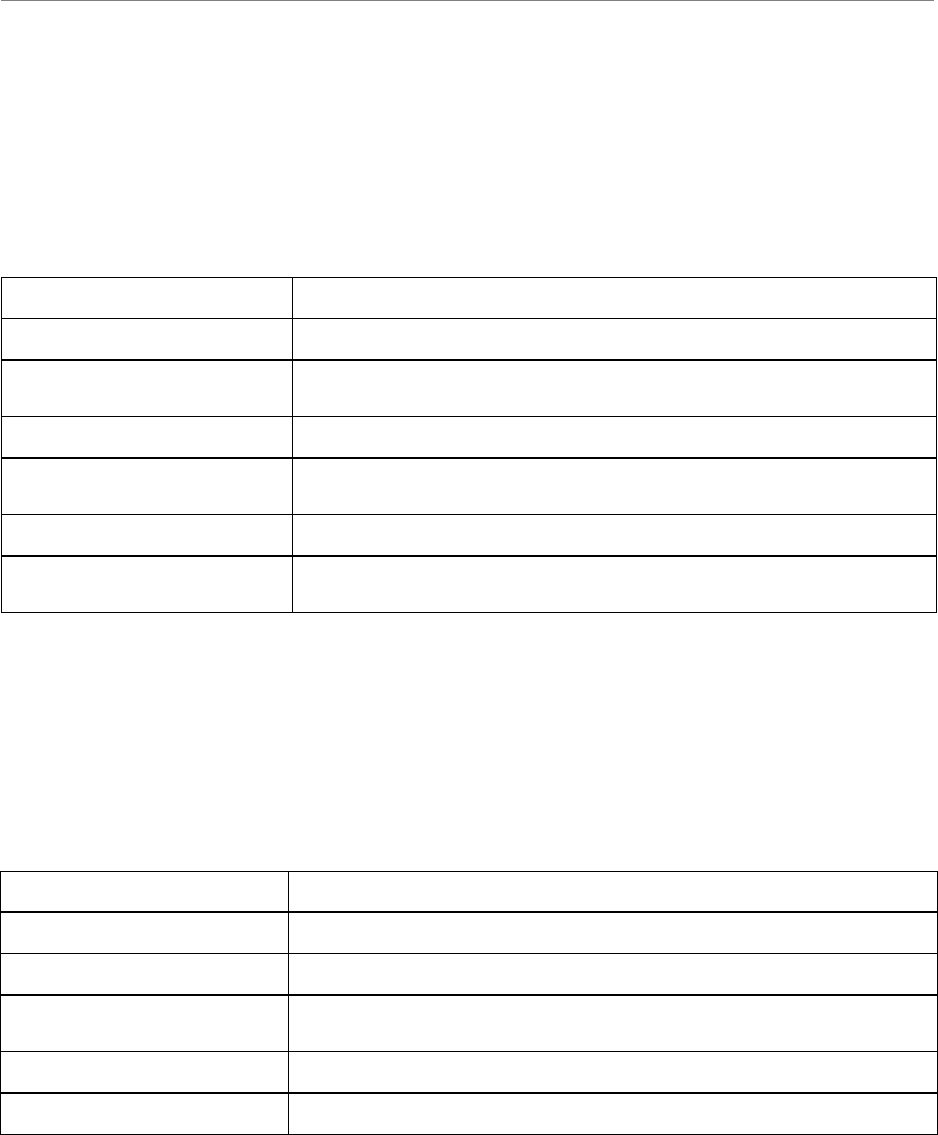
Ripwave Base Station I&C Guide Navini Networks, Inc.
222 Part #40-00047-00 Rev D v1.0
February 28, 2003
Protection
Table N4 shows the protection specifications for the Ripwave BTS backup unit.
Table N4: Protection Specifications
Over-voltage Protection: Shutdown at 30V. Power cycle to recover.
Under-voltage Protection: Shutdown at 21V with disconnect relay
Over-current Limit: At 110% ~ 130%. Auto recovery after the condition is
removed.
Over Temperature: Auto-recovery
Short Circuit: Infinite short protection. Auto recovery after the condition is
removed.
Input Protection: AC main circuit breaker required
Battery Protection: Battery protection fuse required
Reverse battery connection fuse protected
Environmental Requirements
Table N5 provides the environmental requirements for the Ripwave BTS backup unit.
Table N5: Environmental Requirements
Operating Temperature: 0 C to +50 C
Storage Temperature: -40 C to +70 C
Relative Humidity: 5 to 95% non-condensing
Altitude: -100 to 3,000 meters operating
-100 to 12,000 meters non-operating
Vibration: Telcordia GR-63-CORE, section 4.4, Zone 4, GR-487-CORE
Input Surge: GR-1089-CORE

Navini Networks, Inc. Ripwave Base Station I&C Guide
Part #40-00047-00 Rev D v1.0 223
February 28, 2003
Regulatory Requirements
The BBU shall comply with all applicable requirements and conditional requirements of
Telcordia. These are called out in Table N6.
Table N6: Regulatory Requirements
Input Surge Protection: GR-1089-CORE, section 4, up to 6 kV, 3 kA
Safety: UL 1950, 3rd ed, CSA 22.2 #950
EMI/EMC: FCC Part 14 Subpart B, Class A
Telcordia Requirements:
GR-1089-CORE “Electromagnetic Compatibility and Electrical
Safety - Generic Criteria for Network Telecommunications
Equipment”
Section 3. Class A
Section 4, up to 6 kV, 3 kA
Appendix C, Type 1
GR-63-CORE “Network Equipment – Building System (NEBS)
Requirements: Physical Protection: Section 4, Zone 4”
GR-487-CORE “Electronic Equipment Cabinets”
Reliability
The reliability requirements for the Ripwave BTS backup unit are provided in Table N7.
Table N7: Reliability Requirements
Derating: Use NAVMAT P4855 as a derating guideline. Exceptions must
be approved by Navini Networks.
MTBF:
>500,000 hours for rectifier using Telcordia methodology.
>100,000 hours for total system including over current
protection.
Expected Life: 15 years
Maintainability: There shall be no components that require periodic maintenance.

Ripwave Base Station I&C Guide Navini Networks, Inc.
224 Part #40-00047-00 Rev D v1.0
February 28, 2003
Alarm & Control
The Alarm and Control Relay has dry contact: open for alarm, normally grounded (safe), for the
following:
• AC line failure
• Low battery voltage
• Rectifier failure
• (Optional) - self test go/no-go, if applicable
• (Optional) - charger failure, if provided
• (Optional) - output voltage sense line
• Common chassis ground
Mechanical Configuration
The following list covers the mechanical configuration requirements for the Ripwave BTS
backup unit. The internal rectifier should be 19 inch rack-mountable. The rectifier shall consist
of N+1 hot swappable modules. If one module fails, there must be enough power handling
capability to provide full output power for a load of 1KW.
• Rectifiers to provide internal cooling. No external forced air provided.
• Acoustic Noise less than 60dBA, 1 meter from front.
• Rectifier to provide front panel indicators: AC ON, Module Failure.
• The maximum dimensions of the rack are: 84” (H) x 19” (W).
• The BBU shall be placed in a single 19-inch rack. See diagram in Figure N2.
• Power exits: rear preferred; front is not acceptable.
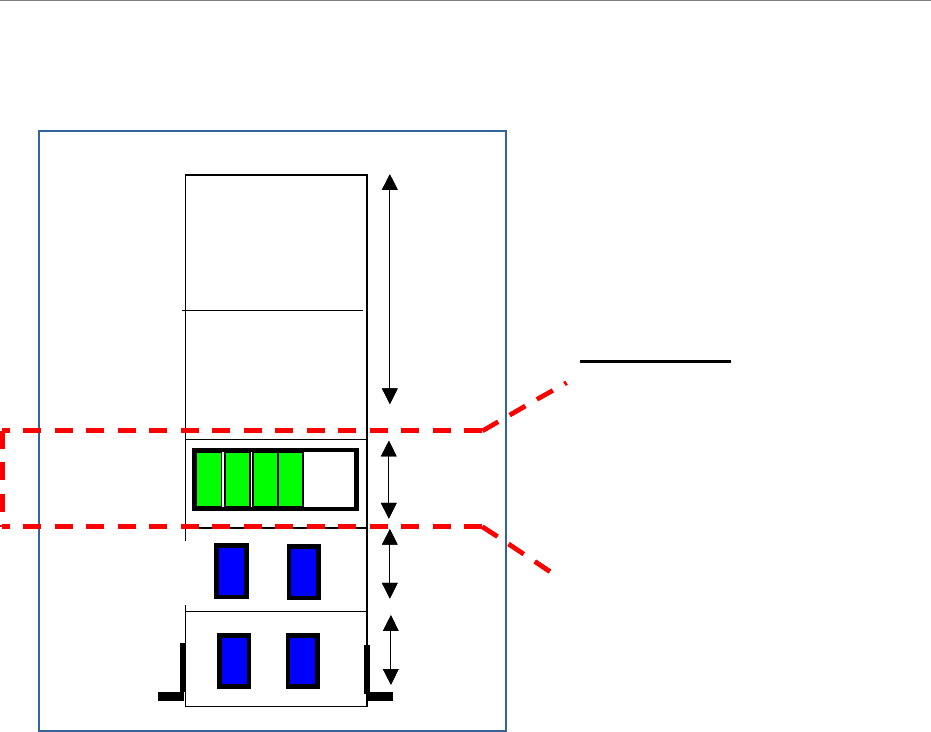
Navini Networks, Inc. Ripwave Base Station I&C Guide
Part #40-00047-00 Rev D v1.0 225
February 28, 2003
Figure N2: BBU Rack
BTS
Rectifiers
Batteries
Batteries
4RU
6RU
6RU
20RU
ISM - 1K
MMDS - 1.5K
WCS - 1.5K
Power Relay
RU = 1.75”
BTS
Rectifiers
Batteries
Batteries
4RU
6RU
6RU
20RU
ISM - 1K
MMDS - 1.5K
WCS - 1.5K
Power Relay
RU = 1.75”

Ripwave Base Station I&C Guide Navini Networks, Inc.
226 Part #40-00047-00 Rev D v1.0
February 28, 2003

Navini Networks, Inc. Ripwave Base Station I&C Guide
Part #40-00047-00 Rev D v1.0 227
February 28, 2003
Appendix O: Sample Bill of Materials (BoM)
1/13/2003 1:58:54 PM
BOM EXPLOSION REPORT
KIT, INSTALLATION, BTS, 2.6 Revision B
Part Number: 95-05001-00
Part
13-00034-00 : CONN, COAX, CRIMP, N STRAIGHT PLUG, EZ PIN (LMR600) . Quantity: 36
Part
13-00194-00 A CONN, COAX, CRIMP, N STRAIGHT PLUG, EZ PIN, MALE (LMR400). Quantity: 8
Part
Connectors, NType
13-00218-00 A CONN, LUG, ONE-HOLE #6. Quantity: 10
Connectors
13-00219-00 : CONN, LUG, TWO-HOLE #6. Quantity: 10
Connectors
13-00220-00 : CONN, LUG, TWO-HOLE #2. Quantity: 10
Part
18-00001-00 : CABLE, COAX, OUTDOOR RF, LMR600. Quantity: 1350
Part
18-00035-00 A WIRE, GROUND, GREEN, STRANDED, #2. Quantity: 50
Part
18-00036-00 : CABLE, COAX, OUTDOOR RF, LMR400. Quantity: 200
Cables, Coax
18-00049-00 : WIRE, STRANDED, GREEN, #6 AWG 50. Quantity: 13
Part
24-00045-00 : NUT, REG. HEX, CRES, 1/4-20UNC. Quantity: 8
Part
24-00117-00 : BUSS BAR, GROUND, TOWER, 1/4IN X 2-1/2IN X 12-1/2IN. Quantity: 1
Part
24-00118-00 : BUSS BAR, GROUND, SHELTER, 1/4IN X 4IN, DRILLED TO 5/8IN. Quantity: 1
Part
24-00119-00 : GRIP, HOISTING, PRE-LACED, FOR 1/2IN COAX CABLE. Quantity: 10
Part
24-00120-00 : HANGERS, ASSY, CUSHION, 5H, 1/2IN CORREGATED COAX. Quantity: 4
Mechanical Hardware
24-00121-00 : MOUNT, HANGER, CROSS CUSHION, KIT OF 5. Quantity: 2
Part
24-00122-00 : BLOCK, SUPPORT, MINI COAX. Quantity: 2
Part
24-00134-00 A BREAKER, OUTPUT DISTRIBUTION, 60 AMP, BTS INSTALLATION. Quantity: 1

Ripwave Base Station I&C Guide Navini Networks, Inc.
228 Part #40-00047-00 Rev D v1.0
February 28, 2003
Mechanical Hardware
24-00156-00 : CLAMP, PIPE TO PIPE, KIT OF 2. Quantity: 1
Mechanical Hardware
24-00170-00 : NUT, REG. HEX, CRES, #10-24. Quantity: 3
Part
24-00171-00 : WASH, STAR, #10. Quantity: 3
Part
24-00172-00 : WASH, STAR, ¼. Quantity: 16
Part
24-00250-10 : BOLT, HEX, 1/4-20 X 1.000 LG, SSPA. Quantity: 8
Mechanical Hardware
24-06156-43 : WASH, FLAT, CRES, #6 T-B-REGULAR, .156 X .438 X .040. Quantity: 16
Part
24-06250-14 : WASH, LOCK, SPLIT, CRES 1/4, Reg, .252X.487X.062. Quantity: 16
Part
32-00031-00 : ARRESTOR, LIGHTNING, RF 1.2 - 2.8GHz, N TYPE FEMALE, DC BLOCK, PSX. Quantity: 9
Part
32-00033-00 : ARRESTOR, LIGHTNING, GPS, PICKOR, DC PASS, MM50MNZ+6. Quantity: 2
Part
32-00052-00 : KIT, GROUNDING, LMR-600, 5FT X 1/2 IN, 2 HOLE LUG. Quantity: 9
Part
32-00053-00 : KIT, GROUNDING, LMR-400, 5FT X 3/8 IN, 2 HOLE LUG. Quantity: 2
Part
32-00077-00 : KIT, WEATHERPROOFING, GEL WRAP. Quantity: 1
Part
32-11004-00 : ARRESTOR, SURGE, EMP, DC BLOCK, RF COAX, In-line 2.4 GHz., PSX-ME. Quantity: 9
Part
92-00006-00 : SUBASSY, MOUNT UNIVERSAL FOR OMNI ANTENNA. Quantity: 1
Antennas
68-00006-00 : DWG, ASSY MOUNT UNIVERSAL FOR OMNI ANTENNA. Quantity: REF
Assembly Drawing, Mechanical
55-00063-00 : BASE, WELDMENT, ANTENNA MOUNT, OMNI. Quantity: 1
Part
55-00079-00 : FLANGE C, ANTENNA MOUNT, OMNI. Quantity: 1
Part
55-00080-00 : GUSSET, ANTENNA MOUNT, OMNI . Quantity: 2
Part
55-00081-00 : PLATE, BASE, ANTENNA MOUNT, OMNI. Quantity: 1
Part
24-10000-00 : NUT, PEM, BLIND .250 1/4-20 BS-0420-2. Quantity: 8
Part Type
55-00088-00 : FLANGE, CLAMP, STANDARD MOUNT, GALVANIZED. Quantity: 2
Part
24-09000-00 : STUD, 7/16 X 14 LG ALL THREAD, GALVANIZED, ANTENNA MOUNT, OMNI. Quantity: 4

Navini Networks, Inc. Ripwave Base Station I&C Guide
Part #40-00047-00 Rev D v1.0 229
February 28, 2003
Mechanical Hardware
24-09001-00 : WASHER, SQ, ALUMINUM, ANTENNA MOUNT. Quantity: 4
Mechanical Hardware
24-09002-00 : WASHER, SQ, GALVANIZED, ANTENNA MOUNT. Quantity: 4
Mechanical Hardware
24-09003-00 : FLAT WASHER 7/16 REG GALVANIZED. Quantity: 12
Mechanical Hardware
24-09005-00 : LOCK WASHER, 7/16, GALVANIZED. Quantity: 12
Mechanical Hardware
24-09004-00 : HEX NUT 7/16 GALVANIZED. Quantity: 12
Mechanical Hardware
24-00124-00 : BOLT, HEX 1/4-20 X 1.250 LG SSPA. Quantity: 8
Part Type
24-06250-14 : WASH, LOCK, SPLIT, CRES 1/4, Reg, .252X.487X.062. Quantity: 8
Part
24-06250-28 : WASH, FLAT, CRES, 1/4 T-B-REGULAR, .281 X .734 X .063. Quantity: 8

Ripwave Base Station I&C Guide Navini Networks, Inc.
230 Part #40-00047-00 Rev D v1.0
February 28, 2003
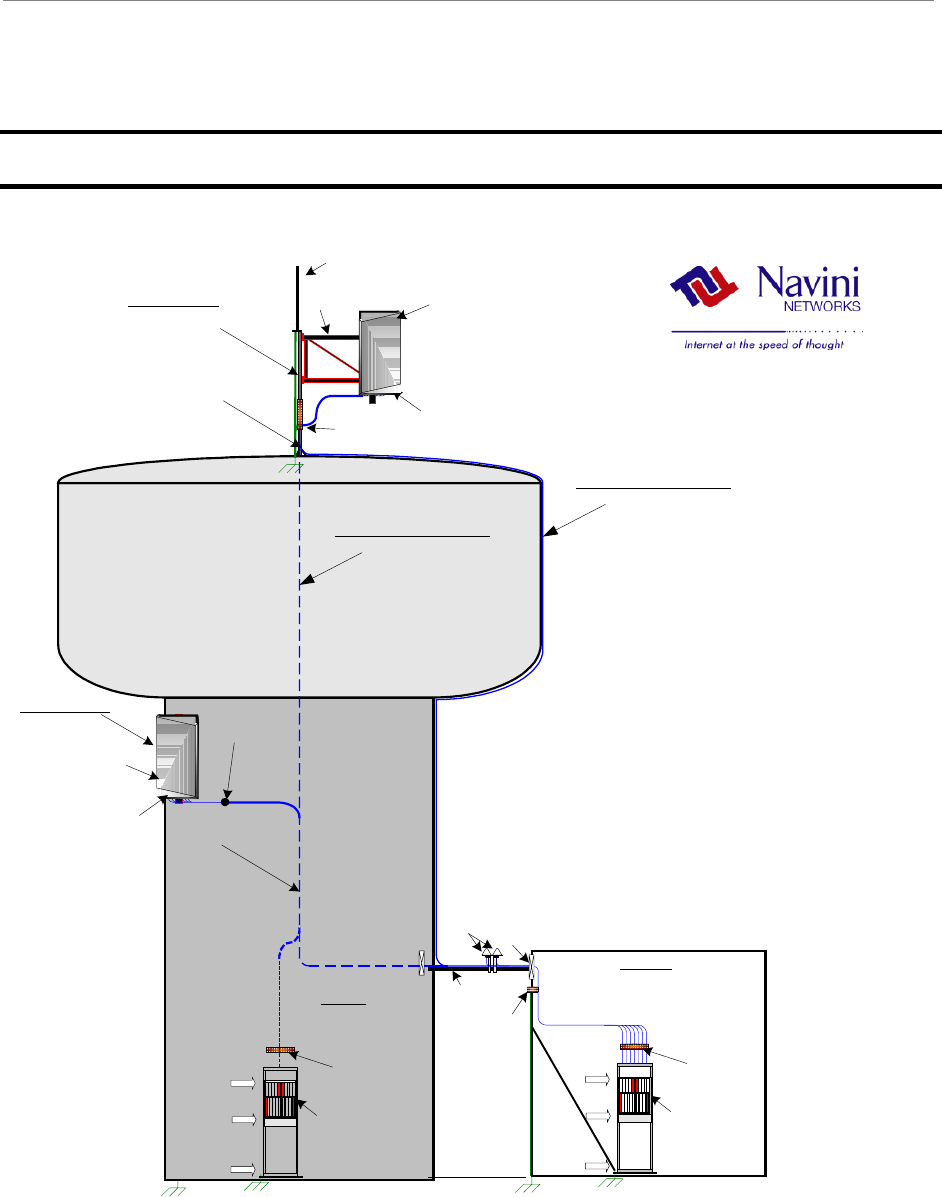
Navini Networks, Inc. Ripwave Base Station I&C Guide
Part #40-00047-00 Rev D v1.0 231
February 28, 2003
Appendix P: Sample Base Station Drawing
NAVINI NETWORKS
BASE STATION LAYOUT
WATER TOWER OPTION
PANEL ANTENNA
PSX-ME
SURGE
PROTECTOR
GROUND
BAR
RF CABLES
ANTENNA
BRACKET
GPS
CABLE
LADDER
CABLE
ENTRY
GROUND
BAR
ETHERNET
/ TELCO
SHELTER / HUT
OPTION 1
INDOOR BTS
OVERHEAD CABLE LADDER
24VDC
@ 60A
CABINET
GND
PSX
GROUND BAR
NAVINI
BTS
24VDC
@ 60A
CABINET
GND
PSX
GROUND BAR
NAVINI
BTS
ETHERNET
/ TELCO
OPTION 2
INDOOR BTS
CABLE RUN / CABLE LADDER
OPTION 3
CABLE RUN / INTERNAL RUN
OPTION 4
LIGHTNING
ROD
RF CABLES
CORE TO INSIDE
OF TOWER
PANEL
ANTENNA
PANEL
ANTENNA
PSX-ME
SURGE
PROTECTOR
PANEL LOCATION
OPTION 5
PANEL LOCATION
OPTION 6
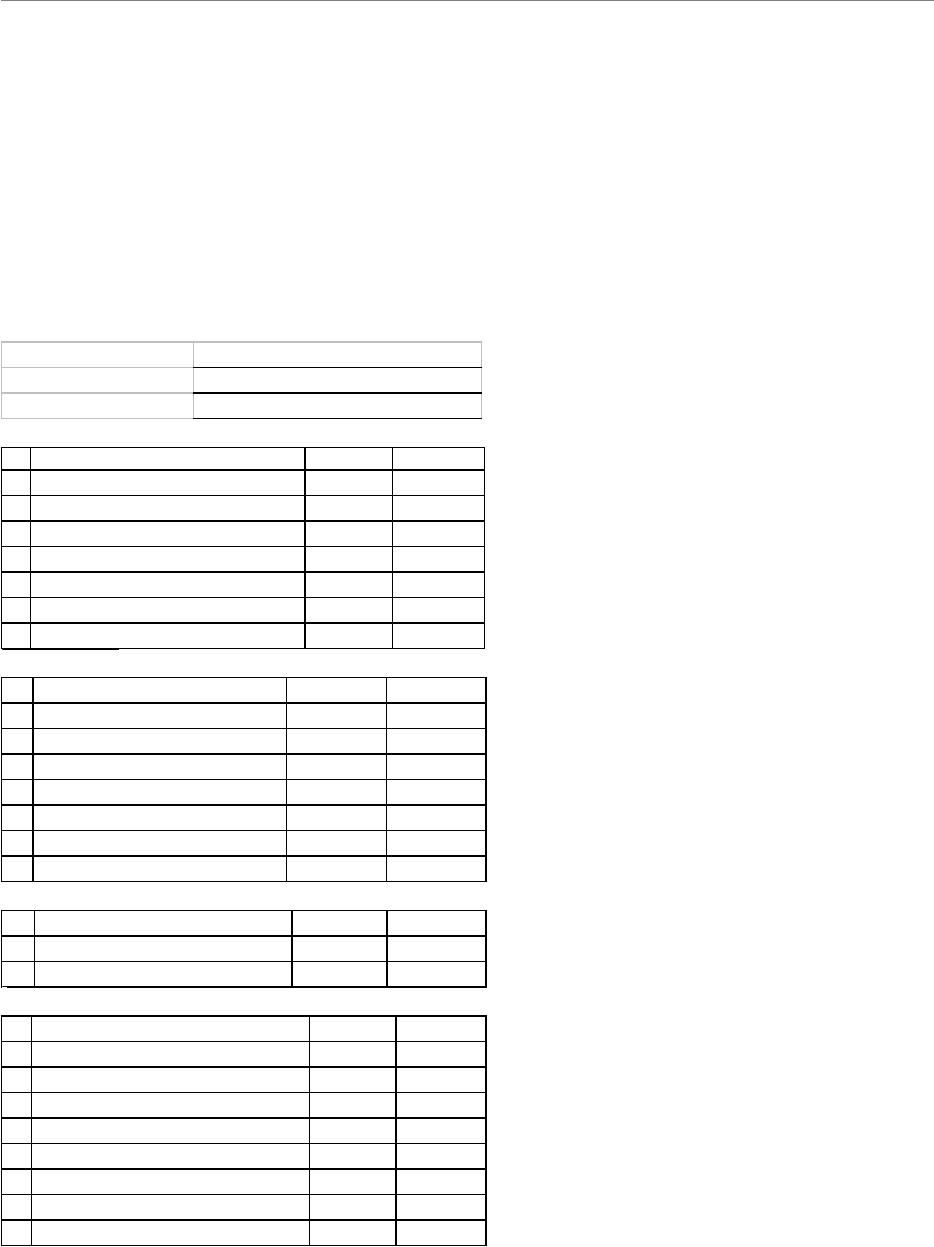
Ripwave Base Station I&C Guide Navini Networks, Inc.
232 Part #40-00047-00 Rev D v1.0
February 28, 2003
NOTE
1.CABLE BUNDLE CONSIST OF 9 RF CABLES AND 1 POWER/DATA CABLE
2.RF CABLE TYPE TO BE DETERMINED BASED ON RUN LENGTH AND DB
LOSS/FT
3.CABLE HANGERS TO BE SPECIFIED/RECOMMENDED BY TOWER CREW
4.ANTENNA BRACKET TO BE SUPPLIED BY CUSTOMER AS RECOMMENDED BY
TOWER CREW
5.BTS REQUIRES 24VDC @ 60A.
6.PSX-ME SURGE PROTECTORS TO BE INSTALLED IN-LINE BETWEEN RF
CABLE AND ANTENNA
7.PSX SURGE PROTECTOR TO BE MOUNTED ON GROUND BAR CLOSE TO BTS
CABINET/CHASSIS
8.ETHERNET/TELCO BACKHAUL TO BE PROVIDED BY CUSTOMER
9.ALL INSTALLED EQUIPMENT/MATERIALS MUST BE PROPERLY GROUNDED
10.OPTION 1 IS FOR AN INDOOR BTS INSTALL, OPTION 2 IS FOR
OUTDOOR BTS
CUSTOMER
SITE NAME
LOCATION
1 PANEL LOCATION OPTION 5=DOME TOP 6=SIDE
2ANTENNA B RACKET TY PE
3PSX-M E SURGE PROTECTOR PCS
4ANTENNA AZIMUTH
5
6DEGREES
7FEET
8
ANTENNA HEIGHT
ANTENNA DOWNTILT
TOWER JUMPER LENGTH
TOWER JUM PER CA B LE TY PE
9
10 FEET
11 P C S
12
13 P C S
14 GROUNDING CABLE LENGTH FEET
15 P C S
16 P C S
WEATHERPROOFING KIT
GROUNDING KIT
HOISTING GRIP
M A IN FEEDER TY PE
M A IN FEEDER LENGTH
GROUND BUSS BAR
CA B LE HA NGER TYPE
17
18 GPS CA B LE LENGTH FEET
19 GPS CA B LE TY PE
GPS M OUNT
20 LOCA TION OPTION 1=SHELTER 2=INSIDE TOWER
21 CABLE RUN OPTION 3=EXTERNAL 4=INTERNAL
22 JUM PER CA B LE LENGTH FEET
23 JUM PER CA B LE TY PE
24 PSX SURGE PROTECTOR PCS
25 GPS SURGE PROTECTOR PCS
26 ALT GROUND BUSS BAR PCS
27 2 4 V DC/ 60 A POWER SUPPLY
28 INDOOR RACK/CABINET

Navini Networks, Inc. Ripwave Base Station I&C Guide
Part #40-00047-00 Rev D v1.0 233
February 28, 2003
Appendix Q: Sample Statement of Work
The following is an example of a Statement of Work. The Statement of Work outlines the
general activities that must be conducted in order to complete the installation and commissioning
tasks for a Ripwave Base Station.
Example:
Statement of Work for Standard Installation Services
The following statement of work will be used to outline the areas of responsibilities for the
Navini Networks antenna (known as the RFS) and Base Station (known as the BTS) installations
to be completed with Navini Networks Client (referred to as Client in this document). Client
may choose to hire a contractor or tower crew to assist with its activities. Navini Networks has
no formal contract relationship with the contractor, who will be managed by Client. The
following work items are suggested content only - - final scope and terms to be negotiated
directly with Client. Navini Networks support personnel will be on site for the entire installation
and commissioning process, and will provide technical expertise, information, and
recommendations with respect to site design and installation.
It is recommended that contractor have a Non-Disclosure Agreement (NDA) in place with Client
and Navini Networks prior to execution of work. Contractor shall not publicly disclose any
information concerning this deployment or trial with any other parties, unless approved in
writing in advance by Client and Navini Networks.
Navini Networks
1. Provide Field Engineer to consult with Client and Contractor for planning efforts.
Review Site design sketches and BOM prepared by others.
2. Review network architecture information (connection diagram and logical addresses)
prior to start of installation.
3. Review Sweep results with Client and contractor. Sweep to be provided of RFS after
shipment, of coax cables and RF path on tower, and of cables and RFS after installation,
before power up.
4. Review AC and DC power system installation. Review DC power system test with
Client and contractor.
5. Review backhaul circuit installation test results with Client.
6. Review GPS antenna and cable installations.
7. Review and Verify Cable and Antenna System Installation Work
8. Site walk with contractor and Client for Punchlist.
9. Load EMS software on Client supplied workstation, and verify connectivity to BTS.

Ripwave Base Station I&C Guide Navini Networks, Inc.
234 Part #40-00047-00 Rev D v1.0
February 28, 2003
10. Provide BTS installation – Chassis and Cards.
11. Apply power to BTS and perform all power up, BTS calibration verification checks,
commissioning and initial testing of Navini Networks system. May use EMS on local
laptop.
12. With assistance of Client, Perform Drive Test / Coverage Verification.
13. With assistance of Client, perform data rate testing at mutually specified locations – 15
for Omni, 5 for each panel RFS.
14. With client, integrate BTS into backhaul network and verify operation.
15. Closeout / Customer Acceptance package, including inventory of hardware.
16. Navini Networks to provide own tools and test equipment.
17. Clean job site daily.
Client / Contractor Work Items
1. Perform Site survey at each site.
2. Prepare Installation sketch and Bill of Materials (BOM) for each site. Note that these are
not sealed construction drawings.
3. Client / Contractor Site Design and Bid Walk.
4. Material Procurement.
5. Acquire building permits.
6. Inside Network cabling from demark to BTS rack
7. AC power installation (provide dedicated 115 VAC 20 A circuit for each BTS, dual
outlet receptacle).
8. Air conditioning work or other hut electrical work.
9. 24 VDC rectifier installation, cabling to BTS chassis, cabling to AC circuit breaker. Test
24 VDC system (note: do not apply power to BTS).
10. Mount 19” TELCO rack inside hut (base anchors, or overhead brackets or both)
11. Provide core drilling and furnish and install feed through panel for coax cables, unless
already existing. Seal holes using similar materials to other existing feed-through at each
site.
12. Install grounding inside hut for rack and 24 VDC system. Install ground bus bar inside
hut entry per drawings. Install ground bus bars on antenna structure and ground coax
cables per sketch.
13. Install and apply coax cables and connectors. This includes main coax runs on tower,
plus coax jumpers at antenna and at hut, as specified by drawings. Recommend and
Install all cable hangers and supports, and grounding, per standard practice in use at
tower location. Install surge protectors per design sketches and BOM.
14. Sweep test coax cables at designated sweep frequencies.
15. Install power and data cable from antenna to BTS.
16. Weather seal all outside connections.
17. Recommend, furnish and install mounting structure (arm assembly) to stand-off Navini
RFS from tower. Standoff assembly to include pipe mount for antenna mount. Install
Navini RFS on arm on tower. Connect to coax cables and provide sweep of cable / RFS
assembly. Provide photographic documentation of tower top installation work.
18. Provide equipment and cable labeling as required.
19. Install (2) GPS antennas on ice bridge (or other agreed upon location). Furnish and

Navini Networks, Inc. Ripwave Base Station I&C Guide
Part #40-00047-00 Rev D v1.0 235
February 28, 2003
install any required brackets or pipe mounts. Install GPS coax cables and connectors
from GPS antenna to BTS.
20. Site walk at completion with Client and Navini, create Punchlist; clear applicable
punchlist items.
21. Arrange disposal of trash
22. Provide RF coverage analysis plots before start of installation. Provide model tuning, if
required.
23. Provide architecture document before start of installation, including connection diagram
and logical network element assignments (IP addresses, PVC’s, etc.).
24. Set Up and Verify all network equipment and backhaul circuits.
25. Set Up and Verify Operation and connectivity of EMS computer.
26. Provide one resource to assist with drive testing and location data rate testing.
27. Provide all end user / CPE provisioning in EMS after initial testing.
28. Provide all end user interface and troubleshooting.
29. Monitor EMS / alarms. Forward trouble issues to Navini call center.
30. Contractor and Client to provide own tools, computers, and test equipment.

Ripwave Base Station I&C Guide Navini Networks, Inc.
236 Part #40-00047-00 Rev D v1.0
February 28, 2003
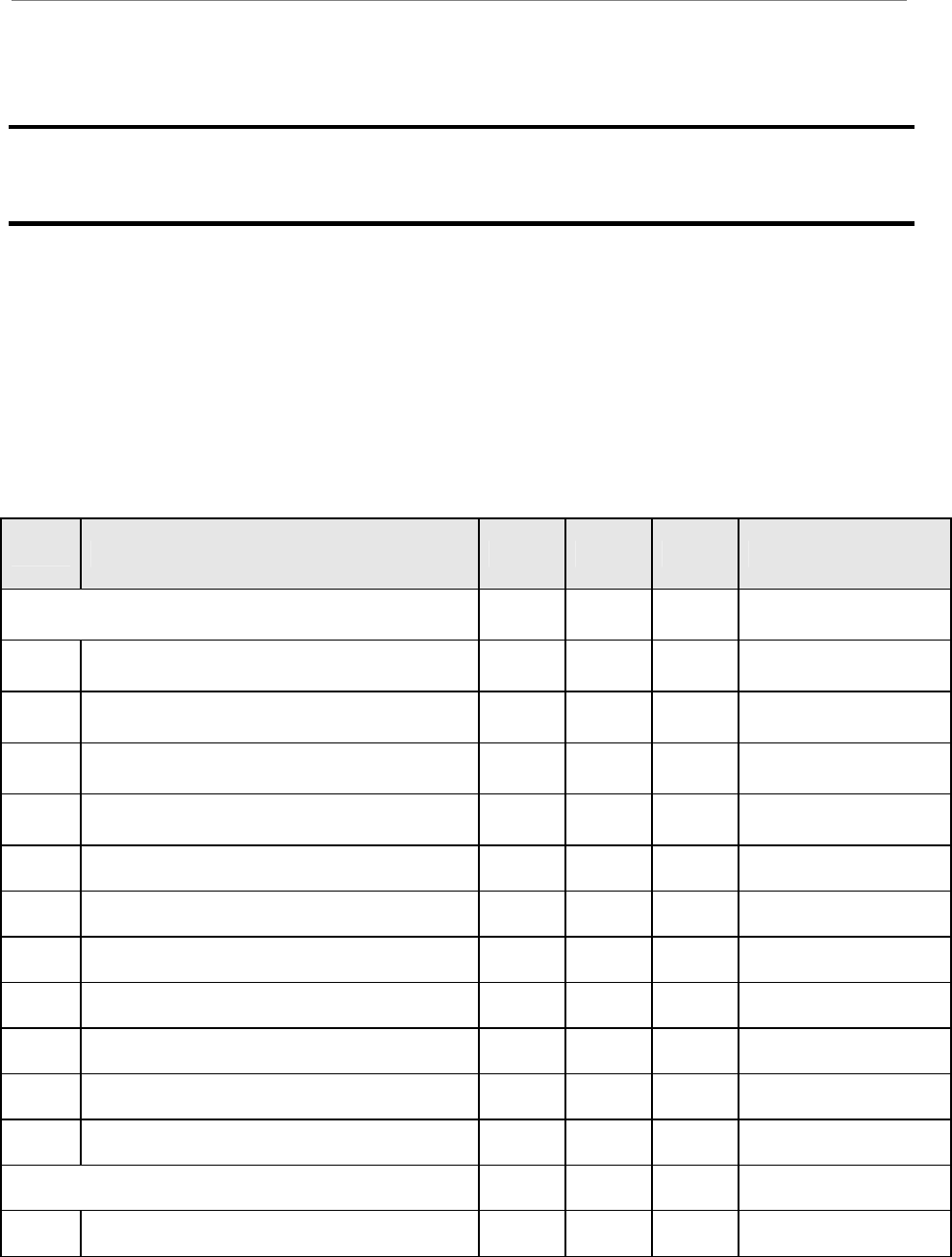
Navini Networks, Inc. Ripwave Base Station I&C Guide
Part #40-00047-00 Rev D v1.0 237
February 28, 2003
Appendix R: Sample Responsibility Assignment
Matrix (RAM)
The following is an example of a Responsibility Assignment Matrix (RAM). The RAM is a tool
for capturing who will do what to get systems deployed and turned up. It provides an easy-to-
read and follow tabular format. Each of the activities in the list must be addressed in order to
complete the installation and commissioning tasks for a Ripwave Base Station.
1 = Primary Responsibility S = Supply
2 = Secondary Responsibility I = Install
Item # Task / Activity Navini Client Other Notes
MARKET PLANNING and RF ENGINEERING
1 Develop coverage objectives 1
2 Provide Hardware Specifications 1
3 Provide Link Budget 1
4 Prepare Preliminary Coverage Plots 2 1
5 Interference Analysis / Noise Floor 2 1
6 Link Specific Channel Assignments 2 1
7 Review / Approve RF Design 2 1
8 SCT Filing fees 1
9 SCT licensing / clearing 1
10 Contract RF consulting engineering 1
11 Obtain SCT Test Permit 1
NETWORK ENGINEERING & BACKHAUL
1 Network Requirements 2 1
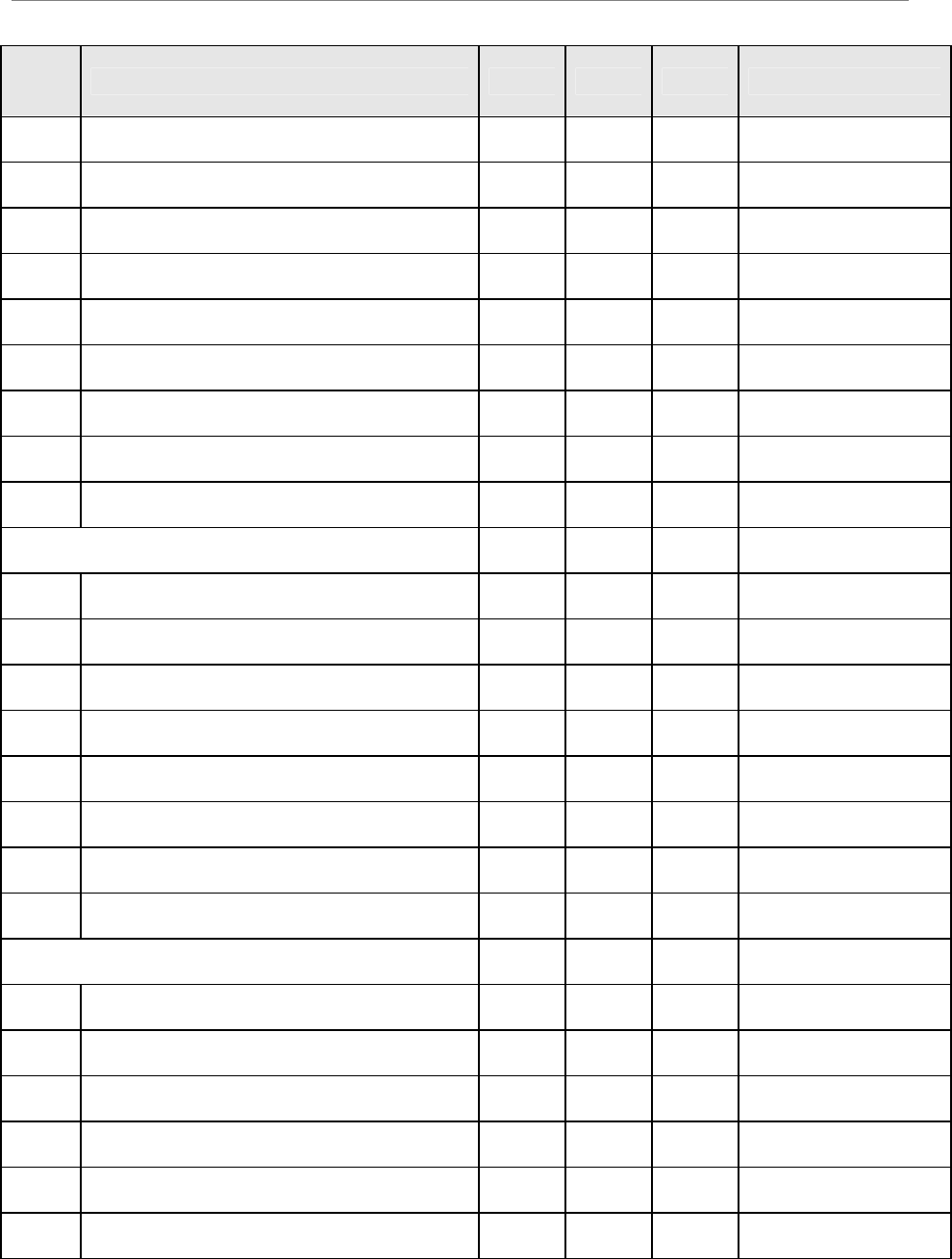
Ripwave Base Station I&C Guide Navini Networks, Inc.
238 Part #40-00047-00 Rev D v1.0
February 28, 2003
Item # Task / Activity Navini Client Other Notes
2 Network Architecture 2 1
3 Provisioning Guidelines 1
4 IP / data Address Assignment / management 1
5 Review / Approve Network Design 2 1
6 Network Architecture – backhaul 1
7 ATM layer Provisioning / management 1
8 Order Circuits 1
9 Order equipment for backhaul / interface 1
10 Backhaul Network Test 1
SITE ACQUISITION
1 Identify BTS candidates in search ring 1
2 Identify CPE Candidates per ring 1
3 Identification of Zoning requirements 1
4 Select BTS sites 1
5 Negotiate and close lease 1
6 Pay lease costs 1
7 Obtain any building permits if required 1
8 Arrange Site Access 1
SITE DESIGN
1 Site Survey – BTS sites 2 1
2 Prepare Site Design Sketches / Layout 2 1
3 Prepare BOM 2 1
4 Review Design / Approve 2 1
5 A&E Selection and management 1
6 Prepare / approve A&E drawings 1
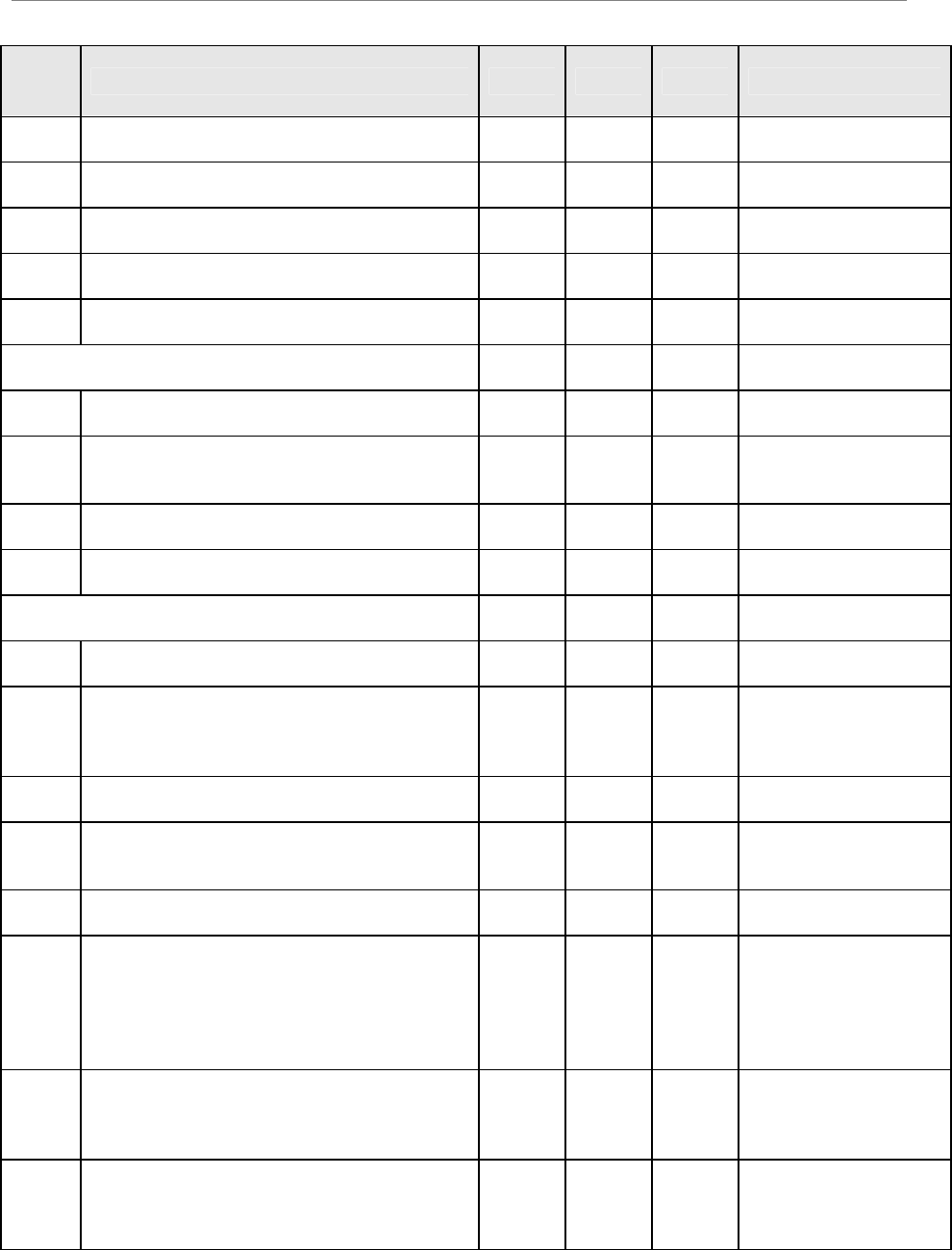
Navini Networks, Inc. Ripwave Base Station I&C Guide
Part #40-00047-00 Rev D v1.0 239
February 28, 2003
Item # Task / Activity Navini Client Other Notes
7 Tower Structural Analysis 1
8 Contractor Qualifications and Selection 1
9 Contractor walk through 1
10 Obtain / Review bids / Award contract 1
11 Obtain Building permits or other approvals 1
LOGISTICS / SHIPPING / DELIVERY
1 Create Logistics Plan 2 1
2 Ship Navini supplied Equipment to designated
warehouse 1
3 Deliver Equipment to Specific Sites 1
4 Disposal of Shipping materials 2 1
CONSTRUCTION / INSTALLATION
1 Antenna Mounts / brackets S, I
2 Antennas (Navini RFS)
S I
Navini will assist and
supervise installation
from the ground.
3 Coax Cable / Connectors S, I
4 Power / Signal Cable / Connectors (BTS to
RFS) S I 1 per BTS.
5 Ground Kits S, I
6 Surge protectors/Ground Buss Bars
S, I
Navini to supply surge
protector for the power
and data cable. Client to
supply surge protectors
for coaxial feedlines.
7 GPS 4-Way Splitters for multiple BTS’ installed
at one site. S, I
2 4-Way Splitters
needed for 3-sector
installation.
8 BTS Equipment Racks / Enclosures
S, I
Need to confirm indoor
installation. Enclosure
not required indoors.
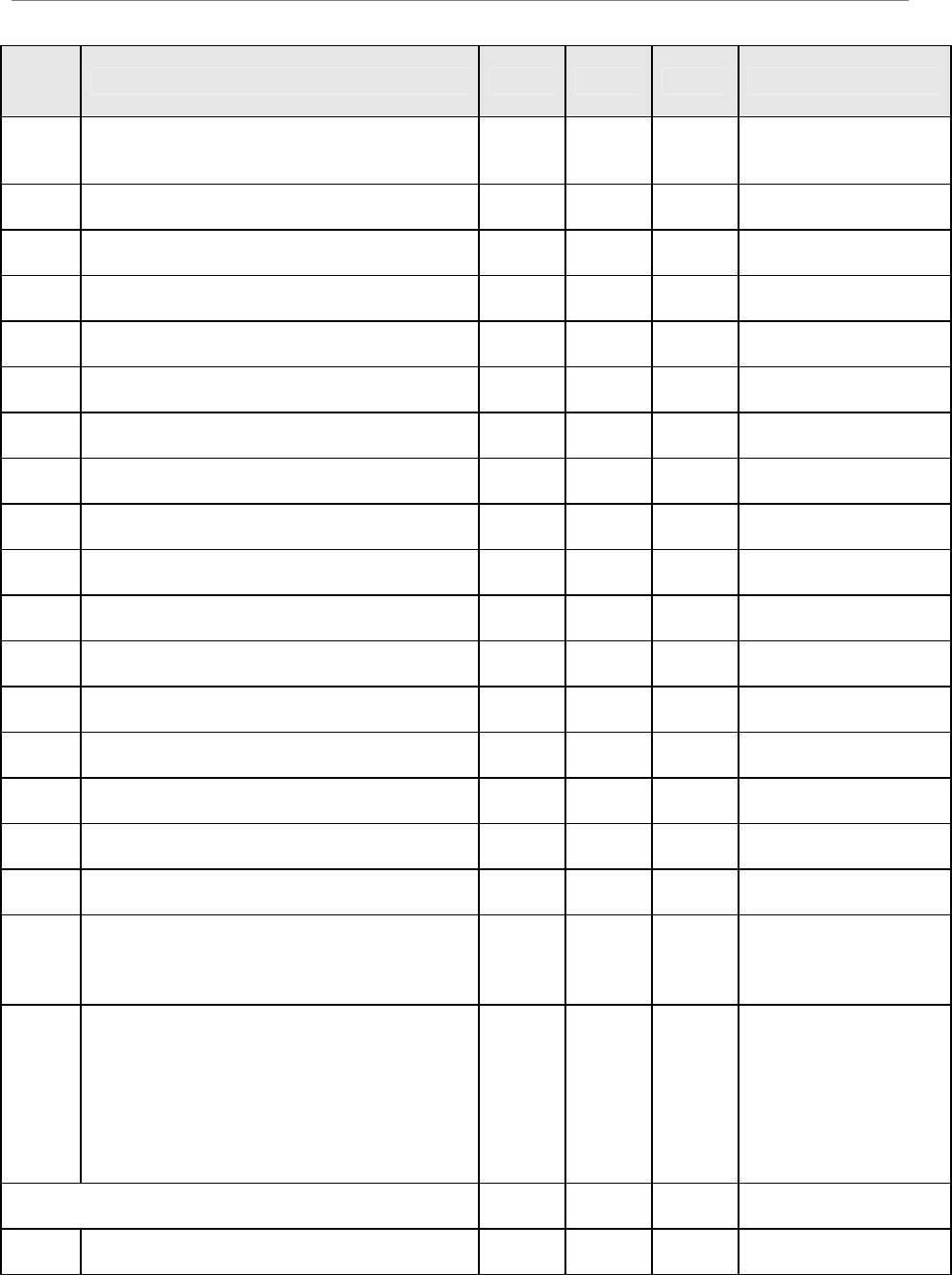
Ripwave Base Station I&C Guide Navini Networks, Inc.
240 Part #40-00047-00 Rev D v1.0
February 28, 2003
Item # Task / Activity Navini Client Other Notes
9 DC Power System 24VDC @ 60 Amps for each
BTS S, I
10 Batteries / UPS S, I
11 Intra – rack cabling S, I
12 Electrical Circuits S, I
13 Electrical – wiring from panel to rack S, I
14 Electrical (conduit, distribution panels, etc.) S, I
15 Environmental Equipment S, I
16 Miscellaneous Hardware S
17 BTS cages / cards S, I
18 Network Router S, I
19 Network Ethernet Switch with ATM interface S, I
20 EMS Server / workstation S, I
21 EMS client workstation (for techs) S, I
22 EMS client workstation (for Navini) S, I
23 Server for DHCP and network applications S, I
24 CPE S
25 User PC with Ethernet and/or USB Card S
26 Provide Construction Supervisor
2 1
Navini will supervise
installation of Navini
equipment.
27 Provide Installation Resources
2 1
Client contractors.
Navini will install the
BTS in the client
installed rack/cabinet.
Navini will provide
technical guidance for
installation of the RFS.
CONSTRUCTION
1 Site Preparation/Infrastructure 2 1
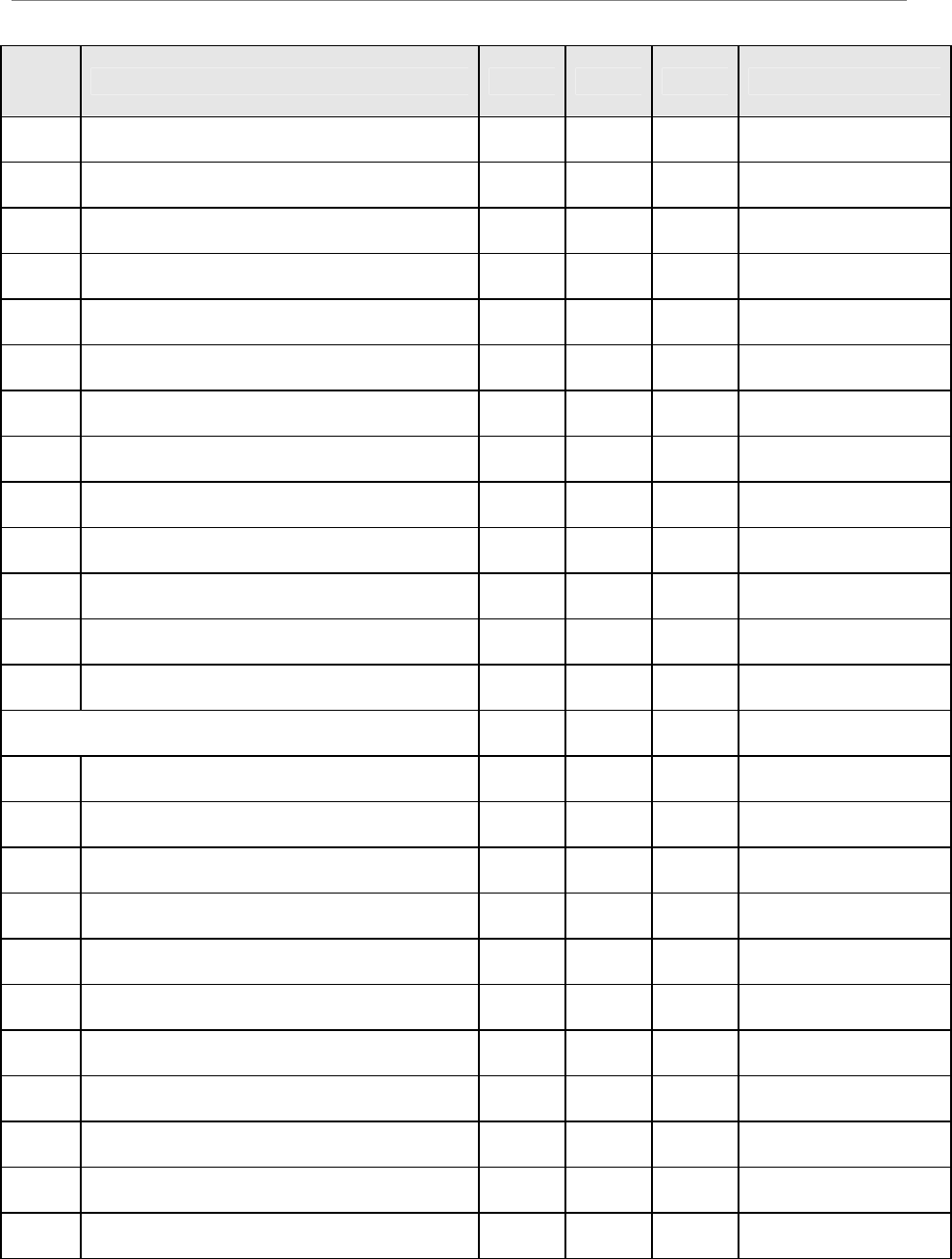
Navini Networks, Inc. Ripwave Base Station I&C Guide
Part #40-00047-00 Rev D v1.0 241
February 28, 2003
Item # Task / Activity Navini Client Other Notes
2 Pull Cables 1
3 Install Connectors and Grounding 1
4 Install Surge Protectors 2 1
5 Test / Sweep Coax 2 1
6 Install mounts / brackets 2 1
7 Install Racks 2 1
8 Electrical power to Rack 1
9 Backhaul to rack 1
10 Environmental (if required) 1
11 Quality Assurance 2 1
12 Inspections / Punch List 2 1
13 Close all Punch List Items 2 1
14 Provide POTS line for technician use 1
EQUIPMENT COMMISSIONING & INTEGRATION
1 Inspect / Test Cabling / Connections 2 1
2 Install Rack Mount Power System / Card Cages 1 2
3 Test DC System 2 1
4 Plug cards in BTS 1
5 Load EMS / Configure 1
6 Boot BTS 1
7 Provision EMS / BTS / CPE 1
8 Test Operation 1
9 Integrate Backhaul 2 1
10 Verify Operation 2 1
11 Router: Configure / test 1
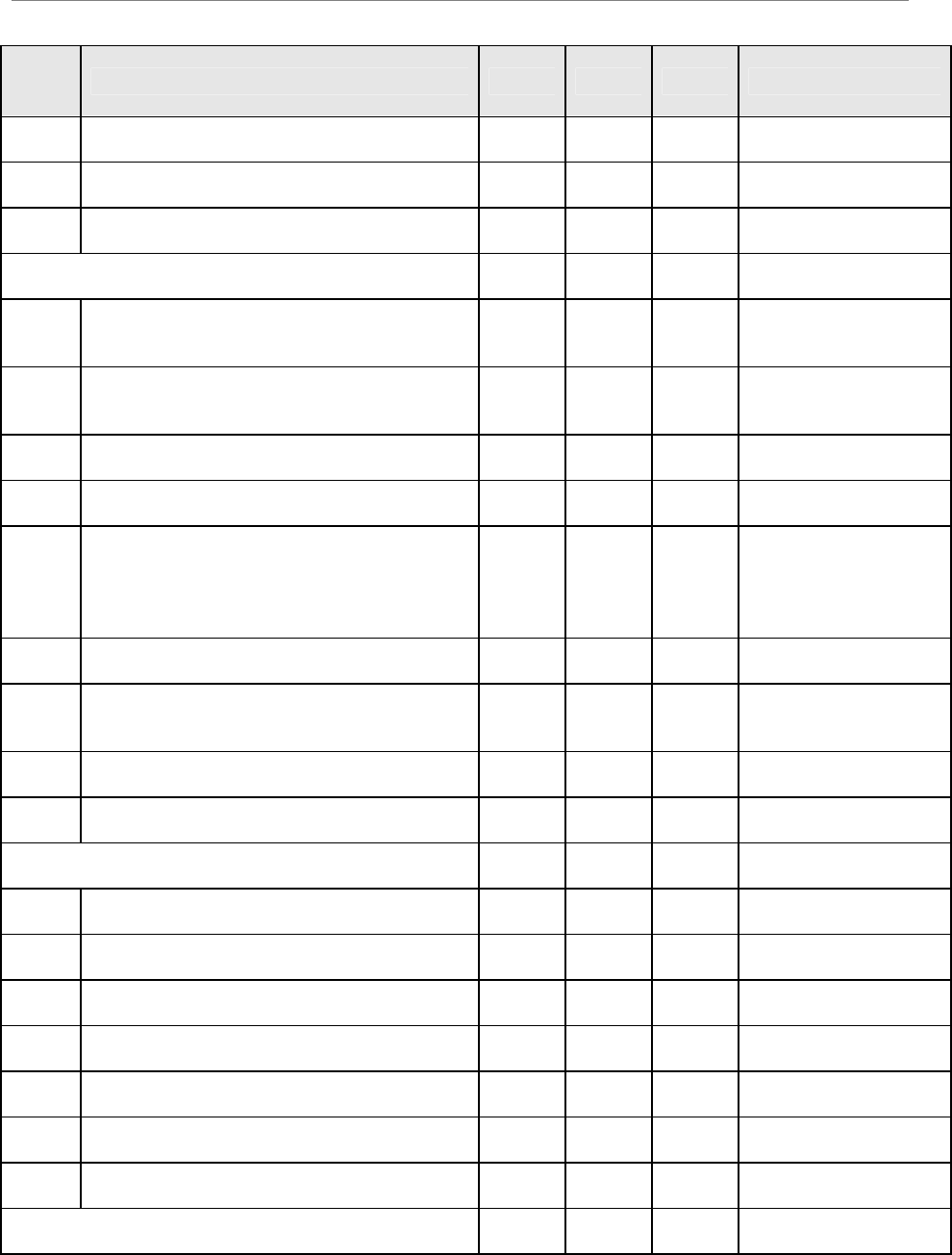
Ripwave Base Station I&C Guide Navini Networks, Inc.
242 Part #40-00047-00 Rev D v1.0
February 28, 2003
Item # Task / Activity Navini Client Other Notes
12 DHCP Server: configure / test 1
13 EMS Client: Configure / Test 1 2
14 Configure monitoring for routers 1
TESTING
1 Determine Network Test Criteria 2 1 Based on trial
agreement.
2 Determine RF Test Criteria 1 1 Based on trial
agreement.
3 Generate Acceptance Test Plan (ATP) 1 1
4 Review Test Plan 1 1
5 Supply Test Equipment
HP/Agilent E4402B Spectrum Analyzer with
Floppy Storage Option, HP/Agilent 8648C RF
Signal Generator, Tektronix TDS 3012B Scope
1 2 Some tests will utilize
built in test capability.
6 Execute Trial Test Plan and capture data 2 1
7 Provide Vehicle and Driver for System Drive
Testing 1
8 Analyze test data and write report 2 1
9 Review Report, Trial test results 1 1
END USER ENGAGEMENT
1 Prepare End User profile 1
2 Develop User Procedures 1
3 Recruit and Sign Up Users 1
4 Distribute CPE kits 1
5 Develop User Surveys 1
6 Survey Users, collect data 1
7 Issue reports 1
SUPPORT & SERVICES
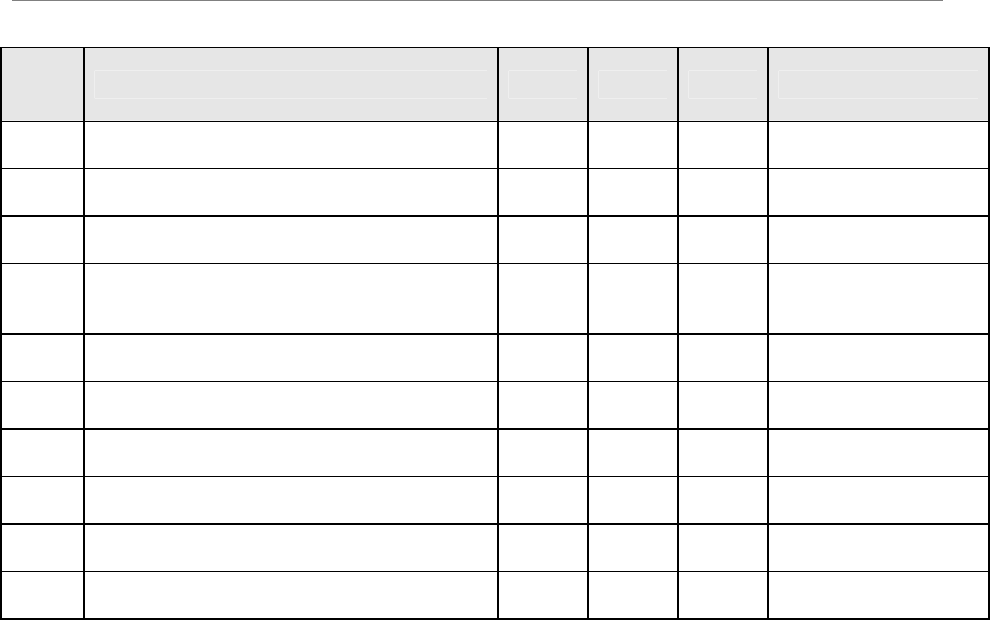
Navini Networks, Inc. Ripwave Base Station I&C Guide
Part #40-00047-00 Rev D v1.0 243
February 28, 2003
Item # Task / Activity Navini Client Other Notes
1 System Training for Service Provider 1
2 Monitor Network 2 1
3 End User Contact (answer phones) 1
4 Fault Determination and Isolation 2 1 Client to provide Level
1 support.
5 Performance Reporting 2 1
6 Field Repairs / Replacements (if needed) 1 2
7 Shipping for Repairs / Replacements 2 1
8 Spares 1 Spares count TBD.
9 Install Hardware Upgrades (if needed) 2 1
10 Install Software Upgrades (if needed) 2 1

Ripwave Base Station I&C Guide Navini Networks, Inc.
244 Part #40-00047-00 Rev D v1.0
February 28, 2003

Navini Networks, Inc. Ripwave Base Station I&C Guide
Part #40-00047-00 Rev D v1.0 245
February 28, 2003
LIST OF EXHIBITS
EXHIBIT 1: BOOT COMMANDS....................................................................................................... 78
EXHIBIT 2: ETHERNET CONFIGURATION........................................................................................ 79
EXHIBIT 3: ATM/T1 CONFIGURATION.......................................................................................... 82
EXHIBIT 4: ADDITIONAL ATM PARAMETERS ............................................................................... 82
EXHIBIT 5: IMA CONFIGURATION ................................................................................................ 84
EXHIBIT 6: IMA CLOCK MODE ..................................................................................................... 86
EXHIBIT 7: STANDARD ETHERNET BOOT SEQUENCE - EXAMPLE .................................................. 86
EXHIBIT 8: STANDARD ATM BOOT SEQUENCE - EXAMPLE .......................................................... 88
EXHIBIT 9: ON-BOARD FILE SYSTEMS........................................................................................... 90
EXHIBIT 10: TCP/IP STACK .......................................................................................................... 90
EXHIBIT 11: BTS REBOOT - EXAMPLE.......................................................................................... 94

Ripwave Base Station I&C Guide Navini Networks, Inc.
246 Part #40-00047-00 Rev D v1.0
February 28, 2003

Navini Networks, Inc. Ripwave Base Station I&C Guide
Part #40-00047-00 Rev D v1.0 247
February 28, 2003
LIST OF FIGURES
FIGURE 1: BASE STATION INSTALLATION WITH PANEL ANTENNA................................................ 17
FIGURE 2: I&C PROCESS FLOWCHART.......................................................................................... 20
FIGURE 3: BTS CHASSIS ............................................................................................................... 29
FIGURE 4: RFS.............................................................................................................................. 30
FIGURE 5: GPS ANTENNAS ............................................................................................................ 31
FIGURE 6: INDOOR BTS ................................................................................................................ 32
FIGURE 7: DATA/POWER CABLE SURGE PROTECTOR .................................................................... 42
FIGURE 8: ANTENNA & CAL CABLE SURGE PROTECTOR .............................................................. 43
FIGURE 9: GPS CABLE SURGE PROTECTOR .................................................................................. 43
FIGURE 10: SURGE PROTECTORS IN BUSS BAR ............................................................................. 43
FIGURE 11 : BUSS BARS ................................................................................................................ 44
FIGURE 12: GPS DISTRIBUTION AMPLIFIER.................................................................................. 46
FIGURE 13: DEPICTION OF GPS DISTRIBUTION AMPLIFIER ............................................................ 47
FIGURE 14: BUSS BAR CONNECTIONS ........................................................................................... 48
FIGURE 15 : OMNI CABLE ROUTING.............................................................................................. 49
FIGURE 16: PANEL CABLE ROUTING ............................................................................................. 49
FIGURE 17: BTS MOUNTING RACK............................................................................................... 50
FIGURE 18: BTS CHASSIS ............................................................................................................. 51
FIGURE 19: SPLIT VS. COMBO CHASSIS POWER ............................................................................ 52
FIGURE 20: SPLIT CHASSIS POWER CONNECTIONS........................................................................ 53
FIGURE 21: MOTOROLA TIMING 2000 GPS .................................................................................. 55
FIGURE 22: VIC 100 GPS............................................................................................................. 55
FIGURE 23: MOTOROLA GPS ANTENNA MOUNTING BRACKETS................................................... 56
FIGURE 24: MOTOROLA GPS ANTENNA MOUNTED TO A POLE.....................................................56
FIGURE 25: VIC 100 PIPE CLAMP MOUNT.................................................................................... 57
FIGURE 26: VIC 100 GPS ANTENNA ............................................................................................ 57
FIGURE 27: ASSEMBLED VIC 100 ANTENNA & MOUNT............................................................... 57
FIGURE 28: RFS MOUNTING BRACKET......................................................................................... 58
FIGURE 29: OMNI ANTENNA ELEMENTS ....................................................................................... 59
FIGURE 30: DECLINATION ANGLE ................................................................................................. 60
FIGURE 31: SURGE PROTECTORS.................................................................................................... 61
FIGURE 32: RFS CONNECTORS ..................................................................................................... 62
FIGURE 33: COMPLETED CABLE INSTALLATION............................................................................ 63
FIGURE 34: RFS GROUNDING ....................................................................................................... 64
FIGURE 35: WEATHERIZED CABLES .............................................................................................. 64
FIGURE 36: COMBO CHASSIS REAR VIEW ..................................................................................... 65
FIGURE 37: SPLIT CHASSIS RF/PA SHELF REAR VIEW ................................................................. 66
FIGURE 38: SPLIT CHASSIS DIGITAL SHELF REAR VIEW ...............................................................66

Ripwave Base Station I&C Guide Navini Networks, Inc.
248 Part #40-00047-00 Rev D v1.0
February 28, 2003
FIGURE 39: OMNI ANTENNA MOUNT ............................................................................................. 67
FIGURE 40: SECURED OMNI ANTENNA MOUNT ............................................................................. 67
FIGURE 41: OMNI GROUND STUD.................................................................................................. 68
FIGURE 42: WEATHERIZED CONNECTORS ..................................................................................... 68
FIGURE 43: DIGITAL SHELF........................................................................................................... 69
FIGURE 44: PORTS ON CC CARD ...................................................................................................72
FIGURE 45: COM1 PROPERTIES.................................................................................................... 74
FIGURE 46: BTS POWER ON SWITCHES ........................................................................................ 77
FIGURE 47: SELECT BTS............................................................................................................... 96
FIGURE 48: CALIBRATE BTS......................................................................................................... 97
FIGURE 49: WARNING WINDOW ...................................................................................................97
FIGURE 50: FULL CALIBRATION WINDOW..................................................................................... 98
FIGURE 51: SHOW CONFIGURATION/ANTENNA TABLE ................................................................. 98
FIGURE 52: CONFIG LAYER 1 DATA WINDOW .............................................................................. 99
FIGURE 53: REFERENCE CABLE MEASUREMENT ......................................................................... 101
FIGURE 54: REFERENCE & TEST CABLE MEASUREMENTS ..........................................................101
FIGURE 55: COUPLER MEASUREMENT ........................................................................................ 102
FIGURE 56: TEST EQUIPMENT FOR RECEIVE VERIFICATION ........................................................ 105
FIGURE 57: OSCILLOSCOPE RECEIVE TIME ................................................................................. 106
FIGURE 58: TEST EQUIPMENT FOR TRANSMITTER VERIFICATION ...............................................109
FIGURE 59: SYNC SIGNAL ........................................................................................................... 110
FIGURE 60: WIRED CPE SETUP................................................................................................... 111
FIGURE C1: PIN LAYOUT............................................................................................................. 133
FIGURE C2: TEST SETUP ............................................................................................................. 137
FIGURE C3: SWEEP TEST MARKER MEASUREMENT EXAMPLE....................................................138
FIGURE C4: INSERTION LOSS (CABLES ON GROUND) MARKER MEASUREMENT EXAMPLE......... 139
FIGURE C5: INSERTION LOSS (CABLES ON TOWER) MARKER MEASUREMENT EXAMPLE ........... 141
FIGURE C6: RFS ONLY TESTING SETUP ..................................................................................... 142
FIGURE C7: RFS ONLY TX VERIFICATION.................................................................................. 143
FIGURE C8: RFS ONLY TX MARKER MEASUREMENT EXAMPLE ................................................ 143
FIGURE C9: RFS ONLY RX VERIFICATION.................................................................................. 144
FIGURE C10: RFS ONLY RX MARKER MEASUREMENT EXAMPLE .............................................. 145
FIGURE C11: RFS & CABLES TX MARKER MEASUREMENT EXAMPLE ....................................... 146
FIGURE C12: RFS & CABLES RX MARKER MEASUREMENT EXAMPLE....................................... 147
FIGURE G1: RF COVERAGE ANALYSIS EXAMPLE .......................................................................183
FIGURE G2: DRIVE STUDY ROUTE EXAMPLE .............................................................................. 184
FIGURE G3: PATCH ANTENNAS ................................................................................................... 185
FIGURE H1: EXAMPLE OF A 3-SECTOR SITE................................................................................. 189
FIGURE H2: EXAMPLE OF 120° OF AN OMNI SITE ....................................................................... 190
FIGURE L1: PIN ORIENTATION .................................................................................................... 215
FIGURE N1: SYSTEM DIAGRAMS ................................................................................................. 219
FIGURE N2: BBU RACK.............................................................................................................. 225

Navini Networks, Inc. Ripwave Base Station I&C Guide
Part #40-00047-00 Rev D v1.0 249
February 28, 2003
LIST OF TABLES
TABLE 1: RIPWAVE STANDARD DOCUMENTATION CD ................................................................. 18
TABLE 2: VAR I&C DOCUMENTATION CD.................................................................................. 18
TABLE 3: OPERATING FREQUENCIES ............................................................................................. 34
TABLE 4: COMBO CHASSIS SYSTEM (ISM SYSTEMS).................................................................... 34
TABLE 5: SPLIT CHASSIS SYSTEM (MMDS & WCS SYSTEMS) .................................................... 35
TABLE 6: MATERIALS SPECIFICATIONS ......................................................................................... 36
TABLE 7: ACTIVE & PASSIVE RFS LOSS / OPERATING PARAMETERS ........................................... 45
TABLE 8: CABLE ATTENUATION IN DB PER 100 FEET ................................................................... 45
TABLE 9: DIGITAL CARD NAMES .................................................................................................. 70
TABLE C1: PINOUT DETAILS ....................................................................................................... 134
TABLE C2: RESISTANCE TO GROUND .......................................................................................... 135
TABLE C3: RESISTANCE OF TWO PAIRS ...................................................................................... 135
TABLE C4: ACTIVE & PASSIVE RFS LOSS / OPERATING PARAMETERS ...................................... 136
TABLE C5: SWEEP FREQUENCIES ................................................................................................ 137
TABLE H1: LOCATION (FTP) TEST FORM ................................................................................... 194
TABLE J1: 2.6 GHZ BTS............................................................................................................. 198
TABLE J2: BTS TO RFS INTERFACE............................................................................................ 198
TABLE L1: PIN NAMES................................................................................................................ 216
TABLE L2: BBU SIGNAL NAMES ................................................................................................ 216
TABLE N1: INPUT SPECIFICATIONS ............................................................................................. 220
TABLE N2: OUTPUT SPECIFICATIONS .......................................................................................... 220
TABLE N3: GENERAL SPECIFICATIONS........................................................................................ 221
TABLE N4: PROTECTION SPECIFICATIONS................................................................................... 222
TABLE N5: ENVIRONMENTAL REQUIREMENTS............................................................................ 222
TABLE N6: REGULATORY REQUIREMENTS.................................................................................. 223
TABLE N7: RELIABILITY REQUIREMENTS ................................................................................... 223